Australian
and international
exploratory
performance and
media arts
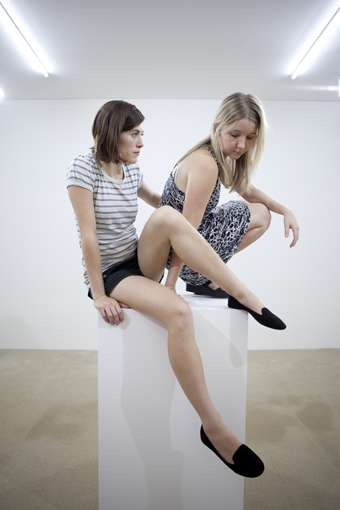
Clark Beaumont, Coexisting, 2013, performed by the artists and commissioned by Kaldor Public Art Projects for Kaldor Art Project 27: 13 Rooms
photo Jamie North/Kaldor Public Art Projects
Clark Beaumont, Coexisting, 2013, performed by the artists and commissioned by Kaldor Public Art Projects for Kaldor Art Project 27: 13 Rooms
The title foregrounds space. As Klaus Biesenbach says in the catalogue introduction, not 13 Performances nor 13 Artists, but 13 Rooms and later, when talking about developing the project with Hans Ulrich Obrist, of wandering amongst the sculptures in the Villa Borghese, “we could do a sculpture gallery, one room after the other, but in each room it would be a ‘living sculpture’…” (catalogue).
Obrist takes up the curatorial narrative of wanting the exhibition to occupy time as well as space. So, with terms borrowed both from the visual and performing arts, what conceptions of space and time did 13 Rooms give us?
Sydney-siders like to go to the water to recreate. The wharves and piers closest to the CBD are a story of continuous erasure: in place of canoes, cruise liners; in place of bond stores, Biennales; the site of a bitter waterfront dispute will soon be a casino. The artists of 13 Rooms were not asked to address the history or material properties of Pier 2/3. The space for their work had been determined well before it landed in Sydney, in Manchester as 11 Rooms and in Essen as 12 Rooms. For the Sydney iteration Harry Seidler and Associates—the firm renowned for modernist architecture in Australia—was commissioned to design variations of the classic white cube gallery, one for each artist. Outside the cubes, the audience performed: promenading, catching up, queuing, standing back to watch, chasing after children (or not) and choosing when to effect the next entrance.
As for the selection of artists, most are big names on the international art circuit, though not all derived their reputation from within the field of performance (Hirst and Baldessari, for example, famously extend definitions of painting). The importation of name artists to Sydney is not new—the John Kaldor projects since 1969 and the Sydney Biennales since 1973 provide a lineage of exposure to local audiences of ambitious works from elsewhere. Among the local art community such encounters stir a genuine willingness to engage which, if not well managed, can quickly slide into cynicism or resentment. The Sydney Biennale curators were made to recognise this early on and have included a (usually) good proportion of Australian artists in their selection, thus elevating those artists specifically and the local scene generally to the international stage, and as a side benefit, allowing for natural dialogue to arise between locals and visitors.
The 13 Rooms curators had commissioned works that specifically did not rely on the presence of the artist-authors. ‘Sculpture’ (transportable, transposable, mute) as per Biesenbach’s narrative, was still then the stronger term. The ‘living’ part, it was inferred, could be achieved by alienating certain qualities or qualifications (appearance or physical training, for example) from the subject. For those of us coming out of a whole other history and ethos of performance that embraced the risks of authoring-while-doing, unrepeatability and an assumed contract between performer and audience of doing time together, it was a difficult proposition to swallow.
Of the international works, some came off better than others, depending on the performance strategy applied. Santiago Sierra, for instance, delegated the idea of authenticity to other bodies. His Veterans of the Wars of Afghanistan, Timor-Leste, Iraq and Vietnam Facing the Corner, brutally rejected any thought of entertainment (no movement, no eye-contact) and threw the complexities of moral responsibility back on the observers. Hirst and Ondák leant heavily on and were rewarded by the skilled sociability of their ‘interpreters’ to deliver their work. Delegation of bodily presence over time was more problematic for the two artists who were the inhabitants of their work when originally performed: Marina Abramovi?’s Luminosity of 1997 and Joan Jonas’ Mirror Check of 1970. Both works suffered from their management (warnings, guards, taped off areas, ‘no camera’ signs, constant opening and closing of doors and half-hour shifts for the ‘interpreters’). That the performers were able to hold focus and thus transmit a real sense of live engagement says much for their experience as practitioners in their own right.
Interestingly it was the locals—young Brisbane-based duo Clark Beaumont—who relied on endurance and improvisation for the effectiveness of their work. They were the only authors as performers and the only artists willing to take the 7.5 hours per day opening times (that is, gallery time) as the given duration for their performance. They could not have fulfilled the ‘living sculpture’ brief more closely.
As ephemeral as the works they briefly housed, the 13 Rooms are gone now. Pier 2/3 is still there, waiting to receive its next guests.
Kaldor Public Art Projects, 13 Rooms, curators Hans Ulrich Obrist, Klaus Biesenbach, 11-21 April, Pier 2/3, Walsh Bay, Sydney. Quotations from Hans Ulrich Obrist & Klaus Biesenbach, “Curators in Conversation,” 13 Rooms catalogue, Rushcutters Bay: Kaldor Public Art Projects, 2013.
RealTime issue #115 June-July 2013 pg.
© Barbara Campbell; for permission to reproduce apply to realtime@realtimearts.net
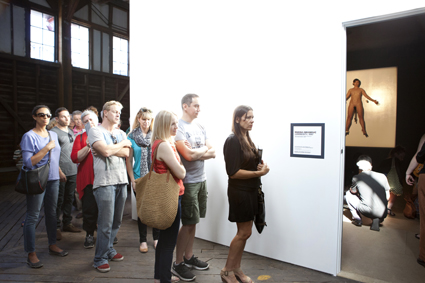
Marina Abramovic, Luminosity, 1997, re-performed for Kaldor Public Art Project 27: 13 Rooms
photo Jamie North/Kaldor Public Art Projects
Marina Abramovic, Luminosity, 1997, re-performed for Kaldor Public Art Project 27: 13 Rooms
Sydney dancer Nalina Wait was one of a group of nine performers in 13 Rooms whose task it was to re-perform Joan Jonas’ Mirror Check (1970) and Marina Abramovi?’s Luminosity (1997) at half hourly intervals and alternating between works (plus breaks). In Mirror Check the performer slowly inspects her naked body with a hand mirror. In Luminosity, the naked performer is positioned high up against a wall, arms and legs extended while supported by a bicycle seat.
Wait spoke with Clare Grant, Lecturer in the School of the Arts and Media, UNSW, and her students about the experience. Here are excerpts from Wait’s responses to questions.
Eye contact
We were given the general task to look at the audience: “keep still, move slowly and look at the audience”…But when you actually do that—when you actually lock eyes with someone who doesn’t know you…possibly thinking of you in a kind of objectified way—[there is a sort] of exchange, of seeing each other. It was really quite profound. You’d see people who’d get really upset, freak out and wouldn’t really want be looked at and they’d hide, but couldn’t help but have a little peek. And eventually they’d somehow open up and, ‘Okay, I’ll look back at you.’ And we’d actually meet and that was really quite amazing.
The task
The task was the same [as in dancing]. In dancing, in improvising, normally I’ll develop a task or my body will…or there will be something that I’m doing that is a task that I must do…So in many ways it was just like dancing except mostly just using the eye [which] was the biggest movement. And I got really tired because I tried as much as I could to focus on the people I was looking at and not have a generalised or softened peripheral gaze.
I think about it as a job. The task is to look. I’m constantly thinking about the looking, the engagement of the looking—noticing and refreshing looking, being alive to the looking all the time, not getting tired of it or bored with it, to refresh it and to notice it in every moment.
Being naked
To begin with we took turns in front of each other. The scariest moment was the first time, taking your coat off and standing up there. But after a while we got used to it with each other. Then we extended the length of time we were doing it for, to negotiate how to do that over time, what kind of things you need to do in yourself to maintain that and build up to it…[W]hen the public actually came in…they were so open and taken by [the work]. I realised I didn’t need to push them or hold them in their place with my gaze. I could actually be more receptive and compassionate and more active in it, communicate within it rather than hold them back and defend myself. But it took a bit of time to come to that. I only realised I was doing that after one guy left and he said, “That chick was fully eye-balling me” or something…I thought, oh yes, I’ve got to also receive through the eye a little bit more.
Agency
[The gaze] is where I had agency. Other than that I felt much like I might if I was in a dance piece in which the choreography was exactly set and I had no room to really interpret..It was more restricted than I’ve ever [been]. I did as much as I could [with my eyes] because I felt that was where I was.
Vulnerability
If there was the occasional person trying to undermine the performance I just thought about being Jesus…(LAUGHS), being compassionate towards them. This is your situation…it’s not actually mine. [I was] trying to be compassionate with them having an issue with it inside themselves, inside the work. Because it is confronting work.
Focus
For me, in Mirror Check there was even less agency [than in Luminosity]. I tried to squeeze as much agency as I could from it …or interest. I think that’s what the work is, finding interest in the task. And after the thousandth time of looking at your own reflection in the mirror, it is boring. It really is. But if there is some way that you can focus—I had to do it through focus mostly. I just had to literally see every little thing and be engaged with it in the scene for me to feel like I was doing the work. And I noticed if I ever just slightly shifted my vision, or went out of focus, the atmosphere of the room would break and people would leave. You feel like you’re doing this quite personal thing, but people feel it.
Mirror Check was tricky for me because I prefer to be able to see the people in the room and feel we’re all in there together rather than…keeping a fourth wall in a performative sense and not looking at anyone, which I found difficult. I had to look…even if it was at the wall or somebody’s shirt so I could still feel engaged.
So I felt slightly disconnected from the audience but then again I’d finish a round and someone would applaud. So it’s like, okay, you’re with me. Then I’d just listen more to the tone of the room, to feel whether people were with me. That’s when I noticed if I went out of focus, it would break.
Kaldor Public Art Projects, 13 Rooms, curators Hans Ulrich Obrist, Klaus Biesenbach, 11-21 April, Pier 2/3, Walsh Bay, Sydney
RealTime issue #115 June-July 2013 pg. 8
© RealTime ; for permission to reproduce apply to realtime@realtimearts.net
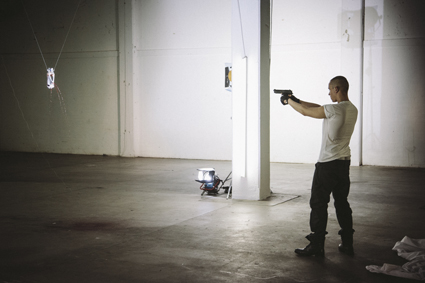
Jamie Lewis Hadley, Analogue to a Blunt Trauma, Spill Festival London
photo Guido Mencari
Jamie Lewis Hadley, Analogue to a Blunt Trauma, Spill Festival London
In the 2013 SPILL Festival of Performance, I witnessed three artists presenting diverse interpretations of personal and public desire using raw, essential and intimate body fluids.
Jamie Lewis Hadley, Analogue to a Blunt Trauma
Waiting at the far end of a cavernous white warehouse space feels like being on a film set. There are lights and cameras anticipating action and a white sheet-covered couch framed by a corridor of pillars. At the far end a door opens, a man enters and emerging in silhouette he walks purposefully down the centre of the room with what seems to be a gun in his hand. As he passes each pillar, fluorescent tubes blink on. This beginning of Jamie Lewis Hadley’s performance is an intentional set up, referencing cinema tropes and creating an expectation of theatrical artifice. However, from here we witness a more intimate yet perfunctory act, as collaborator Dr Belinda Fenty proficiently extracts and fills a medical grade blood bag with Hadley’s blood.
The casual demeanor with which Hadley lies across the couch and the friendly exchanges between the two belie the more serious nature of the act. I think of blood and loss, this reflection amplified by the subsequent proceeding violent act, in which Hadley takes aim and shoots the hanging blood bag multiple times. Real gun, real membrane and a rapid release of real blood; the metaphor is not lost. The moment is shortly echoed on a blood-stained sheet that had been dragged across the floor and hitched as a screen. Here the action is replayed in high definition slow motion. The effect is at once jolting and seductive. Jamie Lewis Hadley’s work is provocative and intelligent, its precise delivery relies on blurring boundaries while challenging the politics behind consumption of shocking, ‘beautiful’ trauma.
Julia Bardsley, Medea_Dark/Room
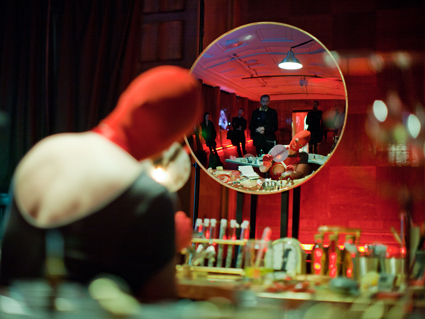
Julia Bardsley, Medea_Dark/Room, Spill Festival, London
photo Pari Naderi
Julia Bardsley, Medea_Dark/Room, Spill Festival, London
From the moment I ‘enter’ through folding red and cream latex, I understand something is developing in here and it’s sticky, magnetic, electric and gold. I am reminded of entering the folds of the domestic heater to find the minute liminal world inhabited by the radiator lady on her stage in Lynch’s Eraserhead. There is a stage of sorts in Medea’s room, which she inhabits intermittently to conduct her ‘glorious genitalia’ experiments. On one visit I witness one such moment. Medea stands in front of a wall piece, one of the many expertly considered installation elements that make up her darkroom. Referencing theories of the relationship between sex and the gaze, this metaphorical mirror contains seven round sculptural elements that signify a journey from arousal to sublime bliss—the centrepiece literally bursts out of its frame like a red multi-pronged fleshy sea creature. Medea selects a frame and enters her ‘stage,’ defined by a projection. The image is striking, she has become the personification of one of her many detailed scientific constructions and formulaic scribblings. Wired up from nipples to groin, each breast protrudes from Medea’s fetish-styled garment. She pulses electrically, literally etching out orgasmic potential onto the carbon canvas of her genital frame. There is an exquisite seductiveness to Julia Bardsley’s loaded and intricately layered performance installation. Regardless of the point at which I encounter her experiments, I witness the vital moment of creative combustion; whether it is the small detail in the eclectic workstation amid liquid drenched gold sheep and a magnetised prophylactic or a pulsating Medea in a circle of light.
Martin O’Brien, Last(ing)
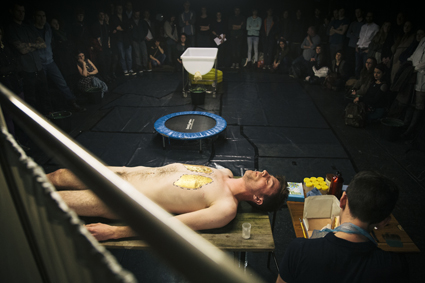
Martin O’Brien, Last(ing), Spill Festival London
photo Guido Mencari
Martin O’Brien, Last(ing), Spill Festival London
The room smells of chemicals but I wonder if this is conjured by the sight of a radioactive green substance that fills various buckets placed around the edges, where we the audience hug the walls. Martin O’Brien lies ceremoniously on a table as David, his assistant, ritually applies gold leaf to his chest. This delicate act, of marking out a pair of golden lungs, is broken by O’Brien intermittently coughing up mucous into a glass beaker. It is at this moment that the other elements in the room feel more menacing and foreboding.
I am aware that O’Brien’s practice revolves around “physical endurance and hardship” informed by his chronic cystic fibrosis. What follows is a series of procedures and tasks that not only serve as metaphorical illustrations of symptoms but also convey a sense of a body objectified within a medical regime. The artist’s work is unforgiving, messy and raw, never pretending to be otherwise. Within moments of fragility there is strength. I am held by the final action, reflecting the journey of a body purged. Martin stands encased in a prison of barbed wire, his head covered in a lung shaped latex hood. The green fluid into which he had previously plunged forms clumps on his body hair. As I witness the labour of his breathing and excruciating gasps for air, one thing shines through—the remnants of his golden lungs, a defiant signal of the artist’s reclamation of his body.
SPILL Festival of Performance 2013, producer Pacitti Company, London, 3-14 April; spillfestival.com/
RealTime issue #115 June-July 2013 pg. 10
© Julie Vulcan; for permission to reproduce apply to realtime@realtimearts.net
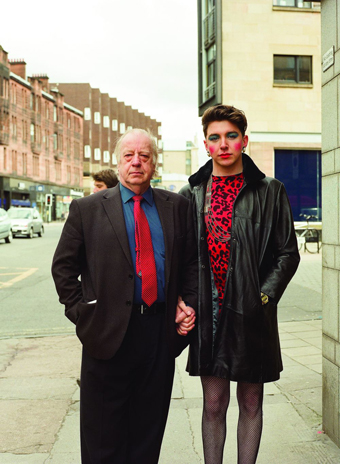
Walking: Holding, Rosana Cade
photo Rosie Healey
Walking: Holding, Rosana Cade
Pacitti Company’s SPILL Festival is two weeks of sensorial encounter where the personal, political and mythological are transferred through the bodies of performers and audience. Sixteen of the 25 works are by women. The following three shots glide from wide, mid to hand-held, close-ups of the gendered, queer world we live in. If this opening has a certain eau de pussy, it’s an invitation to read on, not necessarily a warning.
Lauren Barri Holstein, Splat!
Splat! is the sound of 100 tomato juice filled balloons thrown and burst on a knife’s edge clutched by The Famous Lauren Barri Holstein’s vagina (insert handle first if you want to try this at home). It’s the sound of douche and douche again all over the chest and mouth of someone you care about. Give me a towel.
It’s a deconstructed post-fairytale in a forest inhabited by zombie Woodland Friends, where Bambi, canal birthed in a condom placenta, trophy mounted, rollerskates blindly through emissions, urinates near the vomit, near the target, on twins and hangs as a slaughtered carcass stuffing a burger in her cake hole. It’s a feminine schlock technical rehearsal on a closed Hollywood set with The Famous calling her own stage cues and requesting repeats. It’s a tower of cliché, ideology, genres and dispassionate delivery that might make you choke, with laughter.
You are shunted from wince to cringe to clenched sphincter then leant towards a performance precipice and asked with a hand held mike, “How do you feel emotionally, right now?” She has to go harder because you can’t feel it anymore. Do it again.
Splat! straddles porn, gets bulimic at the microphone, cleans and sticks the unstickable with tape. Its frame has a weft that might muddle your expectations of the next brown-eyed money shot—the sluiced mountain of images is planted with tender instructions, sensitive ballet pointe ballads, the full, uncensored, itemised budget for the show and the soft silence of long blonde hair clippings snowing gently down. Put that back together.
It’s a vulnerability fuck-over and The Famous Lauren Barri Holstein is in control.
Lucy Hutson, If You Want Bigger Yorkshire Puddings…
Lucy Hutson is the kind of cooking companion who makes her own personal recipe. In If You Want Bigger Yorkshire Puddings You Need a Bigger Tin she mixes sexual politics with a family focus group, body identity and a biography of gendered experiments into a disarming dish served as a dialogue between documentary video and contemporary performance, with the lights on.
In an era where queer women debate the actual choice made by younger women in transition, rather than the right to choose, Lucy Hutson offers a home-made brand of good old fashioned asexual identity that is delightful and refreshing.
In the same way you can make a food comparison by asking if your grandmother would recognise it, Lucy approaches gender transition by preparing to run it past the ladies at the Women’s Institute. No snips and no tucks, just a ball of wool, a roll of cling wrap, a shot of self-acceptance and the courage to live with fuzzy edges. The Women’s Institute would be proud.
Rosana Cade, Walking: Holding
I dare to keep my eyes closed on a busy London road and anticipate each swirl of density coming towards me as the moment Walking: Holding will begin. Rosana Cade’s delicate, cold fingers take mine for a walking story of same sex, mixed ethnicity, fag hag and other couples.
Cade and her serial strollers lead us through personal experiences to the point where self-consciousness can invade intimacy and hands meeting below the hip divide.
Rosana’s stroll takes us to an ironwork sign, “LADIES.” I walk with a young, cross-dressed man in a sweet floral blouse, flats and a touch of lippy, down a small dirty street where big men manhandle large tools. I’m released between a van and a tag wall where anticipation and ankles tip awkwardly on a pile of rubble. It’s funny how many loaded frames there are in nondescript locations. I hold the hand of a man whose story makes me clutch it. I stop breathing. This is close. We recover when he asks for, and I offer, something of my own that raises his eyebrows. We part at a sheened wall where the close reflection of our coded couple is joined to make three before it becomes a new two.
These walks take you past public displays of affection, and more: from the throwaway indulgence for heterosexual, Caucasian-matched, western couples, to the erosive emotional fallout of hand division for others and intimacy rarely touched between strangers.
Do you think we make a happy couple on these strange streets?
SPILL Festival of Performance 2013, producer Pacitti Company, London, 3-14 April
RealTime issue #115 June-July 2013 pg. 11
© Cat Jones; for permission to reproduce apply to realtime@realtimearts.net
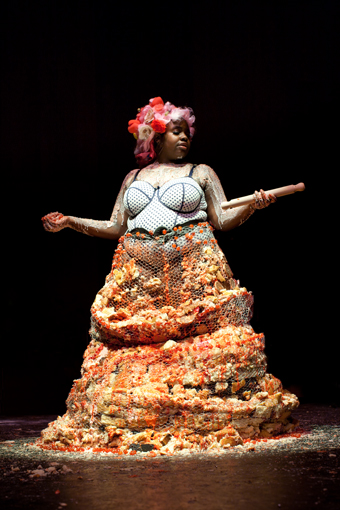
Selina Thompson, Pat it and prick it and mark it with b, SPILL Festival of Performance 2013
photo Pari Naderi
Selina Thompson, Pat it and prick it and mark it with b, SPILL Festival of Performance 2013
In the morning I am told Quizoola, Forced Entertainment’s iconic 24-hour question and answer performance, is sold out and despite their best efforts, the wonderful people at SPILL and at the Barbican have not been able to find a spare ticket.
I watch a little of it live online and in that 15 minutes a conversation takes place between Robin Arthur and Terry O’Connor in which he asks, “Would you like me to touch you?” She answers, “I wouldn’t mind if you touched me.” “But would you like me to touch you?” “I’m not saying I want you to touch me, but I wouldn’t mind if you touched me.” The audience laughs in the theatre far away.
Selina Thompson, Pat it and prick it…
SPILL National Platform takes place in a series of studios over three floors and the place is abuzz with activity. In Selina Thompson’s Pat it and prick it and mark it with b, in a room on the ground floor the artist is making a dress out of cake. Soul music plays on an iPod and the smell of cake fills the air. People are invited to help, cakes come out of the oven, are layered on to a cake rack and stuck together with jam and pink icing. It’s a performance that makes itself. Delightfully unselfconscious, the artist and her best friend and helper walk about, baking and working in their underwear, singing a bit and talking casually with the audience who seem to become Thompson’s friends in the process. On the walk upstairs, from one performance to the next, “on contact” is scrawled on the walls, evoking the theme of the festival with marker pens and paper.
Julie Vulcan, I Stand In
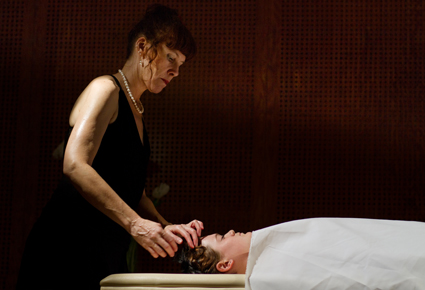
Julie Vulcan, I Stand In, SPILL Festival of Performance 2013
photo Pari Naderi
Julie Vulcan, I Stand In, SPILL Festival of Performance 2013
Entering Australian artist Julie Vulcan’s I Stand In, the first hit to my senses is a warm, gentle balm for the brain—the smell of healing oils. Vulcan stands at the other end of the room in front of a wood panelled wall with an altar of white flowers to one side and a body, beneath a white cloth, laid out before her on a table. The backdrop suggests a Hawaiian funeral parlour. The ritual begins with the removal of the cloth. The body is firmly massaged for 15 minutes. The artist cradles the heavy, limp body in order to oil the back. It is possible to imagine it is not breathing.
The most striking thing about witnessing this eight-hour performance is that each touch on the participant’s body creates a haptic connection with my own, each part responds as though the touch is happening directly on my own arm, my cheek. I realise that my body, more than my mind, is witness, responding before I think. In its generosity to the bodies of both the participants and the audience, I Stand In reminds us of the care we can enact towards each another. It reminds us of the strangers’ hands that guide us from our mothers’ wombs, that nurse us when we are sick and the hands that care for us in death. It reminds us that we are all part of the cycle of care, that our bodies recognise before the mind has time to catch up.
Heather Cassils, Becoming an image
On entering Heather Cassils’ Becoming an image on the lower floor of the building we are held in a black ingress so, we are told, our eyes can adjust to complete darkness. In low light the audience sits on the floor around a grey mound.
Sounds come first, a hiss, phut, huh; those of a fighter warming up. They get louder, stronger and then violent as fists hit something solid. Like a shock delivered straight into the brain, the image is there of a body, small and strong, flung against the mound of clay.
Photographer Manual Vason is Cassils’ performance partner in the work in which the only light is the flash of his camera. We see Cassils punching the clay, working to break down the mound. The fight is intimate, sexual, the smell of sweat adding another sensory layer. The performance takes place mostly in the afterburn on the retina, as in the darkness we try to catch up with the shock contact of light on the surface of our eyes, the image of the artist’s body leaving traces of negative images. In the gaps in our vision it is possible to make out the shape of something bigger that is alluded to in this performance, a summary of what we miss in the darkness, the invisible fights against the monumentalism of history. In the words of Heather Cassils, “You have to break things down to build things up.”
SPILL Festival of Performance 2013, producer Pacitti Company, London, 3-14 April; spillfestival.com/
RealTime issue #115 June-July 2013 pg. 12
© Madeleine Hodge; for permission to reproduce apply to realtime@realtimearts.net
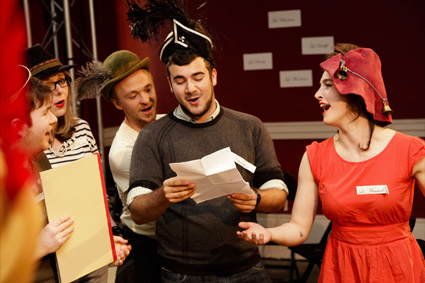
Image: Coney, A Small Town Anywhere, BAC Scratch 2012
photo Matt Howey Nunn
Image: Coney, A Small Town Anywhere, BAC Scratch 2012
In 2009 the Battersea Arts Centre in London hosted A Small Town Anywhere, a new work by UK-based company Coney. In it around 30 participants took on the role of villagers in a small country town. Each concealed a terrible secret and likewise had a mortal enemy among the other villagers.
A Small Town Anywhere condensed an entire week of drama into the space of roughly two hours; days and nights passed with subtle shifts in lighting; paper snow fell at one point and gossip, treachery and paranoia threatened to tear the little community apart.
Tom Bowtell and Tassos Stevens, two of the company’s co-directors, describe Coney as mixing “live and digital art forms to create immersive stories and play.” Their work, as well as the work of other groups such as Hide and Seek, Slingshot, Splash and Ripple and The Larks, is part of an emerging practice that, for ease of reference, I’ll call New Games. Their work varies widely encompassing Tiny Games, a series of 99 “easy to play” site-specific games designed for the streets of London by Hide and Seek, and 2.8 Hours Later, a city-wide zombie chase game, by Slingshot.
In recent years around the globe there has been an increased interest in play. In America campus games of Killer have turned into a worldwide nerf war (based on foam-based toy weaponry. Eds), with Humans vs Zombies. Real World Alternate Reality Games have been produced as marketing tools for Hollywood blockbusters such as Why So Serious? (for The Dark Knight, 2008) and The Beast (for Spielberg’s AI, as far back as 2001). In America there has also been a renewed interest in physical games: street sports mapping classic board game patterns onto the grid of New York streets in PacManhatten and festivals such as Come Out and Play. At the same time, across the UK and Europe, festivals of new games and playful experiences have spread including IGFEST, Play Publik and w00t.
New Games shares territory with the immersive work of English companies such as Shunt and Punchdrunk, in which audiences are free to explore a theatricalised space in order to discover hidden performance and narrative elements placed throughout. Earlier precedents can be found in interactive video art, such as Nightwalks and Frozen Palaces by Forced Entertainment, and technology enhanced Live Art such as Blast Theory’s A Machine to See With, Uncle Roy All Around You, Rider Spoke and Can You See Me Now (all of which utilise various levels of bespoke digital technology to enable audience/player agency within constructed social and performative events.) This is not to suggest a directly causative relationship but to demonstrate the emergence of a common theme in contemporary theatre and Live Art that is shared by contemporary play; participation, immersion and reactivity.
New Games blur the lines between technology, social interaction, location and story. What they have in common is the placement of the participant at the centre of the experience. In most cases, the convergence of specific rule sets, designed environments, narrative elements and participant agency (or some combination of these) generates a shared social experience. These experiences are designed to position participants within an abstracted system of organised performance relying on person to person interactions in the physical world to generate emergent narratives.
Alex Fleetwood, director of Hide and Seek, describes A Small Town Anywhere as “a vitally important step in the development of participatory dramaturgy.” Andrezj Lukowski, reviewing for Time Out UK, describes the experience as “an interrogation of ideology and its poisonous effect on community” and notes that “the fraught final stages feel as complex and electrifying as any actor-based drama. The moral decisions we are asked to make might seem simplistic to a fly on the wall, but the luxury of such detachment is long gone.”
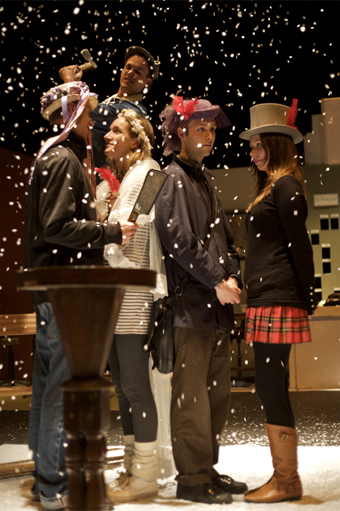
Coney, A Small Town Anywhere, BAC, 2009
photo Bryony Campbell
Coney, A Small Town Anywhere, BAC, 2009
In a work like Coney’s A Small Town Anywhere everyone in the room is playing (or is at least aware that a play state is in existence) and governs themselves accordingly. Participants are performing and not performing at the same time. As Guardian reviewer Lynette Gardner describes her experience of the production, “By the time I turn up for the show, I have written my own backstory, which includes a grim secret about (a) murdered baby. The show doesn’t require any acting skills, and, because there is no audience in a traditional sense, all social anxiety about being on show or not doing the right thing quickly evaporates. I play it as if it’s real—and that’s exactly how it feels. For two hours, I lose myself in the show.”
In an interview in 2012, Coney’s Co-director Tassos Stevens explains to me that, “In some ways, Coney’s work is more about giving present audiences the space to play than it is ‘making play,’ certainly that more than ‘making games.’ The essential commonality between all the very different kinds of things Coney makes is the focus on the playing audience experience. Small Town is a framework that we create, which audiences fill in with their play. It’s about the group, the Town, the roomful of mostly strangers and everything about the group mind. It’s also about the web of individual narratives that players make for themselves, and how those interplay and a set of external challenges that change the stakes and the game (if they are paying attention). It’s about a community under pressure and what happens between a roomful of mostly strangers playing.”
Since 2009 Coney has built on the work of A Small Town Anywhere with the creation of Early Days (of a Better Nation) in which “the audience become part of a Small Country that can be anything it wants to be.” Early Days is the concept of Annette Mees, developed in response to the events of the Arab Spring, Occupy, Anonymous as well as the London Riots.
Play-tested in various locations from Stoke Newington International Airport to the Battersea Arts Centre, Coney describes Early Days as containing “elements of constitution, economic cuts, an assassination, a leadership election, an economy of beans and a live news channel.” The playtests so far have involved seven performers including “one noble leader, two clerks representing the governing machine, (and) three media reporters who were streamed live to a 24hr news broadcast in the room.”
In one way or another, New Games such as A Small Town Anywhere and Early Days (of a Better Nation) are systemic engagements designed to give shape to lived experience. They allow for and respond to player agency within constructed narrative environments. They give participants the chance to practise ‘ways of being’ in ‘not for real spaces.’
Coney, A Small Town Anywhere, Battersea Arts Centre, August 2009; Early Days (of a Better Nation), ongoing development from 2012
RealTime issue #115 June-July 2013 pg. 13
© Robert Reid; for permission to reproduce apply to realtime@realtimearts.net
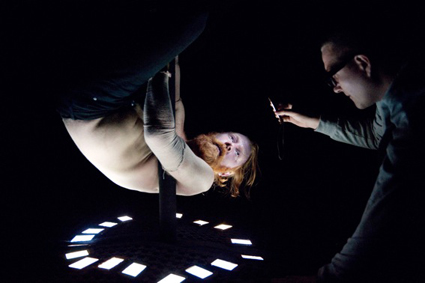
Skye Gellmann, Blindscape, Next Wave Festival 2012
photo Sarah Walker
Skye Gellmann, Blindscape, Next Wave Festival 2012
Contemporary circus is a wonderfully open form. It harnesses a multitude of approaches that stem from the notion of ‘Circus’ as the central informing principle. There continues, however, a prevailing opinion that circus skills should only be harnessed for performance when they reflect a narrative/contextual intent—that the display of circus skills, in and of themselves, is somehow gratuitous.
It seems to me that underlying this attitude is a belief that circus as an artform is somehow second rate unless it is woven into another, more worthy, artform such as text-based theatre or contemporary dance.
While I am in no way arguing against the use of circus in conjunction with other elements—text, movement, narrative, or character—I would like to make an argument for the acceptance of circus in its own right.
Over the last year I have seen a series of new works from emerging companies that demonstrate the unique role circus skills play within a performance text. In these pieces, circus skills are used variously as metaphors, character traits, moments of narrative exposition, key elements of mise en scène, heightened atmospheric moments or avenues for creating tension, suspense, surprise, shock or as ways to skew reality and challenge conventional perspectives. At the same time, the acrobatic bodies are used as sites to explore gender, sexuality and race. These works also consider the possibility of circus as pure spectacle, as part of the interplay between form and content.
Skye Gellmann, Blindscape
Skye Gellmann’s Blindscape can be reduced to two main elements: audience members individually navigating the open space through narration and sound effects from an iPhone; and two performers pushing the boundaries of their physicality, as individuals, with each other and with the audience.
Pure spectacle arrives as an element when the artists perform feats of extreme acrobatics on the black circus pole which is the visual centrepiece of the work. The question for me at this point, is what is the iterative effect of this moment? We, as audience members, expect this piece to include circus, and have been watching a series of body movements leading up to this point. Yet until now, all of the physicality could arguably be described as heightened, realistic, dramatic expression. Is there a moment where the work stops being contextual, and presents a moment of pure spectacle? Or has the gradual build-up of dramatic body movements ensured that this moment is just another in the fabric of exploration found in this piece?
Melissa Reeves, The Lost Act
With The Lost Act, playwright Melissa Reeves has created a unique script which utilises a kind of vaudevillian realism, much along the same lines as the literary genre of Magic Realism. In this work-in-progress (directed by Suzie Dee) Reeves collapses the naturalistic world of her characters with that of a vaudeville show. Throughout, the relationships between performers in a circus act completely mirror the relationships in the dramatic narrative. The plot revolves around a young set of siblings in search of their lost parents, who once performed an infamous circus act. At the same time, the siblings are themselves seeking to create their own new act, or, perhaps, recreate that of their parents. Within this plot, Reeves explores notions of identity in a post-colonial world. It is a world in which nothing is quite what it seems, and reality itself is a performance.
Once again, like Blindscape, The Lost Act allows for the possibility of spectacle for its own sake, with a number of scenes that present pure circus skills. However, these are more than mere divertissements, as they are an integral part of the world that is being made. It would be interesting to see how this interplay between naturalism and vaudeville evolves in a full-scale production, so I hope this show reaches the next round of development.
Polytoxic, The Rat Trap
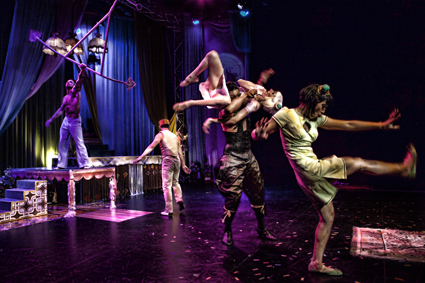
Polytoxic, The Rat Trap
photo Stills by Hill
Polytoxic, The Rat Trap
Queensland company Polytoxic’s The Rat Trap is, on one level, about pure display from go to whoa. It tells the tale of Siamese twins, separated at birth and reunited in a Tiki bar where burlesque acts are indistinguishable from the extraordinary lives of the artists who inhabit them. The show has powerful themes, yet the pleasure, skill and showiness of the circus sweeps around these, giving us a sense of being at some kind of fabulous cabaret, rather than at a serious piece of theatre. At the same time, because the characters are performers in a Tiki Bar, the circus skills are to some extent, though not completely, motivated actions within the narrative. I would call the circus in this context a kind of “Nietschean excess”—the circus is representing that which is beyond definition, or limitation. It is not hiding the narrative, it is exploding from it! If The Lost Act is vaudevillian realism, The Rat Trap is burlesque hyper-realism.
Rat Trap’s vignettes evoke fantastical ideas, but the physical exploits within them are real. This show totally up-ends the idea of reality, and inspires audience members to question the very notions of place, presence and identity, all the while convincing us that we are in an escapist dream. Pure spectacle is the essence and the trump card of this show.
Sara Pheasant, Leggings are not Pants
In Leggings are not Pants, Sara Pheasant, directing performers from the Women’s Circus in Melbourne at 45 Downstairs and Gasworks Circus Showdown, deftly uses circus to heighten themes of gender, sexuality and, ironically for circus, the mundanity of everyday life. For example, a group of women watching television perform a chorus of naturalistic movements which build to become spectacular acrobatic tricks. This allows the skills to be interwoven in the piece, and yet emerge in key moments of strong spectacle. These function much like music in a film. They heighten the audience response to each scene, and occasionally provide an extended exploration of its emotional heart.
Casus, Knee Deep
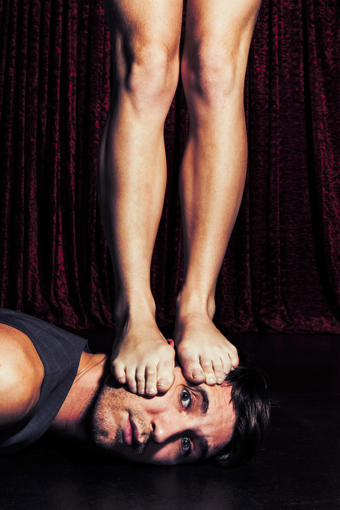
Company Casus, Knee Deep
photo courtesy the artists
Company Casus, Knee Deep
Knee Deep, by Casus, is a unique work, inspired to some extent by the work of Circa, in that it combines highly athletic circus with a pared back aesthetic. Casus does, however, bring something new to the table. Over the course of the piece we see distinctiveness and quirkiness emerging from each of the cast members. This is mostly achieved through exploring each performer’s relationship with a raw egg. As a framing device, the egg also reminds us of the fragility of life and creates a striking juxtaposition with the strength of the circus performers. This show has a light touch, and invites us into the world it creates, yet, at times, as with many of the pieces discussed, often opens up moments for the celebration of pure circus acumen. Individual acts climax with great skills that seek, and receive, applause. In the context of this show, these spectacular moments are triumphs over the fragility of human existence.
These works demonstrate that circus, even when it is presented, arguably, as skill for its own sake, is always doing more. Circus is much more than a trope or a narrative device. It is a complex ‘body of representation’ which resonates uniquely in each work.
Circus artists/creators seek to use circus skills in performance for myriad reasons: to harness a populist form; to develop a craft they have been honing for years; to use circus as a history of representation from which to draw images, metaphors, characters; to work with an artform that offers freedom from linear, text-based, narrative-driven theatre; and, ideally, freedom from the gendered and cultural stereotypes of dominant discourse.
Ultimately, circus-based theatre makers draw from all of these inspirations to create their work. First, and foremost, they select circus skills ipso facto, for their own sake. Circus is the form from which all else follows.
Blindscape, PACT, Sydney, 19-29 June and touring throughout 2013; The Lost Act, presented as a rehearsed reading in 2012, is scheduled for development in 2013-14; The Rat Trap premiered in 2012, with further seasons in 2013; Knee Deep is touring internationally this year.
RealTime issue #115 June-July 2013 pg. 14-15
© Antonella Casella; for permission to reproduce apply to realtime@realtimearts.net
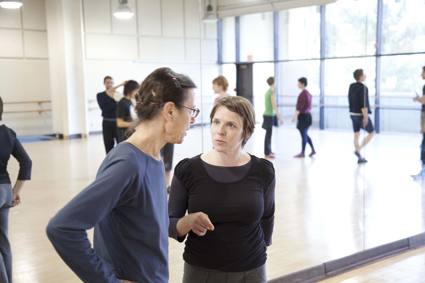
Yvonne Rainer, Sara Wookey, Trio A, UC Irvine
photo Scott Kliger
Yvonne Rainer, Sara Wookey, Trio A, UC Irvine
The measured toe-tapping, the headshaking hand-flapping. Sara Wookey is performing Yvonne Rainer’s landmark mid-sixties dance Trio A. Compared to clockwork more than once. Trio A keeps on going steadily, evenly, and never repeats. Its movement vocabulary—stepping, swaying, bending, rolling over—looks a lot like everyday movement.
Artist Sara Wookey is one of five people vested by Rainer—certified, Wookey says—to perform and teach the four-and-a-half-minute Trio A. Re-engaging with Trio A is timely: the Judson Dance Theater’s 50th anniversary was celebrated this past year, and the question of re-performances of 1960s-70s works remains topical. Wookey was in Australia during April at Rainer’s request to speak on Trio A and run workshops in Perth, Sydney and Melbourne through New York City’s biennial Performa program. Wookey’s latest work, Disappearing Acts & Resurfacing Subjects: Concerns of (a) Dance Artist(s), considers the fragility of body memory against fixed representations, and she has initiated reDANCE, which revisits Judson-era dance: projects highly congenial to Trio A.
In Sydney, Wookey explains that it took Rainer six months to make the work. Learning it is challenging, because even the gaze is choreographed—though it is intended that even non-dancers could do it. The body is held as if you’re not thinking about it, just walking to the corner shop or doing something like opening a door or sitting down. Trio A and Judson Dance have considerably influenced contemporary practices internationally, including Australian dance and performance art. Walking, falling, carrying people like objects; no music; non-narrative breaks; and, most surely, a concern with unadorned movement—all of these came from the Judson dancers’ rejection of the priorities and perceived excesses of ballet and modern dance.
When Wookey asked Rainer what ‘certified’ might mean, Rainer unhesitatingly said it was about transmission—like a radio transmitter, Wookey adds. Her performance of Trio A is as precise as that implies. And she gets the attitude right, simultaneously conveying intense focus—Rainer was known in the 1960s for her performance persona, just as she was known for her explicit wish to be a straightforward ‘doer,’ sans glamour or star quality—and Trio A’s matter-of-fact, workmanlike feel.
In her lecture-performance, Wookey demos Trio A straight, and then as an ‘unplugged’ version, uttering Rainer’s aptly descriptive teaching cues as she performs each movement: at one point, arms hang ‘like rocks on strings.’ In Judson style, words can be equivalent to actions: for a handstand, Rainer might now just say ‘handstand.’ The third version of Trio A that Wookey performs in Sydney is set to music, the Chambers Brothers’ In the Midnight Hour. Wookey manages her timing perfectly: both dance and music wrap up at the same moment. This version, presented in exactly the same way by Wookey, now suggests, with deadpan irony, the funkiness of 60s popular culture.
Wookey succeeded in ‘transmitting’ Trio A as a crystalline lens, itself an object of brilliant clarity, and one whose focus is as sharp as ever.
Sara Wookey is the Artistic Director of Wookey Works Studio: www.sarawookey.com; www.redanceproject.org. Sara Wookey, “Dance is Hard to See: Capturing and Transmitting Movement through Language, Media and Muscle Memory,” 13 April, workshop 9-12 April, Io Myers Studio, University of New South Wales, hosted by Performance Space, Sydney
RealTime issue #115 June-July 2013 pg. 15
© Meredith Morse; for permission to reproduce apply to realtime@realtimearts.net
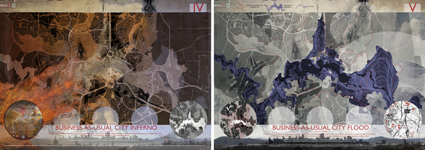
Sedimentary City Canberra by Brit Andresen and Mara Francis, Urban Innovations Collaborative, CAPITheticAL Design Competition
photo courtesy Canberra 100
Sedimentary City Canberra by Brit Andresen and Mara Francis, Urban Innovations Collaborative, CAPITheticAL Design Competition
“My feeling is that the program in print and online is always a mere blueprint and you really rely on the people to take it up. It’s like my feeling always that the cultural landscape of any place is a three-legged stool: it’s audience, artist and the dialogue that surrounds them. If any of those three go astray you’re probably in trouble. In this case, I think the people of Canberra have taken up the blueprint and used it.”
When I meet Robyn Archer in Sydney to discuss the progress of Canberra 100, of which she is Creative Director, she’s more than pleased with the response she’s had from the people of Australia’s capital, great turnout at events, people thanking her in the street and “projects that are generating opportunities for local artists like never before.”
Legacies
Archer is particularly pleased with the national interest Canberra 100 has generated in the media about the city’s designers Walter Burley Griffin and Marion Mahony Griffin: “That was intentional, to say why don’t we just hark back to bold beginnings and ideals and aspirations. My focus since the beginning of the year has been, what’s the legacy going to be? It’s good to have everything going on this year but we hope that the seeds we’ve planted are going to have a legacy into the future.”
One legacy Archer points to resides in Canberra 100 promoting “just how much fodder there is for artists in terms of the Australian story in places like the National Film and Sound Archive, the Library and Museum. Terrific reference points all over the place.”
Street swag art
Among a number of exhibitions at independent galleries that have impressed Archer, she was particularly taken by Flipside curated by Merryn Gates: “an exhibition about homelessness in Canberra. Street Swags are made by Jean Madden in Brisbane in consultation with homeless people. They’re very light canvas with a light foam lining, fold up as a shoulder bag and have been given to 26,000 homeless people already. There’s one of these in the show but it’s beautifully printed by Gates with images of Walter and Marion Burley Griffin (Dream City, 2013). I love it and we’re hoping to do a project about homelessness in the capital in the future.”
Parties at the Shops
Archer is especially delighted by the success of Parties at the Shops. “My thinking right at the beginning was well, if we can do you a spectacle on 11 March, on the actual birthday of the city why don’t you do it for yourselves as well—parties at your local shopping centre that you can walk to. Well, it was unbelievable. I visited 17 on the one day. In Yarralumla, the residents had a dinner. There were 450 people sitting outside under the trees eating and dancing to a Zydeco band. The one at Watson was similar with about 600 people. But what was so moving was a really tiny place whose one shop is a graffiti-ed convenience store. Two hundred and fifty people had a barbeque, double garage doors rolled up and DJs playing. Out of that they decided they’d revive the Residents Association. They were saying really beautiful things like “next time—already with the idea that there would be a next time—we’ll invite the people from the suburb next door because all their shops have closed. I think that Parties at the Shops and You Are Here (the 10-day multi-arts festival spread around the CBD showcasing Canberra’s emerging and alternative arts communities) are the real ‘no-brainers’ that will survive.”
Celebrating the cultural calendar
Part of the reason for Canberra 100’s immersive character is Archer’s incorporation of the city’s annual events and national conferences into the year long celebration: “It was really about profiling the natural cultural calendar of Canberra anyway—things like the Canberra International Music Festival are really fantastic. It’s one of the festivals that I think should be encouraged in the future, mainly because Chris Latham has brought it into Griffin-inspired venues in the series of three that he’s done. So as with the best festivals, you get to explore the city. What I did was to look at what was on the cultural calendar already, make people aware of that but then plug some of the gaps and introduce some new ideas. There are so many conferences on and, to my chagrin, so many opening or closing on Saturdays and Sundays. Days off are now a thing of the past (LAUGHS). So many organisations chose to have their national conferences in Canberra this year.”
Archer has to make many an opening speech during Canberra 100. The day we meet she’s to open an Arthur Boyd exhibition “about his political life, at the Museum of Australian Democracy—part of the ongoing series they’re running all year called The Art of Influence, which is all about arts policy and political engagement. Last week was the Gallery Guides’ Conference, next I address the Midwives’ Association and then the Museums Australia Conference. So, Canberra 100 is big, very mixed and it’s full-on the whole time—and it jumps around violently from things I know little about to things with which I’m very familiar.”
Science and art
Science is a significant component of Canberra 100, in Science Week and beyond. “The science credentials of Canberra are amazing. There’s been a series of Canberra Nobel Laureates coming back to talk about their work. But the interface between art and science is also enormous,” says Archer, citing the work of Erica Secombe, who has been working with CSIRO but also now with the ANU Department of Nuclear Physics using their imaging technology. Erica looks at what they’re doing and, to some extent, her investigation is driving some of their research, which is the best possible collaboration. This is again about Canberra as a resource. And also about artists who come from science families: David Finnegan, one of the founders of Boho Interactive, his father was at the CSIRO and Huey Benjamin who’s composing for Garry Stewart’s new work for the Australian Ballet, Monumental, is from a science family in Canberra.”
Celebrating First Australians
A major component of Canberra 100 is the Indigenous program: “I’m particularly proud that the people who’ve produced that program are in Mildura—Helen Healy’s HHO Events. It’s really nice to think of the national capital stimulating a very big national Indigenous program that’s operated out of Mildura.
“Kungkarangkalpa: Seven Sisters Songline, performed by senior dancers from Central Australia outdoors at the National Museum was fantastic. Wesley Enoch did a great job on that of telling the story very, very honestly. He provided just a beautiful simple, screen-based background for traditional performers to bring their story down for the first time.” With a large program spread across the year, Celebrating First Australians has its own printed program (also available online).
“Canberra 100 is all about changing perceptions of the national capital—it’s actually made people aware of a very strong local Indigenous community. We’re showing the work of many, many local performers and artists. Jenni Kemarre Martiniello is a glass artist who has been working with Venetian glass technique to create interpretations of eel traps—they’re absolutely exquisite. She has a studio at the Canberra Glass Works. This celebration is about a young singer like Anita Barlow and established ones like Dale Huddleston and his family. The ACT’s unique in that it has an elected Indigenous body that looks after the interface between local policy and consultation directly with the ACT government, and they told me, ‘You’ve really got to get to the grass roots of stuff. There’s a mixed touch footie carnival at the Boomanulla Oval. Get out and do [Canberra 100] there.’ Locals don’t think that there’s an Indigenous community here and yet we’ve been taken out by one of the rangers, Adrian Brown, to rock art sites that are dated to 800 years old and they’re 30 minutes out from Canberra.”
Coming up in the Celebrating First Australian’s program is Big hART’s Hip Bone Sticking Out, QL2’s Hit the Floor Together which is being led by young Indigenous choreographer Daniel Riley McKinley and a forum entitled Inside Out—“the first day will be an overview of the past and where activism has got us to this point. The second day is given over entirely to younger groups—particularly those who are using cultural pathways for activism, artists like Warwick Thornton. On the second day it’s much more about people who are taking the cultural route to demonstrate and others working from the inside. Nothing could be plainer than Thornton’s Samson and Delilah to tell you how it is and then it’s up to you to go there. Others like Tim Goodwin are going inside. He’s a terrific lawyer who has been working for the High Court in Melbourne. He was a Fulbright Scholar. He’s going the legal pathway—more the Larissa Berendt sort of path. So, many, instead of demonstrating on the outside, at the fringes, in the street, are coming into the professions, getting all the craft and skills and doing it that way. But whenever I say that to some senior Indigenous leaders they say, ‘Yeh but is it just a cop out? Are they just doin’ the art and not doin’ the stuff on the streets, ‘the hard stuff?’ That forum will be on in association with NAIDOC Week and there are a number of exhibitions as well.”
Archer says of Hip Bone Sticking Out, that Big hART “has been working in Roebourne in WA for a long time and Roebourne is, as we know, a very divided community over whether mining and its returns are a great thing or are just going to stuff everything up. Big hART have been working mainly with young kids and really looking at a very optimistic future. Whatever happens the kids will take it on, bring it on. We’re giving free tickets to the local Indigenous community so they actually get to see all the shows and meet and talk to the artists.”
Future Canberras
If Canberra 100 asks locals and all Australians to take a fresh look at the city, its creative history and what it offers now, not least for emerging artists, what has been the role of the event in terms of speculating on Canberra’s future?
Archer says, “I think the most significant change to Canberra will happen if the high speed rail ever gets up—whether that’s in our lifetime or not, but at some point it will, and that will change things. If you can live in Canberra and be 45 minutes away from your job in Sydney there will be a lot more people who will want to live in this pristine bushland and that will drive a whole lot of necessary environmental changes because there isn’t really enough water even for 370,000 people. Scrivener the original surveyor thought there was enough for 250,000 people and he was right but the need has become more and more pressured and with Climate Change it’s exacerbated. One presumes that necessity will be the mother of invention.”
The issue of the future was addressed by offering landscape architects the opportunity to imagine a Canberra of the future in the CAPITheticAL design competition. Archer wanted the entrants “to put themselves in the same place as the competitors who had to design the city in 1911” but for a 21st century Canberra. She points out that for many of the entrants sustainability and a sense of democracy were high priorities. There were 1200 expressions of interest and 114 entries from 24 countries from which 20 were chosen for exhibition at the Gallery of Australian Design and judging for a $70,000 prize. The winner, Ecoscape’s The Northern Capital, which would doubtless appeal to Tony Abbott and Bob Katter, maintains the ACT city for Parliament and the public service, but creates a new city “on the edge of another manufactured lake, namely Lake Argyll in the Kimberley region… to deal with Asian and northern development.”
Second prize went to the quite beautiful if equally disturbing Sedimentary City Canberra, aerial views of city and surrounding landscape into the future. Curator Michael Desmond describes the entry, created by Brit Andresen and Mara Francis of Architecture and Urban Innovations Collaborative (A+UIC), as dealing with time, “shrinking and contracting both the lake and the city in response to drought, fires and the full effects of climate change and economic fluctuations, showing the city as a living organism, tuned to the epic history of humanity” (catalogue).
Skywhale
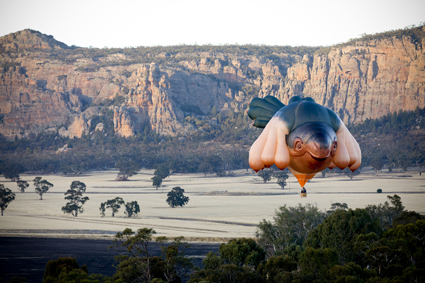
First Flight, Skywhale, Patricia Piccinini
photo Mark Chew
First Flight, Skywhale, Patricia Piccinini
Canberra-born visual artist and sculptor Patricia Piccinini has strikingly realised a melding of past and future in Skywhale, a full-scale hot air balloon in the shape of a recognisably Piccininian hybrid, here a multi-breasted, benign maternal mammal, lingering contemplatively over the Australian landscape—evoking both ancient mother goddesses and evolving mutancy. Not surprisingly, Skywhale has been greeted with both repulsion and fascination, and some nonsensical and censorious politicking. Festivals that celebrate the past certainly sustain and reinvigorate legacy but unless they have vision, asking where are we are now and where are we going, and demonstrate these—they will have no legacy of their own to bequeath to future generations. Robyn Archer has built a centenary with an eye to the future.
For the program for the next six months of the Canberra Centenary go to canberra100.com.au and look out for a forthcoming RealTime e-dition guide to the festival.
–
See Robyn Archer talking about Canberra 100 back in November on RealTime TV
RealTime issue #115 June-July 2013 pg. 18-19
© Keith Gallasch; for permission to reproduce apply to realtime@realtimearts.net
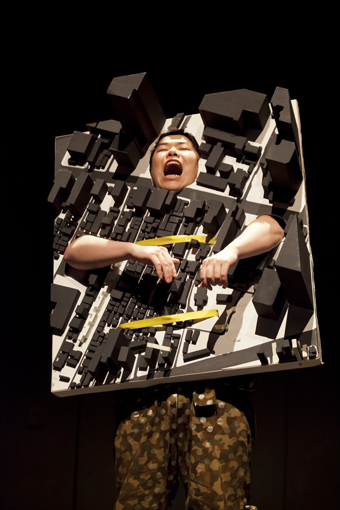
Noriyuki Kiguchi (Akumanoshirushi)
photo Hideto Maezawa
Noriyuki Kiguchi (Akumanoshirushi)
Asakusa, Tokyo. The temples remain but the modern skyline grows: The Tokyo Skytree is the tallest building in the world; and Asahi Art Square, host of the Azumabashi Dance Crossing showcase, makes up for its smaller stature with an ostentatious tear-drop sculpture on its roof. Lit up at night, it is affectionately known as the “golden shit.” How the modern and traditional often seem incongruous in Japan.
In previous years the focus was on Azumabashi DANCE Crossing, but with the selection of works by curator Keisuke Sakurai, himself a choreographer and dance critic, the emphasis is now on CROSSING: hip-hop-rakugo, turntable-butoh, Zen-7/11-thrashmetal…in short, hybrid-performance.
The festival’s theme was “groovy bodies”—a rather vague and none-too-serious theme for post-tsunami, post-Fukushima Japan. Addressing this issue in local media before the event, Mr Sakurai said, “This 2013 edition of ADX was conceived in an attempt to reconsider not how art can serve an instrumental or practical purpose, but precisely its apparent ‘uselessness’—as well as the potential usefulness of this futility, if you will.”
The evening began with dance from 21seiki Gebageba Buyodan. It was a wishful and grotesque piece that shifted between mimed daily chores and the movement of addiction in daily life…perhaps a literal interpretation of “groovy bodies.” Danced to music best described as Middle-Eastern-ragtime, these abstractions of movement were playful or sometimes monstrous, such as the gathering of all the red-shirted dancers centrestage, standing back-to-back in a circle, to mime the eating of giant onigiri (rice balls). Subtle changes in pace built a tension that was sadly cut short by the allotted 20 minutes.
Next was Noriyuki Kiguchi’s irreverent meta-theatre. A man dressed as topographical Tokyo revs up the audience while on the screen behind him entries from Kiguchi’s diary explain possible ideas, lack of arts-funding and the difficulties of creating a piece for ADX. Kiguchi himself is called centrestage where he receives a shocking slap for said navel-gazing. This direct yet fractured social commentary is but one example of the influence of Oriza Hirata’s colloquial language style of theatre in the 1990s. Kiguchi’s final image—of the Japanese Emperor (who made a rare public appearance after the Tohoku earthquake) dancing the salsa while his wife (a man dressed in drag) encourages him with over-polite smiles—seems at first to be naff and inconsequential, but perhaps best grapples with the relationship between public face and private grief.
The offering from Toukatsu Sport was just as fractured in its conception. Projected on the back wall was the opening to Roman Polanski’s film adaptation of Carnage. Before we enter the apartment of the sitting-room drama the strings of the soundtrack are faded out and replaced by House beats, the film replaced by turntables, and two women who walk on stage dressed in hip-hop bling, carrying stuffed toys. They begin a rapid-fire monologue of what my +1 would later call “journalism of complaint”: about the venue; about recent pregnancy; dissing other theatre groups. Images alternate between Carnage, turntables and traditional rakugo (pithy anecdotes laden with puns and comedy). Language barrier aside—even the Japanese around me were struggling to keep up with the speed of the dialogue—it was enthralling to watch the English, American and Japanese story-telling in mash-up.
After the interval, the band core of bells opened our ears. When a young man walks into a convenience store to trade in his soul for a new one (for Y7400) he is invited to play guitar in a noise-band whose frontman is a growling Shinto God. Ko Murobushi performed butoh, with music provided by Yoshio Ootani’s distorted, looped saxophones and chains on turntables. Joined by members of the former’s company, each performed their own personal calligraphy of a collapsing city while Ichiro Endo, cheerleader, performed a heartening if baffling motivational dance. The difficult joy of ADX is having all these artists brought together but being unable to create or comprehend a super-narrative.
The evening concluded with Takahiro Fujita’s Dots, Lines and the Cube. His company, Mum and Gypsy, has been focused on a form of post-dramatic theatre since its formation in 2007. DLC tells the story of a kidnapped girl from the perspectives of three characters. The actors hopscotch around lines created with masking tape. The energy on-stage is that of a child’s wind-up toy; when the energy of a refrain is expended the story is wound up again and told from a different perspective, in uncanny mimicry of the news cycle of a traumatic event. It has all the uselessness of a game, but perhaps, as Mr Sakurai suggested, there is a potential usefulness in the futility.
Azumabashi Dance Crossing, Asahi Art Square, Tokyo, 29-31 March
RealTime issue #115 June-July 2013 pg. 20
© David Maney; for permission to reproduce apply to realtime@realtimearts.net
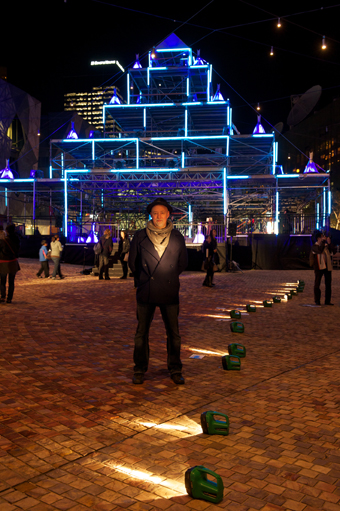
Bruce Ramus, Light Hearts, Light in Winter Festival, 2011
photo Jason South
Bruce Ramus, Light Hearts, Light in Winter Festival, 2011
Canadian Bruce Ramus, a master of what he calls “integrated light art,” resides in Melbourne, his company’s base for the creation of large-scale public artworks. In 2011 he made Light Hearts for Federation Square’s The Light in Winter festival; he’s lit the Sydney Opera House for VIVID, illuminated Darling Harbour with Luminous, lit the Wintergarden facade in Brisbane and turned a sports park, AAMI, into a constantly morphing light sculpture.
Earlier in his career Ramus was responsible for the spectacular lighting designs for U2 and REM and their huge concert audiences. Today he is focused on the use of light to engender a sense of community in a different way, and sustainably so. I spoke with Ramus about the making of and the goals for a new, commissioned work for the 2013 Light in Winter, The Helix Tree.
You’ve had a long association with the relationship between light and music and of course the voice when you work with bands, but the brief for Light in Winter one looks pretty interesting in terms of its requiring a direct relationship between light and voice. Is it a relatively new thing for you?
We’ve been working on pieces that are interactive for about three years now. We installed a much larger one at Darling Harbour last year and that was very interactive, but not for voice, and the last piece we did in Fed Square, Light Hearts, had a very low-tech interactivity about it, encouraging children to make lanterns.
But we’ve been putting together a portfolio of ideas, software and code to enable us to make the most sense of these opportunities and make it mean something. It’s our way of trying to create spaces for community engagement with light.
How is this work specifically interactive?
It responds to two elements of voice, pitch and amplitude. The amplitude alters the brightness of the lights and the pitch changes the colour. The idea is that each evening at dusk a different choir comes to the piece and sings it to life. They will sing directly to it and make it change. The movement is pre-programmed but the actual volume of the voices allows the brightness and the movements to be revealed. The pitch changes the colour of the light as it’s moving.
Then, once the choir finishes, there’ll be a period of time when the public themselves can sing to it. After that it will go back to its own program and its own rhythm. That will be happening from 8.00 o’clock each evening until dawn the next day. Which gives the tree a chance to breathe at its own rhythm.
What kind of microphones and sensing devices are you using?
We’re experimenting with that now. I don’t know the specifics of the kind of microphone that we’re going to choose; that’s down to our sound designer. But it will be a centralised microphone. It’s not like a vocal microphone that you sing into. It’s directional, picking up the voice but it has a very narrow band of reception so it’s not picking up the wind and the traffic—just the voices that gather around it.
Your work is quite sculptural. How does this manifest in the Helix Tree?
I started to look at the helix as a shape and I was inspired by the way it depicts an infinite flow of energy; it just keeps twisting and turning in space. I also noticed that helixes don’t impose on other helixes in nature. They intertwine—they’re harmonious. You don’t find competing helixes. They co-exist and create this harmonious energy. You can see it in trees and in the DNA of all of us, in our ear canals. Because community engagement is such a huge mandate for Federation Square, I began to see how it might make sense as a shape for this project. I saw how it could symbolise healthy families and communities where you have individual strands of energy— people—and when they don’t impose on each other, there’s harmony.
And the idea for the tree itself?
I loved the notion of power without resistance, the adaptability and flexibility of a tree where it is in true harmony with its environment. It gets pushed and pulled and moved around by nature but it maintains its strength without resisting.
A very strong metaphor. What materials are you using to build the tree?
The tree itself is built from mild steel pipes made from largely recycled steel. The large helixes are 219 mm wide and the smaller ones are 169 mm. Each one of those is about 21 metres long, making the overall height of the tree about 13 metres.
Is it an abstract shape that evokes a tree?
Yes. There’s a trunk where all the helixes begin within about a metre and a half of each other. So it’s very compact down at the base, and by the time the branches are at their widest they’re about 17 metres apart. It’s abstracted but one can certainly get the reference that this is a tree.
What kind of lighting devices are you using?
It’s a type of neon, but not actual neon with gas—that’s a little bit impractical for such a short period of time. We’re using LED neon that looks very similar but is essentially an RGB LED encased in opal plastic. So there are four strands of that on the large helixes and one on the small. There are 21 of these 21-metre long helixes. The idea is that the tree feels luminous. It doesn’t have fixtures attached to it per se, so it will feel like the tree is emanating light.
Do you feel this work has extended your own practice in some ways?
It sure has! Doing sculptures of this size, starting from nothing and doing the engineering design and fabricating this amount of steel, it’s very complicated. Imagine you’re looking at three seven-metre long pipes that are 220mm wide. That’s a big pipe. We bend that pipe and then we cut the pipe into about five sections and then twist each section, say five degrees, and re-weld it. The next one gets twisted seven degrees and re-welded. The next one is twisted 10 degrees and re-welded. So you get a helix curve out of something that doesn’t look like it should curve. And then when we go to erect it…it’s a mind-bender. And that’s only the tree, there are still the three ponds that it will stand in to build, and a very large viewing platform…all to give space for reflection.
It’s been a great learning process and a wonderful extension of my ability to see in three dimensions and to visualise. It’s too easy to grab the re-size tool on a CAD program and drag it till it says 13 metres. I’ve never tried to put so many very complicated curves into one very compact space.
So it’s turned into a major sculptural challenge?
Yes, it has. The site itself throws up challenges as well because, as you know, it is built over railway lines so there are significant weight-loading restrictions. The square is also covered by catenary wires that are about 14 metres tall, which make it difficult to get a crane in between all the wires…then there’s the high pedestrian traffic and the limited time…it’s not straightforward, but we love a challenge!
The great reward will be a sense of communality.
That’s the hope…that it will feel like a healing energy, some kind of communal harmony; that it brings some peace to the centre of a city—especially the one I live in. That’s a feeling that for me is rare. It’s not every day you get to put something like this in place. And we’re hoping that once it’s done it will be purchased for permanent installation.
The Light in Winter, director Robyn Archer, Federation Square, Melbourne, 1-30 June
RealTime issue #115 June-July 2013 pg. 21
© Keith Gallasch; for permission to reproduce apply to realtime@realtimearts.net
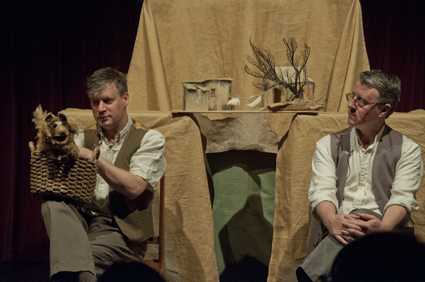
The Man Who Planted Trees, Puppet State Theatre Company
photo J Barker
The Man Who Planted Trees, Puppet State Theatre Company
Castlemaine. A town rich in gold mining history. Set around a river that never runs (but often floods). A town where every second person you meet is a writer or artist. The best of inner city—coffee, dumplings, markets, gigs crammed into two big blocks. The best of rural as you watch roos and rosellas in your backyard after rain. A town where beautiful old buildings stand and decay. And every two years, an ambitious 10-day program of theatre, music, literature and visual arts.
Apparently you need a grandparent buried in the cemetery to call yourself a local, but I’ve been here nine months and this is my first festival. I can walk. Everywhere. The laneways are covered in works by high school kids. One stencil of a reindeer on the wall of the Bendigo Bank—with the accompanying inscription “Christmas is a lie”—causes outrage. A stealthy graffiti artist comes at night to blacken the inscription out. Makes front page of the local rag. You can’t offend Santa in this town. Or what’s his name, Jesus, for that matter. But does the teen artist remember a time when Christmas was about more than Masterchef-ing the BBQ, or cheap gift tags from the two dollar shop?
“I need a dollar, dollar, a dollar is what I need”
[soul singer, rapper Aloe Blacc]
Ranters Theatre, This Is Me—Now
Actually, the festival is rich with insight into what young artists think. In This Is Me—Now, Ranters Theatre creates video portraits with five teenagers from the region: Ruby Benedict, Ruby Scott, Bonnie Cook-Hain, Eamon Coulthard and Holly McNamara. The videos are about identity and space, and the rules of longing and belonging. Holly is a girl straight to camera, sitting in the bush. She describes it as a “very unconditional space…doesn’t need anything added to it” as she performs a soft-spoken song on her ukulele. Ruby Benedict does a performance piece to camera, becoming ‘the huntress’ on a red velvet couch. Ruby Scott turns her back, drawing a surreal cityscape that morphs into a creature as her voiceover draws me in. Bonnie, swinging her legs over the railway platform, sees herself as a girl who can’t conform—“most girls want to fit in…the in crowd”—and doesn’t care. In her white roller skates she talks about her love of books, music, family, friends and contact sports: “I like being pushed around on the field…Being different makes me feel confident.” Eamon imagines Castlemaine in a state of heightened anxiety—‘lock down’, ‘code red’—a place undergoing rapid (and sinister) change, where spikes are placed on the tops of buildings to ward off birds, even though no birds ever land there.
The Republic of Trees
But the birds have plenty of other places to land. Castlemaine is the kind of place where gleaning is encouraged. Organised groups fossick from trees ripe with apples and pears, distributing extras to community centres and local childcare. A living stage at the festival has planters. Tales of trees, of eco-survival, permeate the performances. In The Republic of Trees (based on Italo Calvino’s novel The Baron in the Trees), a wandering minstrel show that meanders through beautiful Vaughan Springs, we encounter a dining table at dusk, with butlers in waiting and young women walking their dogs around the perimeter. We learn of creatures that can cross the country east to west, their feet never touching the earth. At midnight, Cosimo (Matt Wilson) joins the canopy, vowing never to set down again. Wilson’s physical theatre experience shows as he glides through trees on ropes and ladders, slippery with condensation. As we hear of God pissing down, rain starts to fall on us. Bookshelves and chairs are suspended, pulleyed, as we hear tales of yearning, philosophy, romance. For Cosimo, all that matters is principle, his ideologies of freedom, even if it means losing out on love. But his act becomes commodified, a display to be rolled out for an audience: “see nature’s greatest marvel.” And at what point—wars, horrors, exile, environmental degradation—is it more important to touch the ground?
The Man Who Planted Trees
In The Man Who Planted Trees, a farmer in Provence seeds hundreds of plants a day, in an arid region where nothing grows except wild lavender (the performers waft scents like lavender and mint over the audience with large fans). Scotland’s Puppet State Theatre Company takes us to meet him, accompanied by a dog (the true star of the show). The performance works brilliantly by paralleling two narratives: the straight parable, along with the dog’s meta-textual journey. A dog who just can’t help himself, he keeps butting us out of the narrative—“It turns out my eyes are buttons! Amazed I can see anything at all!”—to great comic effect. The timing is wonderful, the writing simple and complex (at once) and the show works on the level of all great children’s storytelling (The Muppets, Aardman) where the humour comes from where the two strands of narrative merge.
Site-specifics and Transplant
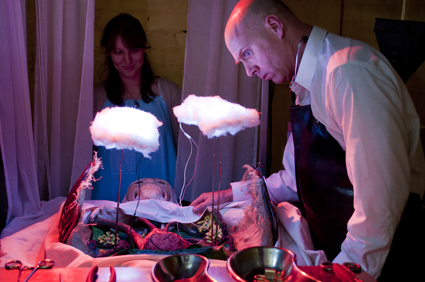
Such as they are, Transplant
photo E Dutra
Such as they are, Transplant
Back down on the ground and I head to the festival’s biennial visual arts program (curated by Deborah Ratliff), where the site-specific works are outstanding—Pia Johnson’s shrine of Chinese red packets, Hong Bao; Bindi Cole’s dialogue, I forgive you, at the Theatre Royal cinema; Tara Gilbee’s apothecary at Tutes Cottage; and Clayton Tremlett’s character sketches at the Old Police Lockup—before entering a tiny cube-theatre, and donning my scrubs for the puppetry production Transplant. As an operation goes awry and a woman unleashes frogs and flowers from her stomach, the actor-cum-doctor and his unpredictable patient manage to unnerve everyone to the point where I am the only audience member left in the room.
Chants des Catacombes
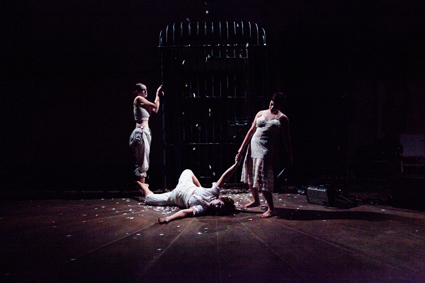
Chants des Catacombes
photo Pia Johnson
Chants des Catacombes
There’s a lot of talk of community in this town. And of protest too, for example the recent successful EPIC battle against the coming of the pokies. And now there’s the gaol. A beautiful and haunting site on a hill, looking over the town, it’s recently been sold for a pissy amount. There’s rumour of apartments. But it’s spectacular as a site for performance. The highlight of the festival is Chants des Catacombes. We arrive at the gaol at 11pm. Lit by small candles, we walk the flickering perimeter and are led into a dark space. Out of smoke, three screaming prisoners appear. Above and under us, the women are close enough to touch (and we do). They merge their foreheads to ours, pleading. They crawl through our legs, begging. Their voices soar through the corridors and down the narrow stairs as we follow them: a French showgirl in a salon (we loll on her bed as she plays the harp); a courtesan dancing for the general; a surgeon (under pretence: a woman pretending to be a man). And just as I’m thinking, “why do female characters have to be so passive?” the work takes up this question directly, speaks of Desdemona and Othello, shifts a gear to take up the fight.
The entire performance is told through contemporary song and dance, and undergoes a Baz treatment, morphing from the gender-bending Blur’s “Girls & Boys” to Nirvana to Portishead to Bowie’s “Let’s Dance” and even Kelis’ “Milkshake” for comic effect. The three central performers Anna Boulic, Laura Burzacott and Zoe McDonald are murder victims trapped in the underworld and they raise hell with their voices. The choreography and lighting—as the musicians and actors lead you through the space—entrap and confront you with your own fears of madness and confinement. The audience is jittery. They hold back and are compliant. But the performers stay intimate and in-your-face, restless with violence and payback. It’s a performance I longed to see endlessly on repeat—in a space I couldn’t wait to be released from.
Castlemaine State Festival, director Martin Paten, 15-24 March. http://castlemainefestival.com.au/2013/
RealTime issue #115 June-July 2013 pg. 22
© Kirsten Krauth; for permission to reproduce apply to realtime@realtimearts.net
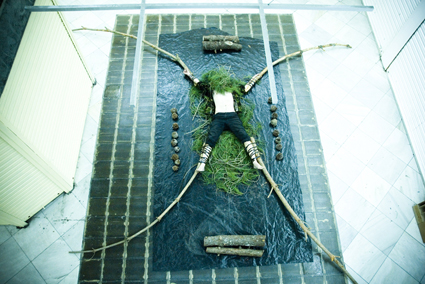
Henrik Hedinge, courtesy the artist
Exist-ence, founded by Rebecca Clunn in 2008 and co-curated by Clunn, Nicola Morton in 2013, describes itself as “a festival of live art, performance art and action art.” Although by no means alone as Arts House, Punctum, Performance Space and others nurture live art, it is certainly a unique festival in terms of ambition, continuity and growing national and international scope.
Entranced by Labanna Babalon’s (US) new age-punk-booty-popping online personality? You’ll be wanting to meet her in the flesh at exist-ence 5 where attendees might well be “sucked in by my venus flytrap booty popping and get a new perspective on life, aliens and why we’re all here (interview, www.vice.com).” Curator Morton, who first met the artist in 2008, says that Babalon’s performances can be quiet, candle-lit occasions. She certainly has an agenda: “You gotta put it in perspective of everything turning upside-down. Like, super right wing Christians almost seem like Satanists. Man becomes woman, woman becomes man. The Whore of Babylon becomes Jesus. All this stuff flips in order for us to graduate into 5D. Relaxed duality, the holy hermaphrodite embodying both of these things.”
Babalon’s overdrive new ageism and aura of sexual excess is an amusing mix of indulgence and critique, fantasy and realism; she’s like a logical extension of the hip Jessa in Lena Dunham’s Girls. “I have all sorts of idealistic and crazy fantasies, and I could also let go of them all and fall in love with one man and have a baby and hope the apocalypse doesn’t happen. But also, I wouldn’t mind having a Whoreship mansion filled with all my girlfriends and a whole floor of bathtubs and doing crazy love meditations that eventually cleanse the earth.” Morton tells me that Babalon’s Brisbane performance will be focused on “channelling her muse,” the subject of a rambling video currently online.
Boyish, long-haired Henrik Hedinge (Sweden) appears on Vimeo conducting odd tasks—walking on a row of wheat grain biscuits and making crude gloves for passersby with cabbage leaves and a stapler. But there are more visually striking, even disturbing instances of his work. Morton says that Hedlinge is currently focused on “morphing the body into the environment.” In recent work he has camouflaged himself in a room full of balloons, merged with foliage and now, “by strapping machine-like apparatuses to his body,” is becoming one with industrial society.
Other overseas artists in the program include Peter Baren (Holland) and John G Boehme (Canada/Australia). Baren’s work has been described as “multi-sensory…(his) ARK performances include fog, cling-plastic-wrapped performers, circling satellites, orphaned whisperings, molasses, written and spoken texts, boomerangs and more… to evoke a disquieting sense of primordial mystery, public yearning, fear and cultural reformation” (Lance Blomgren, LIVE2005 performance, Vancouver). Boehme, who now teaches full-time at Camosun College and is a seasonal lecturer at University of Victoria, has created many performances, including an edible spa (the artist bathing in and covered with food) and Canine Freestyle dancing with a small dog. A “trans-disciplinary artist, he writes, “I see Labour, Leisure and Sport as facets of the same unconsidered compulsion to fulfil societal expectations” (finearts.uvic.ca/~jgboehme). Also on the program is Sari TM Kivinen, an Australian/Finnish artist based in Helsinki who uses writing, role-play and “fragmentation” to tackle identity.
Nicola Morton says of Rebecca Clunn’s vision, “It’s always been her ambition to bring great international live artists to Brisbane because local artists and audiences have such rare opportunities to see them. It’s great to see how well we have all responded to her vision.” For exist-ence 5, the conference keynote speaker will be Jill Orr (jillorr.com.au) a leading Australian performance artist whose first works appeared in 1978.
Interstate Australian artists in the festival include Nathaniel Pyewacket, Julie Vulcan (see SPILL) and Jade Boyd, while Eric Rossi, James Cunningham, Bonnie Hart, Robert Millett and emerging artists Alrey Batol, Karike Ashworth, Anna Carluccio and Holly Childs number among Queensland artists who are well represented in the performance program as well as at the conference.
The two-day conference,”Performance, the Body and Time in the 21st century,” curated by Clunn and Tara Heffernan features 30 speakers, including some streamed overseas contributors. The conference will be followed by the three-day performance festival in June. Artists will then perform in July at A is for Atlas & Fehily Contemporary in Melbourne and Sydney’s PACT Centre for Emerging Artists.
Rebecca Clunn tells me via email that “the Live Art National Network (performancemap.org, using Google Map) will grow this event through our friends and colleagues in other states. The streaming app, Crystal—developed in collaboration with software engineer and EXIST contributor Kerstin Haustein—will allow participants to live stream performance directly onto the web. We hope the practice will reach a whole new audience; no matter where you are, you will be able to access the work digitally.”
Morton says that EXIST, the artist run initiative behind the exist-ence festival, aims to develop a live art audience in Brisbane and “much needed dialogue that goes beyond the cursory ‘what is live art?’ question.” She says that the standing of live art in Brisbane is improving with IMA (Institute of Modern Art) programming live art and especially with the support of Joel Stern and Danni Zuvela’s Otherfilm Festival, which “is bridging the gap between cinema and more figurational body practices.”
Exist-ence 5 will doubtless offer surprises, challenges and exhilaration, and the meeting of minds in bodies willed into uneasy states on the edge of the conventions of performance and the everyday. Let’s welcome that strangeness: “[I’ve] been doing social experimentation on Facebook, trying to communicate with aliens by putting out weird messages” (Labanna Babalona).
exist-ence 5, festival of live art, performance art and action art, QCA Project Gallery, Brisbane, 17-30 June; A is for Atlas & Fehily Contemporary, Melbourne, 10-13 July; PACT Centre for Emerging Artists, Sydney, 15-17 July
RealTime issue #115 June-July 2013 pg. 23
© Keith Gallasch; for permission to reproduce apply to realtime@realtimearts.net
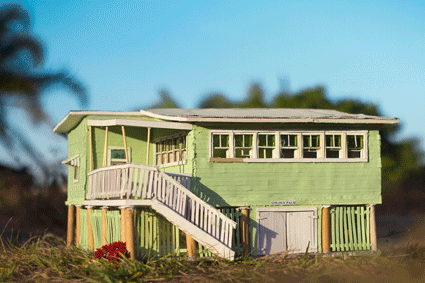
Anna Carey, Golden Palms, Pacific Moon, Stardust, Sunset Place
courtesy the artists & Kaldor Public Art Projects
Anna Carey, Golden Palms, Pacific Moon, Stardust, Sunset Place
That landscape haunts Australian performance has become almost a cliché. I was infected by one recently, driving from Brisbane to the Gold Coast to work on a show about vaginas with a group of young women.
This is a landscape drenched by a collective past that many of us eschew: the DNA of Bjelke-Petersen Queensland is encoded in the pastel skyscrapers and the discarded leisure playgrounds of past generations.
But I was a dramaturgical greyhound with a scent and what struck me was transformation. Traditionally the Gold Coast has suffered, like other satellite cities (Newcastle, Wollongong, Geelong and even Hobart) from a slow leaching of talent and legitimacy.
For a population of half a million, there is no professional theatre company, despite a thriving amateur arts community. As Patrick Mitchell, a theatre director who has spent the last four years writing about Gold Coast theatre for his PhD at Griffith University, suggests, there is also a neglected history of commercial performance.
This is the city with a cabaret scene that nurtured Peter Allen, a music scene with all-night Pyjama Parties at the Beachcomber Motel and legendary rock gigs at the Tallebudgera Playroom; one that sustained luvvies and professional performers until the advent of the Casino in the 1980s.
The camp and performative terroir of the Gold Coast has been sustained by the Warner Brothers film studios, theme parks, dinner theatre restaurants and the sheer unabashed display of the landscape, thrown together without the civility of planning. But somehow the city is now coming into its own in a way that a new generation of artists is embracing without anxiety.
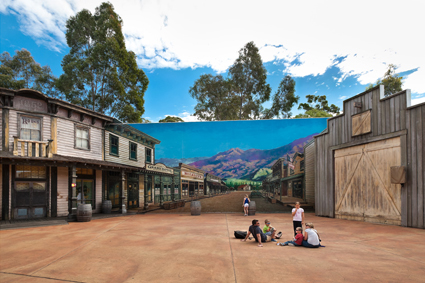
Brett Ramsay, Leisur(e)scapes
courtesy the artists
Brett Ramsay, Leisur(e)scapes
Like Anna Carey, who builds models of remnant 1960s iconic leisure architecture and photographs them (Pacific Moon); or Brett Ramsay who photographs trompe-l’oeil and painterly sleights of hand in the various leisure precincts of the city (Leisure[e]scapes 1).
Ripeness is all when you look at the Gold Coast through the lens of creative industries. Instead of a post-industrial economy we have a post-pastel one: stagnating tourism dollars, low rents, high student populations and a city council eager to rebrand itself through arts and culture in the lead-up to the Commonwealth Games in 2018. Indeed, submissions for the design of a new arts and cultural precinct to co-time with the Games have been announced and include a new 400-500 seat theatre.
Reclaimed cultural spaces are mushrooming in the industrial estates situated between the beachfront villages of the wealthy and the rolling suburban estates of ex-pats, young families and retirees.
Like 19 Karen Street behind Mermaid Beach for street/live art; Crown Studios at Burleigh Beach for contemporary music, design and video art; and Techspace for digital work behind Southport Beach. The most arresting of these artist-led spaces is Rabbit and Cocoon behind Miami Beach, an arts and cultural precinct with 40 resident artists, curating its own radio station and staging performances and fashion shows.
The Design Institute of Australia opened a branch in 2012 and there has been an explosion of independent theatre companies showcased by the Arts Centre’s recent Independent season, including Soapbox Theatre Productions, Awkward Productions, White Rabbit Theatre and newer Gold Coast/Brisbane hybrids including Rocket Boy Ensemble and Blacklight Collective.
Festivals are proliferating, from the popular Currumbin-based sculpture festival, Swell, to the Surfers Paradise Festival and Bleach, which exported one of its shows, The Surfer and the Mermaid, to the Tamarama Rock Surfers Children’s Season in Bondi in 2012.
What characterises all of this activity is a sort of postmodern adjacency. Like the unplanned and kitsch rococo of the landscape it is an unashamed mix of commercial sensibility and traditional aesthetics, street and vintage, sport and performance, fashion and eco-poetics.
As an outsider to the Gold Coast it is easy to find these juxtapositions glamorous when I don’t have to live or work within their contradictions or limitations.
But I leave judgment to the ‘little master’ of Australian performance, Artistic Director of Opera Australia (and formerly of the Brisbane Festival and the Queensland Music Festival), Lyndon Terracini, who is planning to stage a three-day Opera on the Beach in May 2014, to be performed at Greenmount on a stage made of sand. His impeccable sense of the popular zeitgeist signals that something is about to pop in this post-pastel landscape: as Muriel said “goodbye Porpoise Spit” and, as we move closer to the Commonwealth Games and its Arts Festival in 2018, welcome to a growing cultural energy.
–
RealTime issue #115 June-July 2013 pg. 24
© Kathryn Kelly; for permission to reproduce apply to realtime@realtimearts.net
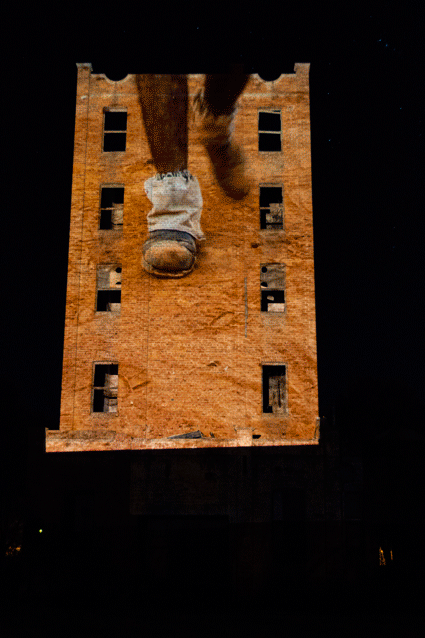
Tipping Point, CAD Factory, Narrandera
photo Lindy Allen
Tipping Point, CAD Factory, Narrandera
The CAD Factory started life in 2003 far from rural tranquility in Sydney’s inner-city industrial borough of Marrickville. It was an artist-run space presenting gigs, exhibitions and housing a recording studio. In 2010, CAD Factory founder Vic McEwan and partner Sarah McEwan opted for a scrub-change and moved to Birrego, 30 kilometres southeast of Narrandera in regional NSW, where they’d purchased a rundown one room schoolhouse. Here they’ve set up home and a base for a vibrant cultural organisation that is presenting an impressive program of community-focused events in the Riverina region.
Their schedule of projects has been growing steadily, starting small in 2011 with artist residencies and music gigs. This year they have a full year-long program including an eight-day live-in makefest at the Grong Grong Hotel, performances at Wagga Wagga Art Gallery as well as school workshops and activities that emerge from their residency program. The CAD Factory also has two major site-specific collaborative projects: Tipping Point (not to be confused with the green think-tank series run by Angharad Wynne-Jones), and a major art/business collaboration with the SunRice Co-operative.
Tipping Point
Vic McEwan describes the idea behind the work: “[The Tipping Point] is the watershed between the Murray and the Murrumbidgee. If rain falls on this side of the little hill it flows into the Murray, if it falls on that side it flows into the Murrumbidgee. We were looking at that as a literal tipping point but we also did interviews with local people about the tipping points that they have, whether they are psychological, environmental or social in relation to water.”
Interviews were conducted with people who have different relationships with the area and its water. Participants included Julie Briggs, a lawyer who deals with the legalities of water as a tradeable commodity; Graham Strong, a farmer and musician engaged in sustainable farming practices; Des Edwards, the former-Mayor of Narrandera; and Cedric Briggs, the area’s most senior Aboriginal elder. Briggs grew up on missions on both the Murray and the Murrumbidgee rivers and was part of the Cummeragunja walk-off in 1939 when 200 Aboriginal people left the mission in NSW in protest, crossing the river to Victoria, where many settled. McEwan condensed these interviews into full-page articles that were published in the local paper and then Vic and Sarah created illustrations, animations and sound works inspired by the material. After conducting the Cedric Briggs interview, they set up a workshop with the local high school and invited four Aboriginal students to illustrate his story.
The final presentation was a 35-minute audiovisual performance projected onto the ruins of an old brewery on the banks of the Murrumbidgee, on the edge of the town. The original idea was to create a sculptural screen out of the industrial pivot irrigation systems used on farms, but the iconic site was about to be sold to a private owner so they decided to change the plan—this fluid, responsive decision-making appearing to be a real strength of the McEwans’ working process. “We thought this is the only opportunity to use this; it’s related to water and it means we can take one of our projects right into the middle of town. So it was a bit of a strategy about exposing more people to what we do.” And it worked, drawing a crowd of 400 people. As one of the ten One River projects curated by Lindy Allen, Donna Jackson and Malcolm McKinnon, Tipping Point also will have a second life in Canberra as part of Robyn Archer’s Centenary program (see interview with Robyn Archer).
SunRice
Following Tipping Point will be the culmination of the SunRice collaboration in which Vic McEwan, photographer Mayu Kanamori (Aus/Japan) and installation artist Shigeaki Iwai (Japan) will be artists-in-residence at the newly re-opened Coleambally Mill (the site was closed during the worst of the drought). McEwan and Kanamori have already stayed for a week to familiarise themselves with the site, watch the first harvest and also to allow the workers to get accustomed to the idea of having artists around. The deal struck by McEwan was that he would raise the money but SunRice would offer access to the factory and allow staff to be involved on company time—a significant investment and leap of faith for a corporation. The outcome in September is expected to be a walk-around performance with installations in the factory and adjoining storage areas.
McEwan discusses this art/business relationship: “I often work with community but I’m also interested in how to work with business. We’ve asked the CEO of SunRice to give us a document that tells us what they think they can get from our project that will satisfy their business plan. It means in the future we can go to organisations and say if you employ an artist to be in your factory for a month or two they can deliver this project that has these artistic outcomes but it can also satisfy these business outcomes.” However he’s keen to stress, “we wouldn’t be doing this with an organisation that we weren’t happy with. We feel SunRice is a moral company that has the community’s best interest at heart.”
Working the region
It’s testament to the McEwans’ charm and sensitivity that they’ve been able to develop these productive relationships with the local community and industry in such a short time. McEwan says when they first moved into their schoolhouse they were unable to get running water at the property. After the positive community response to one of their early events, the committee in charge of the private water scheme in the area agreed to allow them access to the facility. A fair trade of water for art perfectly exemplied holistic community cultural engagement. With Vic McEwan now working full time on CAD Factory activities, including putting the final touches to a fully equipped recording studio, projects and partnerships look to grow ever more ambitious. Over the next few years CAD Factory events will definitely be worth the roadtrip.
RealTime in the Riverina
Later this year, RealTime will be covering key arts events in the Riverina and surrounding regions working with The CAD Factory, Narrandera, Wired Lab, Cootamundra and Eastern Riverina Arts. We will be delivering a writing workshop in the region as well as online coverage including video and audio documentation of selected projects.
CAD Factory, Tipping Point, part of One River, Canberra Centenary, 24 August; www.canberra100.com.au/programs/one-river/; SunRice project, SunRice Factory Colleambally, 21 Sept; www.cadfactory.com.au/
RealTime issue #115 June-July 2013, pg. 25
© Gail Priest; for permission to reproduce apply to realtime@realtimearts.net
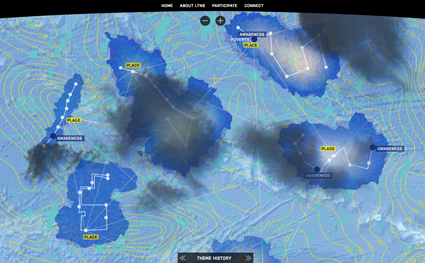
Keith Armstrong and collaborators, Long Time, No See?
In its press release of 3 May, ISEA2013 added weight to its “Resistance is Futile” theme by announcing that a Special Keynote speech would be delivered to conference delegates by Wikileaks founder Julian Assange via live video link from the Ecuadorian Embassy in London, 5.30pm 13 June.
Assange’s presence emphatically underlines the ambiguity of ISEA’s theme: “the 2013 program explores the ways art and new technologies are used in the service of power, protest and resistance.” The internet that increasingly monopolises our lives is nonetheless an invaluable tool, if not of the utopian order dreamt of in the 1990s.
As the ISEA2013 press release puts it, “Julian Assange has a unique insight into the futility, or otherwise, of resisting the incursion of the digital into every aspect of our lives. In systems under constant and multiple pressures there will always be leaks. Wikileaks exists because of this, embracing the digital, exploiting the ubiquity of digitised information: Resistance is Fertile.”
ANAT, Synapse: A Selection
On 3 May, ISEA revealed a third batch of events in an enormous program which displays the works of 150 artists and delivers talks, forums and partnered events with VIVID Sydney. Synapse: A Selection looks back over five years of collaborations between artists and scientists with works by artists, some of whom are represented elsewhere in ISEA2013: Keith Armstrong, Helen Pynor & Peta Clancy, George Poonkin Khut, Mari Velonaki, Erica Secombe, Ken+Julia Yonetani, Nola Farman, Chris Henschke and Kirsty Boyle.
Along with the launching of the RealTime Media Art Online Archive 1994-present and Campbelltown Arts Centre’s Catching Light exhibition (bringing together digital artists from the 1990s and current practitioners), Synapse: A Selection provides a short-term historical perspective in a field that can sometimes develop too quickly for reflection and, curiously, is archivally weak.
SymbioticA, semipermeable (+)
In semipermeable (+) at the Powerhouse Museum, SymbioticA—the University of Western Australia’s Centre of Excellence in Biological Arts, will present extant and newly commissioned works from 15 artists including Nigel Helyer and the centre’s director Oron Catts. The works range from investigations into “protocells, infection and DNA through to skins and garments, to borders and state control.” Surprisingly, after many years of internationally respected experimentation and creation, this is SymbioticA’s first major exhibition in Sydney.
Electric Nights, Parramatta
ISEA2013’s programming is notable for its incursion into the streets (including Electronic Art Pop-Ups by six international artists in The Rocks) and greater Sydney. At dusk, 15-16 June, on the banks of the Parramatta River, “audiences can interact with a mass of LED-lit balloons, participate in a kinetic sculpture on bikes to generate energy and watch stilt performers with roaming data projection.” There’ll also be Indonesian food associated with an interesting food-internet crossover in the form of Grobak Padi 2013.
The grobak is a traditional Indonesian food cart, although serving food is not its function here. In Grobak Padi 2013 “wired up carts will link Sydney and Yogyakarta live via multi-channel links, along with in-cart video art and a multimedia dance spectacle by artists Michael Hornblow (Australia), Agung Gunawan (Indonesia) and Tony Yap (Australia/Malaysia).”
Keith Armstrong, Long Time No See?
Keith Armstrong’s collaborative work, facilitated by Western Sydney’s Information and Cultural Exchange (ICE), Long Time, No See? (www.long-time-no-see.org) will also be found in Parramatta. A specialist in interactive installation and art-science collaborations, Brisbane-based Armstrong and co-creators will provide the public with “an opportunity to create possible futures through data mapping and a smartphone App on local walks through Parramatta.”
The Portals
At Chatswood’s new cultural centre, The Concourse, five telematic artworks will connect communities in Sydney and Darwin through networked and interactive artworks, via high speed broadband and large screens in public spaces—a welcome change from big screen advertising and an opportunity for artists to show the public how to make the creative most of online infrastructure. “The Portals includes live art, visual art, e-literature, interactive performance, sound art and community engagement” with some works running continuously and others as “one-off performance events in Darwin and Sydney.”
In Metaverse Makeovers (LIVE), artists will work “with nail technicians to makeover members of the public with stick-on nail ‘appcessories’ created by Thea Baumann and collaborators—wearable augmented-reality nail accessories that interact with a companion game app” that connects the two cities.
The Portals also includes Shadow Net, using Microsoft’s Kinect technology “to incorporate the shadows of passers-by…into a shared, virtual game space; Distributed Empire, a real-time portrait generator that recombines the faces and voices of volunteers in various locations; and Is Starlight A Wifi Signal? which encourages audiences in Sydney and Darwin to interact via their mobile devices with a networked performance that includes moving bodies, projections and text” (The Portals, press release; www.facebook.com/ThePortalsProject).
Memebrain Art Hackfest
Also at the Concourse, is the intriguing “cross-locational” Memebrain Art Hackfest, a long-term project starting out at ISEA, created by Sydney-based dLux MediaArts with Dorkbot, The Portals Project, Darwin Community Arts and Byron Bay’s Kulchajam. Its aim is “to generate rich creative exchange in an informal online atmosphere to challenge the way media are used culturally.” The artists, working in the Concourse’s underground, invite the public to join them online.
Troy Innocent, Zydnie
Overground, leading Melbourne media artist Troy Innocent will also be at the Concourse, as well as in Darlinghurst and Newtown with Zydnie, his street game “that explores colonisation as an ongoing process via urban codes and language. Choose one of the three warring factions in a battle to revert, renew or remake the city.”
RealTime@ISEA
If you’re attending ISEA2013 or keeping track of it at distance, follow RealTime bloggers Urszula Dawkins and Gail Priest daily (http://isea2013-in-realtime.net/) and catch reviews and video interviews and exhibition coverage at www.realtimearts.net
Immerse!
Events like The Portals, PVI’s Deviator, Electric Nights and others offer opportunities for the public to engage with artists and their works online or on the streets. Some of these you can simply visit, some you need to book for. ISEA offers new relationships with art, technologies and the internet that will take you beyond the everyday of email overload and tweeted gossip. RT
See RealTime 114 for an interview with ISEA2013 Director Jonathan Parsons talking extensively about his program.
ISEA2013, 19th International Symposium on Electronic Art, Sydney, 7-16 June; www.isea2013.org
RealTime issue #115 June-July 2013 pg. 26
© RealTime ; for permission to reproduce apply to realtime@realtimearts.net
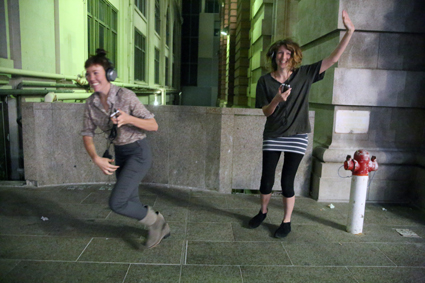
Deviator, PVI, photo courtesy the company
The latest game-based interactive project devised by Perth-based PVI Collective demands physical agility, cunning, courage and tactical manoeuvring. Premiered in Glasgow, refined in Perth and set to invade the Sydney streets for ISEA 2013, Deviator is a site-based intervention enabled via mobile phone and augmented reality.
Players are cast in the role of Deviators, equipped with smart phone and headphones, briefed and set loose on the urbanscape. Game instructions are relayed over the headphones, interspersed with an atmospheric city soundscape that coalesces with the actual sound in the player’s immediate surrounds. Once a game destination is reached, a QR code is scanned and the game begins. Performers dubbed Motherfuckers are dispersed throughout the space to help, play with and coerce players. There are 12 games in total, most of which tap into the collective childhood psyche by being appropriations or detournements of familiar games. They include Sack Races, Kiss Chase, Follow the Leader and Twister. This element of play is folded into more political concerns with the aim for participants to take part in small gestures of resistance to the dominant order and hence counter the potentially stifling routine, alienation and monotony of city life. Each game refers to the theme of revolution by compelling players to be aberrant bodies acting contrary to normative social expectations.
This game-playing approach draws inspiration from the 20th century predominantly French political-artistic movement, the Situationist International. This group had aims to change the world through actions counter to commercialisation, spectacle, apathy, alienation and consumption. They developed techniques and philosophies toward different ways of being within urban space that would agitate the sterility and oppression of the ruling systems of the day. One of their key drives was to draw everyday life into more game-like situations and to this end they devised ideas based on organised play as an essential design tool for moving culture away from mass spectacle and toward more meaningful collective participation.
For tactical media artists such as PVI, games are one of the key means to slip between the gaps of officialdom, to subversively invert the status quo, to be pranksters with an agenda. Deviator is safe play, it will not trigger a revolution but it does bring elements of obscurity and difference into the urban fabric. It is not every day that you see people blowing up balloons until they pop in their faces, or being chased by deranged clowns hell bent on kissing them. For participants then, the game logic is seductive and the desire to accumulate points becomes so strong that some players literally run, or others, such as code-name ‘Butt-Fractal’ who deviated from the game itself, hacked the system to rig the high score, pushing his colourful moniker straight to the top of the list.
Like the Situationist International before them, PVI desire to recapture and transform everyday life into a creative and inspiring experience, drawing together art, the social, the everyday and the political. The writer Hakim Bey described what he called “Temporary Autonomous Zones” as “a microcosm of that ‘anarchist dream’ of a free culture, free from excessive controls on freedom, choice, mobility and agency.” Deviator activates Temporary Autonomous Zones, encourages ‘tiny revolutions’ and so grants permission for greater mobility and diversity of choice of action within public space, playfully re-defining relations therein.
PVI, Deviator, PICA, Perth, 19-24 March; ISEA and Performance Space, 11-16 June, National Art School, Darlinghurst, tickets from Performance Space, http://www.performancespace.com.au/
RealTime issue #115 June-July 2013 pg. 27
© Laetitia Wilson; for permission to reproduce apply to realtime@realtimearts.net
![Koji Yamamura, Mt Head [Atamayama] (2002)](https://www.realtime.org.au/wp-content/uploads/art/66/6608_sakkas_mthead.jpg)
Koji Yamamura, Mt Head [Atamayama] (2002)
A glance at what we can expect from this year’s Melbourne International Animation Festival reveals a program that can fairly be described as spectacular in its breadth. More than 400 films, both short and feature-length, will be shown over the festival’s 11 days.
MIAF will encompass 11 international, three Australian, three Canadian and three children’s programs; surveys of animation from Lithuania and Portland; a CG Symposium and RENDER: a two-day animation conference with international guests.
A highlight of this packed program is a survey of the works of master Japanese animator Koji Yamamura, who also features as one of MIAF’s special guests. Yamamura’s animations for adults combine elements of the traditional tale with unsettling meditations on the nature of existence, using hand-drawn animation to depict an unravelling of the self. Yamamura gained international recognition for the absurdist Mt Head [Atamayama] (2002), nominated for an Academy Award for Animated Short Film in 2002 and awarded the Cristal d’Annecy and Grand Prix at the 2003 Annecy and 2004 Zagreb Animated Film Festivals respectively.
Mt Head is based on Rakugo, a form of traditional Japanese performance where a lone actor tells an extended comical story with minimal props. The film tells the tale of a miser whose head unaccountably sprouts shoots, ultimately becoming a microcosm with a cherry tree at its apex. In keeping with the artform, Yamamura almost completely confines the film’s sound to a Rakugo narrator whose sardonic sing-song is accompanied sparingly on shamisen. Deftly following the vocal cues of the storyteller, Yamamura’s imagery demonstrates the facility with which the expert animator conjures ideas of scale, mutation and paradox.
Mt Head’s precise lines, parchment backgrounds and watercolour tinting recall the delicacy of traditional Japanese painting, which Yamamura combines with the more cinematic effects of artificial lighting and layered images. In Mt Head, sound and image are of equal importance. Neither overrides the other, which is fitting given the film’s basis in an almost totally vocal artform.
Two other works previewed by the festival, Re-Collection, by Nicholas Kallincos—part of the Australian Showcase—and Andrew Thomas Huang’s Solipsist, from the International Program, also explore the threat to the self through an atmospheric balance of image and sound.
Melbourne-based animator Kallincos attained a PhD in Biochemistry from the University of Adelaide before studying animation at RMIT. Re-Collection, his fourth short film, follows on from his mysterious, romantic short The Luminary (2005), which screened at 10 international film festivals. The central character in both of these non-verbal puppet animations is an insect collector with a light bulb for a head who encounters a human-sized white moth. While The Luminary’s mood is one of wistful longing, Re-Collection has a more sinister edge, as the collector is plagued by nightmarish manifestations of the moths he seeks to possess. Re-Collection’s use of light and sound (with a score by Cornel Wilczek) is particularly effective in driving the mood of this piece. Indeed, light as a concept is intrinsic to Re-Collection’s central motif of the unavoidable attraction between collector (with lightbulb head) and moth.
While the collector attempts to fall asleep, Kallincos’ tableaux of his bedroom are overlaid by the sounds of the bush at night, ghostly chimes and a subtle high-pitched tone which sets the nerves slightly on edge. As he is dragged into the lunar world of his nightmare, the sound becomes more charged, with electric guitar introduced. Later, the restless sound of flapping wings, along with skilled deployment of shadows and flickering light, evokes perfectly the panic of the sleeper beset by insects at night.
Young American animator Andrew Thomas Huang’s striking work Solipsist (2012) begins with the idea of solipsism—a state of being wrapped up in oneself—but arrives through a series of hypnotic passages at its antithesis, with individual entities subsumed to each other—disintegrating, being buried, re-forming into something new. Using live performers, puppets and skilled yet unobtrusive CGI, Huang orchestrates scenes of sensuous transformation against a watery pentatonic score.
In Solipsist, two women sway languorously as myriad sinuous forms bind them together; undulating, marine creatures intertwine to form a pulsating forest; a climactic final passage depicts spectacular disintegration, covering everything that has preceded it in an explosion of coloured sand. The pace throughout is meditative, the idea explored coherent, yet abstracted enough not to be obvious. It’s not difficult to see why on the basis of Solipsist, Huang was commissioned to direct Björk’s Mutual Core video and has exhibited at MOCA LA, MOCA Taipei and the Saatchi and Saatchi new directors’ showcase at Cannes.
The considered artistry of Koji Yamamura, Nicholas Kallincos and Andrew Thomas Huang is reason enough to attend MIAF 2013.
2013 Melbourne International Animation Festival (MIAF), ACMI, Melbourne, 20-30 June
RealTime issue #115 June-July 2013 pg. 29
© Katerina Sakkas; for permission to reproduce apply to realtime@realtimearts.net
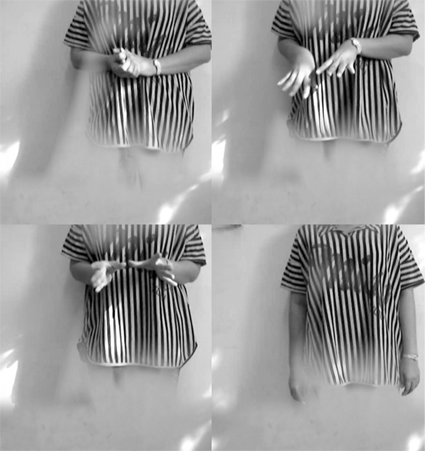
screengrabs from Canto II, Soulnessless, Terre Thaemlitz
Terre Thaemlitz’ Soulnessless (2013) has been largely reviewed in line with its format: a 16GB micro-SDHD data chip filled to its digital brim, qualifying as the “world’s longest album in history” and the “world’s first full-length MP3 album” (as it says on the release’s slip cover).
But there’s much more happening in Soulnessless than its demonstrative act of formatting. Unlike the bulk of ‘politicised technological boutique sound/noise/digital’ releases trading in purported commentary on the means of their production, the state of nowness and the humanist intervention of their endeavour, Soulnessless is empowered by an unerring insularity and asocial tenor which emboldens and clarifies its purpose in reflecting on what it means to produce (more than merely ‘release’) music for the listener today.
To simply describe this complex work: Soulnessless is five extended compositions based around piano recordings, digital processing, layered record samples and occasional onsite interviews, all loosely but carefully addressing symbolic relationships and aural similarities between (a) the extended contemplative states enamoured of Minimalist and ‘ambient’ musical composition, and (b) the ecstatic and transcendental states induced by Catholic rituals of prayer. The micro-SDHD contains five ‘cantos’ (the fifth being an acoustic piano improvisation recorded in a single near-30-hour take), some remixes, an MP4 video of the first four cantos and assorted PDF documentation and commentary. (In the spirit of Soulnessless’s complexity, I’ll discuss in detail a few tracks, rather than attempt to précis its whole corpus.)
This perplexing density of content and form is quintessential Thaemlitz. It bears his distinctive and fascinating cross-wiring between gender politics, transsexuality, classical music’s sexual repression, gay culture’s musical hedonism, and the pop industry’s relentless promiscuity, all swirled into a treacle of viscous thought and technological queering. Viewed in light of Thaemlitz’ artistic history, Soulnessless is a pinnacle in his concentration of these interests and pursuits into a single work (as unwieldy in size as it is).
Soulnessless’ ‘insularity’ is exemplified by Thaemlitz’ alignment of the male computer musician with the Catholic nun, each cloistered within their mental tomb (scroll bars and sound loops in the former; temporal regimes and prayer cycles in the latter). Canto—Rosary Novena for Gender Transitioning features a group of nuns (or maybe just church-goers) reciting the Catholic rosary. It doesn’t take much prompting to reinterpret their droning unison as a type of ‘effects plug-in’ which diffuses their sound and renders them in a post-human (or transcendental) state. After all, where would electronic music of all persuasions be without artificial simulation of Baroque church acoustic architecture and its ethereal reverb? Thaemlitz’ clinical ease in presenting this recording unadulterated for three minutes before a single piano chord rings forth enables such contemplation. It’s a remarkable act of listening more than sound-making, reminding one of Annea Lockwood’s recordings of spaces: her works are acoustic testaments to her aural encounters.
Yet unlike either eco-globalist field recording discourses or Cagean Zen-inflected welcoming of pure sound, Canto I applies modernist secular approaches to aural awareness while retaining the most over-determining aspect of the sound’s cultural content, ie Catholic rituals. The most predictable dialectic of field recording lies in its attenuation of ‘real world’ events to imply veracity, but Canto I perversely applies field recording to the ‘unreal world’ events of religious practice. Most surprisingly, the result is not anti-Catholic, but strangely post-ecclesiastical. As fiery as Thaemlitz’ polemics have always been, a calm quells the melodramatic fire and brimstone critique which besets most Catholic revisionism.
The calmness of Canto I is no superficial emotional by-product. It’s the result of Thaemlitz’ gauging how so-called ‘ambient’ music can be considered its opposite: a disquieting realm of cultural noise and interference. He literally brings to noise the queasy realms sanitised by decades of Minimalist and ‘ambient’ decontextualisation. The aural ectoplasm of the nuns’ choral dribbling could be aligned with Gavin Bryars’ impressively clinical reprocessing of inebriated babble in Jesus Blood Never Failed Me Yet (1975), but Canto I suggests less of an observational frame placed around social occurrence and more of a reflective trip inside the heads of the nuns themselves. If there is a Minimalist precedent, it would be Robert Ashley’s Automatic Writing (1979), where the listener lies at the threshold of Ashley’s somnambulistic rambling. Canto I sets audible voices against inaudible voices, aligning the nuns’ incanting while listening to the inner voice of God addressing them, with Thaemlitz the composer voicing his own voicelessness, evoking what poetically arises as a transgender purgatory. Even the fetishistic glitch processing has its place in this queasy meld of celibates and celebrants: that familiar computer clicking sounds like rosary beads.
The title Canto II—Traffic With The Devil, could evoke the dumbo macho mysticism of Sun O))) and their doomy cartoony ilk. But a careful listen (again, facilitated by the long-form nature of the Soulnessless project) evidences not an erotic wonderland of granular complexion or collapsing realms of saturated noise, but an inverse world of immaterial complexity born of a lack of ‘soul’ (ie ‘soulness’). The track feels like a deliberately artless computer grid of cut-and-paste data (the X-Y verticality of digital placement simulating an act of construction). It harkens back to the future lazily dreamt of in early 90s MIDI-dependent ambient/trance/techno (before Warp and Mille Plateaux exponentially complexified those beginnings). Canto II not only parodies the numbing mania of cut-and-paste reflexes, it hollows out those tropes to produce a severely scaled-down automatism rendered with the texture of its immateriality. Maybe we’re hearing processed fragments of piano events from Canto V, but neither the originating grain nor any resultant timbre is as important as the residual aura of their computerised congregation and assimilation.
The Soulnessless project stridently accepts this as a reality-effect of democratised computer production, wherein musical composition never achieved the Stockhausian utopia of ‘trans-orchestration’ or ‘techno mysticism.’ In short, Canto II plainly demonstrates the artefacting of its own existence. Thaemlitz’ compositions are relentless acts of emptying; the Cantos are not heroic acts of faux-radicalised musicality (as if Wagnerian ideals still need to be railed against in the 21st century) but signs of synchronism between the Self and one’s selflessness in the face of immaterial technological production. Canto II’s arching emptiness and contracted repetitiveness is not about Minimalism, Techno or Minimal Techno, but about how those musical genres symptomise macro conditions, of how music is figured and configured in the present of our over-historicised times where everything is ruthlessly contextualised, placed and fixed.
The negative impulses felt in Soulnessless are wonderfully didactic, for they proffer ways in which one can reductively and deductively ‘picture’ musical production—via a semiological reading (parlaying religious iconography into technological praxis as in Canto I) or a textual reading (acknowledging the empty effects of ‘computer creativity’ as in Canto II). The negative world of Soulnessless is a great place to visit—because it’s where you’re already living.
–
Terre Thaemlitz, Soulnessless, output.p3, Comatose, 2013; comatonse.com/releases/soulnessless/
RealTime issue #115 June-July 2013 pg. 30
© Philip Brophy; for permission to reproduce apply to realtime@realtimearts.net
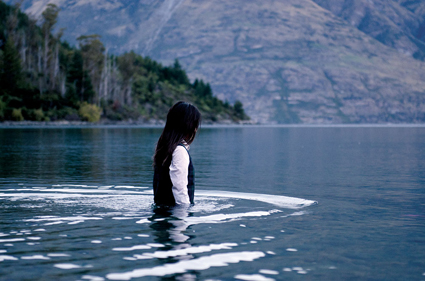
Top of the Lake
I was in the early swoony stages of pregnancy when my husband took the road to Paradise. I walked slowly every day around the lake in Queenstown, New Zealand, through a fog of morning-sickness-quease, uneasy at the water’s ever-changing moods.
The clouds that formed over Wakatipu had different shapes to those here, pointed and pink, fairy-floss spears. With adventure-time over, backpackers heading home, the place felt lost, isolated, still. As I rounded corners towards Glenorchy I felt photoshopped into a scene of snow-capped mountains and corn-coloured paddocks too fakely glorious to be real. Jane Campion’s TV series Top of the Lake (written and directed with Gerard Lee) picks a point on the map (Paradise) and takes me back there (warning: spoiler alert).
Lakes have often been used in TV shows and film as the dumping ground for small-town guilt and secrets: Laura Palmer, ‘wrapped in plastic,’ adrift in Twin Peaks; Jimmy McGovern’s murderous plotting around the deaths of three girls in The Lakes; another teen, floating while men fish, in the river above Jindabyne (where a dam flooded the town formerly housing 300 people). In Top of the Lake, a 12-year-old girl, Tui (Jacqueline Joe), enters the freezing water dressed in her school uniform. She is carrying a child—she doesn’t “even know how it got in there.”
As shipping containers land in Paradise and characters start to emerge, there’s a strange discordance in the plotting and mood. The squabbling, unearthly women’s camp (housed in the containers), led by overseer and no-bullshit prophet GJ (Holly Hunter), lands to face off against local ‘boganville’ family Matt Mitcham (Peter Mullan) and his sons Mark and Luke, the bikie-druggie-misogynists who think they own the land. And yes, as the names suggest, there’s biblical intent everywhere. Many characters, writhing naked in the sinewy landscape, have their Adam and Eve moments. There’s a mother with a seemingly immaculate conception (when asked who the father is, Tui says, “no one”). And it’s up to the audience to work out: who’s the snake?
Added to the mix are the central storylines of The Return and a police procedural whodunnit. Detective Robin Griffin (Elisabeth Moss) heads back from Sydney to visit her dying mother, and lands a case that revisits her own past: a rape involving locals who may still live there; a first boyfriend and a lingering kiss; a boss who seems enamoured; and a Darth Vader moment (welcome to the dark side, Robin). Much has been made of the ABC pulling out of its involvement in the series when Moss was cast in the lead role. It’s true that she is out of place. Her accent doesn’t work, she brings none of the baggage of a New Zealander or Sydneysider (especially when strong Oz actors like Robyn Nevin work effortlessly around her) and the idea that she is a detective is at times laughable: confronted with any crime situation, she tends to cry out for help. But as an actress Moss is utterly compelling. Her face is a halo of light, and her skin so transparent she seems to pour emotion into your cupped hands (both Campion and I can be fans of the overwrought). I’ve devoured her in West Wing and Mad Men, and in the final episodes of Top of the Lake I move beyond the accent. David Wenham seems uncomfortable, at times playing for laughs, and contending with the worst haircut in living memory. He’s done menacing so well (The Boys) that he needs to shift gear and opts for smooth monotone, but the plot points are heavily signposted and it’s clear he’s the baddie from the moment Robin enters his office and sees the deer head on the wall (really, they still have those at police headquarters?).
Much of the series feels like Campion’s return, too. To a country she is ambivalent about, to a series of clichés to explore, to cafes that actually have espresso machines, to a place where men prefer the sexual company of sheep (yep, we go there) and think all feminists are lesbians, to possible new horizons where women can hope to be naked and free (but opt to close their eyes and fall for the men anyway). Campion’s strengths in filmmaking, though, have always been for the quirky, the gothic, the mingling of wild passion with nature, and her intense eye for detail. Matt might be mad as a cut snake, lashing himself with a belt over the grave of his mother, but he still uses her fine china for tea: in the kitchen background his son carefully turns the delicate teapot three times while brewing a pot for his father.
A sense of grief pervades the series: for children sexually violated while they drowse; for cancer ‘that’s not going to go away’; for men who abuse their power and get away with it; for women who keep making the same mistakes even while seeking enlightenment. While Top of the Lake doesn’t manage to draw the threads together, or handle the quirk with David Lynchian flair, it’s challenging TV that takes us on the road to Paradise and gives the place a damn good thrashing.
Top of the Lake, writer-directors Jane Campion, Gerard Lee, co-producers BBC2, UKTV, Sundance Channel; shown on Foxtel’s UK channel in Australia.
RealTime issue #115 June-July 2013 pg. 31
© Kirsten Krauth; for permission to reproduce apply to realtime@realtimearts.net
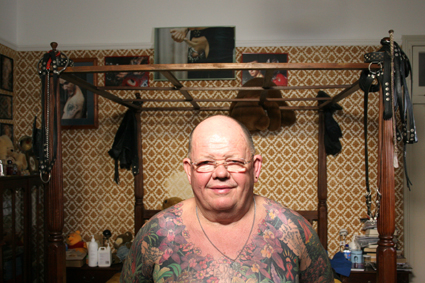
Skin, Anatomy, Matchbox, Australia
A sword swallower specialising in neon tubes. A pair of artists-cum-biochemists growing a leather jacket. A series of video portraits capturing faces at the moment of orgasm. Genuinely innovative documentary content has become a rare commodity on Australian TV, but Anatomy has been quietly livening up the ABC’s Tuesday night Artscape slot with stories like these for nearly five years.
“Tony identified 10pm Tuesday as virtually the only documentary timeslot left where it would be possible to push the boundaries,” says Michael McMahon of his fellow producer Tony Ayres’ original pitch for the series. “We wanted to develop a model that would give emerging directors the opportunity to work with a production company and a broadcaster to create half-hour documentaries which would be works of art in themselves.”
Four series and 12 episodes later, the best of Anatomy has certainly lived up to the producers’ initial vision. It’s also presented emerging directors, exploring some quite risqué content, with rare access to broadcast hours. “It’s a great model,” comments Rhys Graham, director of the first Anatomy episode, Skin, broadcast back in April 2009. “The nexus of sex, the body and the creative process is something I am fascinated by, so it was a huge pleasure to be able to delve into that. But it’s also a rare chance to have resources to make a film of your own and be given the creative freedom to do what the producers feel you’ll be able to do best. That’s a very unusual opportunity to come across these days.
Skin set something of a template for the series, tackling a confronting subject with seriousness and respect through an innovative documentary approach. Graham’s film features direct address to camera, self-conscious performative moments from the central character, and stylised intertitles. The story focuses on Geoff Ostling, who has had a tableau of Australian native fauna designed by Australian artist eX de Medici tattooed across his entire body over a 15-year period. Like other films in the series, Skin homes in on the space where art, the body and reflections on human mortality intersect, to create a discomforting work that celebrates life, even as it is haunted by the presence of creeping death and decay.
Since the initial three episodes broadcast in 2009, another three series of Anatomy have been commissioned by the ABC, with each film by a different director. Highlights have included Mind (director Emma Crimmings), a fantastical probing of identity through the life story of writer Tom Cho, Tissue (Alethea Jones), examining the bio-art of the SymbioticA group, and Soul (Larin Sullivan), a portrait of burial shroud designer Pia Interlandi.
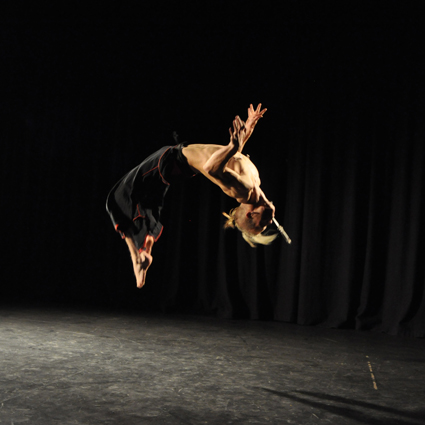
Manx the sword swallower, Stomach, Anatomy, Matchbox, Australia
“Younger filmmakers are often asked to fit into a rigid structure, whereas a model like this is great for directors who shoot their own material and have a really unique eye, because it allows them to do really interesting and engaging work, but still get broadcast audiences,” says Rhys Graham of the Anatomy model. His experience on the first Anatomy series has certainly paid off in terms of his career, with his second feature-length documentary, Murundak—Songs of Freedom, doing the festival rounds last year. The film was co-directed with Graham’s fellow Anatomy alumnus Natasha Gadd.
For other directors, Anatomy was an educational introduction to the constraints of television even within an innovative series. Kim Munro’s Nerve in series three was the filmmaker’s first experience of making work for broadcast, and she found it more difficult than she expected. “I was probably naïve in what I thought I could do,” she says looking back on the experience. Nevertheless, she describes it as incredibly valuable. “You go to film school and have one experience, and then it’s so hard to even get any kind of mentorship or attachment. Tony and Michael’s company Matchbox is such a well-regarded production firm, they’re in a perfect position to be able to mentor people and get these interesting works done.”
Despite the success of the series with audiences, critics and filmmakers alike, the ABC has been criticised in recent years for perceived cuts to its arts programming, particularly following the axing of Art Nation in 2011. More generally, Australian television documentary has become increasingly generic over the past decade. Yet Anatomy demonstrates that when experienced producers are willing to target the right timeslot, films that break the mould are still possible.
So if the model works, why aren’t we seeing more series like Anatomy? The answer partly lies with the restricted nature of broadcast schedules. Anatomy was born of Tony Ayres’ smart pitching of content for a particular timeslot and meeting broadcaster needs. “You’ve got to have the ideas that are going to work in particular timeslots, and that the broadcaster feels their audiences are going to respond to,” explains McMahon. He describes the process of successfully gaining a commission as “hard,” despite having an impressive array of award-winning documentaries, feature films and TV series under his belt, including Wildness (Scott Millwood, 2003), The Home Song Stories (director Tony Ayres, 2007) and The Slap (various directors, 2011). “There’s a lot of competition and those timeslots are not given away,” he says ruefully.
Then there are the financial constraints faced by even well-established production houses like Matchbox. “We would love to continue to work with that model to give emerging directors the opportunity to work with broadcasters,” McMahon replies when asked if he envisions more Anatomy series. “It’s just difficult for us now to make an internal financial argument for the half-hour documentary format.” Unfortunately, half-hour documentaries rarely have a life beyond their initial broadcast, making it difficult to generate substantial income off each production. Anatomy is potentially breaking ground in this regard, with a boxed set containing all 12 episodes being released shortly by the ABC, and individual episodes now available on i-Tunes. Nevertheless, making half-hour films financially viable remains a challenge.
So although Anatomy has been a success by any measure, successfully duplicating the model is perhaps easier said than done. But emerging documentary filmmakers obviously need opportunities to develop their skills and distinctive voices, and Anatomy shows that these chances can provide an entertaining shot of innovation sorely needed on Australian screens. “When filmmakers are trusted to make the work and are not forced to mould themselves to another format, you’re more likely to get interesting films,” says director Rhys Graham. With Anatomy we have six hours of eye-catching television to back up his claim.
Anatomy, twelve episodes 2008-2013; various directors; producers Michael McMahon and Tony Ayres, Polly Staniford (series 2), Trevor Blainey (series 3), Matchbox, Australia
All 12 episodes of Anatomy are available on iTunes. tunes.apple.com/au/tv-season/anatomy-complete-series-1/id624929619
RealTime issue #115 June-July 2013 pg. 32
© Dan Edwards; for permission to reproduce apply to realtime@realtimearts.net
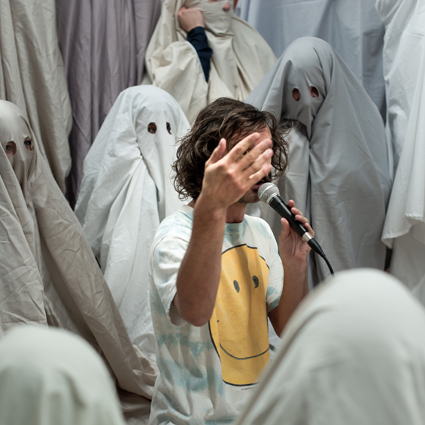
Luke George and audience, Not About Face showing at West Space
photo Rohan Young
Luke George and audience, Not About Face showing at West Space
Last year I saw a show in New York, wherein two performers re-enacted a famous 1963 interview between Martha Graham and critic Walter Terry. Richard Move, who played Martha, has devoted his entire stage career to immortalising Graham through imitation. Unlike other drag manifestations, Move’s Graham is an utterly faithful non-parodic transformation. He thoroughly inhabits Graham’s boldly constructed persona in all its detail, as well as displaying the same discipline and emotive conviction evident in her choreographies.
In the interview, ‘Graham’ speaks of how when performing she is “possessed” by the character she is playing, its spirit taking hold of her bodily vessel and expressing itself through her in the moment of performance. As we hear this we are witnessing the same magic occur through Richard Move, an incarnation that is explicitly an imposter ‘possessed.’ In the words of Move in the words of Martha Graham, “First we have to believe, and then we believe.”
Melbourne-based choreographer and performer Luke George proposes something attuned to this concept of channelling past performers in his new project Not About Face: “We will come together, we will become anonymous, we will fake belief and believe in faking it.”
George recently presented Not About Face for Dance Massive’s Open Studio program as a work-in-progress, wherein the audience enters a rehearsal studio like cheap Halloween ghosts, donning bedsheets with eyeholes cut out (I had a fitted sheet, all the more domestic). Under the sheet I become an insular entity, aware of my presence but transformed into obscurity. Each of us is now a wraith, an anonymous self. Without seats or a marked performance area we are left to negotiate our proximity to the performance and each other.
George, at first unidentifiable from the rest of us ‘ghosts,’ eventually emerges to claim his presence as shepherd to our flock. Once revealed he undergoes a series of transformations: channelling deceased performers, communing with a past version of himself through a television set and guiding us into summoning incantations of colour, to name a few. Between performative acts George speaks to us as himself, casually and directly, making explicit that this is all authentically pretend.
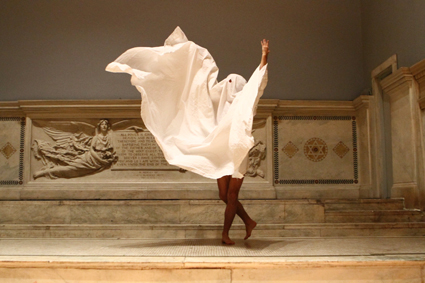
Luke George, Not About Face, New York
photo Alex Escalante
Luke George, Not About Face, New York
Speaking about his latest work, George explains “I act as a medium.” In one instance he re-enacts a recording of a woman acting as a medium for a 35,000-year-old prophet. George’s act as medium however is (like any ghost) more transparent. “I just use headphones, and you can see my iPod and it’s completely visible.” We see this process in action made explicit—the paradoxical truth of the pretending.
Performance has entertained a long history of spiritual summoning, ranging from the devout to the kitsch. People tend towards one of two responses to such spiritual experiences—belief or scepticism, both of which act only to close off possibilities. The space between knowing and not is where George chooses to operate. “I don’t have a position on whether I’m a sceptic or whether I’m a believer, I am more comfortable just to explore it without having to make a decision one way or the other…to be in a question state and to pursue that question.” Once acknowledged that Not About Face is an act of ‘fake-belief,’ the concept of ‘spirit’ then takes on much more complex possibilities.
For George this interest in “evoking other bodies in this time, or in another time” comes from a desire to understand what motivates the body’s impulses in choreography. As a dance artist interested in improvisation, influenced by his recent collaborations with New York artists Miguel Gutierrez and Hilary Clark, he is engaging with choreographies that aren’t restrictively pre-conceived—the performance unfolds in the moment of its happening. This leads to the question “What is the source of the physical information at the moment of articulation?” and then, for George, “Who else is contained in my body? Is it just me?”
All bodies carry histories, and they are always performing these histories. This becomes all the more specific for the dancer’s body that has absorbed unique languages of movement from past teachers and choreographers, the traces of which remain present long after. These physical manifestations may reveal themselves consciously or unconsciously each time a performer is in action. In a history of performance, one that by its very nature erases tangible traces, we can imagine the bodies of the present are something of a vessel to the past, whereby we witness past physical resonances simply by observing the performing body in action.
George reminds me that our minds are programmed to activate “80% of the synaptic responses that occur when performing [an action]” simply by observing it, allowing us a particular and unique “capacity for empathy because of action.” His interest in movement as “a presence that you can’t see” reveals less a superstitious inclination than his embrace of the unique quality of an empathetic visceral experience before it is a visual one.
When George recently participated in Open Studios it was in a rehearsal studio, not a theatre. He has also explored the possibilities in Not About Face through public encounters at Westspace gallery, The Meat Market and at Movement Research, Judson Church in New York at different stages of development, each space carrying with it a different set of expectations from audiences.
A traditional theatre, with its many design elements, is a space that dance-makers sometimes need to distance themselves from in order to highlight the cognitive transmission of bodily information. In George’s somewhat ordinary studio setting, there’s very little smoke-and-mirrors to entice you into any fantasy version of spirituality. With few visual cues, personal imaginative space is given permission to muse on complex ideas, to entertain the possibilities of the unseeable elements of performance. Luke George’s offer is a generous invitation to both actively inhabit the pretend while internally freely conjuring your own experience, seeing it through the eyes of your homemade ‘spirit.’
Luke George and Collaborators, Not About Face, 9-13 Oct, Dancehouse, Melbourne
RealTime issue #115 June-July 2013 pg. 33
© Rennie McDougall; for permission to reproduce apply to realtime@realtimearts.net
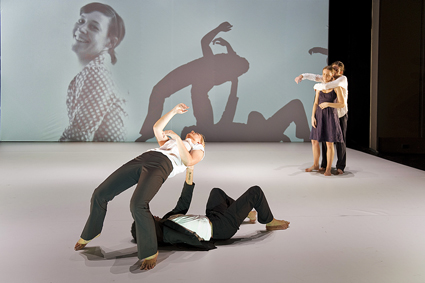
Reflect, Sue Peacock
photo Christophe Canato
Reflect, Sue Peacock
Five sets of clothes lie at rest on the extended strip of white floor, the fall and crease of polka dot skirt differentiated from the over-patterned confusion of an Hawaiian shirt and the bold stance of red overalls. Are they garments in waiting for their danced transformations? Bottom-drawer memories saturated with faded desire?
The assorted fabrics signal such ideas while announcing the arrival of the ordinary. Slippage occurs as young people appear, walking effortlessly into a dance of gesture and imaginative play in which intricate story-threads weave a cloth of reflection and memory. These ordinary people morph into magicians of performance who wear unstable identities of the everyday with the privileged audacity and awkwardness of youth.
Whether intentioned or the result of investigation with the dancers, choreographer Sue Peacock has guided the construction of Reflect with a canny attention to how age shapes (and is shaped by) the human potential to reflect upon actions, feelings and the puzzling collisions of identity across time. A more established group of performers would wear and shed those sets of clothes quite differently, exuding nostalgia or unwanted beasts to banish into forgetfulness. With this group, the trial and error of re-entering yesterday’s garb is refreshingly matter-of-fact. Indeed, the most seasoned performer, Kynan Hughes’ pronounced desire to understand the unstable nature of tease and twist forms a touch-stone for the swapped gesture and identity of the others. His Hawaiian shirt speaks volumes, its imagistic loudness at odds with his unassertive performance character.
To gain some idea of the reflective nature of choreographic and character construction, the overlays of scenic design need acknowledgement. Dancers on stage, their dark and looming shadows and the light-washed projections of the same personalities in rehearsal inter-reflect, jostling like random memories for attention. Indirect pulses of recall slip between present and past. Shadows, which in the everyday imagination are insubstantial, acquire indelible definition, at times blocking the dancers and their filmed reflections.
The signature Peacock structures arise and dis-assemble across time, with motif and fractional patterns playing games of intimacy and rebuttal within and between the members of the group. For example, the head lifting of another elicits a gesture of compassion which shifts and belongs, fleetingly, to each and every individual. Against that shared response (their common humanity?) individuals do develop: Tyronne Robinson has his moments of display, Bernadette Lewis her frivolity, Storm Helmore her insularity, Jenni Large her powerful latency and Hughes his disorientation. In this way, Peacock opens readings of her ordinary grouping of young people to fluctuations of manipulated movement which align with human emotions and the scenographic composition.
Structure and elusive sensitivity alternate, like the presence and past that drift through the performance. Each performer possesses a personality but that personality is multiple and is subject to changes of clothing. Reflect emerges like a fantastic hall of mirrors onto the white and blank canvas of its floor. The telling reflection lies in its capacity to reveal the magic of the ordinary. I think it does, quietly and subtly.
Performing Lines, Reflect, choreographer Sue Peacock, design Andrew Lake, sound Ben Taaffe, Studio Underground, State Theatre Centre of WA, 3-11 May
RealTime issue #115 June-July 2013 pg. 34
© Maggi Phillips; for permission to reproduce apply to realtime@realtimearts.net
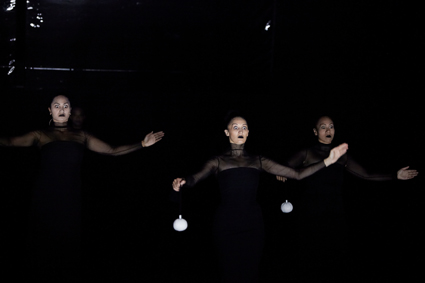
Birds With Skymirrors, MAU
photo Susannah Wembley
Birds With Skymirrors, MAU
In a fascinating review of a new edition of Isadora Duncan’s My Life, Joan Acocella writing in the New York Review of Books (May 23), reminds us of the artist’s detestation of ballet: “What appeared to her most vile about ballet was its unnaturalness: the rigid back, the studied positions, the relentless daintiness.” Two productions, MAU’s Birds with Skymirrors and ADT’s G, a response to the classical ballet Giselle, encouraged reflection on contemporary Western dance’s continuing affinity with its forbear.
MAU, Birds with Skymirrors
Immediately after witnessing New Zealand-based MAU company’s Birds with Skymirrors, created by Lemi Ponifasio (interview RT114, p 39), a friend expressed deep pleasure at having seen a contemporary work rooted in a tradition so different from Western, and especially American, modern dance. I’d enjoyed a similar feeling after seeing Tempest without a body (RT95, p14) on the company’s previous visit to Sydney, although that work had, with its screaming angel and other demanding images, a more contemporary performance presence.
The sight of a frigate bird trailing videotape first excited but then disturbed Ponifasio as he reflected on the floating islands of pollution in the Pacific Ocean. Hence a recurring black and white projected image of a large bird struggling in oil spill. Initially the footage is barely glimpsed; by the end it plays at painful length. But this is only a very small part of a work in which a series of images unfold, for the most part slowly on a broad stage against a reflective wall of dark, softly shimmering, silver material. We adjust to Skybirds’ sense of time and space in which apparently natural sounds mutate electronically and a woman dressed only in briefs and high heels approaches us with the aplomb of a fashion model, hands behind her back, and then yells at us. A bare-chested man on the other side of the stage ripples his abdominal muscles. The two slowly exchange positions. She lies down, the light turning her golden until she appears to be become nothing more than glowing embers. With enormous force the man repeatedly slaps his chest and bends slowly backwards, later dipping at the knees, arms extended, and becoming birdlike. He then disappears into the dark to the sound of a rumbling ocean. What is left is a profound sense of the ephemerality of the body, whatever its cultural or species manifestation.
Other images unfold: shaved-headed monk-ish figures in black speedily glide about the stage, hands articulating Pacific dance gestures, bodies swerving away from near contact like circulating atoms or birds in formation, suggesting lives micro- and macro-cosmic and worshipful, if it at times martial. Three women sing like sirens. We glimpse a projection of the moon landing of 1969. Three women dressed in black expertly twirl bright white poi in increasingly complex patterns, their three-dimensional depth conjuring DNA helixes. Crowd noises wash around us. The bird struggles. A huge centrestage shaft, angled at 70 degrees and symbolic perhaps of built civilisation, slowly surrenders to gravity. Birds with Skymirrors is a sombre, haunting creation, sublime in its otherworldliness, but it brings us back to earth with a sense of the endangered wholeness of nature, conveyed by disciplined performers who embody the traditions of the Pacific, not literally—the choreography is not specific to any one culture in the region—but with powerful, rhythmic certainty and a sense of transcendent poetry. And without the dance steps we know only too well.
ADT, G
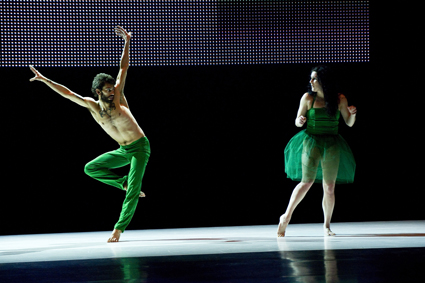
G, Australian Dance Theatre
photo © Chris Herzfeld – Camlight Productions
G, Australian Dance Theatre
Garry Stewart’s G bursts into life with Adolphe Adam’s music for Giselle (1841), but like much else in this entropic work, it soon ‘degrades’ into a harshly propulsive, idiosyncratic score, the product of composer Luke Smiles’ masterful manipulations. But ‘entropy’ shouldn’t suggest that G slows; in fact its pulse is regular, the dancers in perpetual motion mode (a reminder of the work’s endless reproduction and reinterpretation) appear on our left and travel briskly across the stage only to shortly appear on the left again, over and over.
What is in decay is a sense of the work as stable, regardless of digital readouts that tell us roughly where we are in the narrative. Classical ballet movements and flourishes suddenly flower with their inherent sense of display but are juxtaposed with or merge with their contemporary opposites—jagged, a-linear movements and self-contained entanglements of another order of beauty. Roles dissolve—various Giselles and Albrechts suggest opposing states of being ranging from abject to comic, and at all times driven. And for all the cyclic compulsiveness of the movement there is constant, manic change—lighting is starkly demarcated as one brilliantly rich colour state follows another (Geoff Cobham), tiny variations in costuming pass almost unnoticed (a crown glimpsed), a sword suddenly appears, the digital readout offers comment (“S is for sexism,” as the screen romps through the alphabet) and moments from the ballet’s narrative leap out at us with visceral near literalness—Giselle’s wrenching madness, the constraint applied to her and the protracted tormenting of the bodies of treacherous suitors by the vengeful graveyard Wilis, the ghosts of maidens betrayed.
If G represents a critique of the moral values inherent in Giselle the ballet, it is at the same time both respectful of and bemused by ballet’s demands and its follies. There is nothing careless about the ballet steps woven into G. Garry Stewart writes in his program note that he “read a comment in RealTime that perhaps ‘deconstruction’ will become the new classicism.” In G, Stewart transcends ‘pomo’ labelling with an exquisite melding of classical and contemporary.
–
Lemi Ponifasio, MAU, Birds with Skymirrors, Carriageworks, 1-4 May; ADT, G, choreography Garry Stewart & ADT dancers, design Garry Stewart, costumes Daniel Jaber & Gaelle Mellis, Sydney Theatre, 16-18 May
RealTime issue #115 June-July 2013 pg. 34-35
© Keith Gallasch; for permission to reproduce apply to realtime@realtimearts.net
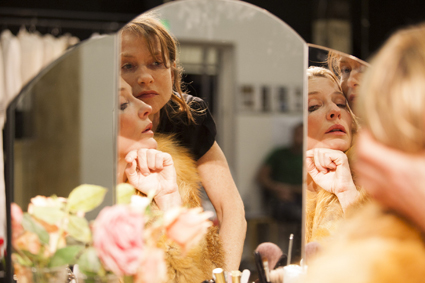
Cate Blanchett and Isabelle Huppert, in rehearsal for The Maids, Sydney Theatre Company
photo Lisa Tomasetti
Cate Blanchett and Isabelle Huppert, in rehearsal for The Maids, Sydney Theatre Company
One of the great plays of the 20th century, Jean Genet’s The Maids (1947) is about to be staged in Sydney. It is also one of the most disturbing, described by one writer at the time as having an effect more emetic than opiate. That might seem like an exaggeration now, but doubtless the play still has the capacity to disturb us deeply with its account of two poorly treated maids who are sisters play-acting their way to murdering their mistress.
I meet Benedict Andrews one evening after rehearsal to discuss his forthcoming production in a new translation by Andrews and STC artistic director Andrew Upton, with performers Cate Blanchett, Isabelle Huppert and Elizabeth Debicki and design by Alice Babidge. It’s early in the rehearsal schedule, but there’s much to talk about,
The language and the action in The Maids are intensely physical, the play is hyper-theatrical, ritualistic, shocking. Where does that come from?
The borderline where Genet’s life becomes myth and in the idea of literature as a kind of criminal act—you steal the words that belong to someone else in order to transform your completely miserable and shit circumstances into something glorious. One of the foundational actions of theatre and—speaking as an ex-Catholic and altar boy—of the Catholic ritual and mass is the transfiguration, the alchemical change from something that is shit or dirt or that is nothing more than a wafer and some wine into something that is glorious.
But in Genet that mass or ritual always has the energy of perversion about it. The Maids is maybe the purest of his plays. There’s always a play within the play, as part of its fibre and texture—in the brothel in The Balcony, in The Screens with people pretending to be something else. And it’s a fundamental of every single moment of this act that’s about the beginnings of theatre. Why did these two women in The Maids invent this game? They’re living in terrible conditions, absolutely trapped in the position of the lowest in the society and the lowest in a power relationship. There are two of them, not one. They’re already each other’s mirrors. They live in a shitty little attic where they tell each other stories and, as Genet says in his wonderful essay “Comment Jouer Les Bonnes” (How to play The Maids), they masturbate each other at night. And somehow from this incredible need and this crisis, they have to invent theatre. And I think this is what’s so interesting about Genet, that he has that foundational gesture. There’s a line where Solange says, “My jet of spit is my spray of diamonds.” In each author, each great theatre writer, you find a definition of what theatre is.
The sisters create a performance; they act, but it’s not easy— it’s interrupted, sometimes they can’t sustain it, and they argue about what happened.
It becomes murderous. They invent the idea of murder in it. I think it’s that which makes Genet still radical. I’m not sure if some of the other plays haven’t dated. I think the idea of The Balcony is still great but I don’t know if I want to see it in the theatre. Somehow the idea of the revolutionary in it has dated. But The Maids hasn’t dated in the same way because the problem behind it is so great. It’s born of a real crisis, a gap between wealth [and poverty] that hasn’t changed.
The interesting thing about re-reading The Maids is recalling the shock of that first read back in the 1960s. Then I saw the Glenda Jackson, Susannah York, Vivien Merchant film which is very theatrical but still has some great strengths.
They’re great, all three of them.
The script exudes suspense, brutality and a fearful intimacy around a fantasy that is set up, undone and set up again until reality and psychosis finally undo it altogether. How do you create an intimate space for that in a large theatre? Miking, live projections and continuous sound design are not uncommon strategies now that theatre is becoming increasingly cinematic and you’ve used these yourself to varying degrees.
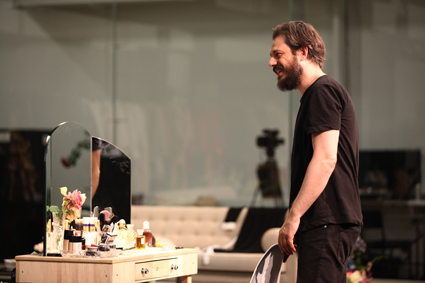
Benedict Andrews in rehearsal for The Maids, Sydney Theatre Company
photo Lisa Tomasetti
Benedict Andrews in rehearsal for The Maids, Sydney Theatre Company
Actually at the moment it’s all about making a space where the two actresses can be free and inventive. But many of those things you just listed, we have! There’s a vast stage space and video artist Sean Bacon’s working with us. That’s been a very good relationship.
He worked with you on Measure for Measure for Belvoir in 2010.
And Monteverdi’s opera The Return of Ulysses (2010) in London as well. In both the screens were not decoration but part of the works. Sean’s in the rehearsal room with us. We have Pantrax zoom surveillance cameras again, studying actors, filming them. It’s like another dimension, simply for the fact that the form of The Maids is a box within a box within a box—mirror reflecting mirror reflecting mirror. Once upon a time having a copy of a bourgeois apartment sitting on a stage in a little box would already give you that box within a box. It doesn’t quite do that now. So I think you have to account for this reverberation in other ways: the idea of what is a performance, what’s real and what’s artifice.
In the end it is a play so I’m only just starting to be able to think about the filming that little bit out of the corner of my eye. I know from experience that you have to pay attention to the filming to get away with it, but [right now] it’s just about letting the actors play with each other.
The alternation between fantasy and reality is critical?
When something in Genet is fake, it’s real; when something is played it becomes real. It’s about what Sartre calls “this whirligig of the real and the appearance.” It’s about setting that up in as many ways as possible and enjoying it. Then you have noir and the thriller of hate. And underneath an incredible love story of these two orphan sisters and their incestuous relationship. It really sets us spinning. And Andrew Upton and I have made a new, quite direct version of the translation.
As soon as you have those two women, Cate Blanchett and Isabelle Huppert, two of the most elegant actresses on earth, so recognisable already as the mistress [in other plays and films] but now playing dress-ups, putting on make-up, putting on their mistress’s outfits, it’s already somehow subversive in terms of what it means for them to play these maids.
Some people call Genet a radical pessimist.
The Maids is a kind of failed revenge drama. The sisters build up the energy of Furies in Greek drama but they fail. If theirs is a love knot, two sisters, it is already a taboo love, again a Greek theme. You have these two people so absolutely bound to each other that there’s no other reality for them apart from each other, They try to destroy the structure they’re trapped in, try to make revolution of it. They invent theatre as a way out of it, but it’s the Mistress who escapes. That whole farce of that society, that whole lie, keeps going on. Now they have to face each other and the trap in a new way. How can we go on together, how can we go on apart? If there’s no escape from it, what can we do? And the act of love becomes: should one kill the other?
Sydney Theatre Company, The Maids, writer Jean Genet, director Benedict Andrews, translation Benedict Andrews, Andrew Upton, Sydney Theatre, 4 June-20 July
RealTime issue #115 June-July 2013 pg. 36-37
© Keith Gallasch; for permission to reproduce apply to realtime@realtimearts.net
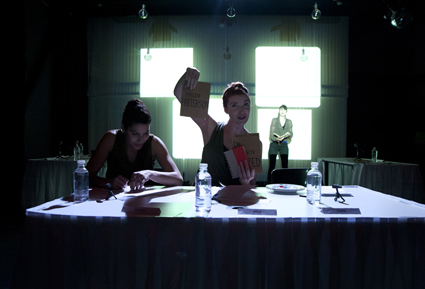
isthisyours, Best We Forget
photo Gerwyn Davies
isthisyours, Best We Forget
isthisyours? began with six women (Jude Henshall, Ellen Steele, Louisa Mignone, Nadia Rossi, Rhiannon Owen and Tessa Leong) coming out of the Drama Centre at Flinders University in Adelaide and deciding to unite to make work.
Their first devised piece, Make Me Honest, Make Me Wedding Cake, had a lot to say about being women in the world. “We thought the rage from our teenage years would pass with time but it didn’t. We were also better educated and we realised that the things that bothered us were not just going to go away.”
Their most recent work, Best We Forget, is an irreverent look into our fear of being forgotten and our ongoing struggles to remember. The show begins as a panel discussion—three performers outlining their personal interests and specialties in relation to forgetting. It then fragments into elaborate scientific demonstrations and forays into popular culture and the rituals of contemporary domestic life such as playing the action movie star and the ‘significant birthday’ party speech, all on the theme of forgetting or wanting to be remembered. At some point the actual show begins to forget itself…The panicked personas then try desperately to reassemble the panel, while looking into theories like the Ebbinghaus Curve of Forgetting of which the show fast becomes an example.
“It feels important that we create, write and devise this work. I still have a quote from Hélène Cixous floating in my head from uni days, ‘Woman must write herself…Woman must put herself into the text—as into the world and into history—by her own movement.’” The company’s work is not characterised by themes. Says Leong, “We try to frame and present what it is that we have become numb to as we go about our lives (the ‘givens’ of our lives), such as the oppression of women, economic rationalism, consumer culture, fear of death, hope for immortality, desire for meaning, in such a way that they can be thought about. Our drive is to question these things with an audience.”
Leong has kept moving through identity positions as a performance maker. She started with ‘woman’ and then was “aware of the privilege she had as a woman in Australia; the opportunity for education and wealth, to live my life in a peaceful country with a stable system of government.” Sometimes this awareness of privilege was like a wall that was not helpful; at other times it led her to a passionate interest in making changes in the world. Now she feels drawn to look at her own Chinese heritage and into the work of Chinese artists and Chinese-Australian artists who generate work from their family story. “I really appreciate now in a conscious sense that in our family there was always a conversation about what was the norm. All things need questioning when one makes work—privilege, ancestry and gender. But there are other questions as well. My view is that if you can’t understand what you are living you can’t frame that any other way or imagine a different way or future. This is important to me as a person and as an artist.”
Emma Beech grew up in country South Australia. She says ‘When I came to Adelaide to study theatre (again at Flinders Drama Centre) I was constantly curious. I was concerned about people’s lives. When I made theatre I always thought about my brother, who had never been to the theatre. What would he want to see? He was my ‘cop in the head’.”
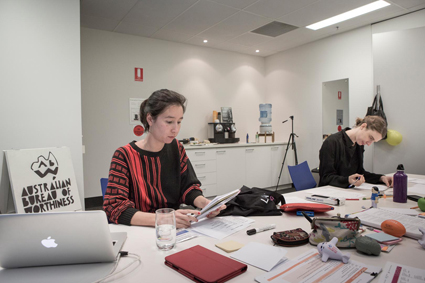
Tessa Leong, Emma Beech, Bureau of Worthiness, courtesy the artists
The Australian Bureau of Worthiness started with Beech wanting to interview people on the street about their lives. “I wanted to know what’s happening in people’s minds and lives. It always seemed different from what you see on TV. I have entered the middle class but I didn’t start there. I always thought the images weren’t quite accurate. I wanted to know what people were doing privately because I spent so much time in private experience. I was hoping there was a shared human experience. I have always wanted those conversations to be had.”
Her friend, director Sarah John, advised her to ask only one question. She decided on “What makes your day worth it?” She asked Tessa Leong to work on the project and Leong in turn suggested the third member, visual artist James Dodd. The three are invited into communities for short periods of time. They go out into the streets and ask the people they meet the question. Then they do a performance for the community.
Beech states, “I perform the conversations I’ve had from my memory of them-—what they left behind in me-—as a combination of narration, direct re-enactments of people by showing their gestures and body language. I also read aloud Tessa’s writing which takes the form of letters and prose reflections. This is done in front of projections of Jimmy’s drawings of the town. I also tell stories about what people said and did outside of the conversations on topic; what people wanted to talk about. All three of us seek out the surprising moments: the gems of genuine contact, the unique perspectives and the unexpected topography tucked away, the things you would miss if you weren’t diligently walking the non-main streets of a town and chatting to people. We present the gaps between what we expected or were led to believe and what we found and learned, between the story the town presents and the stories we hear and find.”
Tessa Leong says that working with Emma Beech in the Bureau of Worthiness changed her practice with isthisyours? Her definition of audience changed along with her understanding of the transaction possible. “It’s amazing when validation comes from the connection with the person present. We’re now focusing on experiencing new things with audiences, like a lot of contemporary artists, and figuring out if and how that is possible. We find inspiration from other female artists and now have access to them and their work—Sophie Calle, Guerrilla Girls, Chicks On Speed, Marina Abramovic (starting your own institute is a great way to write yourself into the world), Tracey Emin—I love their fearlessness and furore. They make up new rules.”
Beech also makes solo work, playing Fatima alongside Stephen Sheehan in Dating the World. This two-hander introduces StevlShefn, a ‘foreigner’ who, keen to communicate, speaks and sings in gibberish, and Fatima, a woman from the same unknown country who wears a black burqa and is calm and articulate in English. She translates his ‘outlandish’ outpourings to us poker faced. This is comedy about ‘foreignness’, gender and love.
Beech’s most recent solo, Homage to Uncertainty, is a collection of anecdotes and observations about chance encounters, family and investigations (for this piece she spent time recording how much work people did in a day in an effort to understand why she was not ‘getting on’), re-enactments and a little dancing. She says, “As a maker I’m driven by hearing or having a story that’s good enough to tell someone else.”
“When I think about the condition of women in the world I think of my sister at home with three children, working two days a week as a nurse with a husband who works long hours, “ says Beech. “I think we no longer want to talk about oppression and feeling inadequate because there is so much wrong with the state of the world. Women are freer in many ways but there is still much that is not allowed. Emotional isolation for both women and men is a very present part of our world. I see so many women in theatre audiences. So where are the men? If women are going to speak, where are the men who will listen? I am curious about this. People don’t connect and we don’t know what is going on and we end up isolated. I keep thinking about that.”
–
Director, dramaturg and writer Anne Thompson is Director of the Drama Centre at Flinders University. She has worked in visual and physical theatre with independent artists and small companies (Terrapin, Snuff Puppets, My Darling Patricia) and was co-founder of the award-winning Eleventh Hour Theatre.
RealTime issue #115 June-July 2013 pg. 38-39
© Anne Thompson; for permission to reproduce apply to realtime@realtimearts.net
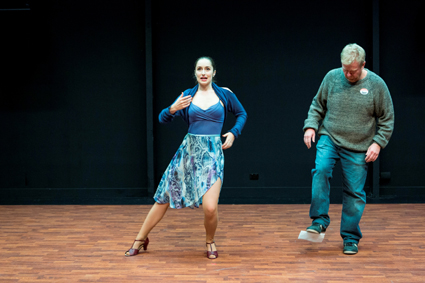
Elizabeth Nabben, Steve Rodgers Dance Better at Parties, Sydney Theatre Company,
photo Brett Boardman
Elizabeth Nabben, Steve Rodgers Dance Better at Parties, Sydney Theatre Company,
The intimacy of Gideon Obarzanek’s production of his Dance Better at Parties, its structure a series of one-on-one dance classes, acutely highlighted the emotional vulnerability of his protagonists. William Yang and Annette Shun Wah’s Stories Then and Now frankly delineated the lives of six people of migrant background, each telling their own story with the intimacy of direct address while opening out rich cultural and historical perspectives. Bell Shakespeare’s Henry 4 was, of course, bracingly epic but it compellingly foregrounded desperate attempts to maintain or establish emotional kinship.
Dance Better at Parties
Dance Better at Parties is a gentle, lucidly constructed parable from Gideon Obarzanek, Associate Director at the STC in 2012, about guilt, grief and emotional transference.
Dave (Mark Rogers), a shy man in early middle age seeks out a dance class, simply, it seems, so he can “dance better at parties.” He hesitates when confronted with a choice of seemingly complex styles but then enrols, persuaded by his young teacher-to-be, Rachel (Elizabeth Nabben), who is deft at delivering a charming pitch by rote (we hear her later on the phone uttering the same to another potential client).
The otherwise sincere Rachel eventually overcomes Dave’s reticence with some very determined instruction, one of the production’s several key pleasures since the teaching, elaborated in convincing detail (right from how to walk), is central to the grieving Dave’s emotional recovery from the death of his wife, loosening his body, standing him tall, imbuing elegance and reigniting desire. Rachel perhaps more than likes Dave, but is shocked, as is the audience, when he secretly films her—the outcome is violent. In one of the play’s odd gaps we’re left uncertain as to why she then continues teaching him, or even how his return to class was negotiated. The relationship warms, Dave’s skills improve considerably, evident in the pair’s joyous dancing in the final lesson. However Rachel doesn’t turn up to partner Dave at the school’s end of course party. His disappointment brief, he seeks out another partner with his new-found confidence. Without her saying it in the previous scene, we can see in the lone Rachel the weight she has taken on and the artificiality of a relationship without foundations. It’s a simple but effective tale that nicely sidesteps sentimentality.
The taut framework of the narrative is provided by the strict time limits enforced by the dance sessions, teasingly leaving words unsaid and desires held in check. Above all the performances are engagingly quiet in a city where small theatre spaces flood with overly forceful projection. Rogers (his Dave ungainly, initially slightly stooped, hesitant, growing in confidence) and Nabben (her Rachel confident, playful, an eager teacher, but emotionally alert to her own needs) are subtle performers who find an abundance of nuance in a spare script built from interviews Obarzanek made with dance class students (oddly no one is credited with writing Dance Better at Parties). The spare set (design Renee Mulder)—wide parquet floor, cupboard, table, chair and, in the end, a celebratory golden curtain—underpins the overall simplicity of the directorial approach, allowing the underlining of small complexities, while the spare fluoro lighting amplifies the production’s intimate realism, save for those scenes that step out of the ordinary with alarming colour (design Benjamin Cisterne). Jessica Prince’s choreographing of the teaching techniques and the dancing provides Obarzanek with physical theatre opportunities rich in comic missteps, intimacy and display.
All Dave wanted to do was “dance better at parties,” but he goes much further than that in a play that is as funny as it is sad. Dance Better at Parties first appeared, if from the same impulse but in a very different shape, in 2004, with five interviewees on video screens, their stories realised, quite unliterally, by five dancers. It’s somewhat surprising to see the creator of Glow, Mortal Engine and other demanding multimedia works turn his hand to simple, social drama in this work’s latest manifestation, but the seed was there in the original work, and is also evident in his co-directed 2007 film Dance Like Your Old Man. It’s still about dancing. Now as part of the South Australian Film Corporation’s HIVE Lab, Dance Better at Parties is set to become a film (RT111. p25).
Stories Then & Now
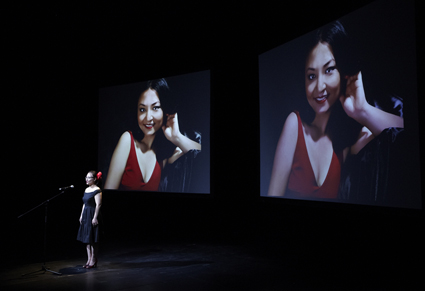
Willa Zheng, Stories Then & Now
photo Susannah Wembley
Willa Zheng, Stories Then & Now
Six people step in turn before a microphone, framed by large projections of photographs drawn from the family history of each on two large screens. Their unrushed delivery, careful pacing and spare storytelling is unmistakably in the manner of the well-known performances by their workshop leader, the photographer William Yang. Like Yang, they have recalled, reflected on and distilled personal histories to make sense of their uncertain identities as migrants at the nexus of at least two cultures—sometimes more. Academic Ien Ang spoke of an ethnic Chinese childhood in Java, growing up in the Netherlands (a stormy adolescence) and then finding a career in Australia, love with an English archaeologist and a home away from home in the south of France where the different strands of the family can come together.
Stories Now & Then, directed by Yang and Annette Shun Wah, is a gentle, undemonstrative show, yielding the kind of pleasure that comes from being read to aloud. Here however, the six largely non-professional performers had learned their lines, if not always comfortably; only a couple were able to relax sufficiently to significantly vary pace and tone. Not that this really mattered, we didn’t expect them to act. But I was concerned for their vulnerability, centrestage in a large theatre, with a sizeable audience and big projections. I wondered why, save for theatrical neatness, the speakers all had to present in exactly the same formal way.
That concern aside, the frank tales these brave speakers told were culturally and historically intriguing, each very different from the other but with a middle class commonality—born into, lost and found again, or, from humbler origins, newly achieved. Ideological, religious, cultural and generational tensions dominated the stories, sometimes amusingly, now and then darkly as the lives of the speakers moved from social and political restraint to independence, if often without quite resolving relationships with their parents. However, their concern for grandparents and parents (caught, for example, in the conflict between Communism and Nationalism in the late 1940s; talented women denied full education; a scholar blacksmithing for seven years in a village during Mao’s Cultural Revolution; a career in Indonesia ruined by the 1967 coup) is recurrently evident, alongside blunter revelations about abandonment or a funny but telling tale about an unlikely (and thwarted) arranged marriage in very recent times.
These stories are of a kind that many Australians are unlikely to hear or are only told within family circles. Occasionally they make it to radio, rarely to film or television. They are necessary fuel for developing empathy and for an understanding of what Australia has become. Ien Ang, Jenevieve Chang, Michael CS Park, Sheila Pham, Paul van Reyk and Willa Zheng perform courageously—their openness about their lives is a welcome gift. It’s fascinating that not a few recognised the irony that the often appalling disruptions to the lives of their forebears and, for some, themselves have in part yielded the lives they now enjoy.
Bell Shakespeare, Henry 4
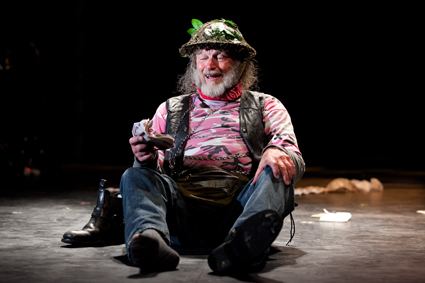
John Bell, Henry 4, Bell Shakespeare Company
photo Lisa Tomasetti
John Bell, Henry 4, Bell Shakespeare Company
Adapted by John Bell from Henry IV parts 1 and 2 and inventively directed by Bell with Damien Ryan, Bell Shakespeare’s Henry 4 was an exhilarating three hours of theatre. While the bovver boy and suits mix seemed at first a tad dated it stood up well to the test of conveying a sense of a mediaeval England that was in little way national, except when opportunism or crude xenophobia required it—as when the lads sang a punk anthem rendering of “Jerusalem.” A giant wall of plastic crates across the back of the stage (design, Stephen Curtis) gave the first sign of the fragile state of Henry IV’s England when it was broken through, an image reinforced by the yellow and black OH&S markings across the floor and a staging that could transform with the trundling of a juke box from one point to another and the stark delineations of place and mood generated by Mark Scott’s dynamic lighting.
Above all, this production made great sense of the play’s comedy, not only in its knockabout robustness, but also its constant revelations of hypocrisy and cruelty, not least in the ‘conscription’ scene where Falstaff (John Bell), Shallow (Sean O’Shea) and Silence (Arky Michael) compel unfit workers into the military and, for bribes, allow others off.
As ever, it’s the wordplay that crowns the comedy (aided by an abundance of apt topical references) but inventive physical manifestation and adroit timing bring it off. This is also comedy that at time runs close to pathos as we witness Falstaff’s stumbling attempts to back away from errors that put him at odds with his beloved Prince Hal (Matthew Moore). At other times his self-correction adds insult to injury, as with his cruel judgments of and then inept apologies to Mistress Quickly (Wendy Strehlow) and Doll Tearsheet (Matilda Ridgway).
Bell is superb as Falstaff, fat, grinning, wobbly on his pegs, a raging wit, deviously mercurial but rarely understanding the damage he is doing to himself in a world in which he attempts to stop the clock, imagining that whatever he does, the bond with Hal will be sustained. It’s a finely tuned performance, at once richly idiosyncratic and integral to the production’s ensemble playing, which includes an excellent Bardolph (Terry Bader), a fine Poins (Yalin Ozucelik), a vigorous and sensitive Mistress Quickly and a battered, emotional Doll Tearsheet, all of whom deliver much more than comedy. I admired David Whitney’s Henry IV—the aplomb of an assured businessman a veneer barely hiding the king’s anxieties. I was less sure of Matthew Moore’s much-praised Hal—too detached, too knowing, tonally dull. His rejection of Falstaff appears to be set in stone from the beginning. But in the run of things, this didn’t matter too much when it came to the ‘death’ scene between Hal and Henry where Moore revealed a more complex response to his father, and realpolitik—that’s in the writing and he did it justice.
Sydney Theatre Company, Dance Better at Parties, Wharf 2, 9 April-11 May; Carriageworks, Performance 4a, Stories Then & Now, Carriageworks, 22-25 May; Bell Shakespeare, Henry 4, Drama Theatre, Sydney Opera House, 24 April-26 May
RealTime issue #115 June-July 2013 pg. 40-41
© Keith Gallasch; for permission to reproduce apply to realtime@realtimearts.net
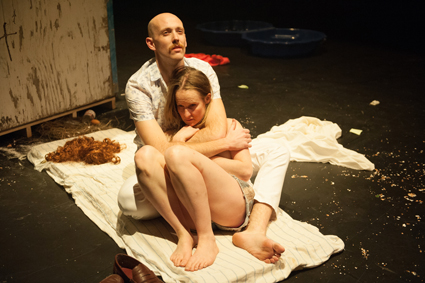
Edwina Wren, Josh Price, Menagerie, Daniel Schlusser Ensemble
photo Sarah Walker
Edwina Wren, Josh Price, Menagerie, Daniel Schlusser Ensemble
Many Australian theatre directors look towards the practices of European directors’ theatre—textual freedoms, visual lavishness, multi-sensory semiotics—for inspiration. However, Daniel Schlusser is one of only a few who understand that the full promise of Regietheater is not to dress up a play, but to articulate an argument.
Schlusser’s recent work has methodically explored the emotional subconscious of the theatrical canon, situating the importance of each classical play in its resonance with ongoing societal neuroses. Unlike the often intellectualising Germanic Regietheater, Schlusser’s is emotionally highly literate theatre. While it dissects the individual and collective psyche with an analyst’s knife, it never disputes the legitimacy of feeling, never simply dismisses the irrational.
At the risk of over-simplifying, the unifying method of Schlusser Ensemble’s work is to reduce a play—the psychology of characters, interpersonal conflict, the plot—into pure, physical metonymy. Whittled down to its most rudimentary theme, it is then re-built as devised, durational, anti-theatrical performance, bearing superficially no resemblance to the original work, and hardly any to theatre. This production uses Tennessee Williams’ Glass Menagerie as a pretext to focus on the crucial question in the interpretation of Williams’ oeuvre: the closeness of his art to his life.
In Schlusser’s hands, the actors only half-wear their roles (the Southern accent comes and goes), the characters lose the plot and wander on stage engaged in very private games with one another, and the stage loses the theatre as everyone forgets to perform to the fourth wall. The performance loses theatrical expressiveness: characters articulate themselves only through the lowest forms of communication: gesture, verbal cliché, banter, the low-end detritus of our culture. And yet, dense intertextual play permeates every banal detail: for those who know their Williams, the references are rich.
It is not metaphor: the stage has its own, physical meaning. In Menagerie, Edwina Wren’s Laura wears a single rollerskate. This does not simply represent physical disability, but literally shortens one of her legs. Her collection of glass figurines becomes eggshells, so much easier to break. The tenement flat in Depression-era St Louis is transformed into a shack in what might be New Orleans post-Katrina. When Jim, the potential suitor, is introduced to Laura, they are physically locked into the Wingfields’ shack by the hopeful, curious, near-giggling family.
The Glass Menagerie is a slim work and Schlusser Ensemble is done with its storyline within the first 35-40 minutes. The remaining 35-40 are spent expanding on the connections that Williams’ first play presaged, and the rest of his oeuvre so richly entangled: those between Williams’ plots and the real events of his life. Echoes of real people manifest in recurring characters (Williams’ sister Rose, lobotomised and schizophrenic, but dearly loved, in Laura, the shy virgin with a disability in Glass Menagerie), and the often professed affinities between Williams and his exquisite female characters. Laura refracts into Rose; Laura’s mother Amanda into the mater Williams, former southern belle smothering her children with needy love; Tim’s colleague and Laura’s tentative suitor Jim, the straight man who plays with these hurting people, into Tenn’s real-life lover Frank; narrator Tim into the observer Tenn, and into Brick, the homosexual husband of Maggie the Cat (on the hot tin roof); and finally, Maria St Just, Williams’ fag hag, best friend of 35 years and conscientious executor of his estate, into Maggie, a character originally based on her.
Schlusser Ensemble zooms in on the mutual cannibalisation of Williams’ life and art, but not as a pure intertextual exercise. As Maria accuses the playwright of having staged her suffering, as Tenn recreates his loneliness and vulnerability in dozens of fictional women, as beautiful, aloof men continuously reject needy, shy, men and women, what is revealed is not merely Williams’ attempts to exorcise trauma through writing, but the sheer emotional weight of that attempted transfer, and the impossibility of catharsis.
Everyone in this world is queer, in the sense that everyone has attachments, passions, sorrows that cannot be fully articulated in language as we have it. Gay men. Lonely women in love with gay men. Ageing beauties in a patriarchal world. Sensible nurses attached to traumatised children they care for. Poor people grown rich, and rich people grown poor. Siblings who love each other even though they cannot help each other. There is much sorrow on this stage: the sorrow of Williams’ oeuvre compounded with the sorrow of his life. On the surface, it is laughable, ignoble suffering—but only because our culture (certainly Williams’ at the time) did not afford it legitimacy.
Judith Butler understands melancholia as ungrievable loss, as a feeling that cannot be consummated because language lacks the words to legitimise it. For Butler, unlegitimised, ‘queer’ lives result in unlegitimised, unmournable deaths, such as the deaths of the AIDS pandemic. A queer tragedy does not exist, there is only farce.
In Schlusser’s Menagerie, just as in Tennessee Williams’ work and life, all characters grieve in a muted, unconsummated way: through role-playing, partying, sexual frustration, plumes of euphoria and dysphoria and deep friendships. Trying to find a language for their experience creates strange aberrations, responses that are not right, that seem cheap and clichéd misidentifications (like Williams’ own with the cultural image of the suffering woman). That is why it is a stroke of brilliance to fill the soundtrack with exemplary wannabe-trailer trash cliché Lana del Rey.
Menagerie respects its characters’ ignobleness. In a certain way, the production is a beautiful gesture of empathy with the often excessive gay party culture. It asserts, simply, that sorrowful lives go on, because tragedy is not as true as melodrama, and because we will always rather live to be a laughable cliché than an honourable corpse. It ends with a hopeful, consoling image of the cast huddled safely on the roof of the shack, in life vests. The hurricane may be coming, but they are used to doing it tough.
Melbourne Theatre Company, NEON: Menagerie, Daniel Schlusser Ensemble, director Daniel Schlusser, Lawler Theatre, Melbourne, 16-26 May
RealTime issue #115 June-July 2013 pg. 42
© Jana Perkovic; for permission to reproduce apply to realtime@realtimearts.net
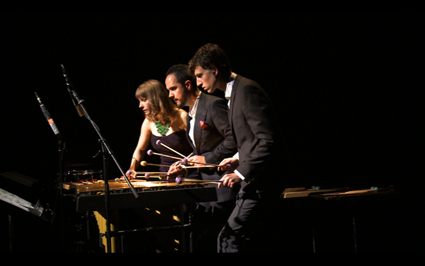
Leah Scholes, Eugene Ughetti & Matthias Schack-Arnott; Speak Percussion, MaerzMusik Festival
photo Yvonne Mohr
Leah Scholes, Eugene Ughetti & Matthias Schack-Arnott; Speak Percussion, MaerzMusik Festival
There is nothing quite like travel to make one reflect on what it is you’ve left behind. This year I’ve been living in Berlin. In a city with such international activity one begins to wonder how to relate to it all. What can I say, as an Australian, that someone else can’t?
In March, Australian ensemble Speak Percussion came to Berlin to present a program as part of Maerzmusic—one of Germany’s largest and most diverse festivals of new music. Before the festival, I met with Eugene Ughetti, the artistic director of Speak (the ensemble also includes Leah Scholes and Matthias Shack-Arnott), to talk about how it sounds to be Australian on an international stage. “I’m wanting to offer a fresh language,” says Ughetti. “I don’t want something any European ensemble could duplicate.”
Speak’s program presented pieces by four of Australia’s premier composers, Anthony Pateras, Thomas Meadowcroft, Matthew Schlomowitz and Rohan Drape (it’s worth noting, however, that only Drape still lives in Australia). What united Speak’s program, other than being simply works by Australian composers, was the focus on novel orchestration taken by each of the four. “There’s a playfulness in the program that is quite Australian,” says Ughetti. “There are risks, but not calculated, Stockhausen-esque risks. Fun risks.”
Drape’s See, Hearer, Clearer (2012) showed remarkable economy of orchestration. All three members of Speak huddled around a single vibraphone, teasing out tones and chords to hold the middle voice between prerecorded piano material and sine-tone shading. In Schlomowitz’s Popular Contexts Vol. 6 (2013), a sampler, vibraphone and drum kit provided an impossible collage of gestures from jazz, rock and daytime television. In Hypnagogics (2005) by Pateras and two pieces by Meadowcroft (Cradle, 2013 and The Great Knot, 2011) much of the orchestration centred on everyday objects from suburban Australia as well as shot glasses, espresso cups, two beautiful Revox tape-machines etc. In Pateras’ Hypnagogics, these ready-mades were abstracted to pure sound but in Meadowcroft’s pieces they doubled as cultural trigger points. These broader associations are an important part of his music, lending it a beautiful, private quality. There was a real joy in being able to exactly picture Meadowcroft sitting at home, tuning wine glasses or shaking tins of marbles to ensure that every sound sat just so.
Fittingly for Speak, this year’s Maerz festival had a particular focus on percussion. The festival opened with two percussion concerts back-to-back: Dutch group, Slagwerk Den Haag performed Michael Gordon’s Timber (2009) before Robyn Schulkowsky and Joey Baron performed pieces by Christian Wolff and several of their own improvisations. This was a nice piece of programming. Both performances were immediately identifiable as American and yet sounded nothing alike. In Timber, six percussionists stood in a tight circle, summoning thick brambles of cross rhythms from a set of simantras (resonant planks of wood). Though Slagwerk’s performance was exceptional, and the piece has some interesting ideas, at an hour’s duration there was a feeling that Timber’s limited materials weren’t enough to support its hefty structure. Where Slagwerk was static and minimalist, Schulkowsky and Baron were vigorous and loaded with ideas. Baron’s playing is jazzy and angular, Schulkowsky’s classily poised and teeming with energy. Their two languages are more interesting at the points where they veer away from one another rather than where they converge.
Two days later Christian Dierstein delved further into percussion’s theatrical possibilities. In Lucia Ronchetti’s Helicopters and Butterflies (2012), Dierstein climbed ladders, yelled monologues and spilled loose objects over drums. In Daniel Ott’s questromung 2 (2011), he swung cymbals suspended from industrial-looking ropes. Here, one could find those “Stockhausen-esque risks.” They may not be ‘fun’ per se, but there is magnetism.
Robyn Schulkowsky made a second appearance later in the festival as percussion soloist with the Konzerthuas Orchestra performing Air (1968) by German composer Helmut Lacheman. Air’s key concerns were spatial—percussion sounds skittered through the orchestra while harmonic colours smeared gradually across the stage. The Konzerthaus Orchestra’s program finished on US-resident British composer Brian Ferneyhough’s orchestral behemoth, Firecycle Beta (five conductors, 10 percussionist, four keyboardist and string orchestra, 1969-71) Despite its many moving parts, Firecycle Beta is an elegant machine and the five conductors worked the orchestra like interlocking gears to dizzying effect.
Though Mearz was held mostly in concert halls, the festival (somewhat surprisingly) also hosted three concerts at Berghain, Berlin’s most (in)famous Techno club. When it’s not hosting pansexual, free-for-all dance parties, Berghain is a spectacular venue for new music. The retro-futuristic PA system in a hollowed out former power plant makes it feel like a missing scene from Blade Runner. There, I caught Thomas Ankersmitt’s Stress Patterns (2012). Ankersmitt performed on a modular synthesiser (“a dinosaur of the digital age,” declared the concert program), working masterfully through the carcass of this early machine, extracting squealing high tones and liquid rushes of noise.
On the second Friday night, the festival got its moment of new music rock-stardom with Steve Reich and Beryl Knot’s 1993 video oratorio The Cave (1990-93). The piece is a modern re-interpretation of the biblical tale of Abraham, with Hagar recast as a jilted black woman and Ishmael becoming ‘the James Dean of the Old Testament.’ The oratorio takes a documentarian approach, with fragments of recorded interviews looped and reinforced by the acoustic ensemble—the same technique Reich used on Different Trains and WTC 9/11. Repetition is, of course, the central trope of Reich’s music and he’s certainly not shy about repeating himself between pieces as well. In The Cave, however, there wasn’t much learned in this repetition and the use of video served mostly as a distraction, heightening the disconnection between the interviews and the acoustic ensemble.
Perhaps it’s anachronistic to think of music as having a national voice. Certainly, any composer today with a decent internet connection is no longer limited to any one country’s influence. It’s a hard notion to shake though, and since leaving Australia I’ve become increasingly aware of some element of Australian new music that I seldom hear in Berlin. Ughetti calls it “a casual multiculturalism”—this willingness of Australian new music practitioners to strip some of the purist underpinnings from classical, jazz, noise, visual art etc and to allow these conflicting narratives to intermingle without inhibitions. Australia is a big place, there is room enough for contradictions.
Maerzmusik 2013: various venues, Berlin, 15-24 March; berlinerfestspiele.de
RealTime issue #115 June-July 2013 pg. 43
© Henry Andersen; for permission to reproduce apply to realtime@realtimearts.net
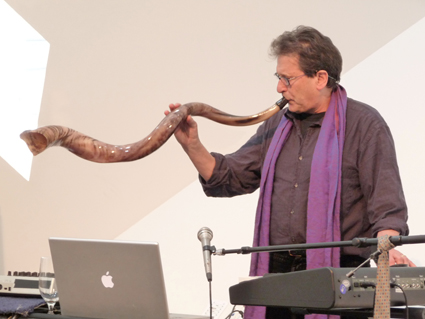
Alvin Curran, Shofar III concert with William Winant, Contemporary Jewish Museum, San Francisco, 2009
photo Susan Levenstein
Alvin Curran, Shofar III concert with William Winant, Contemporary Jewish Museum, San Francisco, 2009
This year’s Totally Huge New Music Festival looks to be bigger than ever, spreading across Perth’s cultural precinct and beyond in August. The festival will also incorporate the International Computer Music Conference with its extensive program of selected live performances from around the world. Matthew Lorenzon spoke with Tura New Music’s Tos Mahoney to find out more.
This will be Tura’s 26th year, the 11th Totally Huge New Music Festival and the 27th International Computer Music Conference. Though none of those numbers are particularly auspicious, it looks like it will be a momentous year for the festival. What can we look forward to?
The integration of the first International Computer Music Conference in the southern hemisphere means there will be a focus across the broad spectrum of computer music and electronic music. As well as international headliners like Alvin Curran, Haco and Agostino di Scipio we’ll have a large contingent of Australian acts including Speak Percussion, Decibel and Clocked Out. There will also be, concurrently with the festival, an installation by Otomo Yoshihide at the Perth Institute of Contemporary Arts. We’re looking to get him back for the festival too, if we can.
Both the conference and the festival are centred around the Cultural Centre, but we’ll have events from the Museum to the Library, PICA, State Theatre Centre and even The Bakery. There will also be some events in Fremantle, where Alvin Curran will be presenting a version of Maritime Rites—not the full version, but he’ll be performing the piece himself. Curran will also present Beams—a totally acoustic work—for a varyingly large ensemble at Fremantle or Midland.
We also pride ourselves on bridging the Australian east-west divide on a constant basis. Of course Speak Percussion have been here a couple of times now. This time they’ll be presenting a new collaboration between Robin Fox and Eugene Ughetti, which we’re very excited about.
How will the International Computer Music Conference and the festival connect?
Though it sits outside the conference, the Fox-Ughetti collaboration will fit quite nicely into the ICMC program. In fact all the way through the program there are constant connections. The great thing about the ICMC is that it’s not just an academic conference: as well as written papers there are also peer-reviewed performances. Clocked Out will be doing some of their own compositions as well as performing some of the works from the ICMC. We’re still not exactly sure which pieces yet, but I can say there will be a wealth of fantastic work that will be presented as both part of the conference and the festival. Some will be live performances, others acousmatic surround-sound works by each artist and then there will be a listening room where about 60 works will be on a loop for the whole week.
How did you tee up this ground-breaking international conference?
To our credit we have had Cat Hope from WAAPA and Lindsay Vickery from Edith Cowan University working on this for a long time. The universities and Tura New Music jointly bid for the conference. This is the first time in the conference’s 27-year history that it will be south of the equator. We didn’t quite know what we were getting ourselves into! We had over 400 submissions for the conference and we understand that it attracts an uncommonly engaged audience who go to everything, whether it is officially part of the conference or not. If you were ever going to bridge that east-west gap and visit Perth, this would be the time.
What are the themes for the conference and festival?
Cat Hope decided on the theme “Developments in electro-acoustics” to broaden the notion of what the conference could contain. We are providing a contingent of performers and resources for the conference beyond the obvious electronic ones—including Decibel, Clocked Out, didjeridu players, a jazz orchestra and a laptop orchestra. There will be a huge spectrum of events.
Will we be introduced to any emerging performers?
Yes, we are organising an emerging local artists’ stream for the conference curated by Sam Gillies, a composer and recent graduate from WAAPA. That program will feature about 12 local artists and ensembles.
On a side note, Tura New Music has been collecting an invaluable archive of recordings of and documentation about contemporary Australian music. Have there been any developments in regards to this incredible resource?
We guard the Tura New Music Archive with our lives and have recently received funding through a joint ARC grant with ECU, the State Library, the National Library and ABC FM. It is called the “Western Australian New Music Archive Project.” Its goal is to set up an online research archive of Western Australian New Music going back to 1970. The Tura archive will be part of that but we will also be uncovering as much as we can in other collections. The grant allows us to employ a research assistant for up to three years. We’re about to put out an Expression of Interest, but if you know anyone who knows about digital archiving please tell them to get in touch with us!
11th Totally Huge New Music Festival International Computer Music Conference, Perth, 9-18 Aug; www.tura.com.au
RealTime issue #115 June-July 2013 pg. 44
© Matthew Lorenzon; for permission to reproduce apply to realtime@realtimearts.net
Grumbling away beneath the glitzy headline “The Sound of London Now,” the underlying theme of the Metropolis New Music Festival was the musician’s responsibility to society and the environment.
The theme was not thrashed out in pre-concert talks or panel discussions, nor in interviews or advertising material. Completely absent from the public image of the festival, it was instead provoked by the subjects of the pieces themselves or by throwaway lines in program notes. If the ‘gently provocative’ approach to ethics does more harm than good, would a polemical or strictly unethical artistic practice be preferable? Can a work be gently polemical, or must it adopt a ‘critical’ tone?
Mira Calix
Mira Calix raises ethical questions in an almost imperceptible manner, drawing you into an enchanted sphere of electronic and instrumental susurration before whispering a message in your ear. Her intimate concert, Looking for Cowslips, in the Melbourne Recital Centre Salon drew inspiration from the nature-themed poetry of Alice Oswald. In withdrawing her book Memorial from the TS Eliot prize in 2011 because of the prize’s questionable sponsors, Oswald described poetry as “the great unsettler.” Calix’s compositions for strings, winds, voice and electronics provide unsettling settings of unsettling poetry, raising the question, in existential more than political terms, of humanity’s relationship to nature.
In a more concrete, jubilant form of charm offensive, Calix presented her short film “Fables: The Boy Who Cried Wolf,” a one-shot melodrama performed by a cast who have all experienced homelessness. Calix’s approach to ethical questions is to inspire empathy, to sensitise you to the issue at hand. Despite the gentle surface of her music, it ‘takes sides.’ Problems arise when the same tactic is used with a bomb or the slaughter of an animal with the aim of ‘raising the question.’
Matthew Herbert
In Matthew Herbert’s albums, music and ethics function like the two independent hemispheres of the brain, with the technology of the sampler acting as the corpus callosum making them appear as one walking, talking, contradictory being. Herbert leaves it up to the audience to determine the relationship between the two, such as in The End of Silence, a concert made entirely out of a six-second sample of a pro-Gaddafi war plane bombing Ras Lanuf in 2011. At one moment, startling in its beauty, the roar of the jet plane is transformed into the breathy tone of an alto flute and a lyrical melody is played by keyboardist Sam Beste. The ambivalence I felt towards this sound was calculated; as the program reads: “On first hearing the recording is terrifying, but at the end of the program once Herbert has finished mixing, layering and manipulating the sounds will you still feel the same way?”
There is no doubt that Herbert intends to be critical of the former Gaddafi regime because he says that the Ras Lanuf sample “punctures the safe veneer of distance” between us and the “atrocities committed by dictators in the Arab world during the Arab Spring.” Nevertheless, there is nothing in The End of Silence, neither its militaristic dance beats, its flute-like melody, nor its eerie ambience, to suggest that it is not a paean to the war plane, a song of thanksgiving to pro-Gaddafi forces. We could very well say that it follows in the futurist tradition of praising the power and majesty of the noise of war. I felt very differently about Herbert’s second concert, which was made entirely out of sounds recorded during the life of a pig destined for the dinner table.
I have to confess that I am uniquely unqualified to write about meat; apart from a recent foray into seafood I have never eaten it. Chef Jesse Gerner, who cooked some pork at the back of the stage during the concert, would do a better job reviewing a concert than I would reviewing a steak. Despite wrangling with the ethics of leather, I have never consciously excluded or abjectified meat from my identity. It is perhaps for this reason that I was so moved by the sound of an organ animated by a mixture of pig’s blood and air that played as the thick smell of cooking pork wafted over the audience.
Why would I allow the sound of the blood-organ to resonate with me emotionally on the one hand and set up a wall to the plane-flute on the other? It could be because of a discrepancy between the values I attribute to human and non-human life, a discrepancy I would not reject outright, but would be surprised by its magnitude. It could also be because of the scarcity of ‘tone’ in One Pig, the sounds of pig-life consisting mainly of almost pitchless noises. Or could it be because of the difference between the sound of a weapon and that of a body? The sound of a weapon implies an action that could be taken or stopped, demanding a response from the listener. The sound of a body implies a deed already done, the passive evidence of violence. This is exactly what was missing from One Pig: the sound of the weapon. The nonchalance with which the audience picked at the crackling cooked during the performance sums up the net effect of Herbert’s latest provocations: far from provocative, they are desensitising entertainment.
Thomas Adès
Composer and conductor Thomas Adès eschews ethical considerations from music. An intense and world-weary Adès looks out from the cover of his book of interviews with Guardian music critic Tom Service. Inside Adès juxtaposes semi-philosophical platitudes with genuinely stimulating musical observations. The ‘semi-philosophical,’ or more correctly ‘anti-philosophical,’ tone is not accidental for a composer who read logical positivist philosophy and had his own late-Wittgensteinian epiphany at the age of 14. To Adès “ethics are a distraction an artist cannot afford,” along with metaphysics, epistemology, the lot. Adès’ anti-philosophy leads to some contradictory beliefs as he wants to protect music from its context and ethics, but does not want to define what music is. He will say that Wagner’s music is inherently political with the notes being “born wearing little uniforms,” even though he will gladly adopt a Wagnerian style because “the [musical] material is fascinating.” Or he will claim to compose completely instinctively according to the “magnetism” of the notes, avoiding the topic of style and technique, while also shirking his own agency in determining the direction of the notes: “My material does not exist in physical reality…These notes are not objects that are in front of you—although in another sense it helps to treat them like that; maybe they are, in fact, a sort of invisible object.” Adès wants the musical autonomy of a Platonist philosophy without the apparent restrictions of a positive definition of music.
Adès has a point though, whether you are a Platonist or not, ethics complicate the creative process. However, should an issue form a source of inspiration, the musician should at least do some soul-searching and make a point about the issue lest the relationship of the music to the issue appear parasitic. As Mira Calix has shown, this does not mean that a piece has to be ugly and therefore critical. Without some sort of commitment there is always the risk that the composition just repeats the bombing, or the killing, on the imaginary level.
Melbourne Symphony Orchestra and Melbourne Recital Centre: Metropolis New Music Festival, 8–20 April
RealTime issue #115 June-July 2013 pg. 45
© Matthew Lorenzon; for permission to reproduce apply to realtime@realtimearts.net
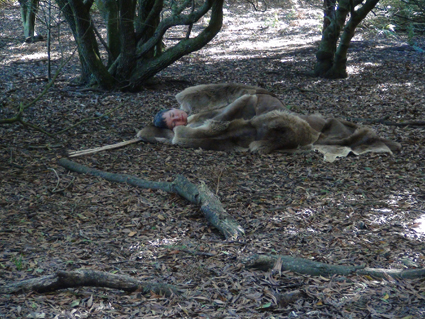
Julie Gough, Traveller, 2013, video still, courtesy the artist and CAST
The Lost World (part 1) is the beginning of Julie Gough’s journey into unknown times and places, where artist becomes detective, archivist and anthropologist in a search to understand her ancestral past and its effects in the present.
Part 1 takes Gough outside her comfort zone, away from the highly charged sculpture and installation practice for which she is best known, to reasonably uncharted territory in video. The Lost World (part 1) principally consists of video (with works of 10 to 45 minutes), a medium that while providing the artist with a means to explore ephemerality, absence and recurrence, demands commitment from the viewer.
Gough’s journey is set in motion by Observance (2012), a video installation originally shown in a 2012 Adelaide Festival exhibition, Deadly: in-between heaven and hell, at Tandanya National Aboriginal Cultural Institute. The work is now exhibited as part of a series of large wall-projected videos on the four white walls of Hobart’s CAST gallery. Fittingly, Observance is the first work seen on entering the gallery, projected on the wall opposite the doorway. Here Gough takes the role of detective, surveyor and stalker following and recording unsuspecting eco-tourists around her ancestral land in Mount William National Park. The snippets of surveillance footage, cut into short bites, build a sense of anxiety. The unknowing participants are viewed as if through Gough’s eyes prompting one to question: ‘Who are they?’ ‘Why are they here?’ ‘Are they a threat?’ A sickening reality check of what the ecotourism industry of Tasmania might be reenacting.
Observance sits somewhat separate from Gough’s recently developed Lost World collection which includes The Lost World (part 1) (2013), Oblivion (2013), Traveller (2013) and Haunted (2013). These were created from or in response to the controversial diary of George Augustus Robinson, Friendly Mission, which has become something of a textbook of Tasmania’s colonial history, but as Gough puts it, “Friendly Mission doesn’t allow for a future, just despair.”
In Traveller, Gough takes up the persona of the Traveller, equipped with animal hide and cultural tool kit including screw-together wooden spears. She is depicted trying to hitchhike her way to locations with poignant associations such as The Nut and Highfield House. She is shown ritualistically screwing together her spears (which Gough is renowned for in her sculptural practice) and preying on cattle at Highfield House—a somewhat humorous attempt at hunting. In the next scene she camps out under hides after ceremoniously burying a copy of Friendly Mission, as if putting an end to a nightmare.
Oblivion is presented on the wall that mirrors Traveller. Here the artist sits completely still on the edge of a waterbed reading Friendly Mission, while leeches burrow beneath the skin of her bare legs. Suffering leech phobia, my stomach turned with fear and repulsion, making me wonder later, was the artist’s reaction to Friendly Mission a similarly physical one? This 45-minute marathon climaxes when a huge tiger leech exits Gough’s skin and a stream of blood rolls down her leg. When queried about the title of the work, the artist explained that the title Oblivion was “hardcore—it’s about being stuck in a place, not of this world, and not in a ‘real’ place, while immersed in Friendly Mission.”
In The Lost World (part 1) Gough takes a journey with her brother, searching for a significant and unnamed location. Together they face numerous obstacles: a high-vis-wearing official blocking access, barricaded areas, dangerous water currents, toxic vegetation and the very real risk of being lost in the wilderness. Throughout the work a sense of drama builds. Brother and sister become lost, over 10 hours and miles from their destination. As evening breaks, they receive worried voice messages from their mother, one after another until eventually Constable Wright calls from Devonport Police Station. Sound and video editor Jemma Rea is to be commended: the viewer senses the amount of time lost in the bush, but also the increasing hysteria felt by the hikers and concerned third parties.
Anchoring these four videos is a sculptural cairn/compass built from bluestone spalls installed in the centre of the gallery space. A large compass needle moves at random trying in vain to find its bearings. This object has been appropriately titled Haunted (2013), bearing both a material past and the sense of disorientation at not being able to locate oneself. This humble object embodies the aimless helplessness of being lost.
Julie Gough’s investment in her investigation and her personal sacrifice aids in the rewriting of history through the experience of place. She describes her series of actions as “tasks of encounter” undertaken to bring her out of Robinson’s Friendly Mission and back into reality. The artist seeks insight through acts of surveillance, voyeurism, disappearance and physical risk. An unintentional outcome of being lost in a Friendly Mission is that at times the artist and her loved ones experienced distress, anxiety and pain—possibly an accurate and challenging retelling of the artist’s ancestral history.
Julie Gough, The Lost World (part 1), CAST, Hobart 26 April-26 May; The Lost World (part 2), October 2013, CAST and Cambridge Museum of Anthropology and Archaeology, UK
RealTime issue #115 June-July 2013 pg. 49
© Polly Dance; for permission to reproduce apply to realtime@realtimearts.net
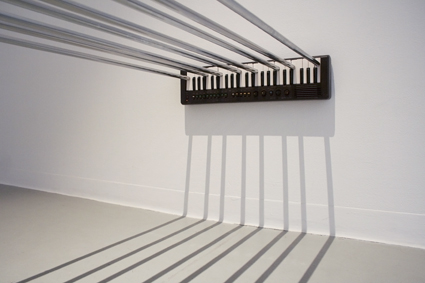
Julian Day, Requiem, 2012, (detail)
photo Alex Lofting, courtesy the artist
Julian Day, Requiem, 2012, (detail)
A musical performance can be like a chess-match, as Sydney-based composer, performer and broadcaster Julian Day and Adelaide-based artist Riley O’Keeffe showed in co-improvising a sound work on the opening night of the Bloom—Space exhibition at the Australian Experimental Art Foundation.
Day and O’Keeffe each used two keyboards and took turns to activate the keys by placing weights to hold them down, responding to each other one note at a time. Over 20 minutes they built up a powerful, layered drone of complex chords. Day has performed solo in a similar vein (RT106), and O’Keeffe combines musical performance with visual art (E-dition,17July, 2012), but here the two performers build intuitively on each other’s sounds. Adding vibrato of different speeds creates phasing between the keyboards, producing shifting rhythms overlaying the chords and creating an effect similar to piano harmonics. The sound becomes very dense, though never overwhelming, always retaining musicality and elegance.
This collaborative approach set the scene for Bloom—Space in which emerging Adelaide-based curator Adele Sliuzas teamed Sydney-based artists Carla Liesch, Will French and Day with Adelaide’s Lisa Harms, Roy Ananda and O’Keeffe to catalyse moves and countermoves in each other’s art practice.
Carla Liesch’s Landscape Painting, a mound of lawn in the centre of the gallery on which people sit or lie, becomes the exhibition’s focal point by creating a relaxed, approachable viewing position (in contrast to the vinyl or timber benches typical of art museums). Next to it stands Ananda’s Aether drift, a tilted plane constructed of hundreds of timber hexagons, each about 40cm across, suspended by two huge aluminium ladders. Sitting on the lawn, I feel as if I’m on a hill overlooking the towers of the Golden Gate Bridge poking up through the afternoon fog that floats into San Francisco Bay. Comprising building materials, Aether drift can also suggest a complex molecule, the infinitude of a fractal and biotechnological manipulation. Audience members at the artists’ talk, sitting on the grassy knoll, felt they were looking at clouds, yet Ananda’s evocative work might have weighed 50kg or more.
Contradicting the scale and authority of Ananda’s ladder-supported plane is Will French’s Doubled Up, Fingers Crossed, two precariously inverted timber A-frame ladders, with pencils wedged underneath to balance them, located on the opposite side of the knoll to establish symmetry with Aether drift and contrast with Liesch’s organic, growing lawn. Sliuzas stated that her intention with the exhibition was to demonstrate the difference between ‘affect’ and ‘effect,’ but what came through strongly was the physical and conceptual relationship between the artworks and the way they aggregated into a composite whole.
Lisa Harms’ intriguing work, Script for a_____Song (with no proper name), comprises a long roll of paper lying across and under a table, bearing text like a theatre script, beautifully crafted, with great visual power and tactility. A pre-recorded tape of voices like a vaguely overheard conversation emanates from the table. Nearby, partitioned from the rest of the exhibition, are two videos, one of a concrete floor projected onto the wall, the other of ornithological illustrations projected inside a small cupboard. Harms’ combination of sound, text, video and installation seems to propagate the entire exhibition.
Julian Day’s contribution to the exhibition, Requiem, is also in a partially enclosed space—two keyboards wedged between partition and wall by horizontal pipes that activate the Fs and Cs, creating a droning chord heard continuously through the gallery, and competing with the rising and falling voices in Harms’ audio. Day’s installation is as precarious as French’s inverted ladders.
Collaboration between artists is commonplace, but Bloom—Space demonstrates the potential for group responsiveness, and, with its multiple symmetries and inversions, how an exhibition can function as a single entity.
Roy Ananda, The Devourer
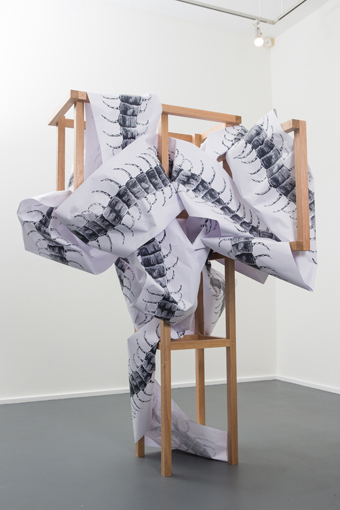
Roy Ananda, The Abomination of Abominations, from The Devourer
photo James Field, courtesy the artists and Dianne Tanzer Gallery + Projects, Melbourne
Roy Ananda, The Abomination of Abominations, from The Devourer
At the Contemporary Art Centre of SA, Roy Ananda’s engaging and extensive solo exhibition The Devourer is a multifaceted exploration of popular culture through sculptural form. His Hideous Climb through the Unfashioned Realms represents the curvature of space-time using a block of moulded plaster painted to look like an astronomical map. From the Gulf of Space to the Wells of Night is a wall of beautiful drawings on graph paper that depict 3D space in a 2D grid, defying conventional perspective and questioning how human perception functions.
Ananda is well-known for his elaborate, large-scale and miniature sculptural works constructed from industrial equipment and building materials that establish a characteristic language of form and process. In The Devourer, he demonstrates his interest in the impact of horror and science fiction genres, and HP Lovecraft in particular, that pervade contemporary culture through games, cinema and literature. His The Abomination of Abominations is a tall wooden frame through which snakes a long sheet of paper printed with a grossly oversized black and white image of a centipede. His interest in model-making is evident in the small-scale shelves of tiny figures and objects depicting in physical form the kinds of games popular in virtual reality. Ananda’s exhibition simultaneously addresses our predisposition to fantasy and the nature of materiality, questioning what is subjective and what is real.
Bloom—Space, curator Adele Sliuzas, Australian Experimental Art Foundation, 3 May–1 June; Roy Ananda, The Devourer, Contemporary Art Centre of SA, Adelaide, 26 April–26 May
RealTime issue #115 June-July 2013 pg. 50-51
© Chris Reid; for permission to reproduce apply to realtime@realtimearts.net
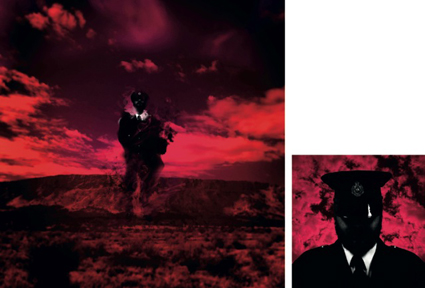
Warwick Thornton
In Warwick Thornton’s blood red pigment prints, three looming figures—a policeman, a priest and a stockman (indiscernibly black or white)—hover above the landscape as if at any moment they might either ascend to the heavens or bring down their wrath (Untitled, 2013).
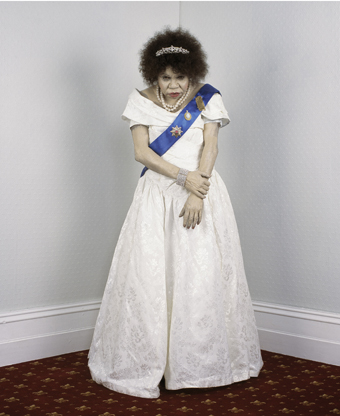
Darren Siwes, Northie Kwin, 2013
courtesy the artist and Greenaway Art Gallery
Darren Siwes, Northie Kwin, 2013
On the adjacent wall, in his latest photographic series, Mulaga Gudjerie (2013), Darren Siwes’ Indigenous subjects are caked in white greasepaint, ostensibly dressed as a British Queen and her Consort. Their poses are in turn imperious, hostile, formal or put-upon. Like other works in this exhibition, Siwes’ images are disturbing in their ambiguity, simultaneously projecting a shifting hierarchy, mocking monarchy and its trappings and reminding us of the imposed costuming of some 19th century Indigenous portraiture. In the room notes Siwes writes, “I see my work residing somewhere between the truth and a hypothetical.”
The large white room of the Anna Schwartz Gallery is full of such crossovers between this world and its others. In r e a’s photographic triptych Poles Apart (2009), we see the artist, dressed in a black crinoline, running as if pursued (an image more explicit in the associated video not on show here) through a landscape beloved of the Heidelberg School. She blurs and vanishes into her surroundings. In strange juxtaposition Danie Mellor’s native hunters (Bayi Minyjirral, 2013) move through a rainforest rendered in the blue and white of willow pattern, their landscape made alien.
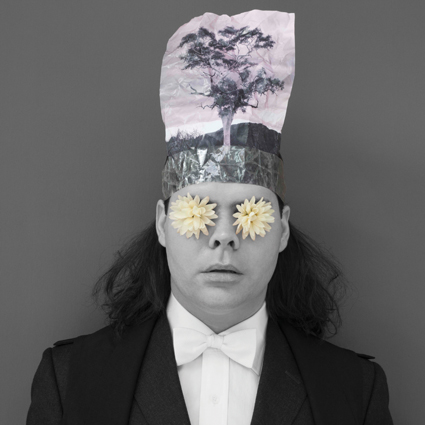
Christian Thompson, Desert Melon, 2012
courtesy the artist and Gallery Gabrielle Pizzi
Christian Thompson, Desert Melon, 2012
The ever-evolving Christian Thompson conjures another impressive series of shape-shifting self-portraits covering his eyes not with pennies as in death but with shells, flowers and fruit: his own body an unlimited palette for projection. There’s more ambiguity in Destiny Deacon’s inkjet prints of gleeful adolescents enthusiastically embracing Western depictions of vampirism and trying them on for size (Blakula Series, 2011).
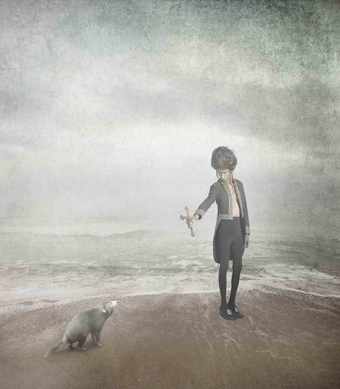
Michael Cook, Civilised #10, 2012
courtesy the artist and Dianne Tanzer Gallery + Projects
Michael Cook, Civilised #10, 2012
We’ve seen parts of Michael Cook’s haunting work Civilised (2012) but never all 14 images in the series presented so generously here. There’s a disconcerting aura of surrealism in these graceful, dream-like photographic collages featuring lone subjects on a misty shoreline wearing costumes ranging from Elizabethan to Victorian. We’re reminded of all manner of invasion and in particular the imposition of European culture on indigenous peoples but, save for one woman drowned, far from appearing abject, Cook’s subjects maintain their customary bearing in the face of our disorientation, one man confidently wielding a cross to ward off a Tasmanian devil.
Sharing the entrance to the exhibition with the bronze Mokuy (2011) of Nawurapu Wunungmurra is Tracey Moffatt’s film beDevil (1993), its three gothic tales filmed in saturated colour dealing with death and disappearance, and everyday spirits who refuse to leave. Curator Marcia Langton reflects, “When Debil Debil opens it will be 20 years since beDevil first screened in Australia. It was a revolutionary work of cinematic art. Its presence in this exhibition marks a point in our history. Since then, conceptual art work that tackles difficult matters of history and the self has flourished” (Room Notes).
Debil Debil is a thoroughly engrossing exhibition, bringing together some of the most skilful artists of this inventive era.
Debil Debil, curator Professor Marcia Langton (AM), artists Brook Andrew, Daniel Boyd, Gordon Bennett, Michael Cook, Destiny Deacon, Ricardo Idagi, Danie Mellor, Tracey Moffatt, r e a, Darren Siwes, Christian Thompson, Warwick Thornton, Nawurapu Wunungmurra, Anna Schwartz Gallery, Carriageworks, Sydney, 20 April-8 June
RealTime issue #115 June-July 2013 pg. 52-553
© Virginia Baxter; for permission to reproduce apply to realtime@realtimearts.net
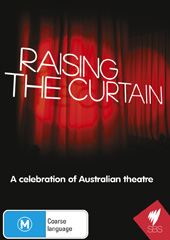
DVD: Raising the Curtain—A celebration of Australian theatre
Madman and SBS DVD have come together to present Raising the Curtain, a unique history of Australian theatre from the convict era to the present, employing re-enactments, archival footage and photographs, and interviews with Cate Blanchett, Geoffrey Rush, Robyn Nevin, Andrew Upton, Jack Charles, John Bell, Louis Nowra and others. The three episodes cover key figures in the development of Australian theatre, the influence of vaudeville and circus, and the current redefining of tradition.
5 copies of Raising the Curtain courtesy of Madman Entertainment
DVD: Godzilla—Millenium Series Box Set
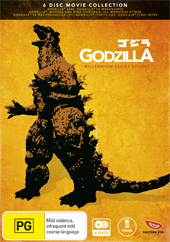 Make six of the 28 to date Godzilla movies your own! Originally embodying a warning about the dangers of nuclear war, Godzilla soon became more important than the message with audiences the world over. The Millennium era of Godzilla (1999-2004) traces Godzilla from his origins to fighting all the way to the last in the series, Final Wars.
Make six of the 28 to date Godzilla movies your own! Originally embodying a warning about the dangers of nuclear war, Godzilla soon became more important than the message with audiences the world over. The Millennium era of Godzilla (1999-2004) traces Godzilla from his origins to fighting all the way to the last in the series, Final Wars.
3 box sets courtesy of Madman Entertainment
CD: Ida Dueland, Winterreise
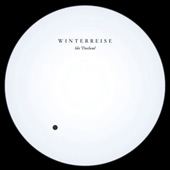 Winterreise, inspired by Franz Schubert’s famous work, is the latest album from Ida Duelund, a talented Danish vocalist and double bass player working in collaboration with sound designer Jethro Woodward. Active in jazz, experimental, improvised, pop and chamber music, Dueland has performed with Chamber Made Opera, The Australian Art Orchestra, Malthouse, Rawcus and Four Larks Theatre. You can sample Dueland’s evocative singing and fine cello playing in the RealTime Sound Capsule #4 or hear a track from Wintereisse at idaduelund.bandcamp.com.
Winterreise, inspired by Franz Schubert’s famous work, is the latest album from Ida Duelund, a talented Danish vocalist and double bass player working in collaboration with sound designer Jethro Woodward. Active in jazz, experimental, improvised, pop and chamber music, Dueland has performed with Chamber Made Opera, The Australian Art Orchestra, Malthouse, Rawcus and Four Larks Theatre. You can sample Dueland’s evocative singing and fine cello playing in the RealTime Sound Capsule #4 or hear a track from Wintereisse at idaduelund.bandcamp.com.
3 copies courtesy of Chamber Made Opera
Please note you can nominate for ONLY ONE GIVEAWAY.
Email us at giveaways@realtimearts.net with your name, postal address and phone number.
Include ‘Giveaway’ and the name of the item in the subject line.
RealTime issue #115 June-July 2013 pg. 56
© RealTime ; for permission to reproduce apply to realtime@realtimearts.net
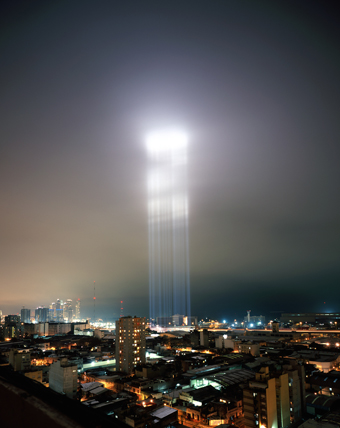
Ryoji Ikeda, Spectra (Buenos Aires), site-specific installation, 2012
© Ryoji Ikeda / Dark Mofo 2013 – Museum of Old and New Art (MONA), Hobart Tasmania
Ryoji Ikeda, Spectra (Buenos Aires), site-specific installation, 2012
MUSHROOMING IN HOBART TASMANIA THIS WINTER IS DARK MOFO A NEW FESTIVAL AND TWIN TO HOBART’S SUMMERTIME MONA FOMA.
Among the visual art highlights of DARK MOFO are the opening of MONA’s latest exhibition Red Queen; Sound to Light, a live collaboration between artists in Hobart and Melbourne; the aesthetico-engineering marvels of Ian Burns at the Tasmanian Museum and Art Gallery; and, destined to reset your sense of selfhood, at Hobart’s Mac1 wharf is the exhibition Beam in Thine Own Eye.
Beam in Thine Own Eye features 14 artists, including Kurt Hentschlager, Ryoji Ikeda, Matthieu Briand, Gregorio Zanon, Tim Bruniges and the legendary Michelangelo Pistoletto, a leader of the Italian Arte Povera movement. The title is borrowed from Matthew 7:3, purposefully tethering the recent with the ancient. David Walsh states in a program note that beyond its moral lesson “it beautifully conjures the notion of our reality shining from within.” The question remains, will Beam in Thine Own Eye convert the uninitiated?
Since ancient times the limits of knowledge have been contemplated with metaphors of light, darkness, sound and silence; likewise, by employing cutting-edge art, Beam in Thine Own Eye’s curators hope to enable an encounter with the unknowns of nature by testing the limits of cognition, feeling, normative reality and selfhood in its audience. Unlike the cosmologies of many ancient thinkers, Beam in Thine Own Eye will doubtless leave the visitor to figure out any grand conclusions on their own. Yet by letting the visitor’s “mind’s eye shine” it can be said Walsh perhaps intends to relate the experience of art to that of mystical ecstatics.
A likely DARK MOFO highlight will be Ryoji Ikeda’s spectra [tasmania] (2013), a grid of 49 xenon lights above the Queens Domain bordering Hobart CBD. Clearly aimed to be the ultimate tribute to numinosity within the festival, spectra will surely need the right kind of night-sky to strike awe.
Light is further revealed as the strange stuff of intelligence when transmuted through Ikeda’s audio-visual installation data.tron [3 SXGA+ version]. The Greeks coined ‘dianoetic’ to conceptualise a certain cosmic intelligence and perhaps here Ikeda is expressing pixellated mathematical data as intelligence; a vast immersive field of ‘data- noetics.’
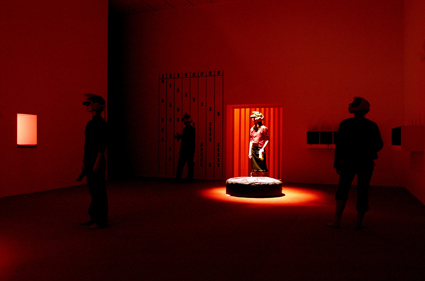
Mathieu Briand, Derriere le monde flottant, Musee d’Art Contemporain de Lyon; Beam In Thine Own Eye – Dark Mofo 2013 – Museum of Old and New Art
photo Bruno Amsellem, image courtesy the artist
Mathieu Briand, Derriere le monde flottant, Musee d’Art Contemporain de Lyon; Beam In Thine Own Eye – Dark Mofo 2013 – Museum of Old and New Art
Sydney based Tim Bruniges’ Continuum (2012) employs a vacillating blue orb of light and quadraphonic sound perpetually emitting a “sonic barber’s pole.” The artist hopes to hypnotically envelop the visitor in its orbit. In another immersive interactive titled SYS*05.REE*03/ SE*1 MOE*2-7 (2000–13), Matthieu Briand will have you and six others wearing backpacks rigged up to video camera helmets in an experiment testing the conventions of personal cognition within an ethos of nomadism. Participants will experience how the real, the virtual, the mental and the physical coalesce. Like a passive form of Trātaka meditation. Anish Kapoor’s Imagined Monochrome (2009) will have you lie on a massage table, your eyelids used as a screen for optical effects.
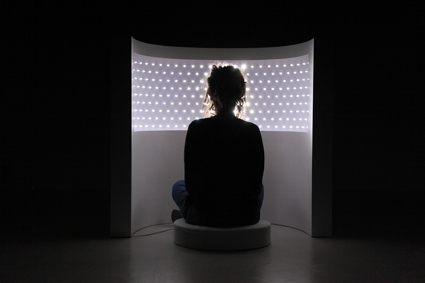
Ivana Franke, Seeing with Eyes Closed, (2013); Beam In Thine Own Eye – Dark Mofo 2013 – Museum of Old and New Art
courtesy the artist
Ivana Franke, Seeing with Eyes Closed, (2013); Beam In Thine Own Eye – Dark Mofo 2013 – Museum of Old and New Art
Beam in Thine Own Eye raises questions about perceptual reality; just what is the mind’s eye? Where do images exist, if anywhere? What can we learn by assaulting the retino-neural reception of light? Ivana Franke invokes these questions by sculpting experience with light, space and darkness. In Seeing with Eyes Closed [SWEC2] (2013) the visitor is subjected to repeated pulses of light forming spectral imprints on the ‘mind’s eye.’
In Giuseppe Penone’s Rovesciare i propri occhi (To Reverse One’s Eyes, 1970), the artist took photos of himself wearing mirrored contact lenses, subverting what is taken for granted as the real. Is the outward appearance of the iris and cornea more real than the eye’s function: to make contact with the radiance of external appearance?
Michelangelo Pistoletto’s sculpture Cubic Metre of Infinity (1966) works with similar logic. Sold for one million US dollars at Christies last year Cubic Metre of Infinity is arguably an icon of icons in art theory, hence well placed to be Beam’s altar. Cubic Metre of Infinity is best interpreted through Pistoletto’s wonderfully elaborate texts: “Soul” (1983), “Art takes on Religion” (1978) and “Division and Multiplication of the Mirror” (1978). One of Pistoletto’s preoccupations is with the production of sacredness; he wants to “reconstruct objectively the centre of spirituality of art,” to evoke an infinite consummating of the sacred spaces of all doctrinal belief systems. Its as if the artist were trading in every debate about which way is the only way by mirroring all artistic and religious representations into a cubic metre of infinity.
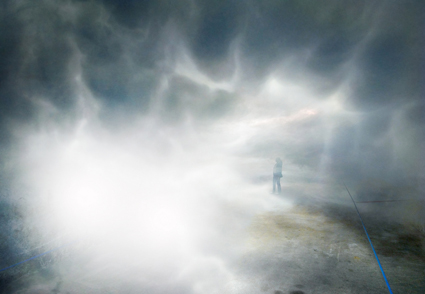
Kurt Hentschlager, Zee, Beam In Thine Own Eye – Dark Mofo 2013 – Museum of Old and New Art
courtesy the artist
Kurt Hentschlager, Zee, Beam In Thine Own Eye – Dark Mofo 2013 – Museum of Old and New Art
If you need one last real reason to visit Hobart this winter it is the promise of Kurt Hentschlager’s ZEE (2008), a work that redefines substance abuse where the substance to be abused is your cognitive processing capacity. At its maximal encounter Hentschlager promises wondrous fractal imagery that will form your mind’s eye.
Museum of Old and New Art: Beam In Thine Own Eye, curated By Olivier Varenne, Nicole Durling; artists Mathieu Briand Tim Bruniges, Lara Favaretto, Ivana Franke Fabien Giraud + Raphaël Siboni, Kurt Hentschläger, Ryoji Ikeda, Alfredo Jaar, Anish Kapoor, Giuseppe Penone, Michelangelo Pistoletto, Lawrence Weiner, Gregorio Zanon; MAC 1, Hobart, June 14-July 28; DARK MOFO, Museum of Old and New Art, June 13-23; www.darkmofo.net.au
RealTime issue #114 April-May 2013 pg. web
© Shane Eastwood; for permission to reproduce apply to realtime@realtimearts.net

Skye Gellmann, Blindscape, Next Wave Festival 2012
photo Sarah Walker
Skye Gellmann, Blindscape, Next Wave Festival 2012
When performance art works from the past are re-enacted by others, what can that mean? When live art creates intimate and visceral encounters, what precisely is the art involved? And when the audience becomes the subject of the work, where exactly is the artist in the equation? The nature of performance is changing and its parameters expanding.
RealTime 115 will focus on the body in contemporary performance, whether in the Kaldor Public Art Projects’ 13 Rooms, in circus, live art dance or burgeoning game playing theatre. Our subject can be the body of an artist, a performer or an audience member at a time when the lines between these roles are as permeable as those between artforms.
in the body in question:
two views of 13 rooms
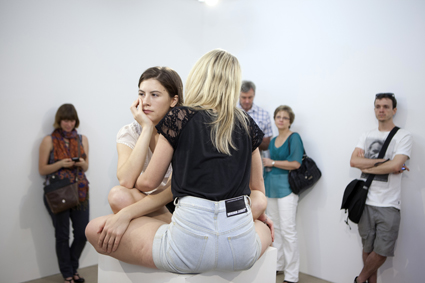
Clark Beaumont, Coexisting, 2013, ommissioned and performed by the artists for Kaldor Public Art Project 27: ‘13 Rooms’
photo Jamie North/Kaldor Public Art Projects
Clark Beaumont, Coexisting, 2013, ommissioned and performed by the artists for Kaldor Public Art Project 27: ‘13 Rooms’
Ilana Cohn approvingly reviews the hugely popular 13 Rooms’ “living sculpture” performances some of which are re-enactments of works created by artists to be performed by themselves under the banner of performance art. In Sydney’s performance scene responses ranged from enthusiastic to hostile, so we asked prominent Australian performance artist Barbara Campbell for her take on 13 Rooms.
yvonne rainer: re-enacted or transmitted?
Nicely timed, American dance artist Sarah Wookey appeared in Sydney around the time of 13 Rooms, recreating a seminal work by Yvonne Rainer. Meredith Morse writes, “Wookey is one of five people vested by Yvonne Rainer—certified, Wookey says—to perform and teach the four-and-a-half-minute Trio A. Re-engaging with Trio A is timely: the Judson Dance Theater’s 50th anniversary was celebrated this past year, and the question of re-performances of 1960s-70s works remains topical.”
put the body back into circus
Asking what is the standing of circus as art, Antonella Casella argues against “a prevailing opinion that circus skills should only be harnessed for performance when they reflect a narrative/contextual intent—implying that the display of circus skills, in and of themselves, is somehow gratuitous.”
close body encounters at spill
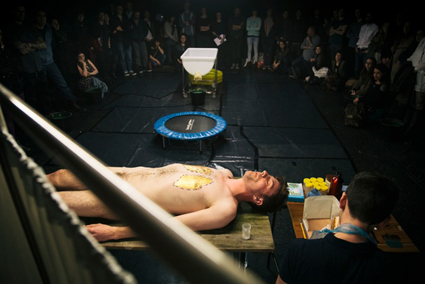
Martin O’Brien, Last(ing), Spill Festival London
photo Guido Mencari
Martin O’Brien, Last(ing), Spill Festival London
Cat Jones, Madelaine Hodge and Julie Vulcan report from London on strange encounters with bodies in the SPILL Festival of Live Art. Not for the nervous, Spill included blood spilling, mucous expectoration, a visit to the apparently dead and witnessing “glorious genitalia” experiments. But SPILL also offered hand-holding walks with strangers and watching a dress being made out of cake. There’s serious intent in these live art foregroundings of the body, that also challenge the very notion of art.
the audience as the body in the work
Playwright Robert Reid reports from his UK encounters with game playing theatre. He writes that works by the likes of Coney “allow for and respond to player agency within constructed narrative environments. They give participants the chance to practice ‘ways of being’ in ‘not for real’ spaces.”
Also in RealTime 115:
Robyn Archer invites us to the next stage of the Canberra 100 celebrations.
Benedict Andrews on thinking through Genet’s The Maids for his STC production featuring Isabelle Huppert and Cate Blanchett as the murderous sisters.
Festival reports: Castlemaine Festival, Vancouver’s PuSh, Tokyo’s Azumabashi Dance Crossing, Melbourne’s Light in Winter and Brisbane’s Exist-ence.
Regional arts: an interview with Vic McEwen of CAD Factory which presents innovative performance and installation work across the Riverina region. Kathryn Kelly reports on developments on the Gold Coast to nurture a challenged cultural scene.
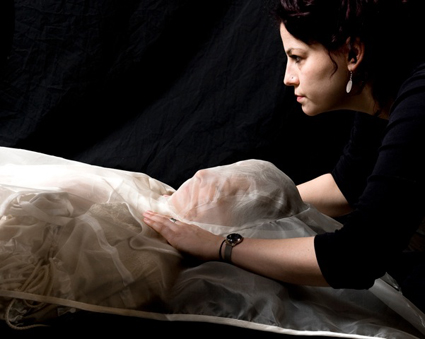
Anatomy – Soul
photo Devika Bilimoria
Anatomy – Soul
In film, Dan Edwards looks at Australian arts documentaries and Kirsten Krauth reviews Jane Campion’s much-debated Top of the Lake TV mini-series.
Dancer Rennie McDougall interviews dancer and choreographer Luke George; Jana Perkovic reviews Menagerie, the first production in the MTC’s NEON season; Matthew Lorenzon previews the 2013 Totally Huge Festival of New Music; and Polly Dance reviews Julie Gough’s Lost World [1] video installation in Hobart.
RealTime issue #114 April-May 2013 pg. web
© RealTime ; for permission to reproduce apply to realtime@realtimearts.net
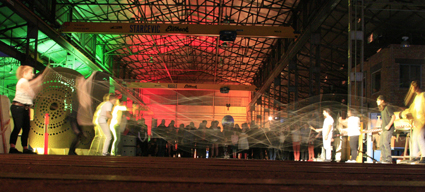
Lavender, Mist
photo Eric Griswold
Lavender, Mist
URBAN ART PROJECTS IS OUT PAST THE AIRPORT IN THE LIGHT INDUSTRIAL ZONE. IT’S A VAST LET’S-BUILD-A-SHIP SIZED INDUSTRIAL SHED, AND TONIGHT IT IS FILLED WITH THE DEEP ROARING NOISE OF A FURNACE SMELTING BRONZE.
Two men go through a slow and very careful ritual to make the pour. Sparks of boiling metal spit into the air. Then claps all round for the first piece of the Listening Museum, Clocked Out and Ensemble Offspring’s latest collaborative foray into concerts in other places.
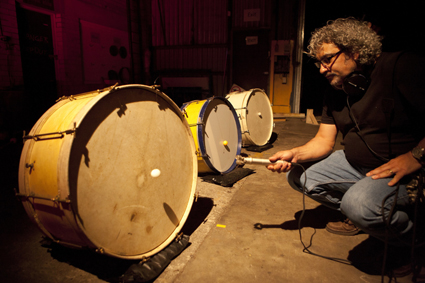
Alvin Lucier’s Music for Pure Waves, Bass Drums and Acoustic Pendulums
photo Sean Young
Alvin Lucier’s Music for Pure Waves, Bass Drums and Acoustic Pendulums
The space is set up as a series of stations, some things are on all the time, some are in specific time-slots. People move about, grab drinks, move about some more. Alvin Lucier’s wonderfully clever Music for Pure Waves, Bass Drums and Acoustic Pendulums is set up at the entrance—inaudible low frequency sine waves bouncing ping pong balls off the resonating skins of bass drums. Another Lucier piece, In Memorium John Higgins, sets a slowly rising sine wave against held notes on clarinet. A truly beautiful work that revealed one of the classic problems of sound in a shared space—bleed from one work to another. Difficult if not impossible to overcome, the interjecting blab of sound from other works interfered annoyingly with Rosemary Joy’s Beauty Boxes, a soft and delicate piece for two performers playing tiny chests of drawers and the sounding objects within.
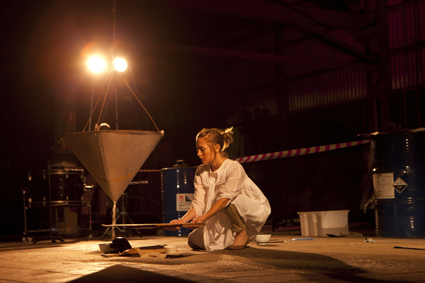
Rebecca Lloyd-Jones performing Erik Griswold’s Spill
photo Sean Young
Rebecca Lloyd-Jones performing Erik Griswold’s Spill
Strangely though, the bleed worked for Erik Griswold’s Spill, where rice leaks out of a swinging pendulum to sound onto surfaces that are moved and changed by the performer. The initial subtlety of surface variation was lost in the general hubub, but eventually the surfaces were set to hard tiles and rice became a drum machine against which other pieces worked their rhythms.
Griswold also composed and played in my two favourites for the night. Early in the program was the premiere of Action Music for piano, percussion, bass clarinet and violin. The piece is a single quirky line—cartoon music for tomorrow, snappy fragments and synced up time slices of humour held together by a score that specifies rhythm, mood and attitude rather than pitch. The ensemble playing is superb—instruments mesh perfectly, the virtue of having the musicians play as an acoustic ensemble rather than with sound reinforcement trying to fake a balance for them.
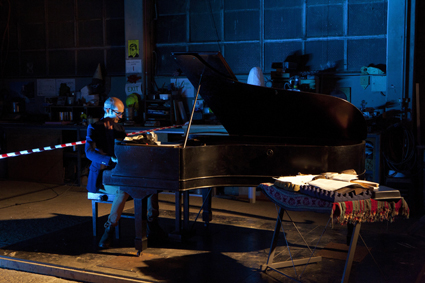
Erik Griswold, Ecstatic Music
photo Sean Young
Erik Griswold, Ecstatic Music
And then toward the end, Griswold performs the stunning Ecstatic Music. Each key is prepared to hover somewhere in the E major world and then on this reduced piano Griswold plays rapid arpeggios, sprints and flourishes, hunched over the keyboard and rocking on the stool like a Hollywood maestro. The composer-pianist emotes for us all through his hyper-acute feelings and hyper-fluid fingers. Except that it is a reduced piano so nothing like Sturm und Drang falls out. Instead we get tinkles, with occasional variation. Despite the effort, despite the visibly heroic struggles of the performer, the deepest feelings remain trapped by the inadequate means at hand. We bear witness to the gulf between ambition and achievement, between ourselves-in-ourselves and ourselves in others. Normal life. Australia’s Got Talent.
The Listening Museum, Clocked Out and Ensemble Offspring, Urban Art Projects, Brisbane, April 20, 2013; http://www.uap.com.au/; http://www.clockedout.org/; http://ensembleoffspring.com/
RealTime issue #114 April-May 2013 pg. web
© Greg Hooper; for permission to reproduce apply to realtime@realtimearts.net
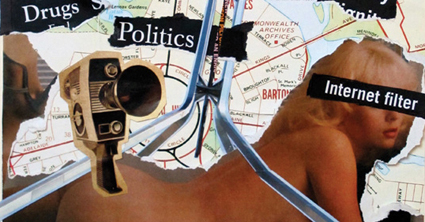
version 1.0, Major Minor Party
major minor party
There are not many subjects theatre company version 1.0 is afraid to tackle. Currently the team is investigating the political intrigues behind the formation of the Australian Sex Party, founded in 2009. We can well imagine that the show will involve some rollicking fun alongside a sensible dose of transcript veracity around the Sex Party’s attempts to expose hypocrisy, fight censorship and generally lobby for a more tolerant nation. Fittingly the show is premiering in Canberra as part of the Centenary celebrations. Let’s hope more delicate Canberrans have recovered from the shock of Patricia Piccinini’s gloriously grotesque Skywhale hot air balloon and are ready for some more cultural provocation.
Version 1.0, Major Minor Party, Canberra Theatre Centre, May 29-June 1; http://www.canberratheatrecentre.com.au/season2013/majorMinor.html
moduluxxx
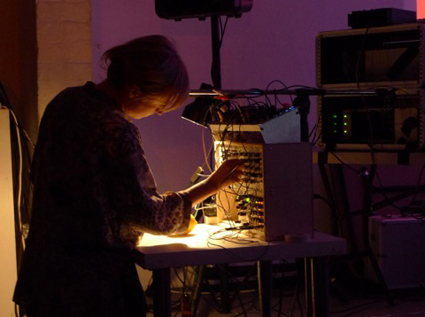
Pia van Gelder performing in Moduluxxx 2012
photo Alex White
Pia van Gelder performing in Moduluxxx 2012
Making music with computers is so old hat. The electronic music-making tools du jour are modular synthesisers. You get a box, fill it with your choice of noise-emitters and effects and patch them together in different combinations to make unpredictable, barely tameable and definitely unrepeatable noise magic. If you want to know more about it you can attend workshops, performances and even a petting zoo—getting your sweaty hands on some knobs and switches—as part of the two-day Moduluxxx festival. Guest artists include festival directors Pia van Gelder and Alex White, along with Russell Haswell (UK), Wired Lab’s David Burrastan and Nokes & Cook.
Moduluxxx, Sydney various venues, May 24-25; http://moduluxxx.com
laura altman & monica brooks duo
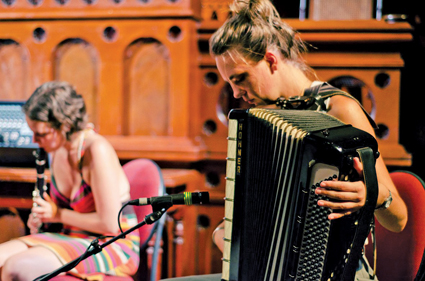
Laura Altman, Monica Brooks
On the other end of the noisemaking spectrum are the super-quiet experiments of Laura Altman on clarinet and Monica Brooks on accordion. Describing a live performance by the duo as part of the exhibition In a Silent Way at Hobart’s CAST gallery, Andrew Harper wrote “the time the two players described with sound hung together with a brittle elegance. People who seem to know their instruments well enough not to demonstrate their skill make fascinating players” (RT112). Their concert is the first in the New Music Networks’ annual Mini Series profiling emerging and independent artists.
New Music Network Mini Series: Laura Altman & Monica Brooks; Old Darlington School, Sydney University, May 25; http://www.newmusicnetwork.com.au/series.html
spanish film festival
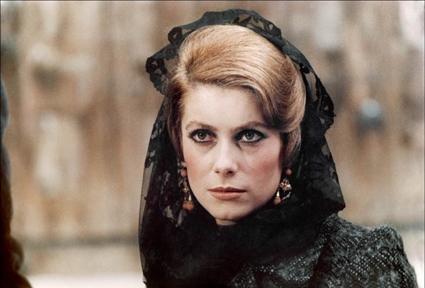
Catherine Deneuve in Luis Bunuel’s Tristana (1970)
The 16th Spanish Film festival will be spreading some Latin-loving, warmth and charm across Australia in June. It opens with A Gun in Each Hand (Una pistola en cada mano, 2012) by Cesc Gay, a comedy about the changing role of men and masculinity and concludes with a rare big screen showing of Luis Buñuel’s Tristana (1970), starring Catherine Deneuve in a dark tale of patriarchal passion and possession. In between will be 20 Spanish and Spanish-speaking Latin American films, many Australian premieres. Natalia Beristáin (Mexico), director of She Doesn’t Want to Sleep Alone (No quiero dormir sola), which premiered at the 2012 Venice Film Festival, will be touring the country as a special guest.
16th Spanish Film Festival, presented by Estrella Damm, Melbourne, Perth, Brisbane, Adelaide, Canberra, Sydney, Byron Bay, June 12-26 http://www.spanishfilmfestival.com/
melbourne international animation festival
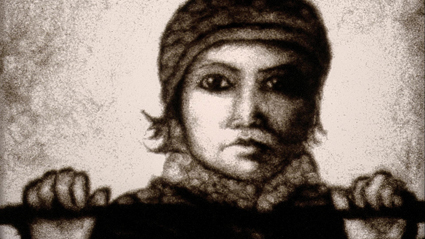
Marieka Walsh (AUS), The Hunter, Melbourne Animation Festival
This year’s MIAF runs for 11 days offering a huge amount of animated action. There are eight screening programs of international competition entries alone. Then there are showcases from Canada, Lithuania, Portland (home of edgy and indie—Bill Plympton, Matt Groening, Gus Van Sant etc) and of course Australian showcases as well. There’ll also be the first ever MIAF conference, Render (June 21-22), with keynote speaker Koji Yamamura who will be presenting retrospectives of his animations for adults and children. To help you make your program choices see the preview in RealTime 115.
Melbourne International Animation Festival, ACMI Cinemas, June 20-30; http://www.miaf.net/2013/home.html
elvis richardson, slide show land
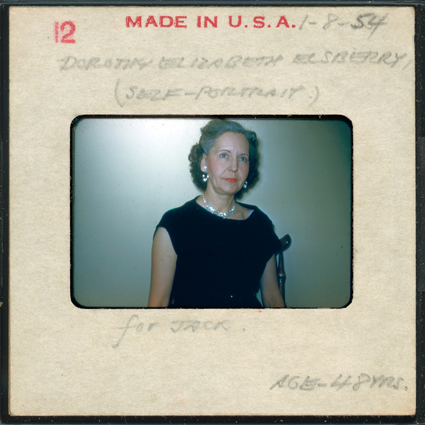
Dorothy (Self Portrait), 1964-2013, 35mm slide, Slide Show Land series, Elvis Richardson
Elvis Richardson has been buying up big on e-Bay—she has over 10,000 35mm slides dating from 1940-1980. In her exhibition, Slide Show Land at Nellie Castan Gallery, she reconfigures these memory fragments as projections and photographic prints, set in an environment of sculptural objects constructed from domestic furniture. Richardson is investigating “sentimental feelings of reminiscence, as well as the pervasive familiarity of the image economy found today on facebook and flickr” (press release).
Elvis Richardson, Slide Show Land, Nellie Castan Gallery, Melbourne, June 6-29; http://www.nelliecastangallery.com/artist/10.127.281/elvis-richardson-slide-show-land.html
tony albert, projecting our future, agnsw
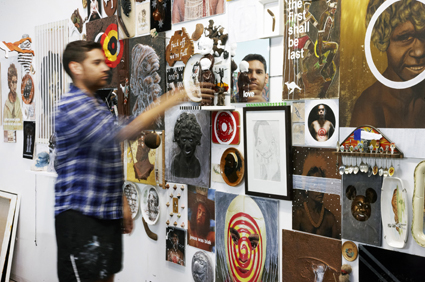
Tony Albert, Projecting our future 2002-13 (detail in progress), installation made of reworked objects, sculptures and paintings; original photographs, paintings and drawings and three unique artworks by Daniel Boyd, Dale Harding and TextaQueen
private collection, New Zealand © the artist
Tony Albert, Projecting our future 2002-13 (detail in progress), installation made of reworked objects, sculptures and paintings; original photographs, paintings and drawings and three unique artworks by Daniel Boyd, Dale Harding and TextaQueen
Tony Albert also reconfigures images from the past. The final part of a trilogy, Projecting our Future at the AGNSW Project Space, combines kitsch, souvenir-type representations of Aboriginality with contemporary illustrations and paintings. The complex multilayered assemblage interrogates “cultural difference in relation to pride, optimism and solidarity” (website). And while at AGNSW you can check out Brenda L Croft’s striking portrait series in the Yirbana Gallery (until Sept 8).
Tony Albert, Projecting our future, AGNSW Contemporary Project; until June 7; http://www.artgallery.nsw.gov.au/exhibitions/tony-albert/
loading the silence: australian sound art in the post-digital age, linda kouvaras
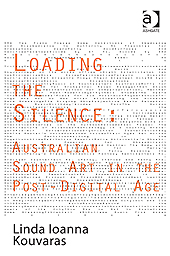 While still small in number, the books about Australian experimental music and sound are beginning to claim some space on library shelves. The latest addition is by academic Linda Kouvaras, the result of an ARC Research grant. It investigates “experimentalism from its inception in the early twentieth century…[and] how sound is embedded within local, national, gendered and historical environments” with a particular focus on Australian practice (press release). The book will be launched by Warren Burt, June 5, at the Grainger Museum, The University of Melbourne.
While still small in number, the books about Australian experimental music and sound are beginning to claim some space on library shelves. The latest addition is by academic Linda Kouvaras, the result of an ARC Research grant. It investigates “experimentalism from its inception in the early twentieth century…[and] how sound is embedded within local, national, gendered and historical environments” with a particular focus on Australian practice (press release). The book will be launched by Warren Burt, June 5, at the Grainger Museum, The University of Melbourne.
Published Ashgate by http://www.ashgate.com/isbn/9781409441564
still in the loop
anne landa award for video and new media arts 2013, agnsw
Anne Landa Award for Video and New Media Arts 2013, May 16-Jul 28, Art Gallery of New South Wales
http://www.artgallery.nsw.gov.au/exhibitions/space-between-us/
more…
everyday rebellions, gertrude contemporary
Gertrude Contemporary, Melbourne, May 11- June 8
http://www.gertrude.org.au/exhibitions/gallery-11/current-13/
more…
joachim koester, frances stark, ian potter museum of art
Ian Potter Museum of Art, until June 2; http://www.art-museum.unimelb.edu.au/exhibitions/exhib-date/2013-03-20/exhib/joachim-koester-tarantism
more…
direct democracy, muma
Monash University Museum of Art, until July 6
http://www.monash.edu.au/muma/exhibitions/upcoming/direct-democracy.html
more…
bloom—space, aeaf
Australian Experimental Art Foundation, Adelaide, until June 1
http://aeaf.org.au/exhibitions/21_bloomspace.html
more…
peter dailey, apparition: the syndicate ii
Fremantle Arts Centre until June 2; http://fac.org.au/events/288/peter-dailey-apparition-the-syndicate-ii?mid=12
more…
networked art forms & tactical magick faerie circuits, cast
Hobart, May 31-June 30;” http://tacticalmagick.net/
more…
conduit arts space initiative
May Music & Performance Program, Conduit Arts Initiative, Fitzroy
Full program http://conduitarts.wix.com/conduitarts#!program-music/ch3c
more…
diffuse, uts
May 23 & June 6, Bon Marche Studio, UTS
http://diffuse2013.wordpress.com/
more…
opal vapour, jade dewi tyas tunggal, mobile states
Adelaide, Perth, Hobart, Cairns, McKay, Brisbane, Canberra, Blacktown
May-June, see website for details http://performinglines.org.au/productions/opal-vapour/; http://opalvapour.com.au/
more…
gemeinboeck & saunders, velonaki, ingram, artspace
ISEA satellite exhibition, May 2-June 16 http://www.artspace.org.au/gallery_upcoming.php
more…
composition to movement festival, creative practice lab, unsw
May 24-26, part of Vivid Sydney
http://sam.arts.unsw.edu.au/c2m
more…
eve and eve, rebecca agnew, 24hr art
until June1
http://www.24hrart.org.au/
more…
hatched: national graduate show 2013, pica
until June 9
http://www.pica.org.au/
more…
shadowlife, bendigo art gallery
until July 28 http://www.bendigoartgallery.com.au/Exhibitions/Current_Exhibitions/Shadowlife
more…
RealTime issue #114 April-May 2013 pg. web
© RealTime ; for permission to reproduce apply to realtime@realtimearts.net
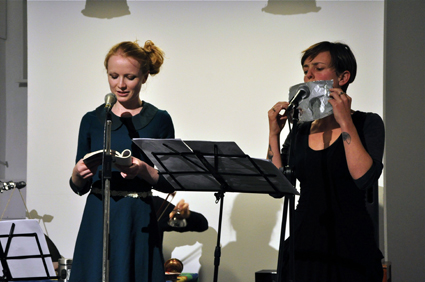
Jessica Wilkinson, Jenny Barnes perform marionette at Conduit Arts, May 9
photo Mandy Kitchener
Jessica Wilkinson, Jenny Barnes perform marionette at Conduit Arts, May 9
conduit arts, melbourne
The Artist Run Initiative Conduit Arts in Fitzroy has a unique operating system: one month it’s home to the visual arts and the alternate month it functions as a music and performance venue. (See Partial Durations blog for Matthew Lorenzons’ review of a recent concert curated by Simon Charles http://partialdurations.wordpress.com/2013/05/13/manteia-marionette/). The directors are now calling for proposals for activities October 2013 to April 2014.
Applications due July 15; http://conduitarts.wix.com/conduitarts#!artproposals/c2zo
templeberg residential writing fellowship
The Templeberg Villa is a Dutch Colonial merchant house in Galle on Sri Lanka’s south coast. In partnership with Writers Victoria, it is offering a one month funded residency to an Australian writer of fiction, non-fiction, performance, poetry or even be a journalist or blogger.
Applications close June 14; http://writersvictoria.org.au/services/fellowships/templeberg-residential-writing-fellowship
still in the loop
librettist workshop, chamber made
Chamber Made Opera, Writers Victoria, The Wheeler Centre, July 29- August 2; http://www.chambermadeopera.com/program/Librettists_Workshop
more…
city of melbourne annual grants
Applications close 17 June 2013.http://www.melbourne.vic.gov.au/aboutcouncil/grantssponsorship/artsgrants/Pages/ArtsFunding.aspx
more…
stephen cummins bequest residencies, performance space
Applications close June 3
http://www.performancespace.com.au/2013/stephen-cummins-2013-callout-queer-artists/
more…
beijing residency, 4a centre for contemporary asian art
Deadline May 31
http://www.4a.com.au/4a-beijing-residency-program/
more…
workshops, networked art forms & tactical magick faerie circuits, cast
With Julian Oliver & Danja Vasiliev (May 31- June 2); Anne Goldeberg & Karine Rathle (June 5-8)
More info http://tacticalmagick.net/workshops
more…
call for percussion scores, campbelltown city council
Deadline for submissions July 1; www.campbelltown.nsw.gov.au/CallforScore
more…
arts house season 1, 2014
Deadline May 31
www.melbourne.vic.gov.au/ArtsHouse/fundinggrants/Pages/Fundingandgrants.aspx
More…
channels video art festival
Deadline June 1
More info www.channelsfestival.net.au/
More…
selected australia council grant deadlines
(for full list see http://www.australiacouncil.gov.au/grants)
Visual Arts: Australia Council Visual Arts Laureate Award and Medal, due May 27, 2013
http://www.australiacouncil.gov.au/grants/2013/visual-arts-laureate
Visual Arts: Creative Australia – New Work, due May 27, 2013
http://www.australiacouncil.gov.au/grants/2013/creative-australia-new-work
Market Development, Visions of Australia and Contemporary Touring Initiative, due May 31, 2013
http://www.australiacouncil.gov.au/grants/2013/visions-of-australia-and-contemporary-touring-initiative
Market Development, Playing Australia, due May 31, 2013
http://www.australiacouncil.gov.au/grants/2013/playing-australia-31-may
Contemporary Music Touring Program, due June 11, 2013
http://www.australiacouncil.gov.au/grants/2013/contemporary-music-touring-program-11-june
International Showcase – Music makers (Previously Live On Stage – International Showcase Program) – due June 19, 2013
http://www.australiacouncil.gov.au/grants/2013/international-showcase-music-makers-19-june-2013
International Markets – Music managers (Previously Live On Stage – Music Managers) – due June, 19 2013 http://www.australiacouncil.gov.au/grants/2013/international-markets-music-managers-19-june-2013
Music: New Work – Writing and Recording, due June 24, 2013
http://www.australiacouncil.gov.au/grants/2013/music-new-work-writing-and-recording-24-june
Music: Presentation and Promotion, due June 24, 2013
http://www.australiacouncil.gov.au/grants/2013/music-presentation-and-promotion-24-june
Theatre: Key Organisations, due June 25, 2013
http://www.australiacouncil.gov.au/grants/2013/key-organisations-theatre
Theatre: Program Presenter, due June 25, 2013
http://www.australiacouncil.gov.au/grants/2013/theatre-program-presenter
RealTime issue #114 April-May 2013 pg. web
© RealTime ; for permission to reproduce apply to realtime@realtimearts.net
Frequently messages land in our inboxes that get us calculating our frequent flyer points. This week a cluster of perverse pleasures—Sisyphean tasks, songs of pain and loss, haute cuisine and executions, and the “disintegrating spectacle”—lures us to London.
bill viola, frustrated actions and futile gestures
The eloquent video artist Bill Viola will soon be presenting his latest breathtaking creations in London in a major exhibition, Frustrated Actions and Futile Gestures, at Blain Southern Gallery. The centre piece is the series The Chapel of Frustrated Actions and Futile Gestures (2013) which depicts figures performing repetitive and seemingly futile tasks: digging and re-filling a hole; filling a leaking bowl; dragging a cart up a hill, only to let if roll down again. Complementing these parable-like screen-based works is a diptych—projected onto granite slabs—of an ageing man and woman surveying their naked bodies via torchlight. There will also be works from his Mirage series (2012-13) shot on location in the Mojave Desert and The Dreamers (2013) where Viola returns to the submerged figure, continuing his investigations into the spiritual and the subconscious.
Bill Viola, Frustrated Actions And Futile Gestures, Blain|Southern, London, June 5-27; http://www.blainsouthern.com/gallery-info/london-hanover-square
madam plaza, bouchra ouizguen
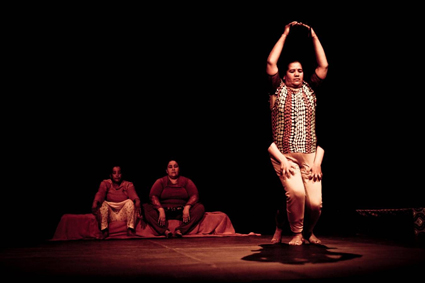
Bouchra Ouizguen’s Madam Plaza
courtesy LIFT
Bouchra Ouizguen’s Madam Plaza
The work of Morrocan-born choreographer Bouchra Ouizguen first came to our attention with her work Ha! presented at Montpellier Danse 2012. Mary Kate Connolly wrote, “What is most delightful about this work is the fact that it surrenders neither to spoof nor to overly earnest posturing. It determines a language of its own, drawn from the body and the characters onstage, which it sticks to without exception.” (RT112) Ouizguen will be premiering another of her works in London (presented by LIFT), as part of Shubbak: A Window on Contemporary Arab Culture. Madam Plaza features the choreographer along with four aïtas—women who sing “songs of pain, loss and impossible love at (communal) celebrations and nightclubs” (website). These women are equally admired and scorned in Morrocan society. You can see a short preview here.
Shubbak: A Window on Contemporary Arab Culture: Madam Plaza, Bouchra Ouizguen’s Company O, presented by LIFT, June 22-July 6; http://shubbak.co.uk/; http://liftfestival.com
trash cuisine, belarus free theatre
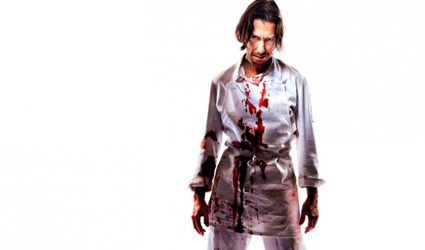
Free Theatre Belarus, Trash Cuisine
courtesy LIFT
Free Theatre Belarus, Trash Cuisine
Also presented by LIFT is the Belarus Free Theatre with their new work Trash Cuisine. The company impressed Sydney audiences back in 2009 with Being Harold Pinter of which David Williams wrote, “an utterly riveting, relentlessly paced and forcefully delivered theatrical presentation. Even simple exchanges bristle with menace and acquire accusatory overtones” (RT89). In Trash Cuisine the company combines the opulence of fine dining with capital punishment. See a chilling segment here.
Trash Cuisine, Belarus Free Theatre, presented by LIFT, May 30-June 15, Young Vic, London; www.liftfestival.com
mackenzie wark, the spectacle of disintegration
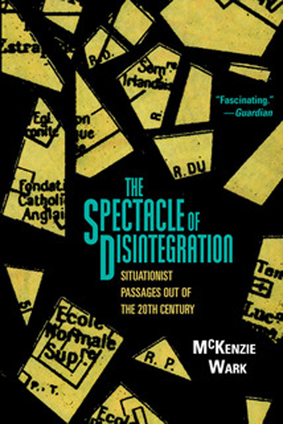 Australian ex-patriot Mackenzie Wark contributed many provocative articles to RealTime in the 1990s on media art and culture (all of which will soon be available as part our Media Art Archive, launching during ISEA). His latest book, The Spectacle of Disintegration is part two of his research into the Situationists. Here he follows the movement after the 1968 riots, including an in depth look at the film work and early game theories of Guy Debord. According to the press release “Wark builds on their work to map the historical stages of the society of the spectacle, from the diffuse to the integrated to what he calls the disintegrating spectacle” (Verso website). Furtherfield Gallery London will be hosting an afternoon discussion with Wark, introduced by writer/academic Dr Richard Barbrook (Imaginary Futures: From Thinking Machines to the Global Village. (Pluto Press, 2007).
Australian ex-patriot Mackenzie Wark contributed many provocative articles to RealTime in the 1990s on media art and culture (all of which will soon be available as part our Media Art Archive, launching during ISEA). His latest book, The Spectacle of Disintegration is part two of his research into the Situationists. Here he follows the movement after the 1968 riots, including an in depth look at the film work and early game theories of Guy Debord. According to the press release “Wark builds on their work to map the historical stages of the society of the spectacle, from the diffuse to the integrated to what he calls the disintegrating spectacle” (Verso website). Furtherfield Gallery London will be hosting an afternoon discussion with Wark, introduced by writer/academic Dr Richard Barbrook (Imaginary Futures: From Thinking Machines to the Global Village. (Pluto Press, 2007).
Mackenzie Wark, The Spectacle of Disintegration, May 25, 4pm, Furtherfield Gallery London, http://www.furtherfield.org; www.versobooks.com
RealTime issue #114 April-May 2013 pg. web
© RealTime ; for permission to reproduce apply to realtime@realtimearts.net
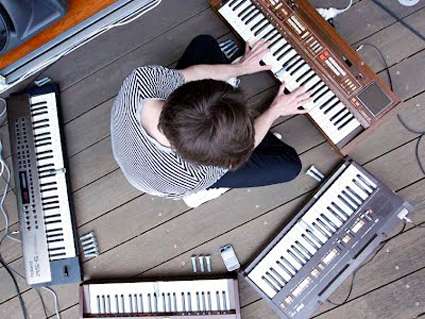
Julian Day, Infinity Room
Since its incarnation in 2009, Vivid festival’s music program has concentrated on the big end of town—major international (and occasionally Australian) artists performing at the iconic pearl of the city (or more an oyster shell), the Sydney Opera House. However this year offers more diversification with activities of all kinds radiating out from the harbour, including the Seymour Centre hosting a series of Vivid events, one of which is the New Wave: Sound program.
Curated by Seymour Centre resident Andrew Batt-Rawden (Chronology Arts), Ndew Wave: Sound is a mini-festival of music that hovers above the genre boundaries of contemporary classical, electroacoustic, jazz, soundscape and even pop. I asked Batt-Rawden about the slipperiness of categorisations.
“It’s very difficult to pin it down to a particular genre because a lot of this music is genre-less, other than calling it art music or contemporary classical. It’s such a broad area that can include a whole plethora of moods, feelings, styles, rhythms, harmonic constructs—it’s really like a new world to explore. That’s why the title New Wave: Sound is relevant. Also it’s playing on the idea of vibrations—sound waves.”
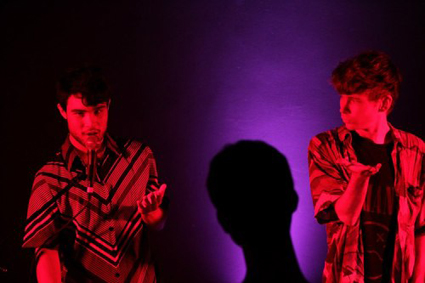
Collarbones
To set the context, the event opens with a forum around “what’s hot” in new music with guest commentators Ignatius Jones (Creative Advisor, Vivid), Marcus Whale (composer, member of Collarbones), Julian Day (composer, presenter on ABC Classic FM), Adam Lewis (host of Radiant on FBi Radio) Lyle Chan (composer, Creative Consultant) and Batt-Rawden. Following this audiences will have to make a difficult choice since the first two concerts are presented simultaneously.
Playing in the Sound Lounge is Italian jazz composer/pianist Kekko Fornarelli (with Giorgio Vendola, double bass and Dario Congedo, drums and percussion) performing laid back jazz meets classical lyricism. Those seeking more angular pleasures should try Abstraction & Pathology, a concert of works by virtuosic electroacoustic composer Anthony Pateras performing with Natasha Anderson (recorder and electronics) and Erkki Veltheim (viola). Pateras, who now lives in Brussels and whose work was recently profiled by Speak Percussion at Maerzmusik in Berlin (see review in RT115), certainly fulfils Batt-Rawden’s desire to program the “epitome of ‘awesomeness’ in electroacoustic music.”
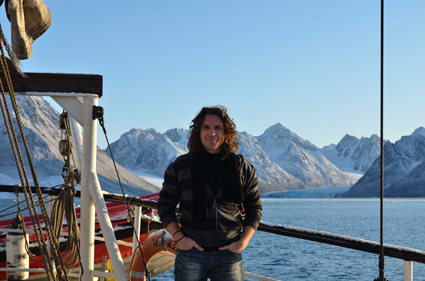
frostbYte
The second day consists of back-to-back performances, starting at midday. They include compositions for bass recorder commissioned and performed by Alicia Crossley; the drone minimalism of Julian Day’s Infinity Room project; a multichannel soundscape with visuals by frostbYte (aka Daniel Blinkhorn); string quartet The NOISE; and various group configurations featuring electric guitarist virtuoso Zane Banks, including Australia’s only guitar quartet, Ampere. The evening finishes up with pop-duo Collarbones (Marcus Whale and Travis Cook).
Batt-Rawden, in his previous role of Artistic Director of the 2012 Aurora Festival, introduced Western Sydney audiences to this eclectic combination of acts so I asked him what it was about these artists that so appealed to him.
“All of the artist who are being presented are people with get-up-and-go, who take the initiative whether that be creative initiative [in their compositions] or in producing fantastic programs…That risk-taking is reflected in the micro-detail of their compositions and performances, as well as the broader programming they have done in other concerts.”
Andrew Batt-Rawden certainly has his share of get-up-and-go and he’s not afraid to think big, asserting, “Although ‘entrepreneur’ can be a dirty word in artistic practice, I don’t think it should be.” While preparation for this year’s program had quite a compressed timeline, he is already planning next year’s event, which will see the relationship with SIMA (Sydney Improvised Music Association which is presenting Kekko Fornarelli this year) developed into a more comprehensive collaboration. Batt Rawden says, “There’s actually an interesting mix of jazz influences with classical training in next year’s program.” But first things first: ride the new wave this year and see where it takes you.
Vivid Sydney @ Seymour: New Wave: Sound, curator Andrew Batt-Rawden, Chronology Arts, Seymour Centre, June 7-8; http://www.seymourcentre.com/new-wave-sound/
You can also check out some video clips of The NOISE , Frostbyte, Julian Day
RealTime issue #114 April-May 2013 pg. web
© RealTime ; for permission to reproduce apply to realtime@realtimearts.net
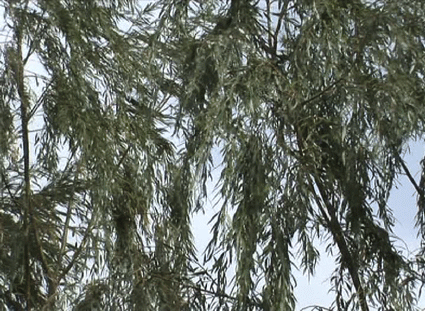
Wang Gongxin, Tonight Maybe Have Wind (2006), video stills
Down an alley between the small-scale old industrials of Fortitude Valley and into the new location of MAAP (Media Art Asia Pacific). Starting 15 years ago curating Asian-Pacific multimedia, Kim Machan’s MAAP has expanded into a gallery space, media resource centre and online repository of back catalogue(s) and other writings. A happy extension from curator to host.
The new space opened late last year with a solo show by Zhang Peili, who pretty much initiated video art in China with his 1988 video performance of repeatedly smashing a mirror, gluing it back together, smashing it again, regluing etc etc. Now MAAP is showing the other major pioneer of video art in China, Wang Gongxin, who installed and exhibited The Sky of Brooklyn—Digging a hole in Beijing in his own home in 1995, the first time video art was shown in Beijing.
Two works from Gongxin. The unfortunately named Tonight Maybe Have Wind (2006) is there as you enter—flat TV-sized monitor on the wall, a close-ish shot of swaying branches running in a repeated pattern of super-fast and ultra slow. Four minutes sped up and slowed down in such a way as to keep the ‘actual’ total duration unchanged. And there’s a subtle change synced to the image speed—the colour drops out to black and white, then slowly returns. Seems a bit of a formalist exercise on the representation of time through tech and I find myself struggling to get much of an aesthetic or intellectual buzz. I think about subjective time and attentional focus, the adaptive function of colour vision for an ape wanting to munch the ripest fruit and the freshest leaves but, nup, nothing. Ah well.
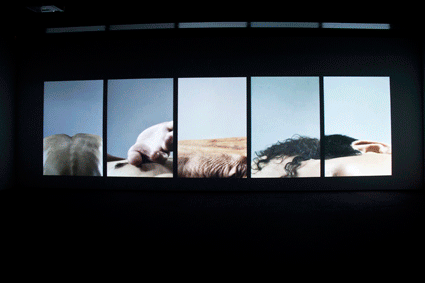
Wang Gongxin, Basic Colour (2010), installation view
photo Emily Nelson
Wang Gongxin, Basic Colour (2010), installation view
The other piece, Basic Colour (2010), provides an occasion for contemplation in formal simplicity and slowly changing fields of colour and sound. This work is much larger, five doorway-sized videos projected in a line onto a single wall. On the bottom third or so of each is a closeup of a body part—the back onto the shoulders, a hand reaching toward us, the side of another hand, the nape of the neck, a head on its side. Images are in sharp focus, abstracted by their size. Starts au naturel then pigment begins to fall onto each of the body parts—black on the shoulders, blue to the reaching hand, red to the side, yellow to the nape and white to the head. I cringe watching the ear slowly fill with white pigment. The sound is like rice falling onto card, a population of coherent noise emerging from thousands of individual grains. Then the pigment stops and water begins to softly fall and bead with the pigment. The beads join together, trickles form and colour runs down the body and away. And in moving from dry pigment to dripping water the sound slowly changes from falling rice to falling rain. Or maybe I’m imagining that change, the dominance of the visual forcing consistency between unchanging sound and changing image.
The body as land goes back forever. There are bodies of water, breast-named hills and bodies marked with ochre and ash. Gongxin shows that tradition and washes it away. The video loops and the tradition replays.
Wang Gongxin, MAAP Space, Fortitude Valley, Brisbane, March 22-May 3; maap.org.au; wanggongxin.com
Also check out http://www.maap.org.au/publications/, the recently launched online archive featuring 15-years of MAAP publications.
This article originally appeared as part of RT’s Online e-dition May 15, 2013
RealTime issue #115 June-July 2013 pg. 28
© Greg Hooper; for permission to reproduce apply to realtime@realtimearts.net
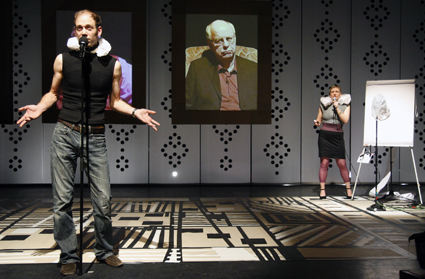
Testament, She She Pop
photo Doro Tuch
Testament, She She Pop
Listen to my story, it might be true. Some version of biographical performance was at the core of many shows at Vancouver’s PuSh 2013. ‘This is my life, your life, our lives’—the strength (or weakness) of such truth-claims was only as good as the artist’s aesthetic muscle. Some had trained harder than others.
Testament
Testament by She She Pop (Germany) mines Shakespeare’s King Lear for insights on contemporary intergenerational issues such as inheritance and elder care. Three Lears, untrained performers in their 70s, and their four real-life progeny (permanent members of the company) confront, empathise with and sometimes court one another’s favour.
As in King Lear, there is humour: one of the fathers, Manfred Matzke, a physicist, keeps it logical by calculating the exchange of love, which he calls “impulse,” and property—“emissions,” between parent and child, using algebraic equations drawn on a flip chart. Lear’s mistake was to release his “emissions” too soon; once his children had received all of his property they had no incentive to return “impulse.”
There is also brutal truth: Joachim Bark speaks of the shame he felt when, in an earlier work by She She Pop, he was forced to look up his daughter’s shirt as she wrestled with another woman while suspended above the audience. Bark has no objection to nudity as long as it’s justified. When witnessing an older actor of the German stage tossed naked during the storm scene from King Lear, Bark had felt the gesture was symbolically appropriate. His analysis justifies what happens next in Testament: the fathers are stripped down to their underwear while the daughters dance a storm around them.
The presentational and task-oriented performance style of Testament keeps the investigation open to the audience. The tasks are straightforward: sing a song to your daughter, read some relevant text from Lear, describe the algebraic formula while you are drawing it, et cetera. It’s the rhythm with which the tasks are arranged that gives the sum of the parts emotional momentum and devastating clarity.
Cédric Andrieux
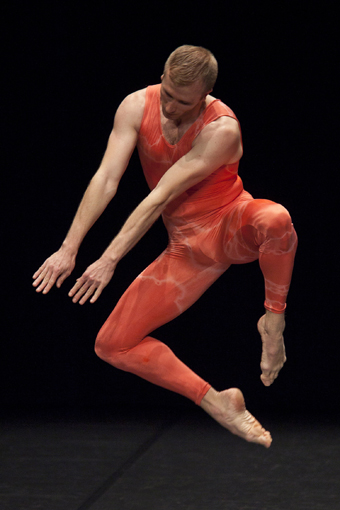
Cédric Andrieux
photo Marco Caselli Nirmal
Cédric Andrieux
As in previous shows I’ve seen by choreographer Jérôme Bel, the rules of the game are strict. On a bare stage, he tightly controls the gestural and vocal performance of Cédric Andrieux, a statuesque dancer in his mid-30s. Andrieux performs excerpts from his life as a dancer, demonstrating training sequences and recreating past shows. Occasional comments about a past love relationship are kept to a minimum. Andrieux almost always speaks to us directly. We return the gaze. It’s implicit in this controlled situation that, while engaging in direct visual ‘conversation’ with Andrieux, we must never approach the stage. Nor should we vocally interrupt the chronicle. And yet for all these constraints, the rhythm of the piece is so expertly constructed I have no desire to disrupt it. Andrieux’s inadvertent twitches reveal a lot. The constraints amplify his inherent charm. By the end I feel I know nothing about Andrieux as a person, but everything about him as a dancer. As in Testament, aesthetic rigour in the form of simplicity of address creates a deeply engaging encounter between spectator and performer.
Photog
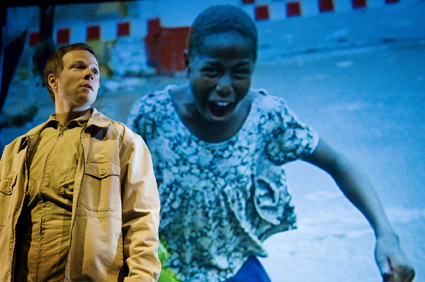
Boca del Lupo, Photog
photo Karri North
Boca del Lupo, Photog
Photog by Boca del Lupo (Vancouver) consists of verbatim extracts from the testimony of several conflict photographers. Boca has chosen to collapse these into one psychologically consistent character named Thomas Smith, played by producer-actor Jay Dodge. A large screen framing the back of the stage features stunning photographs from conflict zones—human beings shot up, crying, dying. It would take a world-class performer to match the drama of those super-charged images. Dodge’s performance, as well as live-feed projections of him onto the photographs, obscures the source material… and the issue. By fusing the various testimonies into one fictional character, who does Photog ultimately serve, the work of the photographers or the artistry of Boca del Lupo? And if it’s the latter, how well does Boca’s work stand up to the artistry of the photographers? To me it seems a mismatch.
Winners and Losers
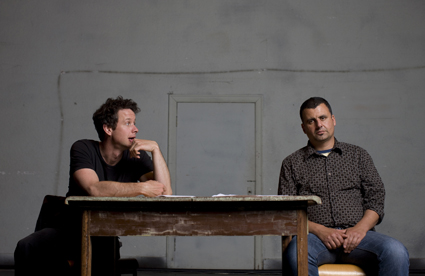
James Long, Marcus Youssef, Winners and Losers
photo Simon Hayter
James Long, Marcus Youssef, Winners and Losers
Like Boca del Lupo, James Long (Theatre Replacement) and Marcus Youssef (Neworld Theatre) default to psychological realism as they offer a confessional of privilege in our society of haves and have-nots. Flanked on either side of a rough wooden table, the two play a question-and-answer game: one of them names a topic (“being an only child”) or celebrity figure (Tom Cruise) and they debate its status as a “winner” or “loser.” The topics get personal. Sort of. Long and Youssef perform stage versions of themselves each can live with, but these fictionalised portraits don’t match the implied intent of the piece, which seems to be to create a public forum in which the two artists offer up their authentic selves as examples of self-serving combatants in a dog-eat-dog capitalist system. Instead they fall back on performing carefully rehearsed routines as if occurring for the first time. This includes an obviously choreographed and not very dangerous-looking wrestling match (why not a real wrestling match with an unplanned outcome?). Similarly, at the closing of the show they pretend their partnership has been irreparably damaged: “It’s over!” they say in unison. Of course we know full well the two are about to embark on a national tour. The show’s pretence of self-revelation looks like a con, but not the kind of rigorous aesthetic con that asserts its own truth.
The biggest problem with Winners and Losers is its politics. If this is a show about the cost of privilege in our society, it offers only the upside. The two performers serve up a bit of liberal guilt mixed with a lot of self-justification, and ‘confess’ to having family incomes of $100,000 or more. They lack a foil in the form of, say, an undocumented immigrant labourer or a single working parent who can’t afford daycare. The truly disenfranchised have no voice in a work that professes to embrace “the ruthless logic of capitalism.” In this show, everyone’s a winner, baby.
I, Malvolio
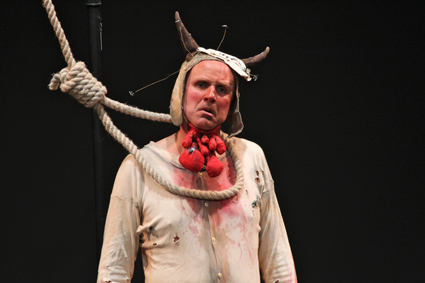
Tim Crouch, I Malvolio
photo Bruce Dalzell Atherton
Tim Crouch, I Malvolio
Moving away from the ‘genuine’ biography, Tim Crouch (UK) gives us a villainous first-person fiction of a fictional villain. Malvolio, the ludicrous, shamed and much-loved fool of Shakespeare’s Twelfth Night, returns from the dungeons of Illyria to turn the tables on those who have most revelled in his downfall—the audience. In the delicious sado-masochistic exercise to come Crouch invites us to mock him, then punishes us for it. Back and forth he expertly works us while demanding retribution for wrongs we have inflicted on Malvolio over the past 500 years.
I felt some relief in this production, lacking as it was in any claims to documentary truth (and perhaps implicitly critiquing such performances through its playful appropriation of autobiographical performance). That it felt as true as anything else I’d seen is due to Crouch’s virtuosity. His work is immaculately structured, while remaining open to spontaneous impulses. In other words, he sure knows how to work a crowd. His work with the text is also masterful—he has enviable range, colour and specificity. And perhaps it is in I, Malvolio that we really get to see the “ruthless logic of capitalism.” Malvolio, believing he is uniquely necessary to those he serves, and tricked into thinking his master is in love with him, discovers he is nothing more than a lackey, as replaceable as any small cog in a system where romantic love is the preserve of those who can afford such indulgences.
Still Standing You
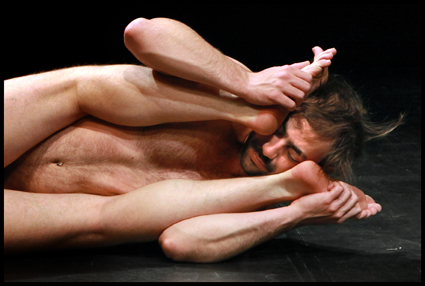
Pieter Ampe, Guilherme Garrido, Still Standing You
photo Phile Deprez
Pieter Ampe, Guilherme Garrido, Still Standing You
Contemporary dance is often about the dancer as both subject and object of performance. The personal story is already ‘written’ on the body. Jérôme Bel achieves this with his stripped down presentations of unadorned performers. Pieter Ampe (Belgium) and Guilherme Garrido (Portugal) go for even fuller exposure in Still Standing You. Drawing on the playful and masochistic games of their boyhoods, the two men put on cartoonish alter egos (dinosaurs, exotic birds), ride each other, hit each other, and get naked. The serious/comic manner in which they up the ante of consenting physical abuse makes you wonder how far they will go. Pretty far. It doesn’t take long before each has a grip on the other’s foreskin and is testing its elasticity with corkscrew twists and painful elongations. Now that’s an exposé. If Winners and Losers is about the socio-economic factors that fracture the relationship of two theatre buddies, this show is about the socio-physical extremes to which two dance buddies will go in search of a deeper bond. (See also Tim Atack’s review of the duo’s 2010 performance of Still Standing You at In Between Time in Bristol)
Lear
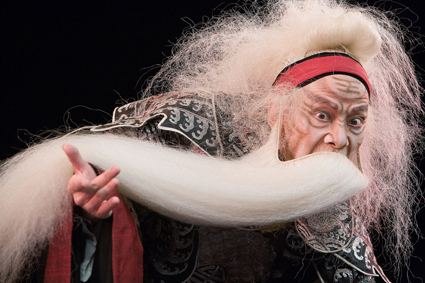
Wu Hsing-Kuo, King Lear
photo Dirk Bleicker
Wu Hsing-Kuo, King Lear
Wu Hsing-Kuo of Contemporary Legend Theatre (Taiwan) uses King Lear as an analogue of his troubled relationship with his former opera master. Wu had been severely criticised for trying to update the conventions of Peking Opera. To Wu’s regret, he and his master never reconciled. In this solo show he purges his demons, focusing on the father-son relationships in Lear, and minimising the role of the daughters. In Act III Cordelia becomes a stand-in for Wu’s master, and it is through her that he makes his apologies and purges his guilt. Unfortunately, minimising the role of the daughters in Lear leaves us with the familiar father-son tropes Hollywood relentlessly subjects us to, from Star Wars to The Lion King. I prefer the complex considerations of Lear’s daughters who are forced to deal with their father’s juvenile sense of entitlement, both in the original play, and in She She Pop’s feminist reworking of it.
PuSh international Performing Arts Festival 2013, artistic director Norman Armour, Jan 15-Feb 3, Vancouver, http://pushfestival.ca
This article originally appeared as part of RT’s Online e-dition May 15, 2013
RealTime issue #115 June-July 2013 pg. 16-17
© Alex Lazaridis Ferguson; for permission to reproduce apply to realtime@realtimearts.net
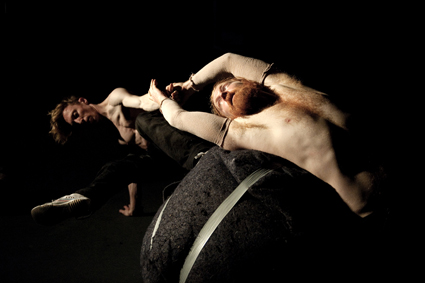
Skye Gellman, Kieran Law, Blindscape, La Boite Theatre Company (2013)
photo Sarah Walker
Skye Gellman, Kieran Law, Blindscape, La Boite Theatre Company (2013)
la boite indie, part 1
Each year Brisbane’s La Boite showcases works from a selection of emerging/underground/indie performance companies (whatever nomenclature you prefer). There’s not a traditional sit-down-and-shut-up audience experience among the first three shows currently showing. Sandra Carluccio’s This is Capital City lets the audience loose in Kelvin Grove charged with the mission to unearth the town’s myths with the help of some “city officials” and a mobile phone. The Séance by Mark Pritchard and Bridget Balodis invites the audience to a secret location where they will be complicit in the summoning of spirits. Blindscape, by Skye Gellmann collaborating with Kieren Law, turns the theatre space into an inhabited installation—the audience is guided through the performance via the Blindscape App supplied on entry. After the second Indie season later in the year audiences will be invited to vote for the performance they’d like to see remounted at QPAC in 2014.
La Boite Indie, May 8-25; http://laboite.qtix.com.au/laboiteindie2013/
lineage, form dance projects
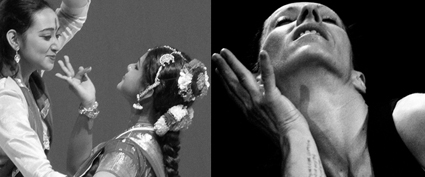
(left) Aruna Gandhimathinathan, Shruti Ghosh; (right) Tammi Gissell
photos (left) Annalouise Paul, (right) Lorna Sim
(left) Aruna Gandhimathinathan, Shruti Ghosh; (right) Tammi Gissell
Aruna Gandhimathinathan is trained in Bharatanatyam traditional Indian dance while Shruti Ghosh is predominantly trained in Kathak. They will be exploring the integration of these two forms in their collaborative dance work Nritya Roopa, accompanied by musician Prabhu Osoniq. Nritya Roopa is presented by Form Dance Projects as part of Lineage, a program investigating the intersections of traditional and contemporary practices. The evening also features emerging Indigenous choreographer Thomas ES Kelly working with Carl Tolentino on Dark Dreams, and a solo by Indigenous dancer/choreographer Tammi Gissell, A Dip for Narcissus.
Form Dance Projects, Lineage, May 23-25, Lennox Theatre, Riverside, Parramatta; http://form.org.au/2013/01/nritya-roopa/
anne landa award for video and new media arts 2013, agnsw
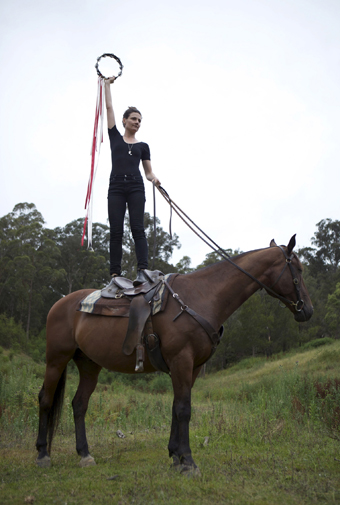
Lauren Brincat, Hight Horse (2012), documentation of an action, The space between us, Anne Landa Award for video and new media, AGNSW
courtesy the artist and Anna Schwartz Gallery
Lauren Brincat, Hight Horse (2012), documentation of an action, The space between us, Anne Landa Award for video and new media, AGNSW
Curated by Charlotte Day, the fifth iteration of the Anne Landa Award is themed “the space between us.” While video has always been at the forefront in this award, with perhaps the exception of Christian Thompson’s immersive sound installation, the media art component is less evident than usual this year, replaced it appears by performance. The video works by Laresa Kosloff, Angelica Mesiti, Kate Mitchell, James Newitt, Lauren Brincat and Alicia Frankovich are all based on perfomative actions and situations with the latter two artists also presenting live events over the course of the exhibition. Brincat’s performances will involve horse riding and mass timbrel playing, while Frankovich will present a jogging extravaganza. Perhaps a re-titling—the Anne Landa Award for Video and Performance Art—is in order?
Anne Landa Award for Video and New Media Arts 2013, May 16-Jul 28, Art Gallery of New South Wales; http://www.artgallery.nsw.gov.au/exhibitions/space-between-us/
everyday rebellions, gertrude contemporary
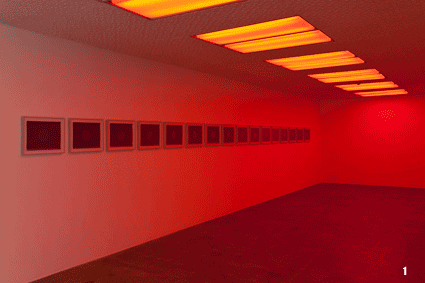
1) Dane Mitchell, The Smell of an Empty Space (Solid), 2011, Perfume, photographic paper, frame, courtesy Hopkinson Cundy and the artist, photo Sam Hartnett; 2 & 3) Kitty Kraus, Untitled, 2006, lamp, ice, ink, Courtesy of Galerie NEU, Berlin
In Gertrude Contemporary’s next exhibition it’s the objects that perform. Emily McCormack has curated a collection of works exploring the “innate activity of matter” and battlling the forces of entropy (website). For example Dane Mitchell’s photographs are “unfixed” and can only be viewed under the red lights of a darkroom, otherwise they fade to nothingness. German artist Kitty Kraus tracks the changing state from solid to liquid, her melting ink-ice puddling around a glowing light bulb for added tension. Also showing is Joan Jonas’ Vertical Roll, a video work from 1972 investigating the body in relation to the analogue glitches of the television screen.
Everyday Rebellions, Danica Chappell, Joan Jonas, Kitty Kraus, Dane Mitchell, Virginia Overell, Danae Valenza, Simon McGuinness, Gertrude Contemporary, Melbourne, May 11- June 8; http://www.gertrude.org.au/exhibitions/gallery-11/current-13/
suncorp twenties, sydney theatre company
You can’t accuse Cate Blanchett and Andrew Upton of losing touch with the average Australian—they know theatre tickets here are prohibitively expensive and they’ve actually found a solution. Brokering a deal with Suncorp, there will now be $20 tickets available for (nearly) all STC shows. You don’t have to be a student, pensioner, or under 30, you just have to try your luck on a Tuesday (via phone or in person at the box office) for the followings week’s shows. The partnership with Suncorp kicked off yesterday and will run for two years.
Sydney Theatre Company, Box Office 02 9250 1929; more info www.sydneytheatre.com.au
joachim koester, frances stark, ian potter museum of art
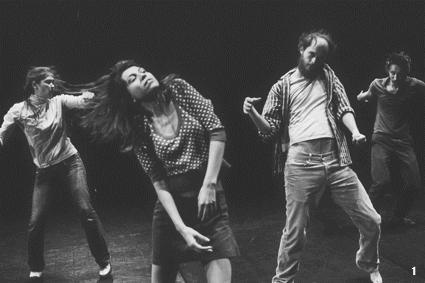
1 & 2) Joachim Koester, Tarantism, 2007, © & courtesy the artist and Galleri Nicolai Wallner, Copenhagen; 3 & 4) Frances Stark, My best thing, 2011, © & courtesy the artist and Marc Foxx, Los Angeles
If bitten by a tarantula in Medieval Italy it was believed dancing would cure you and thus the Tarantella was born. Danish artist Joachim Koester has recreated this frantic ritual in his 16mm film Tarantism currently screening for the first time in Australia, at the Ian Potter Museum. (Academic and dance historian Rachel Fensham will be giving a floor talk about the work on Thursday May 16.) Also screening is Frances Stark’s My Best Thing, a primitively animated feature which draws its content from the artist’s own interactions in the online environment Chatroulette.
Joachim Koester, Tarantism, Frances Stark, My Best Thing, Ian Potter Museum of Art, until June 2; http://www.art-museum.unimelb.edu.au/exhibitions/exhib-date/2013-03-20/exhib/joachim-koester-tarantism
stories then & now, performance 4a, carriageworks
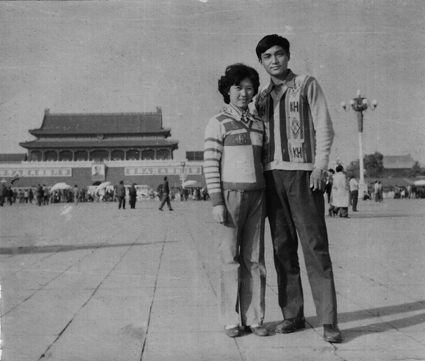
Stories Then & Now
courtesy Willa Zheng
Stories Then & Now
Photographer/raconteur William Yang and dynamic producer Annette Shun Wah have teamed up to co-direct this new theatre work focusing on the pasts and presents of six Asian Australians. The performance has developed out of Yang’s storytelling workshops and has been co-created with author Ien Ang, performer Jenevieve Chang, video journalist Michael C.S. Park, producer Sheila Pham, social worker/food writer Paul van Reyk and civil marriage celebrant Willa Zheng, with music by Nicholas Ng. Yang says “I think it is important for everyone to tell their story. It makes one conscious of self and it places one in the context of history, world and culture” (press release). Stories Then & Now is an umbrella event of the Sydney Writer’s Festival.
Stories Then & Now, presented by Performance4a & Carriageworks, May 22-25; http://www.performance4a.org.au/
goodbye jamie boyd, buzz dance & monkey baa
Goodbye Jamie Boyd is an interstate collaboration between two leading companies making performance for young people, Monkey Baa in NSW and Buzz Theatre in WA. Based on the verse novel by Elizabeth Fensham, the production uses movement, text and video design to evoke the story of a teenage girl fighting schizophrenia, haunted by the spectre of her deceased elder brother. After a successful NSW tour in 2012, Goodbye Jamie Boyd is now showing in Perth.
Goodbye Jamie Boyd, Buzz Dance & Monkey Baa, directed by Sandra Eldridge & Cadi McCarthy, Studio Underground, State Theatre Centre, Perth, May 15-25, http://www.buzzdance.com.au/productions.html#goodbye
still in the loop
direct democracy, muma
Monash University Museum of Art, until July 6
http://www.monash.edu.au/muma/exhibitions/upcoming/direct-democracy.html
more…
bloom—space, aeaf
Australian Experimental Art Foundation, Adelaide, until June 1
http://aeaf.org.au/exhibitions/21_bloomspace.html
more…
peter dailey, apparition: the syndicate ii
Fremantle Arts Centre until June 2; http://fac.org.au/events/288/peter-dailey-apparition-the-syndicate-ii?mid=12
more…
networked art forms & tactical magick faerie circuits, cast
Hobart, May 31-June 30;” http://tacticalmagick.net/
more…
conduit arts space initiative
May Music & Performance Program, Conduit Arts Initiative, Fitzroy
Full program http://conduitarts.wix.com/conduitarts#!program-music/ch3c
more…
diffuse, uts
May 23 & June 6, Bon Marche Studio, UTS
http://diffuse2013.wordpress.com/
more…
opal vapour, jade dewi tyas tunggal, mobile states
Adelaide, Perth, Hobart, Cairns, McKay, Brisbane, Canberra, Blacktown
May-June, see website for details http://performinglines.org.au/productions/opal-vapour/; http://opalvapour.com.au/
more…
gemeinboeck & saunders, velonaki, ingram, artspace
ISEA satellite exhibition, May 2-June 16 http://www.artspace.org.au/gallery_upcoming.php
more…
composition to movement festival, creative practice lab, unsw
May 24-26, part of Vivid Sydney
http://sam.arts.unsw.edu.au/c2m
more…
eve and eve, rebecca agnew, 24hr art
until June1
http://www.24hrart.org.au/
more…
hatched: national graduate show 2013, pica
until June 9
http://www.pica.org.au/
more…
no child, nilaja sun, theatre works
until May 26
http://www.theatreworks.org.au/whatson/event/?id=136
more…
shadowlife, bendigo art gallery
until July 28 http://www.bendigoartgallery.com.au/Exhibitions/Current_Exhibitions/Shadowlife
more…
RealTime issue #114 April-May 2013 pg. web
© RealTime ; for permission to reproduce apply to realtime@realtimearts.net
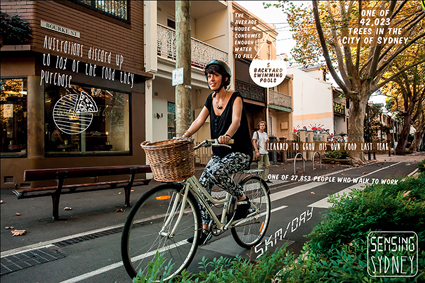
Sensing Sydney, Carbon Arts & the City of Sydney
sensing sydney, carbon arts, city of sydney
As part of Art & About 2013, Carbon Arts and the City of Sydney are looking to commission a temporary public artwork that somehow manifests data about sustainable living in Sydney—energy consumption, emissions, waste indicators, demographics etc. The aim of the work is to involve “the public in an active dialogue on environmental issues and citizen-engaged action” (website). All inclusive project budgets up to $25,000 will be considered.
Deadline 20 May
More info http://www.carbonarts.org/?post_type=projects&p=837
dramaturgy internships 2013
Sydney-based playwrights, directors or dramaturgs (emerging or more experienced) who are interested in learning more about script development are invited to apply for a six-month internship at Playwriting Australia. The successful intern will work regularly with the PWA team on script assessments and will be able to observe or assist with the National Script Workshops.
Applications close Monday May 20; http://www.pwa.org.au/dramaturgy-internships-2013
librettist workshop, chamber made
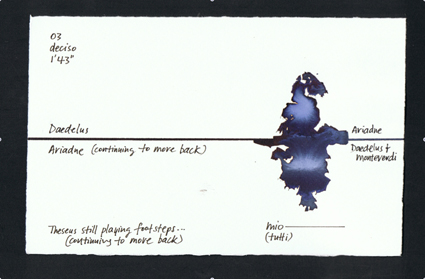
scrore from Minotaur The Labyrinth, David Young
Also on the writing front, Chamber Made Opera will be running a five-day workshop on the art of the libretto. There will be practical exercises as well as presentations by leading writers, librettists and dramaturgs Margaret Cameron, Alison Croggon, Brett Kelly, Angus Grant, Kate Schmitt and Chamber Made’s departing director David Young.
Chamber Made Opera, Writers Victoria, The Wheeler Centre, July 29- August 2; http://www.chambermadeopera.com/program/Librettists_Workshop
city of melbourne annual grants
Applications are now open for arts activities based in the City of Melbourne in 2014. Grants of up to $20,000 per applicant are available for the 2014 program.
Applications close 17 June 2013.http://www.melbourne.vic.gov.au/aboutcouncil/grantssponsorship/artsgrants/Pages/ArtsFunding.aspx
still in the loop
stephen cummins bequest residencies, performance space
Applications close June 3
http://www.performancespace.com.au/2013/stephen-cummins-2013-callout-queer-artists/
more…
beijing residency, 4a centre for contemporary asian art
Deadline May 31
http://www.4a.com.au/4a-beijing-residency-program/
more…
the sustainability of future bodies workshop series, isea2013, critical path
Applications due May 20: Apply online www.surveymonkey.com/s/ISEA13-CP-workshop-series
more…
workshops, networked art forms & tactical magick faerie circuits, cast
With Julian Oliver & Danja Vasiliev (May 31- June 2); Anne Goldeberg & Karine Rathle (June 5-8)
More info http://tacticalmagick.net/workshops
more…
call for percussion scores, campbelltown city council
Deadline for submissions July 1; www.campbelltown.nsw.gov.au/CallforScore
more…
travel fellowship, revelation, perth
Deadline 24 May
http://www.revelationfilmfest.org/go/travel/travel-fellowship
More…
arts house season 1, 2014
Deadline May 31
www.melbourne.vic.gov.au/ArtsHouse/fundinggrants/Pages/Fundingandgrants.aspx
More…
channels video art festival
Deadline June 1
More info www.channelsfestival.net.au/
More…
selected australia council grant deadlines
(for full list see http://www.australiacouncil.gov.au/grants)
Community Partnerships, due May 24
• Career Pathways – Professional Development
http://www.australiacouncil.gov.au/grants/2013/community-partnerships-career-pathways-professional-development-24-may
• Career Pathways – Fellowships
http://www.australiacouncil.gov.au/grants/2013/community-partnerships-career-pathways-fellowships
• Creative Producer
http://www.australiacouncil.gov.au/grants/2013/community-partnerships-creative-producer
• Projects
http://www.australiacouncil.gov.au/grants/2013/community-partnerships-projects-24-may
• Projects with Public Outcomes
http://www.australiacouncil.gov.au/grants/2013/community-partnerships-projects-with-public-outcomes-24-may
Visual Arts, due May 27
• Australia Council Visual Arts Laureate Award and Medal
http://www.australiacouncil.gov.au/grants/2013/visual-arts-laureate
• Creative Australia – New Work
http://www.australiacouncil.gov.au/grants/2013/creative-australia-new-work
Market Development, due May 31
• Visions of Australia and Contemporary Touring Initiative
http://www.australiacouncil.gov.au/grants/2013/visions-of-australia-and-contemporary-touring-initiative
• Playing Australia
http://www.australiacouncil.gov.au/grants/2013/playing-australia-31-may
RealTime issue #114 April-May 2013 pg. web
© RealTime ; for permission to reproduce apply to realtime@realtimearts.net
While the Head On Photo Festival in Sydney is the new kid on the block, starting up in 2010, it appears to have had a shot of rapid growth hormone. Now the largest photography festival in Australia, it claims to be the second largest in the world. (Sydney does like to do big!) Of course it manages this via conglomeration so there’s probably not a gallery in Sydney that you will walk into in late May that isn’t part of Head On. With so much happening it’s hard to know where to start the adventure so below are a few thematic inroads.
via the document
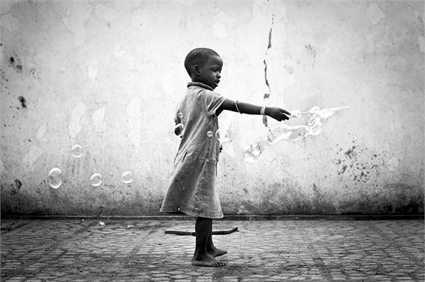
Tom Goldner, Volta
courtesy the artist
Tom Goldner, Volta
Photography is perhaps most associated with its power to bear witness to events—violent, confronting, humbling or inspiring—and there’s no shortage of documentary realism in Head On. Jimmy Pozarik has spent a year as photographer in residence at the Sydney Children’s Hospital, his images illustrating the devastating fragility of life. At the same gallery are Tom Goldner’s portraits of children from Lake Volta in Ghana, an area known for its human trafficking. The contrasting exhibitions create a complex dialogue about how young lives are valued. (Global Gallery Paddington, May 15-26; http://globalgallery.tumblr.com).
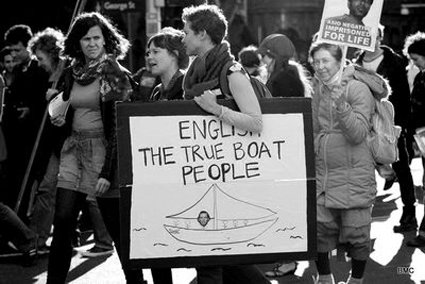
Barbara McGrady, Visions In Black & White: Images From Indigenous Australia
courtesy the artist
Barbara McGrady, Visions In Black & White: Images From Indigenous Australia
At Redfern Community Centre you can see Visions In Black & White: Images From Indigenous Australia by Barbara McGrady, a Gamilario/Murri woman who has been documenting contemporary Aboriginal life for 30 years. This exhibition features photos from the last three years including coverage of the Occupy Movement and significant Aboriginal cultural and music events. (Redfern Community Centre, May 10-June 30; http://www.cityofsydney.nsw.gov.au/explore/facilities/community-centres/redfern-community-centre)
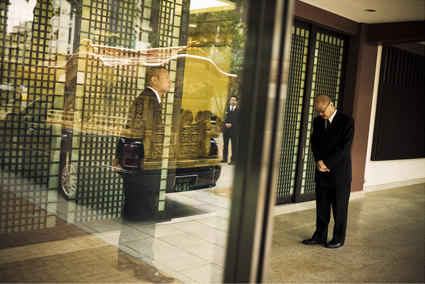
Anton Kuster, YAKUZA
courtesy the artist
Anton Kuster, YAKUZA
For a taste of the hyper-real gangster life, check out Anton Kuster’s photographic series which follows a Japanese Yakuza family for two years. (The Muse, TAFE Sydney Institute, May 18-June 22, http://www.sit.nsw.edu.au/)
performance
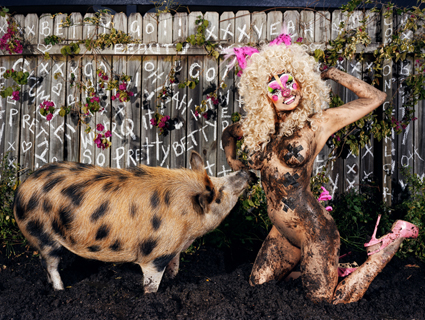
Dean Tirkot, Betty Grumble, 2013
courtesy the artist
Dean Tirkot, Betty Grumble, 2013
A number of exhibitions feature a playful use of the photographic medium, highlighting it as a tool for identity construction. At MOP Gallery Dean Tirkot has worked with “gender-ambiguous characters” including Glitta Supernova, Betty Grumble and Dallas Dellaforce. The images are captured on a large format 8×10” Deardoff field camera and are accompanied by texts by Welsh writer Wil Gritten. (MOP Gallery, May 9-26; http://www.mop.org.au/)
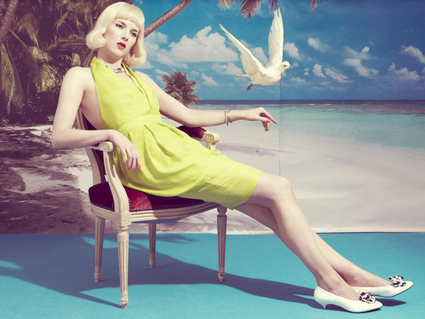
Kourtney Roy, Auto Myths
courtesy the artist
Kourtney Roy, Auto Myths
Canadian artist Kourtney Roy’s Auto Myths are nostalgic reconstructions, a “tragic mythology of the self, a personal universe where the prosaic is pervaded with the marvelous and strange” (website). Think Cindy Sherman meets Sophie Calle. (Customs House, Level 2 Library, May 15-July 15; http://www.cityofsydney.nsw.gov.au/explore/libraries/branches/customs-house-library)
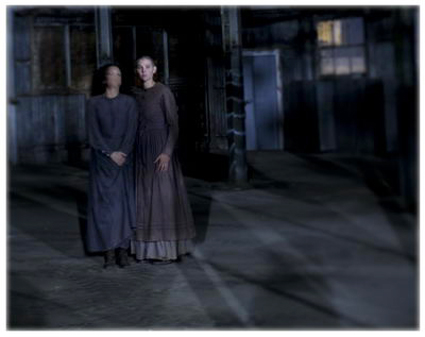
Cordelia Beresford, Presence
courtesy the artist
Cordelia Beresford, Presence
At Gaffa Gallery, filmmaker Cordelia Beresford continues her investigation of haunted spaces with Presence (see RT100). These photographs re-create imagined inhabitations of spaces such as a farm in Normandy used to house WWII prisoners and the reform school for girls on Sydney’s Cockatoo Island. (Gaffa Creative Precinct, May 30-June 8; http://www.gaffa.com.au/)
lo-tech
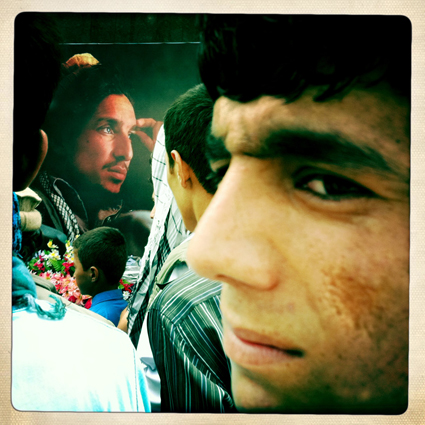
Ben Lowry, iAfghanistan
courtesy the artist
Ben Lowry, iAfghanistan
New developments in technology mean that everyone identifies as a photographer. Rather than fighting it some professionals are embracing the new democratising methods and testing their limits. In iAfghanistan, New York photographer Ben Lowry uses mobile phones and the free online Instagram App to explore life in Afghanistan. (State Library of NSW, Macquarie St. Foyer, April 28- July 27; http://www.sl.nsw.gov.au/)
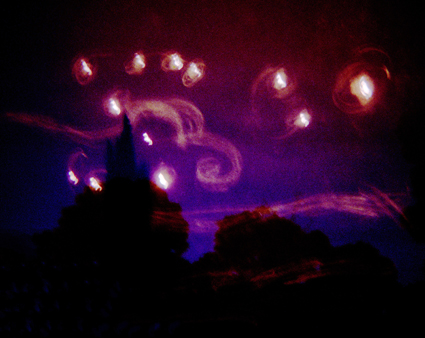
Tim Hixson, Starry starry night, Ludlites Love Music
courtesy the artist
Tim Hixson, Starry starry night, Ludlites Love Music
In the group exhibition Ludlites Love Music, artists such as Patrick Boland, Heleana Genaus and Steve Godbee use plastic cameras to create images inspired by popular song lyrics. (Bondi Pavilion Gallery, May 15-June 23; http://www.waverley.nsw.gov.au/things_to_do/arts_and_culture/gallery)
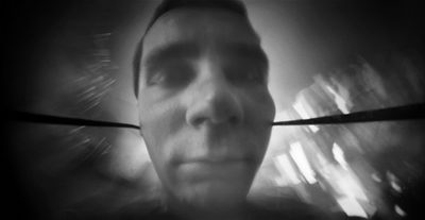
Jaroslaw Klups (2010), Pinhole Photo, Ghost Machine
courtesy the artist
Jaroslaw Klups (2010), Pinhole Photo, Ghost Machine
Taking an opposite approach, Ghosting Machine is a group exhibition featuring Australian and international artists, including Bronwyn Rennex, Aaron Seeto, Katthy Cavaliere and Jaroslaw Klups (Pol) presenting works made using 19th century techniques such as daguerreotypes, wet collodion prints and cyanotypes to create other worldly images. (Delmar Gallery, May 12-June 6; http://www.trinity.nsw.edu.au/4_community/socArts.html)
This is just a taste of the 80 featured exhibitions and 60 associated exhibitions as well as workshops, portfolio reviews and forums.
The best way to tackle the onslaught? Head on!
Head On Photo festival, various venues Sydney, launches May 17; see website for full info http://headon.com.au/
RealTime issue #114 April-May 2013 pg. web
© RealTime ; for permission to reproduce apply to realtime@realtimearts.net
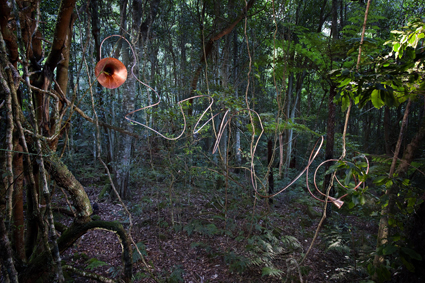
Darragh O’Callaghan, Serosa , Sculpture at Scenic World
photo Keith Maxwell
Darragh O’Callaghan, Serosa , Sculpture at Scenic World
To get down into Jamieson Valley, Katoomba (NSW), you can hike or you can head to Scenic World and experience the vertiginous descent via cable car or the newly refurbished Scenic Railway. Once in the valley you are in a rainforest that dates back to the Jurassic period, which is breathtaking enough, but throughout May you could also experience an impressive sculpture exhibition featuring 35 works installed amid the undergrowth.
The rainforest offers amazing potential as a gallery but also its share of challenges. The artworks have to be transported down into the valley before the ‘doors’ are open to the daily tourist trade. Meanwhile, installing artwork in a World Heritage-listed environment presents its own issues. Exhibition Manager Lizzie Marshall tells me the project aims to have a zero ecological impact which involves minimising soil compression and engaging specialist arborists to suspend works above the forest floor.
Marshall decides on the placement of the works along the walk, describing them as site-responsive rather than site-specific. Since the event is a competition, the works are generally conceived at submission stage; however, each artist may subtly tailor the work to their location. The sites themselves may also undergo change—within a month, trees fall, saplings grow, leaves and bark are shed, altering the composition of the environment. The most intriguing pieces are those that work with elements of their site but also maintain otherness.
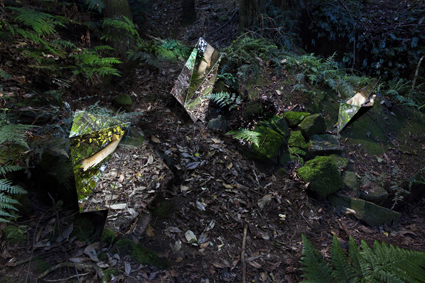
Daneil Kotja, Reflect Phi (a monument), Sculpture at Scenic World
photo Keith Maxwell
Daneil Kotja, Reflect Phi (a monument), Sculpture at Scenic World
The winning sculpture by Blue Mountains artist Daniel Kotja best exemplifies this liminal state. Reflect Phi (a monument) uses the geometrical principle of Phi, which recurs in the growth cycle of plants, as the basis for the work. The sleek, multi-angled objects made from highly polished stainless steel are clearly at odds with the irregular curves of the natural world. However the mirrored surfaces reflect the environment in shifting planes, softening the sharp edges and creating a confounding dimensionality to the object. Via these reflections the sculpture both takes from and gives back to the site.
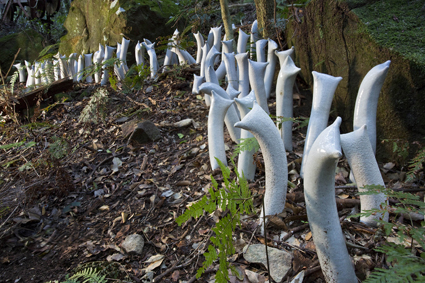
Kimie Kitamura, Get Together!, Sculpture at Scenic World
photo Keith Maxwell
Kimie Kitamura, Get Together!, Sculpture at Scenic World
Kimie Kitamura (NSW) also exploits this otherness with Get Together! Along a ledge, nestled amongst the leaves and short grasses is a collection of off-white porcelain tubes. Without any features their shape hints at cartoonish life forms with limb-like peaks (or are they ears?). Arranged in clumps, they appear to incline towards each other as though communing. Their greyish hue and multiplicity also suggests emerging mushrooms and the teeming micro-life below the soil. Blue Mountains artist Linda Seiffert’s ceramic creation, Undulating Form, also brings to mind the wonders of the fungal world with its interlocked twisting surfaces finished in a dusty, deep ochre, embedded in the humus. This work really looks as though it could have grown here.
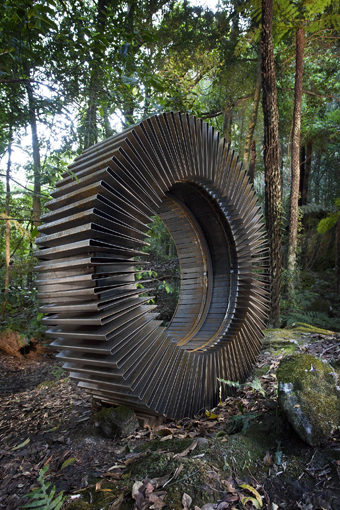
Al Phemister, Kern, Sculpture at Scenic World
photo Keith Maxwell
Al Phemister, Kern, Sculpture at Scenic World
The valley also bears the imprint of industry: chunks of old machinery from old cable cars and mining ventures scattered among the trees. Left Behind, by Penny Philpott (NSW), comprises perfect ceramic replicas of rusty chains lying in piles and snaking off through the undergrowth. Kern, by Al Phemister (NSW), is a large-scale cog made from folded black steel, already bleeding rust. Both are well placed at the end of the walk near the cable station, highlighting the rich layering of the environment—organic, machinic, historic, touristic, artistic.
Now in its second iteration the exhibition also includes a number of media works. A video installation, ex/enclosure, by Blue Mountains’ artist Sarah Breen-Lovett is perhaps the only truly site-specific piece. The artist has filmed light seeping in through the cracks in an old miner’s cottage. These minimal white slashes are flipped vertically and projected back onto the hearth of the hut. While relatively simple, it’s a conceptually complete use of the space. Another development this year is Sculpture Otherwise, a small exhibition in the tourist centre of maquettes and samples which show sculptural detailing close-up.
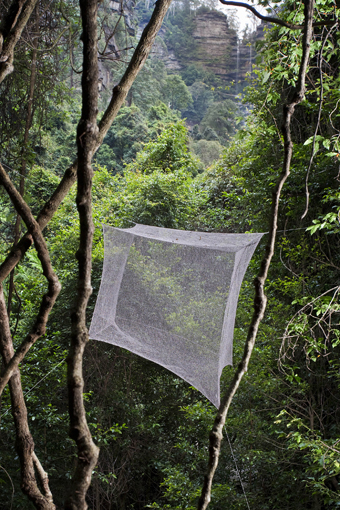
Greer Taylor, resting place, Sculpture at Scenic World
photo Keith Maxwell
Greer Taylor, resting place, Sculpture at Scenic World
Exhibiting 35 outdoor sculptures in such a complex and ever changing environment is certainly an impressive feat. What is most striking is how, by careful site-choices, the works draw you further into the natural environment. The twist of copper tubing in Irish artist Darragh O’Callaghan’s Serosa reflects the tangled root structures of the trees around it. The fringes of Victorian artist Kallie Turner’s Josephus, an intricate “forest keepers” garment, alerts you to the curtains of shredded bark up above. NSW artist Greer Taylor’s Resting Place, a suspended trapezoid of hand-knitted copper wire, intensifies the shifting shafts of light through the canopy. In this way the exhibition is particularly successful in its integration of the human-crafted object and the organic environment. And indeed it succeeds in the more pragmatic integration of art and tourism as well.
Sculpture at Scenic World, exhibition manager Lizzy Marshall, Katoomba, April 24-May 19, http://www.scenicworld.com.au/experiences/sculpture/
Gail Priest was a guest of Scenic World and the Carrington Hotel, Katoomba.
This article originally appeared in RT’s online May15 e-dition
RealTime issue #115 June-July 2013 pg. 56
© Gail Priest; for permission to reproduce apply to realtime@realtimearts.net
The micro and macrocosm of human interaction; imagined landscapes, invented instruments; and the sulphurous whiff of network magic in the air…
moving image i, critical path artists’ salon
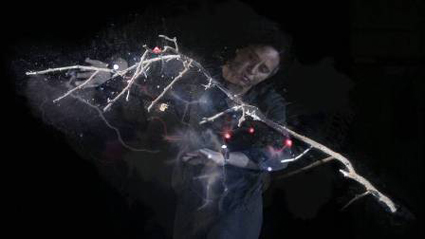
Sam James, From the Rainforest Mind to the Desert Mind featuring dancer Victoria Hunt (video still)
courtesy the artist
Sam James, From the Rainforest Mind to the Desert Mind featuring dancer Victoria Hunt (video still)
Over 2013 Critical Path will be hosting a series of salons comprising artist presentations and discussions. The first of these, curated by choreographer/filmmakers Narelle Benjamin and Sue Healey, promises “experiments with movement within interdisciplinary practice” (website). It includes a multi-screen 3D video installation by Sam James, From the Rainforest Mind to the Desert Mind, featuring dancer Victoria Hunt; and a performative remake of Guy Sherwin’s 1976 Man with Mirror (in which he interacted live with his onscreen image) by Louise Curham and Lucas Ilhein re-titled (Wo)man with Mirror.
Moving Image I, Critical Path, Sydney, May 11, 4pm (open studio from 3pm); http://moving-image1-2013.eventbrite.com/
direct democracy, muma
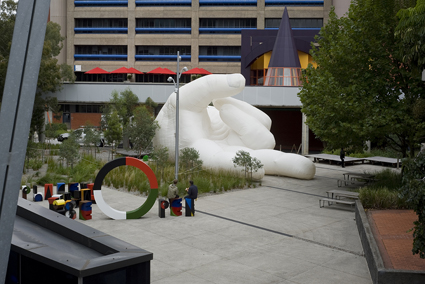
Carl Scrase, The Generative Power of Opposites (2009)
courtesy the artist
Carl Scrase, The Generative Power of Opposites (2009)
Direct Democracy reflects on recent eruptions of people power such as the Arab Spring and the Occupy movement. Curated by Geraldine Barlow it includes 20 international and Australian artists such as video artist Natalie Bookchin (USA), curious object creator Will French (AUS) and the collaborative action project A Centre For Everything. There are also workshops such as collaborative drawing using the DAMP Collective’s giant pencil and forums including a look at the student protests at Monash in the 1960s. You’ll know that you’re close to the gallery when you spy Carl Scrase’s giant inflatable hand—you can decide whether it’s giving you a peace sign or an “up yours.”
Monash University Museum of Art, until July 6; http://www.monash.edu.au/muma/exhibitions/upcoming/direct-democracy.html
bloom—space, aeaf
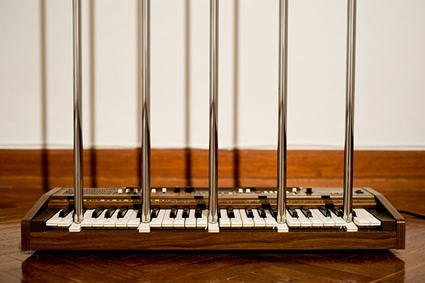
Julian Day, twinversion: Lovers (detail), 2012, dimensions variable
photo Emily Sandrussi
Julian Day, twinversion: Lovers (detail), 2012, dimensions variable
While Direct Democracy looks at the big picture of human interaction, the next exhibition at AEAF looks at intimate exchanges, mainly between objects. Curated by Adele Sliuzas, the works include a growing field of grass by Carla Liesch, a pair of keyboards physically locked in a drone dual by Julian Day, objects in curious inter-relations by Roy Ananda and Will French and video work by Lisa Harms.
Australian Experimental Art Foundation, Adelaide, until June 1; http://aeaf.org.au/exhibitions/21_bloomspace.html
undone, arts house
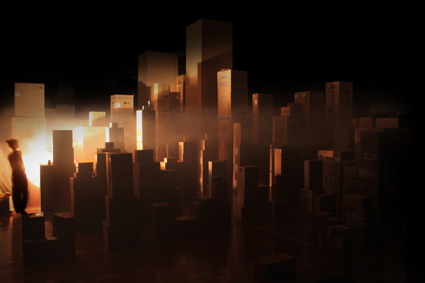
Lara Tumak, Before I Fell Asleep
courtesy the artist
Lara Tumak, Before I Fell Asleep
Last loop we highlighted Metro Arts Friday Night program which opens the rehearsal room doors to reveal the creative processes taking place in the building. This week it’s Arts House’s turn to bare all with their Undone program. Arts House invests significantly in the creative development of projects, in particular through its CultureLAB program. For one afternoon audiences can catch glimpses of potentially full-scale productions. Artists include Natalie Abbott, Angus Cerini, Mish Grigor, Deborah Leiser-Moore, Brian Lipson and David Woods, Tamara Saulwick and Lara Tumak.
Arts House, Meat Market & North Melbourne Town Hall, May 11, 12-6pm; http://www.artshouse.com.au
paul dresher, double duo?
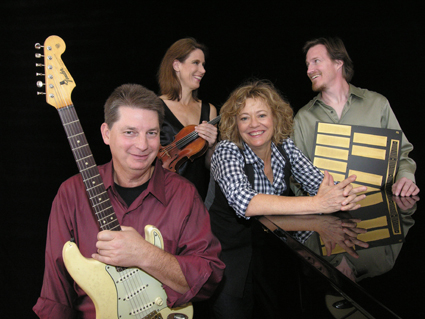
Double Duo
photo Nina Roberts
Double Duo
The music of US composer Paul Dresher incorporates West Coast Minimalism with Northern Indian and Balinese influences. To fulfill his compositional needs he has invented his own instruments. The Quadrachord is a long stringed instrument that can be bowed, plucked and hit. The Marimba Lumina is an electronic percussion instrument. (See these instruments in action here.) He will present two concerts in Sydney with his group Double Duo—Dresher, Joel Davel, Karen Bentley Pollick and?Lisa Moore—performing his own compositions along with works by John Adams and Martin Bresnick.
Music Workshop, Sydney Conservatorium of Music, Sydney May 9, http://www.cityrecitalhall.com/events/id/1447/Paul-Dresher-Double-Duo/; Campbelltown Arts Centre, May 11, 8pm, www.campbelltownartscentre.com.au
film real—black screen, nfsa & footscray arts centre
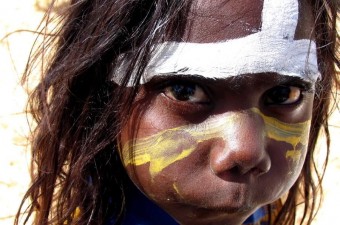
Our Generation, Sinem Saban & Damien Curtis, Black Screen, National Film & Sound Archive
The National Film and Sound Archive’s Black Screen Initiative offers DVDs of contemporary Australian Aboriginal features, documentaries and shorts to individuals and organisations for public screenings. As part of their Film Real series Footscray Arts Centre will be screening the documentary Our Generation (Sinem Saban & Damien Curtis, 2010) which looks at the plight of the Yolgnu people in the Northern Territory whose human rights have been eroded by white governance.
Film Real, Black Screen, Our Generation, Footscay Arts Centre, May 14, 6.30pm; http://footscrayarts.com/access-blog-event/film-real-black-screen-may/; http://www.ourgeneration.org.au/
peter dailey, apparition: the syndicate ii, fremantle arts centre
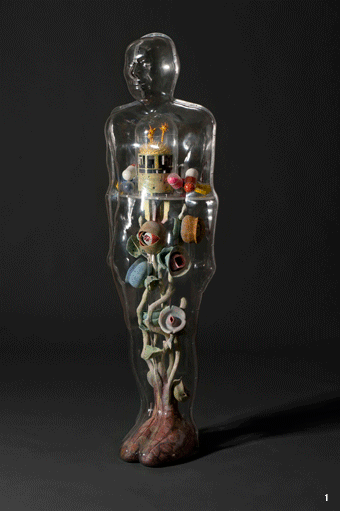
Peter Dailey, Apparition (2013): 1) Alchemist, collection of Ron and Sandra Wise; 2) Ruminate, collection of Jan Spriggs and Perry Sandow; 3) Meek, collection of Graham and Vicki Teede; 4) Abnegate, collection of Jan Spriggs and Perry Sandow
photo Eva Fernandez
Peter Dailey, Apparition (2013): 1) Alchemist, collection of Ron and Sandra Wise; 2) Ruminate, collection of Jan Spriggs and Perry Sandow; 3) Meek, collection of Graham and Vicki Teede; 4) Abnegate, collection of Jan Spriggs and Perry Sandow
The Syndicate is an innovative philanthropic project initiated by art patron Lloyd Horn in which a group of collectors supports an artist for two years enabling them to create a body of work. The second artist commissioned by the Syndicate is Peter Dailey who has created Apparition, a series of 10 life-size human figures that evoke the “cultural, economic, political and environmental mechanisms” involved in being human (website). The Apparition is currently on show at the Fremantle Arts Centre.
Peter Dailey, Apparition: The Syndicate II, Fremantle Arts Centre until June 2; http://fac.org.au/events/288/peter-dailey-apparition-the-syndicate-ii?mid=12
networked art forms & tactical magick faerie circuits, cast
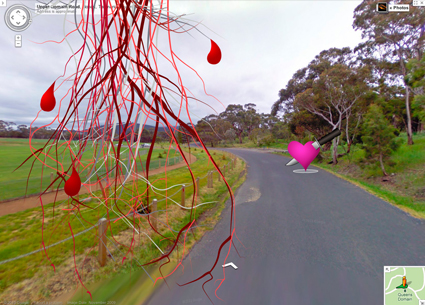
Linda Dement, KILL FIX
courtesy the artist
Linda Dement, KILL FIX
The ISEA13 media art lovefest is not just concentrated in Sydney. Networked Art Forms & Tactical Magick Faerie Circuits is a satellite event in Hobart’s CAST as part of DARKMOFO, developed by Miss Despoinas (a hacker space headed by Nancy Mauro-Flude). The event focuses on “maker” cultures adopting “a radical holistic approach to digital culture” (press release). There will be a three-day feast of workshops, talks and forums (May 31-June 2) with resulting ideas developing into a series of events June 3-30. Participating artists include Linda Dement (AUS), Francesca da Rimini (AUS), Mez Breeze (AUS), Florian Cramer (GER/NL) and Julian Oliver (NZ/GER). (See our in the loop opportunities page for workshop details).
Networked Art Forms & Tactical Magick Faerie Circuits, CAST, Hobart, May 31-June 30;” http://tacticalmagick.net/
conduit arts space initiative
Artist-led space Conduit Arts, a shopfront in Fitzroy, has a rather novel programming structure. For one month it focuses on visual arts, the next on music and performance, and in May it’s music’s turn. There will be a whopping 15 performances over a month of improvised and experimental music and poetry with artists such as Dale Gorfinkel, Robie Aveniam, Simon Charles, Jessica Wilkinson, Ida Duelund-Hansen, Mark Cauvin and Matthias Schack-Arnott.
May Music & Performance Program, Conduit Arts Initiative, Fitzroy, full program http://conduitarts.wix.com/conduitarts#!program-music/ch3c
diffuse, uts
Produced by Jon Drummond in association with the Sound and Music Design course at UTS, Diffuse is a program of music performances in May and June. The first concert focuses on spatial diffusion and will see Isobel hemisphere speakers used in the Bon Marche for the first time. Performers across the series include Zane Banks & Benjamin Carey, Julian Day, Daniel Blinkhorn, Michael Atherton & Jon Drummond, Alon Asar, Roger Mills, Peter Hollo, Gail Priest and David Miller.
Diffuse, May 9, 23 & June 6, Bone Marche Studio, UTS; http://diffuse2013.wordpress.com/
still in the loop
opal vapour, jade dewi tyas tunggal, mobile states
Adelaide, Perth, Hobart, Cairns, McKay, Brisbane, Canberra, Blacktown
May-June, see website for details http://performinglines.org.au/productions/opal-vapour/; http://opalvapour.com.au/
more…
gemeinboeck & saunders, velonaki, ingram, artspace
ISEA satellite exhibition, May 2-June 16 http://www.artspace.org.au/gallery_upcoming.php
more…
composition to movement festival, creative practice lab, unsw
May 24-26, part of Vivid Sydney
http://sam.arts.unsw.edu.au/c2m
more…
eve and eve, rebecca agnew, 24hr art
until June1
http://www.24hrart.org.au/
more…
living in the ruins of the 21st century, uts gallery
until May 17
http://livingintheruins.net; http://www.art.uts.edu.au/gallery/current/current.html
more…
hatched: national graduate show 2013, pica
until June 9, Digital Now, May 8
http://www.pica.org.au/
more…
natalie abbott, physical fractals, pact
Until May 10
http://www.pact.net.au/2013/04/month-of-dance/
more…
no child, nilaja sun, theatre works
until May 26
http://www.theatreworks.org.au/whatson/event/?id=136
more…
shadowlife, bendigo art gallery
until July 28 http://www.bendigoartgallery.com.au/Exhibitions/Current_Exhibitions/Shadowlife
more…
uta uber kool ja, army of love, judith wright centre
May 8-18
http://judithwrightcentre.com/event/uta_uber_kool_ja
more…
RealTime issue #114 April-May 2013 pg. web
© RealTime ; for permission to reproduce apply to realtime@realtimearts.net
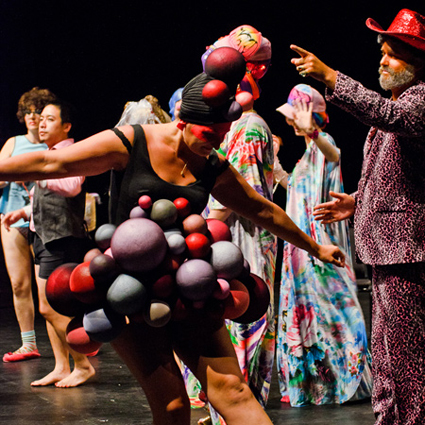
Stephen Cummins Bequest
photo Lucy Parakhina
Stephen Cummins Bequest
stephen cummins bequest residencies, performance space
The Stephen Cummins Bequest offers three emerging artists involved in queer performance a one-week intensive residency at Performance Space. The emphasis is on dramaturgical development within their practice with each artist working with a mentor. The residencies will take place in July with mentors Martin del Amo, Chris Ryan and Victoria Spence.
Applications close June 3; http://www.performancespace.com.au/2013/stephen-cummins-2013-callout-queer-artists/
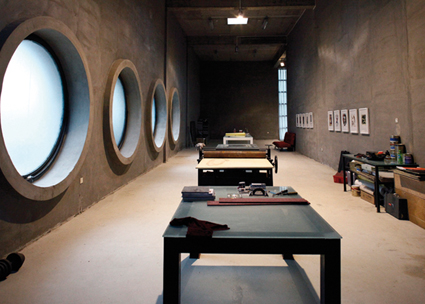
Shen Shaomin Studios, Beijing
beijing residency, 4a centre for contemporary asian art
Expressions of interest are now open for early career artists to apply for a one-month residency in the studios of renowned Chinese Australian artist Shen Shaomin (http://www.shenshaomin.com/). A project of 4a, the residency offers the opportunity to “research new projects in rich cultural surroundings, build networks and observe the changes taking place in one of the most important cities in the Asia region” (press release). The three successful applicants must be available to undertake the residency in September 2013.
Deadline May 31; http://www.4a.com.au/4a-beijing-residency-program/
the sustainability of future bodies workshop series, isea2013
As part of ISEA13 Critical Path is offering a series of workshops exploring the intersection between media and the body. Garth Paine will run a Motion Capture Open Lab (June 15-16); Paul Gazzola will explore The Dancing Body of the Future, Pt II, (June 18- 20); and in Writing, visiting French choreographer Myriam Gourfink will introduce her training and digital scoring methods. Ten NSW choreographers will receive an honorarium to attend.
Applications due May 20: Apply online www.surveymonkey.com/s/ISEA13-CP-workshop-series
workshops, networked art forms & tactical magick faerie circuits, cast
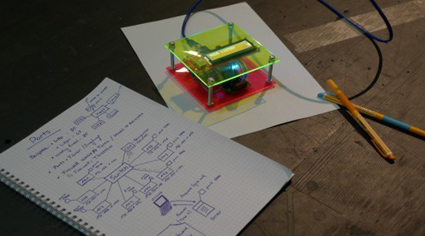
weise7.org
In Hobart, the Networked Art Forms… festival (see quick picks) includes two intriguing hands-on workshops. Hacker masters Julian Oliver (NZ/GER) and Danja Vasiliev (RUS/GER) will run a Networkshop (May 31- June 2) which will bring the communication tools of the digital age back under the user’s control recreating a small-scale version of the internet. Anne Goldeberg (FRA/CAN) and Karine Rathle (CAN) will run Attent!ion Som(t)a(c)tic (June 5-8) to examine participants’ physical relationship with their communication tools and “explore avenues of creative empowerment by suggesting techno-humanist thematic improvisations” (press release). The workshop will culminate in a multimedia installation and performance.
More info http://tacticalmagick.net/workshops
backbone 2high festival 2013
The annual 2High Festival in Brisbane not only supports emerging artists but also emerging producers. The festival is looking for keen young things (18-26) who are interested in becoming part of the team that makes this multi-disciplinary event happen. The festival will take place Nov 2 at the Brisbane Powerhouse.
Deadline May 17; http://www.backbone.org.au/2high-festival.cfm
call for scores, campbelltown city council
Submissions are invited for musical compositions written for a single percussion instrument or “defined group of instruments originating from the same family” (website). Successful compositions will be premiered by leading percussionist Claire Edwardes at Campbelltown Arts Centre in November.
Deadline for submissions July 1; www.campbelltown.nsw.gov.au/CallforScore
still in the loop
the 2013 hive production fund
Deadline May 13
more info http://www.adelaidefilmfestival.org/default.asp?contentID=353
More…
proximity festival 2013
Deadline May 17
http://proximityfestival.com/
More…
travel fellowship, revelation, perth
Deadline 24 May
http://www.revelationfilmfest.org/go/travel/travel-fellowship
More…
arts house season 1, 2014
Deadline May 31
www.melbourne.vic.gov.au/ArtsHouse/fundinggrants/Pages/Fundingandgrants.aspx
More…
channels video art festival
Deadline June 1
More info www.channelsfestival.net.au/
More…
selected australia council grant deadlines
(for full list see http://www.australiacouncil.gov.au/grants)
Literature, due May 15
• New Work – Digital and New Media,
http://www.australiacouncil.gov.au/grants/2013/literature-new-work-digital-and-new-media
Community Partnerships, due May 24
• Career Pathways – Professional Development
http://www.australiacouncil.gov.au/grants/2013/community-partnerships-career-pathways-professional-development-24-may
• Career Pathways – Fellowships
http://www.australiacouncil.gov.au/grants/2013/community-partnerships-career-pathways-fellowships
• Creative Producer
http://www.australiacouncil.gov.au/grants/2013/community-partnerships-creative-producer
• Projects
http://www.australiacouncil.gov.au/grants/2013/community-partnerships-projects-24-may
• Projects with Public Outcomes
http://www.australiacouncil.gov.au/grants/2013/community-partnerships-projects-with-public-outcomes-24-may
Visual Arts, due May 27
• Australia Council Visual Arts Laureate Award and Medal
http://www.australiacouncil.gov.au/grants/2013/visual-arts-laureate
• Creative Australia – New Work
http://www.australiacouncil.gov.au/grants/2013/creative-australia-new-work
Market Development, due May 31
• Visions of Australia and Contemporary Touring Initiative
http://www.australiacouncil.gov.au/grants/2013/visions-of-australia-and-contemporary-touring-initiative
• Playing Australia
http://www.australiacouncil.gov.au/grants/2013/playing-australia-31-may
RealTime issue #114 April-May 2013 pg. web
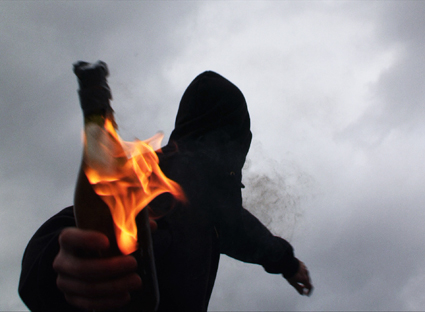
Informant
IF A HUMAN RIGHTS FILM FESTIVAL BRINGS TO MIND IMAGES OF PO-FACED, POORLY MADE ACTIVIST VIDEOS THEN THINK AGAIN.
Evolving from humble beginnings in 2007, the Human Rights Arts and Film Festival now profiles some of the most innovative documentaries from around the globe, along with a sprinkling of equally provocative dramas and exhibitions. On the eve of the festival’s sixth edition, Dan Edwards talked with programming manager Sari Braithwaite about her curatorial philosophy, and the sticky role of the arts in human rights debates.
First I’d like to ask what you see as the relationship between art and human rights? The relationship between them is not necessarily obvious.
The problem with human rights, particularly for Australians, is that they can often come across as common sense and be taken for granted. They can seem simple and not worthy of interrogation. That’s where the arts can come in and play with those ideas, let them be interrogated through storytelling and complicated by the everyday. Which is exactly what human rights discourse needs—it needs to be robust and fluid and people need to be part of the conversation, otherwise those rights run the risk of being taken for granted and not protected. So we are all about creating conversations and debate…a festival that has to balance issues with really great, innovative filmmaking. But the filmmaking really has to stand out, otherwise you lose people’s attention to the issue.
One of the things I found interesting about last year’s program was that documentaries like Planet of Snail, about a blind Korean writer, were wonderful films, but did not necessarily talk about human rights in an obvious or explicit way. How do you go about choosing films specifically for this festival?
What I loved about Planet of Snail (Seungjun Yi, Finland, Japan, South Korea, 2011) was that it was a beautiful story. By knowing these people you have insight into a disability that you don’t usually get—that’s the core right there. When you’re talking about human rights it’s not a particularly good idea to ram issues down people’s throats and to make the world seem hard, or problems seem unsolvable. It’s really important to show stories where people are empowered, where you see resilience, courage and ingenuity. Hopefully audiences walk out of the cinema and have a discussion, or maybe a fight about the film, then three months later maybe they have another discussion. That’s the kind of programming I really like to see happen. That’s why we put a large emphasis on guests, forums and post-screening events. People go in, see a film and they want dialogue.
So what do you think distinguishes HRAFF from something like the Antenna Documentary Festival in Sydney, or the big festivals like MIFF?
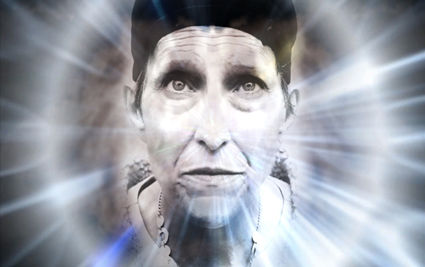
Walk Away Renee
I think HRAFF is a really good opportunity to reframe films—something like Planet of Snail is a good example—that you might not normally consider in the human rights context. This year we have Jonathan Caouette’s Walk Away Renee (USA/France, 2012), which is his follow-up to Tarnation (US, 2003). So much discussion about Jonathan Caouette focuses on how he plays with form, about how he was a first generation i-movie superstar filmmaker. But actually the relationship with his [mentally ill] mother in those films is really important and interesting in a human rights context. So we’re using Walk Away Renee to explore mental health, along with complex questions about representing mental illness on screen.
Although you feature some dramas, most of the films in the festival are documentaries. Is that a deliberate choice?
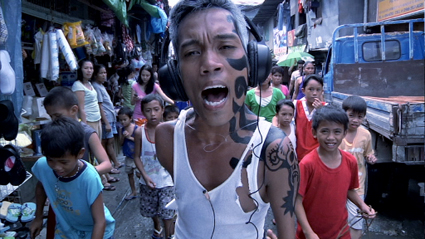
Mondomanila
Documentaries can be really powerful in exploring issues while telling a good story, but it’s also about what documentary filmmakers are interested in, because so many come from a social justice point of view. But as soon as there is an interesting narrative then I’m all for it. We’ve got Mondomanila (Khavn De La Cruz, Philippines, 2012) which is in exploitation film style—totally new territory for HRAFF, and really pushing our audience to think about what a human rights film is. It’s divisive, but it’s also really exciting to have those types of works in the program.
If you were asked to choose two or three films to see in this year’s program, what would you recommend?
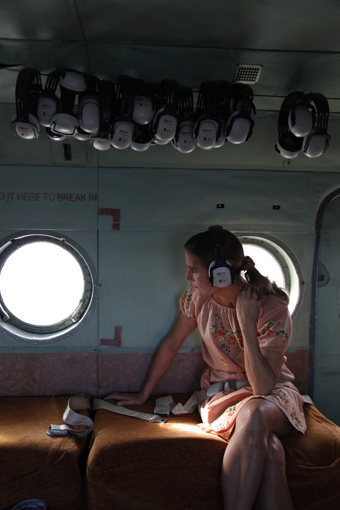
Alias Ruby Blade
The opening and closing night films this year are really special, and again there will be events around them. Alias Ruby Blade (Alex Meillier USA/Australia, 2012) is about Kirsty Sword, the young Melbourne woman who went to East Timor in the 90s, became part of the clandestine rebel movement there and started a relationship with Xanana Gusmão while he was in prison. So that’s a really great one for Australian audiences, because it connects us so closely with our nearest neighbours. For closing night, In the Shadow of the Sun (Harry Freeland, UK, 2012) is a really beautiful film about Josephat Torner—a man from Tanzania with albinism who travels the country trying to confront deep superstitions after a wave of murders of albinos.
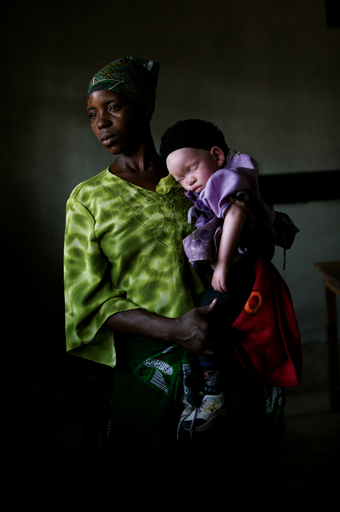
In the Shadow of the Sun
My narrative highlight has to be My Brother the Devil (UK, 2012), a coming-of-age story about two brothers living in the Hackney housing estate, from a first time British writer-director Sally El Hosaini. For documentary lovers, Informant (Jamie Meltzer, USA, 2012) is a really innovative exploration of how a leftist activist turned to work for the FBI. I’m also very proud of our Australian Shorts program, which showcases the astounding Silent Night (Best Film, Cockatoo Island Film festival, 2012, Margaret Lawrence Social Justice Award), a film about sexual assault by local filmmaker Bec Kingma.
It’s a diverse program. I think it’s really important in a human rights film festival to make people laugh and to feel a sense of joy and hope. It’s about showing what’s amazing, resilient and special about people in really tough situations—not just as victims, because then everyone’s disempowered, and I don’t think that’s what art is for. Art can help you re-frame and see things in different ways, and that’s exactly why HRAFF is so useful and important.
The Human Rights Arts and Film Festival, Australian Centre for the Moving Image, Melbourne, 9-23 May, http://hraff.org.au.
A selection of films will tour Sydney, Canberra, Perth, Brisbane and Alice Springs during May-June, see http://hraff.org.au for city programs.
RealTime issue #114 April-May 2013 pg. web
© Dan Edwards; for permission to reproduce apply to realtime@realtimearts.net
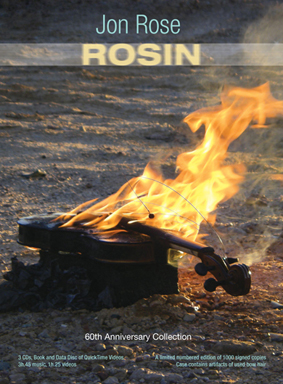 CD review
CD review
ReR (ReRJR60)
www.rermegacorp.com
Jon Rose has done much with and to the violin, and upon hearing this CD a great deal more than you might have ever imagined. For listeners unfamiliar with his music, Rose’s new CD opens a door to his unique engagement with the instrument and with sound and its place in our world. For those who love his work it is a collector’s item.
Rosin (the CD is named after the stuff you rub on the bow to change its texture and enrich the sound of the violin strings) comprises CDs, a disc of videos and a booklet discussing the selected works with testimonies by David Harrington, Richard Barrett and others on the nature and immensity of Rose’s contribution to music. Subtitled “A 60th Anniversary Collection,” it was released shortly after this milestone birthday and with three hours 45 minutes of music and an hour and 25 minutes of visual material, it’s an excellent introduction to his recent work. Presumably it’s a personal retrospective, emphasising favourite developments. Though less comprehensive than his webpage, it focuses on specific projects: his Pannikin series of recordings of people making all kinds of sound (a subset of the ABC’s Australia Ad Lib series), his fence-playing, his electronic interventions into the violin and his ball-games and bicycle series.
Rose’s work questions our assumptions not only about music, sound and performance but about the world in which we live. His Garage Fence project, in which he set up four fences like a boxing ring, to be played on stage by Kronos Quartet, is about more than just making fencing-wire vibrate interestingly (though he is always looking for objects that make interesting sounds). Miking a fence for sound interrogates its resonant properties and reveals its metaphorical harmonics. For example when he plays the Dingo Fence he draws our attention to its environmental significance and to the concepts of containment and border. Turning a fence into a musical instrument disrupts its emblematic power. He has performed at the USA-Mexico border and the Separation Fence in the Israeli Occupied Territories, challenging their authority. He engages with the outback—Oodnadatta, the Strzelecki Desert, Wogarno Station—as a mystical, alien, forbidding, even sacred world. Rose is a philosopher and social commentator and his philosophical investigations often start as musical or sonic ones.
Rose encourages people to make sound and one of his most important endeavours, collecting home-made sounds, is given due attention on the CD. There are samples from the Pannikin Project, in which Rose invited do-it-yourself musicians to demonstrate their work and remixed it with his own accompaniment—for example recordings of a shopkeeper repeatedly singing “Thank you very much,” gum-leaf players mimicking bird calls, a whip-cracker, an auctioneer in full cry, a chainsaw orchestra (protesting against logging) and the only department store pianist still working. The Pannikin Project redefines musical performance and acknowledges under-recognised aspects of our culture. Rose’s attitude to sound is highly democratic—anyone can (and should) participate; there’s no distinction between high and low art, and it’s fun!
Rosin includes an excerpt from his radio documentary Syd and George about a lyrebird, with string accompaniment suggesting the kinds of sounds naturally made by the bird, highlighting the concepts of mimicry and sonic representation. We anthropomorphise the lyrebird as a musician, but ironically it is itself a recorder that reproduces samples of sounds it has heard.
There are selections from Rose’s musical performances involving combinations of improvised and notated sound for various ensembles. The high-powered concerto Internal Combustion is scored for improvised violin (dazzlingly played, including fragmentary quotes from Tchaikovsky) and an ensemble playing from a detailed, conventionally notated score, challenging the conventions of concerto composition and performance. There is an excerpt from Charlie’s Whiskers, commissioned from Rose by Slovakian composer Daniel Matej, in which Rose creates competing musical palindromes to pay homage to Charles Ives’ approach to composition. (See RT112 for other Rose/Matej collaborations)
Digger Music is scored for an excavator whose movements are electronically mapped to generate signals that are blended with other sounds including improvised violin. Talking Back to Media, a variant on talk-back radio, employs musicians, a poet and a sound artist and includes samples of horse-race commentary. Multiple competing sound sources represent inner and outer reality—this piece is sonically complex, musical and fascinating.
RRose experiments endlessly with the violin: Violin 3D Model uses a ‘K bow,’ electronically engineered to enable control of sonic output through angle, stroke length and other parameters. In Palimpolin (the title condenses ‘palimpsest’ and ‘violin’), he again uses a modified bow to control sampling, pitch shifting and mediation of the final sound. Such an instrument offers a single performer a sound palette of orchestral proportions. Then there is his Viocycle, a bicycle rigged so that, when moving, it drives a mechanism that engages the strings of a violin mounted to the frame, like a mobile hurdy-gurdy—the player controls the sound by riding at different speeds. Imagine a peloton orchestra!
The CD is well produced and, strangely, CD2 and 3 conclude with an extra track not cited in the booklet, provoking intense curiosity. The secret track on CD2 sounds like a modified cello wonderfully played. The CD3 mystery track is an absorbing melange of amplified, mediated instruments and objects.
On the disc of QuickTime videos is a sample of Rose’s Ball Project which introduces his experiments with volleyballs, rugby-balls and the like to generate sound, thus engaging with society’s obsession with ball-sports and extending his audience for sonic experimentation. Rose fits the balls with sensors that, when in play, send signals to computers that produce audio-visual material, linking the resulting sounds with the player’s actions and shifting the emphasis from winning to music-making. The video on this CD is of a concert audience tossing around a giant beach-ball and enjoying the noises they generate, the ball-game inducing collective activity and awareness.
Most significantly, there is a video of Jon Rose burning to ash a closely-miked violin, an apparently iconoclastic act, perhaps even a strange ritual of renewal. This unique sight and sound of a violin’s cremation is romantically set in the outback at dusk. In fact, there can be no more committed, inventive or insightful experimental composer, sound artist, musician and philosopher of music than Jon Rose, and his impact is worldwide. He continually challenges us and draws us into a world of sound that turns out not only to be accessible but fun and a stimulus to our own creative exploration. While his work betrays the highest level of musicianship, it tells us to listen more attentively to the world and to think more deeply about what sound and music are and what they mean to us.
Chris Reid
Many of Jon Rose's projects are documented here http://www.jonroseweb.com
See Jon Rose in conversation with Jim Denley in our RealTime TV interview
RealTime issue #115 June-July 2013 pg. 46
© Chris Reid; for permission to reproduce apply to realtime@realtimearts.net
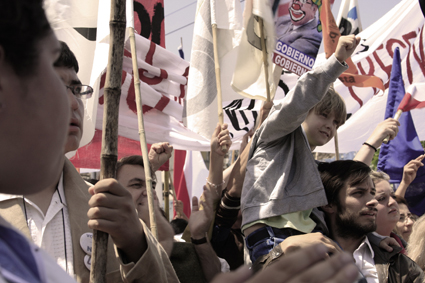
No
courtesy Rialto Distribution
No
Can TV advertising be a force for positive change? The question is seemingly answered in the affirmative in Pablo Larrain’s No.
No is a docudrama set in 1988, when the Chilean people were invited to choose whether free elections would be held or whether the Pinochet dictatorship would stay in power for eight more years (the No of the title indicating a no vote to more Pinochet). As Larrain indicates, the vote was initially seen as a charade, but the authorities soon found themselves with a real fight on their hands.
Like many comparable Australian productions—from Newsfront (1978) to Balibo (2009)—No interweaves archival footage with supposed glimpses “behind the scenes.” Gael Garcia Bernal plays the youthful, skateboard-riding advertising hotshot René Saavedra, who reluctantly agrees to join the “No” campaign, a coalition of progressive groups permitted to broadcast for 15 minutes each day.
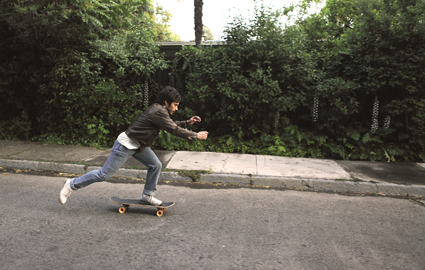
Gael Garcia Bernal, No
courtesy Rialto Distribution
Gael Garcia Bernal, No
Though barely political, René is a man in tune with the times: in the opening sequence we see him proudly unveiling his latest American-style soft drink commercial, where close-ups of the product alternate with images of a clean-cut pop singer performing to an ecstatic crowd. His “No” campaign relies on the same aesthetic, favouring abstract euphoria—street parties, picnicking families, inexplicable mimes—rather than depressing torture statistics or statements from relatives of the disappeared. René’s activist wife (Antonia Zegers) is baffled by the approach. “Who are all these people laughing, celebrating, singing?” she wonders. “What country are you dreaming of?”
Essentially a satirist, Larrain shares some of this scepticism toward pop culture. The fundamentals of advertising may not have changed a quarter-century on, but even the most naïve viewer is liable to regard the clips from the “No” campaign—genuine period pieces, fictionally attributed to René—as dated and naff.
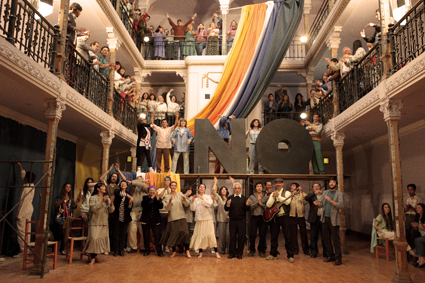
No
courtesy Rialto Distribution
No
The “Yes” advertisements of the government depend on a more traditional, monumental species of kitsch, appealing to national pride with heroic shots of container ships and the beaming general himself. Advertising, it seems, is a language capable of banalising any message: the fact that this language was pioneered by radical filmmakers—from Eisenstein to Bruce Conner—may be part of Larrain’s ironic point.
Further paradoxes arise from Larrain’s decision to shoot on 1980s U-Matic video, with all its technical limitations: murky colour, blown-out backgrounds, minimal depth of field. Though his pseudo-documentary technique contrasts with the rapid-fire editing of the “No” spots, his aim is to create a seamless transition between the two, placing fake reality on the same level as authentic propaganda.
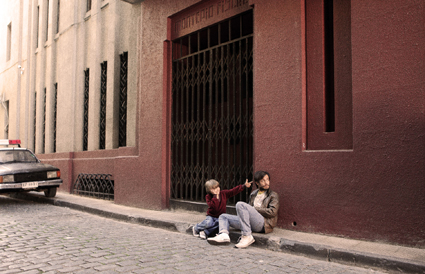
No
courtesy Rialto Distribution
No
Indeed, René is such an elusive, depthless figure he could himself be a character from an ad. In many ways he resembles the CIA agent played by Ben Affleck in Argo (2012): both are technically-minded tricksters, boyish yet reserved, skulking behind their respective beards. Both reveal their humanity chiefly through their love for their young sons, a form of scriptwriting shorthand that smacks of commercial formula: shove a kid in there, and the viewer will have something to really care about.
But though Larrain is not above manipulating his audience, his depiction of admen as heroes still carries an ambiguous subtext. Some kind of tipping point is reached when the “Yes” campaign resorts to parodying its opposition—so that joyous dancers, for example, turn out to be Marxist terrorists in disguise. At this stage, politics appears to have evaporated; what remains is simply a battle between two sets of images, waged in a void.
Much as Argo both celebrates and mocks the American wishful thinking represented by Hollywood, No’s conception of advertising-as-dream is open to varying readings. Chilean audiences might understand the film as a nostalgic evocation of a moment when anything seemed possible; more cynically, the emphasis on marketing as a means of swaying popular opinion might be taken to imply that the hope of democracy in Chile was unreal from the outset.
At home, the film has been criticised for its failure to credit the role played by grassroots activism in drumming up support for the “No” vote. Also skated over is the fact—confirmed in recently declassified documents—that the US government had by this time reversed its earlier positive stance on Pinochet, fearing that resentment of his regime would catalyse the radical left. Not only was financial aid provided for the “No” campaign, but media consultants were dispatched from Washington to assist. Had Larrain chosen to dramatise this scenario, No would be a whole other movie—though it would likely have ended in the same ambivalent way.
No, director Pablo Larrain, Rialto Distribution, in limited national release from April 18; http://au.rialtodistribution.com/no.html
This article originally appeared as part of RT’s Online e-dition May 1, 2013
RealTime issue #115 June-July 2013 pg. 28
© Jake Wilson; for permission to reproduce apply to realtime@realtimearts.net
opal vapour, jade dewi tyas tunggal, mobile states
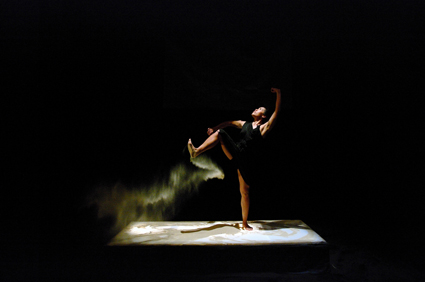
Jade Dewi Tyas Tunggal, Opal Vapour
photo Paula van Beek
Jade Dewi Tyas Tunggal, Opal Vapour
The Mobile States touring alliance continues to join the dots across the country adding new partners every year. First up for 2013, travelling to eight venues—north, south, east and west—is Jade Dewi Tyas Tunggal’s Opal Vapour, a dance and video work made in collaboration with singer/composer Ria Soemardjo and lighting designer Paula van Beek. Opal Vapour has been developed between Australia and Indonesia and explores elements of Javanese Wayang Kulit shadow puppetry and performance rituals.
Mobile States Tour: Vitalstatistix, Adelaide, May 8-12; Perth Institute of Contemporary Arts, May 15-18; Salamanca Arts Centre, Hobart, May 22-25; Centre of Contemporary Arts, Cairns, May 28-29; Mackay Entertainment Centre, May 31-June 1; Visy Theatre, Brisbane Powerhouse, June 5-8; Canberra Street Theatre,?June 14-15; Blacktown Arts Centre,?June 19-22; http://performinglines.org.au/productions/opal-vapour/; http://opalvapour.com.au/
gemeinboeck & saunders, velonaki, ingram, artspace
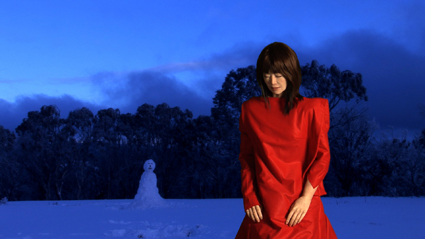
Mari Velonaki, The Woman and the Snowman, 2009-present, production image
courtesy of the artist and Anna Schwartz Gallery
Mari Velonaki, The Woman and the Snowman, 2009-present, production image
As ISEA2013 draws nearer Sydneysiders might find the city increasingly overrun by robots—Artspace’s ISEA-satellite exhibition marks the advent of the invasion. Petra Gemeinboeck and Rob Saunders will literally infest the gallery walls with playfully destructive robots while New Zealand artist Simon Ingram’s robots will engage in repainting it. Mari Velonaki will take a philosophical approach exploring the concept of the ‘uncanny valley,’ [http://en.wikipedia.org/wiki/Uncanny_valley ] pitting one of Professor Hiroshi Ishiguro humanoid robots against a snowman. (See RT111 and RT93.)
ISEA satellite exhibition, Artspace, Sydney, May 2-June 16; http://www.artspace.org.au/gallery_upcoming.php
composition to movement festival, creative practice lab, unsw
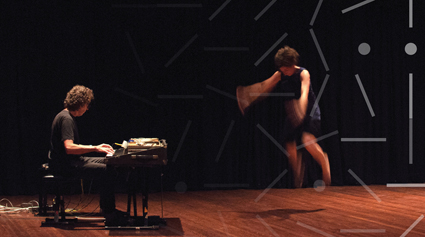
Alister Spence and Nalina Wait, Composition to Movement Festival, Creative Practice Lab, UNSW
photo Paul Matthews
Alister Spence and Nalina Wait, Composition to Movement Festival, Creative Practice Lab, UNSW
As part of Vivid Sydney, the Creative Practice Lab at the University of New South Wales is producing a mini-festival focusing on collaboration, in particular the relationship between dance and music. The three day event includes a key note lecture by Ross Harley (the new Dean of CoFA); a concert by the Australia Ensemble featuring a new collaboration between choreographer Sue Healey and composer John Peterson; a day of workshops in which you can watch the collaborative process in action; and a final presentation of explorations by dancer Nalina Wait with pianist Alister Spence and saxophonist Sandy Evans, and choreographer-dancer Martin del Amo with sound artists Madeleine Flynn and Tim Humphrey.
UNSW: Creative Practice Lab, School of Arts & Media: Composition to Movement Festival, Io Myers Studio, Clancy Auditorium and various UNSW venues, Sydney, May 24-26, part of Vivid Sydney
http://sam.arts.unsw.edu.au/c2m/
eve and eve, rebecca agnew, 24hr art
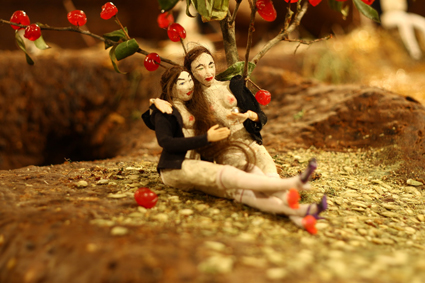
Eve and Eve (video still, 2012) stop-animation
courtesy the artist
Eve and Eve (video still, 2012) stop-animation
In a set constructed from fruitcake and jelly (amongst other things), Rebecca Agnew has created a stop motion animation, Eve and Eve, telling the tale of two women in paradise. There is the inevitable downfall, paradise is lost and somehow a suicide bomber becomes involved. The mysteries of this painstakingly constructed work will be revealed at 24HR Art in an exhibition suite which also includes pieces by Agnieszka Golda & Martin Johnson, Mark Daniel and Gareth Jenkins. Check out Agnew’s website for some captivating images and video clips.
Eve and Eve, Rebecca Agnew, 24HR Art, Darwin, May 3; http://www.24hrart.org.au/
r&j, expressions dance company, national tour
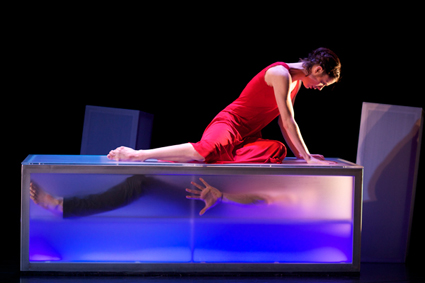
Samantha Mitchell, Jack Ziesing, R&J, Natalie Weir/Expressions Dance Company
photo Fiona Cullen
Samantha Mitchell, Jack Ziesing, R&J, Natalie Weir/Expressions Dance Company
R&J is a re-interpretation of Shakespeare’s famous love story choreographed by Expressions Dance Company director Natalie Weir. After a successful premiere performance in 2011 and a South Australian outing, the show is now in the middle of an 18-venue regional tour of Tasmania, Victoria, New South Wales and Queensland. Weir approaches the tale using three stories set in different eras to convey the universality of the romantic narrative. Music is composed by John Babbage and has been recorded by Topology.
Expressions Dance Company and Queensland Performing Arts Centre: R&J, choreographer Natalie Weir; various venues; April 26-June 8; check website for venue information http://www.expressionsdancecompany.org.au/rj-tour-2013/rj-tour-2013/
living in the ruins of the 21st century, uts gallery
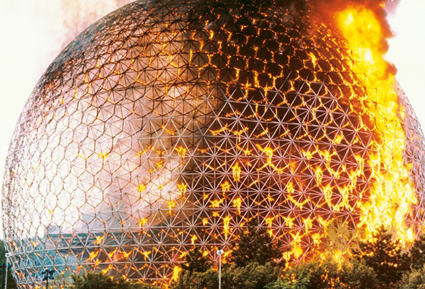
Buckminster Fuller’s Anne’s Taj Mahal on fire, Montreal, 20 May 1976, from Cabinet Issue 32, Fire
Courtesy Cabinet
Buckminster Fuller’s Anne’s Taj Mahal on fire, Montreal, 20 May 1976, from Cabinet Issue 32, Fire
Teaming up with the über cool New York magazine Cabinet, curators Adam Jasper and Holly Williams are presenting a contemporary wunderkammer that draws “together objects from art, science and ethnography in a celebration of the profound and the mundane” (website). The exhibition includes works by over 20 Australian and international artists including Tracey Moffatt, David Haines & Joyce Hinterding, the Institute of Critical Zoologists, Jaki Middleton & David Lawrey and Alex Gawronski as well as objects on loan from The Macleay Museum, MONA and Leipzig’s Stasi Museum. The exhibition will be contextualised by a reading room of Cabinet publications claimed to be the only complete collection in Australia, offering different thematic trajectories through the exhibition.
Living in the ruins of the 21st Century, UTS Gallery, Sydney, until May 17; http://livingintheruins.net; http://www.art.uts.edu.au/gallery/current/current.html
friday nights, metro arts
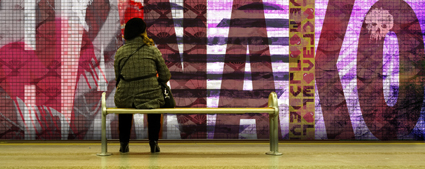
Hanako, Caroline Dunphy, part of Metro Arts May Friday Nights
image SYC Studios
Hanako, Caroline Dunphy, part of Metro Arts May Friday Nights
In Brisbane, Metro Arts’ Friday Night program fully embraces the current cultural focus on audience engagement. Once a month audiences are invited to sample all the creative activities, at various stages of development, inhabiting the building. The May instalment offers a sneak peek of physical performer Caroline Dunphy’s collaboration with Shane Thompson Architects titled Hanako, “a theatrical, cinematic and sensory experience inspired by Hanjo, a modern Noh play written by Yukio Mishima” (press release); Exist’s Cold Metal, inspired by “the theatre of black Metal music” (press release) featuring Stasis Duo and Alrey Batol; and The Psychology Project, by dancer Liesel Zink and psychology researcher Rohan Kapitany (see RT109); Anastasia Booth’s exhibition Crude Tools, Feeble Actions and lots more.
Friday Night: May, Metro Arts, Brisbane, May 3; full program available here; www.metroarts.com.au
hatched & digital now, pica
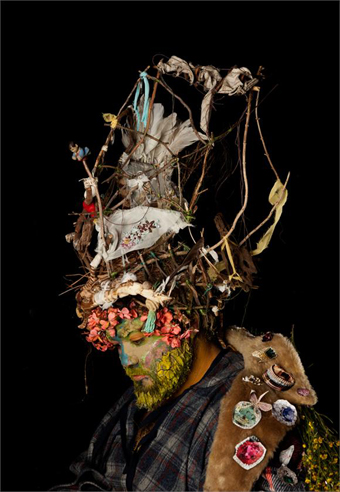
Shan Turner-Carroll, Shan, from the series Primal Crown, 2012, The Doctor Harold Schenberg Art Prize winner, Hatched, PICA
courtesy the artist
Shan Turner-Carroll, Shan, from the series Primal Crown, 2012, The Doctor Harold Schenberg Art Prize winner, Hatched, PICA
Photographer Shan Turner-Carroll has been announced as the winner of The Doctor Harold Schenberg Art Prize, part of PICA’s Hatched: National Graduate Show which features 37 artists from 20 art schools across Australia. As part of the public program Associate Professor Michele Wilson will present Digital Now, an illustrated lecture drawing on her research exploring “engagements with and through technologies and how these influence our understanding of ourselves, our social relations and social practices” (website).
Hatched: National Graduate Show 2013, PICA, Perth, until June 9, digital Now, May 8, http://www.pica.org.au/
natalie abbott, physical fractals, pact
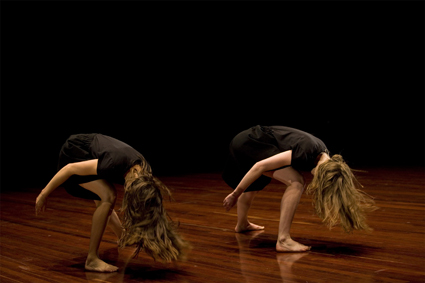
Natalie Abbott, Sarah Aitken, Physical Fractals
photo Ponch Hawkes
Natalie Abbott, Sarah Aitken, Physical Fractals
One of several impressive works by emerging choreographers in Dance Massive 2013 was Natalie Abbott’s Physical Fractals. Varia Karipoff wrote “The performance…messes with our personal sense of gravity and our concept of space” (see DM feature). Physical Fractals is particular interesting for its integration of live sound manipulated by Daniel Arnott. Sydney audiences now get a chance to experience this work at PACT Centre for Emerging Artists. Complimenting the season will be the second installment of PACT’s Saturday Sessions, an informal discussion series about experimental practice, this time focusing on “dance and daily choreographies.”
Natalie Abbott, Physical Fractals, dancers Natalie Abbott, Rebecca Jensen PACT, Erskineville, May 1-10; Saturday Session #2, May 4, 5-6.30pm; http://www.pact.net.au/2013/04/month-of-dance/
no child, nilaja sun, theatre works
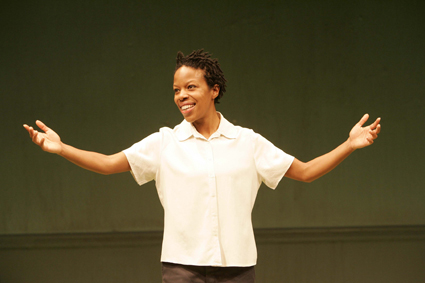
Nilaja Sun, No Child
photo Carol Rosegg
Nilaja Sun, No Child
2012 Melbourne International Art Festival audiences appreciated US writer-performer Nilaja Sun’s No Child so much that she’s decided to do a return season, this time at Theatreworks. No Child draws on Sun’s experiences as a drama teacher in some of New York’s toughest schools, “depict[ing] the battle-ground that US public education has become” (press release). You can see a promo of Sun’s super energetic and entertaining performance here.
No Child, Nilaja Sun, Theatreworks, Melbourne, May 7-26,
http://www.theatreworks.org.au/whatson/event/?id=136
shadowlife, bendigo art gallery
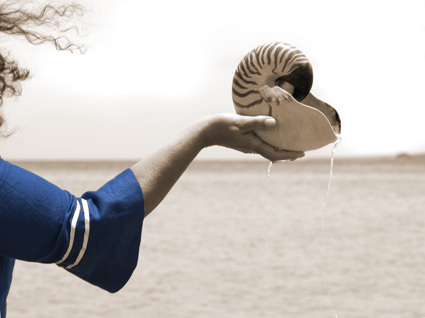
Fiona Foley, The Oyster Fisherman I, 2011, digital print on paper
courtesy of the artist, Andrew Baker Art Dealer, Brisbane, and Niagara Galleries, Melbourne
Fiona Foley, The Oyster Fisherman I, 2011, digital print on paper
Curated by Natalie King and Djon Mundine, Shadowlife explores the “spirit” of photography as implied by the Arnhem Land Djambarrpuyngu word “Wungguli.” It features provocative work by nine leading Australian Aboriginal artists (and one non-indigenous collaborator)—Vernon Ah Kee, Bindi Cole, Brenda L Croft, Destiny Deacon & Virginia Fraser, Fiona Foley, Gary Lee, Michael Riley, Ivan Sen and Christian Thompson. Shadowlife aims to “embrace moving image and photography with all its directness, theatricality and immediacy by confronting stereotypes and acting out scenarios” (press release). Co-presented by Asialink the exhibition will also tour internationally.
Shadowlife, Bendigo Art Gallery, Bendigo, until July 28; http://www.bendigoartgallery.com.au/Exhibitions/Current_Exhibitions/Shadowlife
uta uber kool ja, army of love, judith wright centre
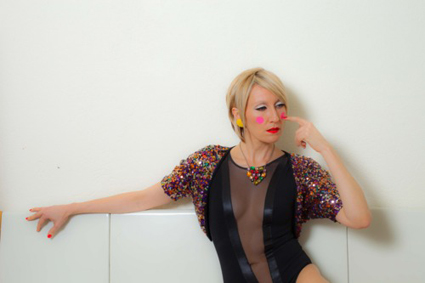
Uta Uber Kool Ja
photo Jeremy Drape
Uta Uber Kool Ja
Experiencing the decadent pleasures of Uta and George as part of Fringe World, Astrid Francis wrote: “With dress-ups, dancing, party games and more spandex than this side of 1985 has seen, Uta celebrates the launch of her remixed single. The guests revel in the sheer hedonism that is Uta—a blend of Eddie and Pats with a touch of Marianne Faithfull” (RT114). Now Brisbane audiences are invited to the exclusive party taking place in the Judith Wright Centre’s studio apartments!
Uta Uber Kool Ja, Army of Love, Judith Wright Centre, Brisbane, May 8-18; http://judithwrightcentre.com/event/uta_uber_kool_ja
RealTime issue #114 April-May 2013 pg. web
© RealTime ; for permission to reproduce apply to realtime@realtimearts.net
arts house season 1, 2014
Arts House is currently calling for expressions of interest to develop or present work as part of their 2014 Season 1 at the North Melbourne Town Hall, Warehouse or the Meat Market. Financial support up to $12,000 (including in-kind venue support) is offered for CultureLAB developments and up to $30,000 (including in-kind venue support) for full presentations. Interested applicants should discuss their project with Arts House staff prior to applying
Applications close May 31 http://www.melbourne.vic.gov.au/ArtsHouse/fundinggrants/Pages/Fundingandgrants.aspx
revelation perth international film festival
The people at Revelation appreciate that for non-residents Perth can seem a long way away and so for the fifth year they are offering travel fellowships that will provide a festival gold pass, access to seminars and workshops, and a $1,000 re-imbursement for travel costs plus more. Applications are invited from “filmmakers, academics, craftspeople or film-lovers” (website).
Deadline 24 May; http://www.revelationfilmfest.org/go/travel/travel-fellowship
exploring modular synthesis workshop & aws, wired lab
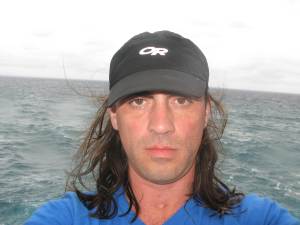
Russell Haswell
courtesy the artist
Russell Haswell
Wired Lab, based in Cootamundra, regional NSW will be host to UK multi-disciplinary artist and “synthesist” Russell Haswell. Together with Wired Lab founder Dave Burraston, they will be running a two-day Modular Synthesis workshop May 18-19. Through its Artist Workshop Scheme, Wired Lab is offering 10-15 emerging or mid-career artists financial assistance to travel and take part in the activities.
Applications for workshop & AWS due May 6: more info http://wiredlab.org
the 2013 hive production fund
The Hive (supported by Adelaide Film Festival Investment Fund, Australia Council for the Arts, ABC Arts and Screen Australia) is currently calling for proposals from artists and filmmakers for the production of documentary, hybrid and drama projects to be premiered at the 2015 Adelaide Film Festival and broadcast on ABC TV. Applications are sought from teams that include an established director or co-director and an experienced film producer. The total funding pool is $800,000 with a feature film funded for up $450,000 and a half-hour documentary/hybrid work up to $150,000.
Applications due May 13; more info http://www.adelaidefilmfestival.org/default.asp?contentID=353
arstpace curatorial fellowship
Aimed at the professional development of an early career visual arts curator, Artspace (with the support of the Australia Council for the Arts) is offering a 12-month curatorial fellowship starting June 2013. As well as fulfilling a role similar to an assistant curator the curatorial fellow will also have the opportunity to develop a key project.
Applications close May 8; http://www.artspace.org.au/content/pdf/Curatorial_Fellow_Description.pdf
channels video art festival
There’s a new kid on the media art biennial block— Channels Video Art Festival. Run by Rachel Feery, Jessie Scott and Eugenia Lim, it will take place in Melbourne Sept 18-21 at ACMI, Screen Space and Speak Easy. The team are already leaking the news of special installations commissioned from Ms&Mr and Benjamin Ducroz. The festival is currently calling for entries of “video art that both knows its past and has a mark to make on the future” (website).
Deadline June 1; more info http://www.channelsfestival.net.au/
proximity festival
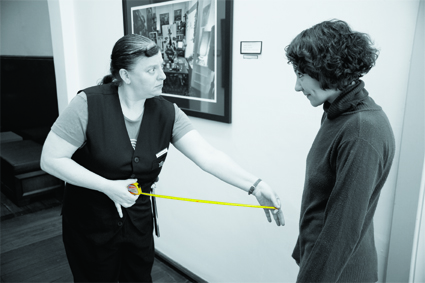
Nikki Jones and audience
member, Ush and Them, Proximity
Micro Festival of One-on-One Art
photo Ashley de Prazer
Nikki Jones and audience
member, Ush and Them, Proximity
Micro Festival of One-on-One Art
Proximity is a Perth-based festival focussing on one-on-one performance and experiences. The first manifestation in 2012 included beard fondling, a game of strip poker, a private hoofer viewing, a three-minute shower and a slow cooked meal (to get the gist see Laetitia Wilson’s review RT108). Festival curators James Berlyn and Sarah Rowbottam are now calling for proposals for the 2013 manifestation.
Deadline May 17; http://proximityfestival.com/
heartlands refugee art prize
Applications are sought from refugees who have arrived in Australia since 1970 for the Heartlands Refugee Art Prize. There is a prize pool of $20,000 ($12,000 going to the overall winner) and the theme for this year’s competition is “I wish to see…” The award is run by Multicultural Arts Victoria in partnership with Parks Victoria, VicHealth and the Victorian Multicultural, and the shortlisted entries will be exhibited in fortyfivedownstairs June 18-29, as part of Refugee Week, with further presentations later in the year.
Applications close May 10; more information http://www.multiculturalarts.com.au/events2013/heartlands.shtml
hidden: rookwood cemetery sculpture walk
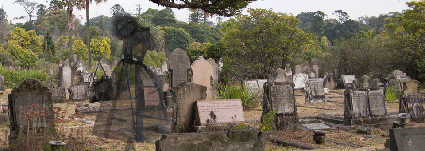
Afterimage, Lyndal Hargrave and Sue Henderson, HIDDEN: Rookwood Cemetery Sculpture Walk
courtesy the artists & HIDDEN
Afterimage, Lyndal Hargrave and Sue Henderson, HIDDEN: Rookwood Cemetery Sculpture Walk
Since 2009 Rookwood, the largest cemetery in Australia, has been host to HIDDEN, a sculpture walk that aims to reposition the site as “a place rich in heritage, history, culture” rather than just for “funerals and memorials” (website). The exhibition takes place September 21-October 31 and the call for entries is now open. There is a non-acquisitive Rookwood Necropolis Sculpture Award valued at $10,000 with range of smaller prizes as well.
Application deadline May 6; more info http://www.hidden.rookwoodcemetery.com.au/
RealTime issue #114 April-May 2013 pg. web
© RealTime ; for permission to reproduce apply to realtime@realtimearts.net
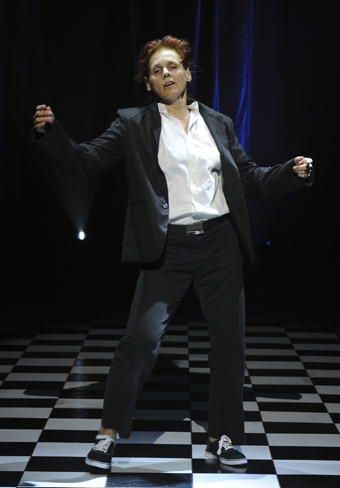
Vicki Van Hout, Slow Dances for Fast Times, choreographer Martin del Amo, Carriageworks
photo Heidrun Löhr
Vicki Van Hout, Slow Dances for Fast Times, choreographer Martin del Amo, Carriageworks
In RealTime114, our writers tumble Alice-like into the rabbit hole of arts festivals. First stop, a cavernous ballroom populated by Melbourne’s Dance Massive, the Adelaide and Perth Festivals and dances in Sydney and Bangkok. Our mirror neurons fire, limbs twitch and fingers glide across keyboards. Next, we’re through a door to a wonderland of Tweedle-Dee Tweedle-Dum international arts festivals and their Mad Hatter kin—Bristol’s In Between Time, Brisbane Powerhouse’s World Theatre Festival and Perth’s Fringe World—all crying out, “Eat me! Eat me!” Ingesting so much art we grow huge, bounding over oceans to ideas-and–action Tea Parties—The 8th Flying Circus Project (FCP) in Myanmar and Singapore, and the World Symposium on Global Encounters in South-East Asian Performing Arts in Bangkok. Out we pop, home, informed, inspired and over-excited, already anticipating the next hallucinatory experience—the Cheshire Cat IT magic of ISEA2013 in Sydney. We need inspiration—we’ve lamentably found ourselves in a very different hole. An international survey has dropped Australia from 9th to 18th in terms of IT accessibility and innovation—simply put, it costs Australians too much to innovate. Off with our heads! But we’ll keep dancing—with Bangarra’s Blak, which includes a new work by young Indigenous choreographer Daniel Riley McKinley, and Lemi Ponifasio’s mindbending Birds with Sky Mirrors at Carriageworks where Vicki Van Hout (pictured here) wowed us in March, dancing to the Jimi Hendrix version of Dylan’s All Along the Watchtower in Martin del Amo’s Slow Dances for Fast Times. Back into the rabbit hole!
RealTime issue #114 April-May 2013 pg. 2
© Keith Gallasch; for permission to reproduce apply to realtime@realtimearts.net
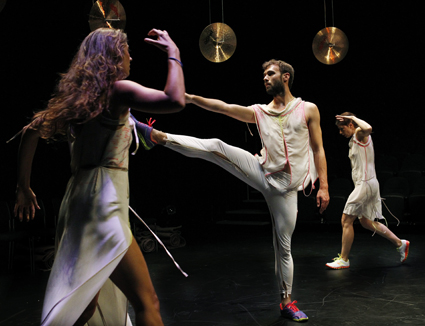
Brooke Stamp, Rennie McDougall, Deanne Butterworth, And All Things Return to Nature Tomorrow, Phillip Adams’ BalletLab
photo Jeff Busby
Brooke Stamp, Rennie McDougall, Deanne Butterworth, And All Things Return to Nature Tomorrow, Phillip Adams’ BalletLab
THE EYES OF BALLETLAB PERFORMERS HAVE A UNIQUE QUALITY. THERE IS A STRANGE, DISTANT, SATISFIED WORLD BEHIND THEM. STRANGE IN ITS EXOTICISCM, DISTANT IN ITS MYSTERY, SATISFIED IN ITS METHOD.
In a work like Amplification (RT102), this quality suggested the serious certainty of mortality—death being exotic, mysterious and inevitably methodical. In a work like Aviary (RT106), this quality infused the occasionally maddening ornithology with an equally maddeningly convincing internal logic—the kind of logic that is masked, impenetrable and yet undeniable. In a work like Miracle (RT93), this quality suited the transcendental mysticism to a tee—is there anyone as strange, distant and satisfied as someone on a higher plane of consciousness?
And All Things Return to Nature Tomorrow is a double bill of works by Brooke Stamp and Phillip Adams that both make full use of the BalletLab corps. Thematically, the works feel linked to Miracle. They are cosmological, ritualistic and transcendental.
Brooke Stamp’s And All Things Return to Nature kicks off the evening in full house lights. We are seated in an unevenly weighted square, where two sides are stacked with audients and two sides are made of only single rows. Above the stage are suspended 16 cymbals that form a golden circle of circles, a halo of musical vibration. The dancers are clad in high fashion sportswear by Susan Dimasi—part Nike the brand, part Nike the goddess. As visual signposts, the design elements point the way clearly enough: this will not be proscenium theatre, we will encounter the celestial, we will be party to mysticism dressed in high technology fibres.
Initially, the dancers move in isolation. They are transfixed by their own paths through space, uninterested in the other, wrapped in the self. Their gentle vocalisations suggest chants, incantations, mantras. Garth Paine’s intensely detailed composition picks these sounds up and layers them, forming a cascading aural blanket of indiscernibility.
As the dancers draw together, Stamp’s choreography echoes one of Phillip Adams’ stylistic touchstones with a prolonged sequence of action—in this case, a shuffling unison of steps. As the four performers stretch from a line to a diamond to a square, the squeak of their sneakers against the floor becomes a lulling certainty. Though their steps never break the unified rhythm, their faces betray some deeper meaning. At times, their eyes subtly shift focus and lose clarity. The strange, distant, satisfied world vacates them and one sees the struggle, the striving and the searching. Higher planes are hard work.
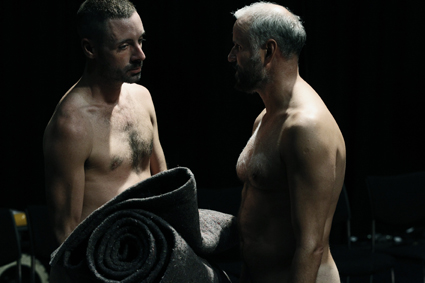
Matthew Day, Phillip Adams; And All Things Return to Nature Tomorrow, Phillip Adams’ BalletLab
photo Jeff Busby
Matthew Day, Phillip Adams; And All Things Return to Nature Tomorrow, Phillip Adams’ BalletLab
In Tomorrow by Phillip Adams, the eyes are back on full beam. Entering naked, the performers build a stage of swags, stones, fluorescent twine, reflectors and audience members. We are courting UFOs, constructing a landing pad and hoping for ascension in the form of abduction. The eyes, the nudity and the whispered intimacies with the front rows set up a peculiar dynamic of compelling coerciveness. What are you willing to do in the safe confines of a theatre with a hundred witnesses? When you look into a naked man’s eyes and see an exotic, mysterious and assured alternative world, will you follow him? It is to BalletLab’s credit that we do. They have created a cult with nothing more than their eyes.
Phillip Adams’ BalletLab, And All Things Return to Nature Tomorrow, direction & choreography Brooke Stamp & Phillip Adams, performers Phillip Adams, Brooke Stamp, Deanne Butterworth, Rennie McDougall, Matthew Day, composer Garth Paine, set design Matthew Bird (Architect), fashion & design Susan Dimasi (Materialbyproduct), lighting Robin Fox, Southbank Theatre, The Lawler, Melbourne, March 15-23
RealTime issue #114 April-May 2013 pg. 35
© Carl Nilsson-Polias; for permission to reproduce apply to realtime@realtimearts.net
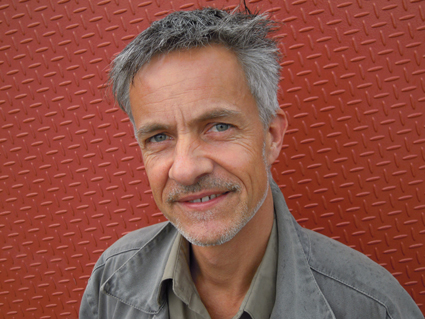
Jonathan Parsons, ISEA Director
photo Maria Barbagallo
Jonathan Parsons, ISEA Director
ISEA2013 IS COMING TO TOWN, A FEAST OF IDEAS AND EXHIBITIONS FOCUSED ON ELECTRONIC TECHNOLOGIES AND THEIR EVER INCREASING PRESENCE IN OUR LIVES AND OUR ART, SUCH THAT WE ARE FREQUENTLY TOLD “RESISTANCE IS FUTILE”—WHICH IS THIS YEAR’S ISEA THEME.
For media artists and media arts academics and anyone intrigued by the impact of new technologies on communication, creativity, culture and ethics, the ISEA [International Society of Electronic Arts] Symposium is a critical, annual, international event, a merging of conference, exhibitions, performances and workshops. Each year since 1988 it’s been held in a different city, for example Nagoya, 2002 (RT53), Singapore 2008 (RT88), Istanbul in 2011 (RT106) and Albuquerque (RT113).
ISEA2013’s director Jonathan Parsons, an experienced festival director and late appointee to this role, just manages to exude his usual clear-eyed charm and good humour under pressure of pulling together a massive event .
Parsons tells me that each city presents the overall event in terms of its own vision and theme. The theme for Sydney is “Resistance is Futile” and the vision for the event extends from Sydney Harbor to the University of Technology, from Carriageworks in Redfern to Campbelltown Arts Centre. Presented by the Australian Network for Art and Technology (ANAT), ISEA 2013 is supported by the Australia Council and—to enable a connection between ISEA and the Sydney Opera House’s Vivid—by Destination NSW.
21 years on
The aim of ISEA, founded in the Netherlands in 1990, is to encourage “interdisciplinary exchange among culturally diverse organisations and individuals working with art, science and technology” (press release). The event was last held in Sydney in 1992. For Parsons it’s a timely return 21 years on. In the 1990s the ‘new’ in ‘new media’ was still meaningful. “Now,” says Parsons, “I think the phenomenon has become all-pervasive to the point where it’s so much part of the fabric of our lives that we’re starting not to notice it. I think that’s an interesting thing in itself to investigate.”
It’s not only that new media are embedded in our lives, but our engagement with them, says Parsons, has matured. Consequently, he’s very pleased with ISEA’s association with Vivid Lights. “Vivid Lights [that aspect of Vivid that lights up the city in unusual and innovative ways. Eds] is an expression of things that could only have been imagined in 1992. They’re quite mainstream now. But that kind of data mapping and its projection were largely only in people’s imaginations back then.”
submission or resistance?
As for this year’s theme, Parsons is clear: “The intention is to trigger discussion. Is the statement about the futility of resistance true? Or how much of it is true? There’s a certain sense of humour to it too. It’s a line that’s been used by many scriptwriters in countless science fiction movies and TV series.” I point out that every time the issue of internet censorship is raised, a host of voices will declare that it’s impossible. “Exactly,” says Parsons, “It’s led to one of the ISEA sub-themes, “resistance is fertile,” a useful counterpoint in the current context.
shaping the event
ISEA is spread over 10 days across greater Sydney. I ask Parsons about the shape of the event. “The core is the conference and certainly the program developed out of that in a number of ways. One of them entails a classic festival strategy: the opportunity for a number of cultural partners and institutions in Sydney to take advantage of the opportunity of having leading thinkers and practitioners in this field coming to the conference, and building on that by presenting their ideas and works publicly.
“Certainly my role has been to both harness that energy and support different cultural organisations to present what they want to do. That’s included an extensive call for proposals from Australia and internationally. So partnerships and invitations have informed the curatorial framework for the program. There’s a continuum with pre-existing programs, like the Anne Landa New Media Arts Award exhibition at the Art Gallery of NSW and Experimenta’s Speak to Me touring show through to projects we’ve curated and are producing ourselves.”
ideas in words: conference & talks
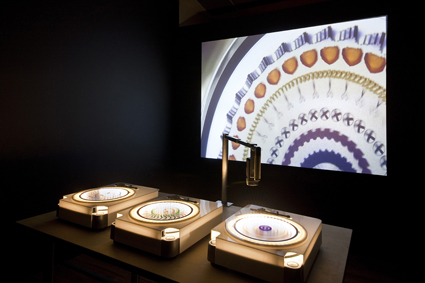
Katie Turnbull, Modern Vanitas 2012
photo Mark Ashkanasy, RMIT Gallery, 2012 (commissioned by Experimenta)
Katie Turnbull, Modern Vanitas 2012
The ISEA Symposium this year is co-chaired by Ross Harley (College of Fine Arts, UNSW) and Cathy Cleland (University of Sydney) who, Parsons says, “have been driving the final selection of papers and presenters. On one level it’s an academic conference so certain processes need to be adhered to in terms of making sure that all the papers are published afterwards and there’s a peer-review process for selection into the conference. We’re providing administrative support. Where I’ve become involved is in the crossover territory—like the selection of keynote speakers. But the conference is just part of a range of talks programs that we’re presenting. The other key component is the Vivid Ideas program.”
The three-day ISEA2013 Symposium features 200 speakers and eight keynote addresses “from global leaders in the fields of art, science, technology, media and communications” on topics including “bio-art, data visualisation, robotics, augmented realities and urban and virtual ecologies” (press release). The ISEA conference keynote speaker is pioneering US media artist Michael Naimark who “has made interactive ‘moviemaps’ and stereo-panoramic movies around the world, ranging from Aspen, Paris and San Francisco to Angkor, Jerusalem and Timbuktu,” exploring “‘place representation’ and its impact on culture” (press release). Professor of Experimental Psychology and Fellow and Tutor in Psychology, Pembroke College, University of Oxford, Brian Rogers will speak on “Perception, Art & Illusion.”
Speaking at Vivid Ideas will be Paul Cirio and Alessandro Ludovico (The Hacking Monopolism Trilogy), “whose infamous online project Face to Facebook involved stealing one million Facebook profiles, filtering them with face-recognition software, and posting them on a custom-made dating website” (press release). Vivid Ideas takes place on the first weekend of ISEA. Parsons says, “the opportunity to work with Vivid was a chance to offer more public presentations, appealing to a broader audience than the conference does.
Other speakers include Stelarc, Mark Hosler of Negativland (US), Kate Chapman (Australia) and Genevieve Bell (Australia/US), Director of Interaction and Experience at Intel Labs—and, says Parsons, an anthropologist by training whom Intel thought might have something to say about the engagement with technology.
ideas realised: exhibitions
![Ryoji Ikeda, data.tron [8k enhanced version], audiovisual installation, 2008-09, © Ryoji Ikeda](https://www.realtime.org.au/wp-content/uploads/art/62/6222_gallasch_isea_datatron.jpg)
Ryoji Ikeda, data.tron [8k enhanced version], audiovisual installation, 2008-09, © Ryoji Ikeda
photo by Liz Hingley
Ryoji Ikeda, data.tron [8k enhanced version], audiovisual installation, 2008-09, © Ryoji Ikeda
The ISEA centrepiece is Ryoji Ikeda’s Datamatics (see cover image) in the huge main theatre at Carriageworks. Parsons thinks some Sydney-siders will remember Ryoji Ikeda from his performances as part of Dumb Type in the 1990s. “Since then,” says Parsons, “he’s moved into solo practice. Sydney has not seen any of his major installation work.”
Ikeda’s test pattern will also have a one-off presentation, again at Carriageworks. Parsons describes it as “a performance that as an audience you can drop in and out of. It’s an even more intense experience than Datamatics. That will be happening on the Friday June 7 as a one-off. It’s our kick-off really for the ISEA’s 10 days and then everything else at Carriageworks, including the installation, will happen from the Saturday night.”
I’m curious about the nature of the Ikeda experience which Parson describes as “intensely visual, and the sound as much a part of it as the visual. The sheer scale assists with this. I can assure you that Ryoji Ikeda absolutely works on the immersive level. There’s quite a refined aesthetic in the work—black and white—a connection with his heritage in Japanese culture.” As well as representing the entwining of tradition and the new, Parsons sees Ikeda as central to the “‘big data’ issue—is data visualisation an artistic practice or not? Certainly it’s true that a lot of artists are becoming interested in that field. To me, Ryoji Ikeda’s work is the ultimate in data visualisation. It’s absolutely about art, purely about the aesthetic quality for which the data and the code can be utilised by him as an artist. It’s not about the content.”
The extensive exhibitions program features works by 150 artists from Australia and around the world. At Carriageworks, Sydney artist Alex Davies will stage Very Near Future, “a large scale mixed reality/interactive cinema installation which will question what is real or virtual, fact or fiction (press release).” At the same venue, Performance Space will present John A Douglas’ Body Fluid II (Redux) (RT106; p44) “ a performance and video installation in which the artist presents the monotony of his daily dialysis treatment as a sublime act of self-transformation.”
Artspace will feature engaging robotics by Mari Velonaki (Australia)—involving a very human humanoid robot; Petra Gemeinboeck & Rob Saunders (Australia)—“an infestation [by] a colony of curious, social machines hidden within the Artspace gallery walls”; and Simon Ingram (New Zealand)—“a cluster of machines paint live in the space through an operational system run remotely by the artist in Auckland.”
Catching Light is an exhibition staged by Campbelltown Arts Centre which has “brought together five creative innovators from the analogue and early digital eras to mentor, collaborate and exchange ideas with five ‘new generation’ artists from various disciplines—art, sound and performance—who have a practice reliant on engagement. The teams are Linda Dement & Kelly Doley; Tom Ellard & Paul Greedy; Troy Innocent & Benjamin Kolaitis; Stephen Jones & Pia van Gelder; and Wade Marynowsky & Michael Candy.”
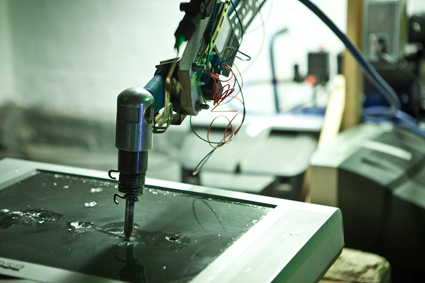
Golden Solution, First Draft Depot
photo Alex Davies
Golden Solution, First Draft Depot
Parsons says of the Running the City exhibition, “It looks in a different way at the resistance theme, about just how this technological work is becoming integrated into the urban fabric, especially via portable devices. What does this technology allow us to uncover or connect to in the city in different ways? Felicity Fenner is the curator and the artists are a mix of Australian and international exploring the theme in a range of different ways. Jun Nguyen-Hatsushiba is a Japanese-American of Vietnamese background, an amazing video artist who was here a few years ago with a beautiful work featuring fishermen pulling rickshaws underwater (Towards the Complex—for the Courageous, the Curious and the Cowards, 2001; RT46). This time his work is very playful. It’s set up like a jukebox and people are able to choose a video of someone running through different cities in the world.” The other artists are Richard Goodwin (Australia), Volker Kuchelmeister (Australia), Laurent Gutierrez + Valerie Portefaix (MAP Office; Hong Kong), Brad Miller and Ian McArthur (Australia) and Marnix de Nijs (the Netherlands).
Vivid Lights and Experimenta’s Speak to Me will feature Human Effect by Yandell Walton (Australia) in an urban laneway: “Flowering vines twine up pipes and moss and ferns spread across walls, while vividly coloured butterflies alight on window ledges. Echoing ages before human habitation, this scene entices viewers to move closer—only to see the new life wither and slowly die, destroyed by the human presence. The habitat is renewed once more in a riot of foliage and motion as viewers move away” (press release). The rest of Experimenta’s Speak to me (RT112) will be installed at the Powerhouse Museum.
Other exhibitions, says Parsons, cover emerging talent. “The Depot program for example is more grass roots, more underground. It was important for me to create various access points for a range of practices and also for artists at various stages of their careers.”
ideas embodied: performance & participation
As well as Ikeda’s test pattern (a work you’ll be inside rather than simply looking at) there will be a variety of performances including electronic music in NEW WAVE: SOUND presented by Seymour Centre and Vivid Sydney in association with ISEA featuring The Noise, Infinity room, Frostbyte and Collarbones.
A range of performances and workshops in ISEA2013 reveal the diversity of participatory involvement enabled by technologies old and and new. Perth’s tactical media art group pvi collective will take over the streets of Darlinghurst with Deviator: “immerse yourself in an outdoor game experience and become an urban ‘deviator,’ temporarily transforming the city into a playground” (press release).
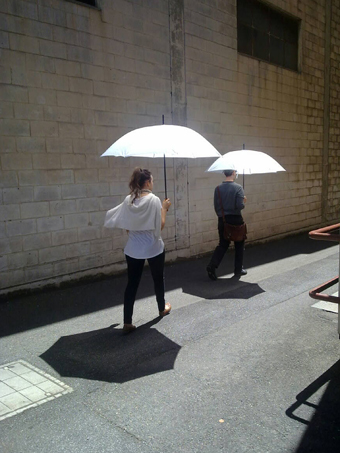
Stereopublic (Crowdsourcing the Quiet), Jason Sweeney
photo Martin Potter
Stereopublic (Crowdsourcing the Quiet), Jason Sweeney
In his review of the music program of the Adelaide Festival, Chris Reid describes Jason Sweeney’s Stereopublic (Crowdsourcing the Quiet), as “an absolute delight for its gentleness and its ability to make you think about sound and listen for it. Sweeney guides participants on a walking tour of city sites with particular sonic characteristics…This is relational art, from which a small community with a new awareness is born, each walking-tour group forming a bond in Trappist monk-like silence.” Stereopublic’s “Earwitnesses” will each receive a soundwork and their “city-specific location will be placed on an ever-growing virtual soundmap of Sydney” (press release).
Other events include Carbon Arts’ The City Data Slam featuring leading national and international data art practitioners, while dLux MediaArts and Dorkbot’s Art Hackfest will connect artists in Sydney, Darwin and Byron Bay.
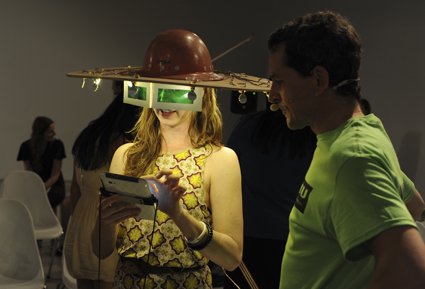
EBEMU, Paul Granjon, Paul Gazzola, Oh! I Wanna Dance With Somebody, Campbelltown Arts Centre
photo Heidrun Löhr
EBEMU, Paul Granjon, Paul Gazzola, Oh! I Wanna Dance With Somebody, Campbelltown Arts Centre
A Paul Gazzola (Australia/Berlin)-Paul Granjon (UK) collaboration “deals with the rise of new generations of inventors and tinkerers, playing with technology in the broader community.” Parsons saw the work, Experimental Body Extension Manufacturing Unit, in Campbelltown Arts Centre’s Oh! I Wanna Dance With Somebody last year (RT112) and “loved the community engagement, the playfulness of it, the mixture of low and high tech. This time they’ll be working within the community around Carriageworks, using the same process, constructing new, fantastical objects of invention.”
An opportunity to engage your body quite directly with technology comes in the form of George Poonkin Khut and James Brown’s Theta Lab, “an experimental art research project combining neurofeedback with participatory art, electronic music and ‘slow design’ to explore and document qualities of attention and subjectivity facilitated by Alpha/Theta brainwave biofeedback.”
While the conference is central to ISEA2013, Parsons and his team have built a substantial public program that encompasses a huge range of responses to the potentials and challenges offered by media technologies, from solo artistic creations to community workshop, from data projection to sound art, to collaborations between artists across generations, all of it positioned across the city. And all of it open to discussion and debate. For Parsons it’s about “what it means to be here now in 2013. Australia has a very important place in international developments in the field of electronic arts, thanks to both its artists and its organisations and institutions.”
Follow ISEA2013 closely by joining RealTime bloggers Urszula Dawkins and Gail Priest. There’ll also be online reviews and video interviews and the launch of the RealTime Media Arts Archive, 1994-present.
ISEA2013, 19th International Symposium on Electronic Art, Sydney, June 7-16; http://www.isea2013.org/
RealTime issue #114 April-May 2013 pg. 4-5
© Keith Gallasch; for permission to reproduce apply to realtime@realtimearts.net
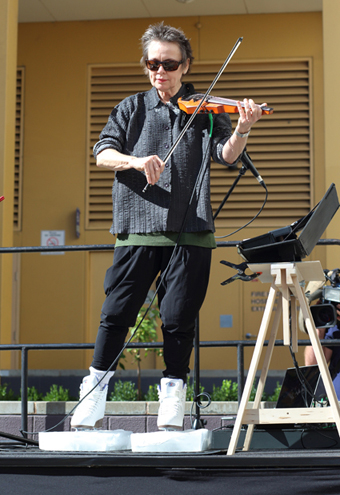
Laurie Anderson, Duets on Ice, Adelaide Festival 2013
photo Tony Lewis
Laurie Anderson, Duets on Ice, Adelaide Festival 2013
LAURIE ANDERSON IS MOST FREQUENTLY SEEN IN LARGE VENUES SHARING SHORT STORIES AND PERSONAL PHILOSOPHY, UNDERPINNED BY GENERALLY HUMMABLE TUNES, SO IT’S NOT SURPRISING THAT SOME MAY QUERY HER UBIQUITOUS BRANDING AS ‘EXPERIMENTAL.’ SHE HERSELF ADMITS TO OFTEN FEELING MORE LIKE A JOURNALIST THAN A DOYENNE OF THE AVANT-GARDE (GRITTV, 2011).
A long-time fan of Laurie Anderson, even I had begun to question how close to the experimental coalface she was operating these days. However the presentation of three major projects as part of the 2013 Adelaide Festival confirmed for me that Anderson’s experimentalism is not something accurately gauged via a single artwork, rather it arises from her consistently multi-disciplinary approach over a 40-year career.
present pasts

Laurie Anderson, Duets on Ice, Adelaide Festival 2013
photo Tony Lewis
Laurie Anderson, Duets on Ice, Adelaide Festival 2013
I arise obscenely early to get to Adelaide from Sydney by 10.30am for Anderson’s performance of Duets on Ice which opens her exhibition The Language of the Future at the Anne and Gordon Samstag Museum of Art. Back in the 1970s Anderson augmented a violin so that it played tape loops allowing her to duet with herself. The loop made the performance potentially endless so Anderson introduced a timing device: embedding ice-skates into blocks of ice, she would play until the ice melted.
Taking place outside the gallery in Adelaide heat, I suspect the performance might be short so I am keen to get there on time. I am a little disappointed that Anderson has replaced her tape-loop violin for her current rig—electric violin filtered through various digital systems—but of course technologies move on and Anderson is well-known for being adaptive and adoptive. It’s not at all disappointing to watch Anderson, a petite woman in her 60s, awkwardly ambulating across the Samstag courtyard to the makeshift stage, large blocks of ice attached to her bright white ice-skating boots. This is an informal and intimate performance (so rare to see experimental music in daylight) and Anderson semi-improvises and chats for 25 minutes, the time it takes for the ice to crack and break away from the skates.
The Language of the Future features five pieces illustrating the breadth of Anderson’s work as visual artist. The centre-piece is The Swimmer (2009-2012), a six-channel video down-projected along the length of the space. The projection surface is made from shredded paper in tight, tiny rolls, the printed text just visible if you peer closely. Seen on the ground floor it adds visual noise to the images creating a kind of analogue pixilation. Viewed from the balcony it appears more three-dimensional—a memory contour map perhaps.
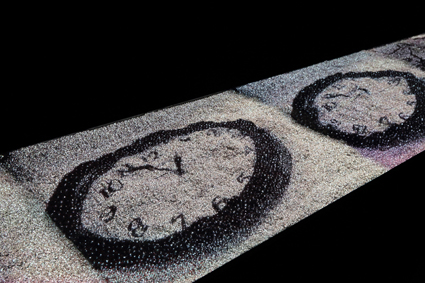
Laurie Anderson, The Swimmer (2009-2012), The Language of Future, Anne & Gordon Samstag Museum of Art
courtesy Adelaide Festival 2013
Laurie Anderson, The Swimmer (2009-2012), The Language of Future, Anne & Gordon Samstag Museum of Art
The video is a visual poem comprising fragmented images—rural scenes, the looming face of a nurse, clockfaces and a rabbit in a wheelchair—some in high-contrast black and white, others in dreamy colour. The images accompany the adjacent piece, A Story About a Story (2012), an artist book exploring the time Anderson broke her back as a child and spent months recuperating in a ward for seriously ill children. It’s Anderson at her most revealing as she admits to subsequently editing out details—the real horror of the situation—in the process of crafting the story into one of her set pieces. She concludes, “You get your story and you hold onto it and every time you tell it you forget it more.”
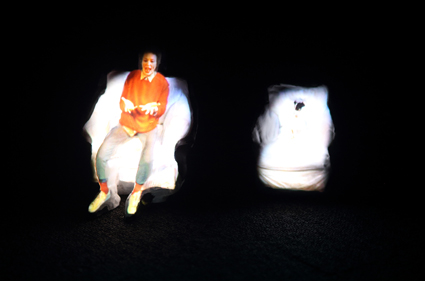
Laurie Anderson, From the Air (2008); The Language of the Future, Anne & Gordon Samstag Museum of Art
courtesy Adelaide Festival 2013
Laurie Anderson, From the Air (2008); The Language of the Future, Anne & Gordon Samstag Museum of Art
The use of a three-dimensional projection surface is something Anderson began in 1977 with her “fake hologram” At the Shrink. She projected an image of herself onto a small three-dimensional plaster figure, giving a beguiling sense of depth and life. From the Air (2008) revisits this technique presenting tiny models of herself and her dog Lolabelle. The Anderson figure tells the story of the time her dog was swooped on by turkey vultures but then deftly flips this domestic moment to reflect the state of American consciousness after 9/11—when people realised, like Lolabelle, that “They can come from up there!”
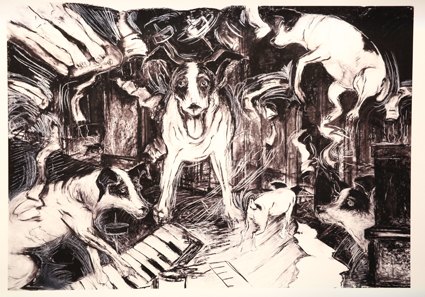
Laurie Anderson, Lolabelle in the Bardo, The Language of Future, Anne & Gordon Samstag Museum of Art
courtesy Adelaide Festival 2013
Laurie Anderson, Lolabelle in the Bardo, The Language of Future, Anne & Gordon Samstag Museum of Art
Lolabelle also makes an appearance in a series of prints taken from large-scale drawings depicting the rat terrier, now deceased, spending 49 days in the Bardo, the place Buddhists believe souls go before they are reborn. The rendering of the dog is cartoon-like yet the images are quite terrifying, full of turbulent motion and dark twisted figures. Lolabelle in the Bardo shows an artist willing to defy expectations and utilise whatever medium suits her project.
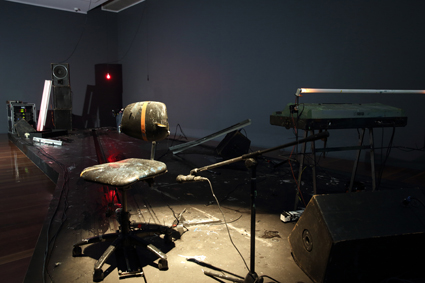
Laurie Anderson, Electric Chair, The Language of Future, Anne & Gordon Samstag Museum of Art
courtesy Adelaide Festival 2013
Laurie Anderson, Electric Chair, The Language of Future, Anne & Gordon Samstag Museum of Art
Similar idiosyncrasy is revealed in the final work, The Electric Chair. An installation from 1977, it was originally presented in a rundown warehouse using whatever was at hand, but now it is recreated in one of Australia’s newer white cubes. The sounds in this piece—the amplified hum and stutter of fluorescent tubes on the blink, the thump and grind of a swivel chair careening up and down a rail—have more rawness and authenticity than the faux paint-spattered floor and distressed electrical equipment. Ironic and playful, Electric Chair adds historical perspective to the survey—even Laurie Anderson started out in a dirty warehouse.
While not a comprehensive retrospective of Anderson’s oeuvre, the selected works in The Language of the Future rustle against each other in a way that highlights her dominant methodologies: multidisciplinarity; multi-dimensionality; the interplay of textual and visual poesy; and the personal as political.
connecting dots
If Language of the Future doesn’t confirm her ‘experimental’ status, Landfall, Anderson’s collaboration with the Kronos Quartet, certainly does. It explores what she describes as the processes of meaning-making by presenting the audience with fast flowing texts and symbols, conflicting audio and visual cues and an overall fragmentation that falls distinctly into the category of, to quote Anderson, “difficult music-c-c-c-c-c-c” (United States of America I-IV,1984).
The music alone doesn’t sound so difficult. Anderson’s electric violin forms a deep, rich bed over which the Kronos Quartet’s acoustic instruments shimmer. Nearly every musical segment is brief comprising beguiling melancholic melodies flavoured by Eastern European harmonies. It’s a music of beginnings with few pieces developing more complex internal structures, reminiscent of film scoring. It makes for a slippery, slightly frustrating experience—you long to hear some of the ideas expanded. It appears to be a deliberate tactic to aurally fragment the experience, just as the texts, spoken and projected, are broken up.
Subject matter is seemingly dissociative. Anderson was completing the commission when Hurricane Sandy hit New York so ideas of immersion flow through the piece. Near the beginning large text scrolls upwards, spaced and paced so that you are left to anticipate (often incorrectly) the next line:
“the city drowns
the city where children
are shot
and women have just
earned the right
to combat.”
At other times she talks of dreams, discussing how tedious it is when people recount them, which is ironic given that Anderson has spent much of her career sharing hers. There are texts about a book of extinct animals that weighs as much as 30 weasels; a job Anderson took to make a hotel lobby “sound bigger;” and a new letter of the alphabet called Olive which has no sound, you just open your mouth and think about it. These ideas weave around each other either spoken by Anderson or projected. The screened text comprises a variety of scrolling orientations, fonts and colours increasingly interrupted by typographic constructions, including warning and information symbols, silhouettes of figures replacing letters, ink splotches or simply missing chunks of words. We read, trying to fill the gaps. As William Burroughs says in “Sharkey’s Night,” “Hey sport. You connect the dots. You pick up the pieces” (Mister Heartbreak, 1984).
Laurie Anderson has always been associated with technological innovation, however in her later work she tends to let technology putter away in the background rather than fetishising it. In Landfall both tactics are employed. The program tells us that the composition is “generated from harmonies and delays” by the Erst software system—this perhaps explains the prevalent incremental build structure of most pieces. There is also interplay between the musicians and the text samples. This generally remains invisible except for one section in which violinist John Sherba breaks formation and solos, centre stage, generating flashes of words with sharp, frenetic bowing. Once again, I wished this had been extended beyond a brief moment of spectacle so that the cause and effect could develop more complexity.
Maybe Landfall is a little too genteel. The fragments themselves—both musical units and stories—are all quite pleasant and neat. A few more extremes and jagged edges, some freefall into utter ambiguity, might raise the stakes and make us work even harder in our role as meaning-makers.
story time
For those dissatisfied by the fragmentary nature of Landfall, the salve was Dirtday!. This is the Anderson we’ve come to expect. Stage and lighting design are stripped back but atmospheric, with small tea-light candles scattered around the floor adding warm shimmer to sharp beams of light. On stage is an armchair and next to it a small projection screen that remains mostly blank showing only shifting colours. While the chair is empty most of the time with Anderson positioned on the other side of the stage, its presence reminds us that this is story time.
After a brief musical introduction Anderson talks about evolution and how Darwin, “a mousey dresser,” was irked by the peacock, a species that allowed the female to make all the decisions. She moves on to the Catholic Church and its fear of multiple universes—what if there were multiple popes? Who would be top dog? And why is our planet called Earth? Why not simply Dirt?
Inevitably Anderson moves on to dreams—she tells us that at 63 she has dreamt for 21 years of her life. Now subjects begin to slip and intertwine: election seasons mix with peacocks, theories on cot death and tent cities, chickens in trees with the “politeness” of Alzheimer patients. Things consolidate again when Anderson finally sits in the armchair and talks about the death of her dog, ruminating on death from the Buddhist perspective: how to feel sadness but not be sad; how death is the release of love. From someone else’s lips all this could seem trite but Anderson’s touch is light and the inclusion of a crappy video of blind Lolabelle playing the keyboard a moment of leavening humour.
In her program notes Anderson discusses how she originally set out to make a music driven piece, utilising software that would render her solo playing symphonic, however the words just kept coming and she decided to go down the path of “musically arranged words that spoke up.” The music here is perfectly balanced, just rising above the background in swelling interludes then sinking back to keep things ticking over. Small details—the shudder of a helicopter, or the shimmer of rain, a dog bark, a pulsing beat—are near subliminal. Over the years Anderson’s use of the vocoder has also changed. Originally her down-pitched voice was used as the “voice of authority” but here she uses it as a more distant version of herself, her dream self. Perhaps she suggests our dream selves are our internal authority; or maybe they should be.
I had a moment of sadness during Dirtday! thinking that perhaps this might be the last time we see Anderson in Australia (given how far away we are from New York). If that is the case, these three projects presented by the Adelaide Festival offered the perfect showcase of the breadth and depth of this inspiring artist who is not afraid to keep doing what she knows she does well, but who also never wearies of the search for new ways to make sense of things.
Adelaide Festival 2013: The Language of the Future—Selected works from 1971-2012, Laurie Anderson, Anne & Gordon Samstag Museum of Art, March 1-April 19; Landfall, Laurie Anderson & The Kronos Quartet, performers Laurie Anderson, violin David Harrington, John Sherba, viola Hank Dutt, cello Jeffrey Ziegler, music and text Laurie Anderson, Erst programming Liubo Borrisov, electronics & software design Konrad Kaczmarek, dramaturg Bob Currie, transcription Jacob Garchik, audio rig Shane Koss, lighting design Brian H Scott, Festival Theatre, March 2; Dirtday!, music, text & visual design Laurie Anderson, lighting Brian H Scott, Dunstan Playhouse, March 3
RealTime issue #114 April-May 2013 pg. 6-7
© Gail Priest; for permission to reproduce apply to realtime@realtimearts.net
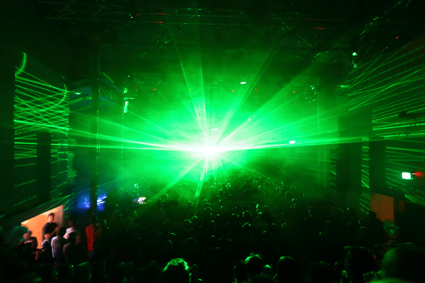
Robin Fox, Unsound
photo Tony Lewis, courtesy Adelaide Festival 2013
Robin Fox, Unsound
THE ADELAIDE FESTIVAL’S MUSICAL PROGRAMMING BROUGHT SIGNIFICANT AND WELCOME CHANGES, FOREGROUNDING CONTEMPORARY MUSICAL GENRES OUTSIDE THE CLASSICAL MOULD, BROADENING THE FESTIVAL’S APPEAL BEYOND ITS TRADITIONAL AUDIENCE AND ILLUMINATING PARALLEL MUSICAL UNIVERSES.
Much of the music was composed or arranged for a blend of acoustic and electronic instrumentation and some solely for electronics, showing how the use of electronics has permeated contemporary composition and how genres cross-fertilise.
kronos quartet and jg thirlwell
The festival introduced Adelaide to the extraordinary and absorbing music of Australian expat JG Thirlwell and his Manorexia septet, whose fluid membership featured Adelaide’s Zephyr string quartet, a percussionist and a pianist together with Thirlwell at the laptop. His Canaries in the Mineshaft opens with vibraphone and piano, the strings entering quietly, and moments of dissonance enrich the flavour. Ice on the Equator is built around a trance-inducing repeated vibraphone figure, the strings floating eerily around it, with a sudden shift into dramatic intensity. Multiple time signatures create a phasing effect that heightens the eeriness of Thirlwell’s music, and he quietly intrudes pre-recorded sounds, for example a distant siren, referencing other auditory realities. This is fine writing, highly musical, with complex rhythms and shifts in mood, that suggests film scores, jazz, musique concrete, contemporary classical and electronic music, and demands quality ensemble playing.
The highlight was Thirwell’s Armadillo Stance, which sounded like an armadillo might dance—slow and seductive with a deliciously enigmatic violin line running through, punctuated by a tiny bell. The CD version uses electronic keyboards for the melodic lines but string harmonics are more complex and engaging even when mediated by a PA. His music is essentially tonal but clever use of dissonance adds complexity, and its power comes from shifts in tempi and intensity, textural contrasts, multiple rhythms and instrumental voicing. Thirlwell’s music suggests a melange of influences, though it’s distinctively original.
The legendary Kronos Quartet, renowned for its innovative use of electronics, pioneering new musical territory and championing composers across all genres, headlined the festival. Following Manorexia, their enthralling set included Bryce Dessner’s Aheym (Yiddish for “homeward”), written for Steve Reich’s 75th birthday, with Dessner joining them on electric guitar; music from Clint Mansell’s soundtrack to the Darren Aranofsky movie The Fountain (2006); electronic music composer and performer Amon Tobin’s Bloodstone, rearranged for string quartet; and Thirlwell’s edgy Eremikophobia (fear of sand). Not exclusively electronic, Kronos also gave us Aleksandra Vrebalov’s arrangement of Wagner’s Prelude to Tristan and Isolde and, for an encore, a delightful arrangement of Swedish Folk Ensemble Triakel’s melancholy love song “Tusen Tankar” (A Thousand Thoughts). Kronos’ set ranged across contemporary classical, movie music, electronic hybrids and high romanticism. Their seamless integration of electronics extends their instrumentation well beyond stringed instruments, opening up all kinds of compositional and performance possibilities.
severed heads
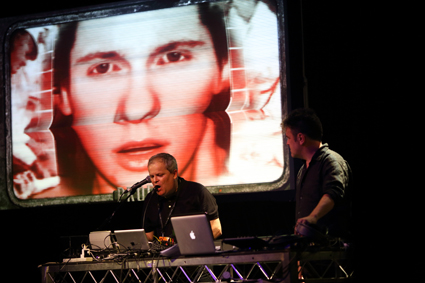
Severed Heads
photo Tony Lewis, courtesy Adelaide Festival 2013
Severed Heads
“Everyone is Beautiful in a Free World (Terms and Conditions apply)”—so goes the title of legendary post-punk/techno/industrial (what do these terms mean?) Australian band Severed Heads’ opening number in the breathtaking concert for which they re-formed—for what they declare is one last time. Their satirical but danceable music portrays a dystopian world of machine-like, futile human life, ruled by unseen (commercial) forces. Their set included the hits “Hot with Fleas,” “Profit,” “Petrol,” “Pilots Hate You (Obama mix)” and “Dead Eyes Opened.” Severed Heads’ 30-year career spans significant technological as well as musical development, and their songs are now remixed using updated technology, resulting in a cleaner, more refined sound, but sometimes recreating the characteristic sounds of old technologies such as slurred tapes. The stunning videos screened with the music are an essential component, and the Queen’s Theatre, recreated as a club-like venue, was the perfect location.
The performance was complemented by a downloadable computer game, core band-member Tom Ellard’s Hauntology House, hosted by the ABC website, which enables you to generate musical and visual material using simulacra of typical compositional devices such as laptops, radios, turntables and tape recorders. Users at home can mimic, in a game setting, what Severed Heads themselves do to create their work. This is a significant development in audience interactivity, but proficiency demands effort.
unsound—solaris
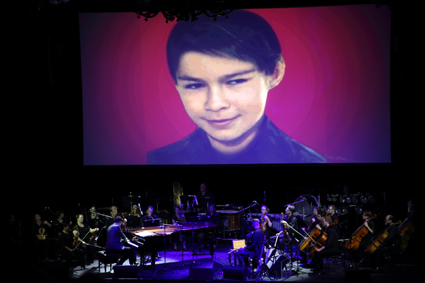
Solaris, Unsound
photo Tony Lewis, courtesy Adelaide Festival 2013
Solaris, Unsound
The Adelaide Festival brought to Australia the Krakow-based Unsound Festival, whose festival-within-a-festival included performances at the Queen’s Theatre and, as its central element, the staging of Ben Frost and Daníel Bjarnason’s co-composition Solaris at Adelaide Town Hall. Unsound commissioned Bjarnason and Frost’s version of Solaris to celebrate in 2011 the 50th anniversary of Polish writer Stanislaw Lem’s novel Solaris (see Gail Priest’s discussion of this work, RT103). Scored for strings, percussion, prepared piano, guitars and electronics, it is performed with Brian Eno and Nick Robertson’s video that uses still images of characters from the 1972 Andrei Tarkovsky film based on Lem’s book and also Pieter Brueghel’s painting, The Hunters in the Snow (1565), which Tarkovsky featured in the film.
The music is slow and hypnotic, opening with an ethereal whisper of strings and with a flavour of ambient electronic music but greater textural complexity. The video is correspondingly dreamy, with imagery materialising out of a haze of pixels. The pixilation seems to metaphorise the sub-atomic structure of matter and the possible neuronal structure of the planet Solaris’ intelligent ocean that induces hallucinations, the music seeming to characterise such neurological processes. Frost and Bjarnason’s Solaris is not a remake of the film or its score but an attempt to capture the psychological essence of Lem’s book. While the central musical work in Tarkovsky’s film is a Bach chorale prelude for organ, theirs is more secular and leaves the listener unsettled, the dissonance suggestive of psychological disturbance or unresolved tension.
Unsound also included three nights of world-class music in the categories of experimental, dub, ambient, drone and their derivatives, with international acts including Demdike Stare (performing with a string ensemble including Zephyr Quartet), Tim Hecker, Actress, Hype Williams, Lustmord, Robin Fox, Pole and again Ben Frost, an unparalleled showcase that demonstrated the depth of musical development in this broad field and its influence on mainstream music.
This use of different rhythmic structures, performance techniques independent of human playing and the greatly expanded sound palette that typifies this kind of music has permeated contemporary composition. Melodic and harmonic structures and linear, thematic development with variations are much less emphasised. Composers draw on the widest range of devices, blending samples, field recordings and pre-recorded sounds with live performance, with both programmed and improvised elements, using looping and phasing, and producing scores for acoustic instrumentation as well as electronics. Frost and Bjarnason, for example, used computer software in developing the Solaris score. The musical product retains its distinctive character even when transcribed, say, for strings or a chamber ensemble. It’s eclectic, mixing tonality with atonality, foregrounding process, using quotation and irony and sometimes making social commentary, and it potentially appeals to a wider audience. And video is commonly part of the composition—the concert is an audio-visual experience that extends the tradition of pop-rock video for TV.
Unfortunately, many of the Adelaide Festival’s musical events lacked a printed program, so you couldn’t always know what was being played or even who was playing unless you were already familiar with the material.
stereopublic

Stereopublic (Crowdsourcing the Quiet), Jason Sweeney
photo Martin Potter
Stereopublic (Crowdsourcing the Quiet), Jason Sweeney
Contrasting with the rest of the Adelaide Festival’s music, Jason Sweeney’s Stereopublic was an absolute delight for its gentleness and its ability to make you think about sound and listen for it. Sweeney guides participants on a walking tour of city sites with particular sonic characteristics—a fountain, an elevator, a park, an office tower foyer, an underground car-park and so on. On commencement, he hands you a business card reading “please be quiet.”
Stereopublic is like a perambulatory version of John Cage’s 4’ 33”—you listen to ambient sound and meditate on the idea of silence—but it takes you beyond Cage’s concept in that you map the city’s quieter locations where you might escape the traffic and other noise, and you learn to listen to buildings and spaces, rediscovering the city sonically.
The Stereopublic interactive webpage invites you to identify quiet places and offers an iPhone app. This is relational art, from which a small community with a new awareness is born, each walking-tour group forming a bond in Trappist monk-like silence. Stereopublic offers a different and welcome kind of musical awareness.
The ABC recorded the Severed Heads concert in full and is hosting Hauntology House. Stereopublic will be in Perth in May and in Sydney in June 2013.
Adelaide Festival, 2013: Kronos Quartet and JG Thirlwell’s Manorexia, Thebarton Theatre, March 4; Severed Heads, Queen’s Theatre, March 13; Unsound Festival, Queen’s Theatre, March 14-16; Solaris, Ben Frost and Daniel Bjarnason with members of Adelaide Symphony Orchestra, Adelaide Town Hall, March 15, Stereopublic, Adelaide, Feb 27-March 17 and at www.stereopublic.net.
RealTime issue #114 April-May 2013 pg. 8
© Chris Reid; for permission to reproduce apply to realtime@realtimearts.net
THE RHYTHMS OF A FESTIVAL IN ADELAIDE ARE LIFE AFFIRMING. FOR SEVERAL WEEKS, THE CITY COMES TO LIFE, INFUSED WITH ENTHUSIASM FOR THE ENERGIES OF ART. BUT THEN IMAGINATIONS, ONCE SO ENLIVENED, BECOME EXHAUSTED. THE VENUES FADE TO BLACK AND SOUNDS TO SILENCE. ‘IN THE MIDST OF LIFE’ WE LIVED IT UP; IN THE FALLOW WEEKS THAT FOLLOW, ‘WE ARE IN DEATH.’
Yet this year, in the midst of celebration, the tragedy of theatre was often felt. Violence, injury and trauma, physical and psychological, and death inflicted upon others in crimes of passion and times of war—these were the tropes of David Sefton’s wide-ranging theatre program, his first as festival director.
the kreutzer sonata
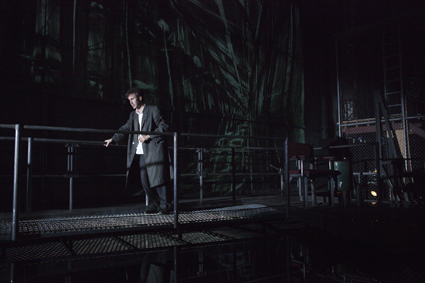
Renato Musolino, Kreutzer Sonata, Scenic Workshop, STCSA
photo Shane Reid, courtesy Adelaide Festival 2013
Renato Musolino, Kreutzer Sonata, Scenic Workshop, STCSA
In some productions, the forces that these tropes unleashed were threatening and chaotic. The Kreutzer Sonata, an ambitious staging of Leo Tolstoy’s novella, directed by Geordie Brookman for the State Theatre Company of South Australia, sought the passion of Beethoven’s music to elevate the artistry of Tolstoy’s tale about a husband’s jealous murder of his wife. Rehearsing the grim misogyny and self-delusion of the narrator from the constructivist depths of the State Theatre’s Scenic Workshop exhausted Barry Otto, who withdrew before opening night. The production forged ahead with Renato Musolino bravely taking on the role. Women in the audience, old enough to be his mother, found moments of release as the actor delivered the invective. Would they have done so if the part were delivered by an actor of their husbands’ or fathers’ generation? Geoff Cobham’s architectural lighting and the hand-etched artistry of Chris Petridis’ video design were majestically expressive. But the production’s rationale was all but broken.
doku rai
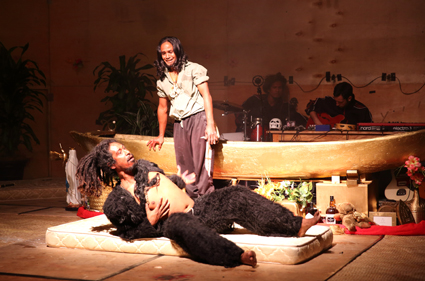
Doku Rai, Black Lung Theatre & Whaling C0mpnay, Liurai Fo’er and Galaxy
photo Tony Lewis, courtesy Adelaide Festival 2013
Doku Rai, Black Lung Theatre & Whaling C0mpnay, Liurai Fo’er and Galaxy
A four-year collaboration between the young men of Liurai Fo’er and Galaxy from Timor-Leste and the Melbourne-based Black Lung Theatre and Whaling Firm shook the gutted shell of the Queen’s Theatre with grubby violence, ritual slaughter and rock music. With the nation’s history of guerilla warfare, the colonial legacy of Catholicism and, now, the charity-capitalism of back-packing opportunists, Doku Rai re-enacts the story of a dead man, who is killed 77 times and never dies. Anarchistic energies, distilled from ritual mateship in a drinking circle, strut out on stage with the rock-star pride of fighting roosters and slash through our contemplation, balls in one hand, machete in the other. The production style is raw, and its surfaces are rough-and-ready. The meanings of its dialogue (much of it sur-titled) are without precedent. The violence stretches empathy to breaking point, way beyond the beneficence of, say, Katherine Thompson’s Mavis Goes to Timor (2002). (Female artists have largely been excluded from the making of Doku Rai.) But neither does the work resolve upon the sacrifice of white-man-journalist-as-hero that drove the film Balibo (2009), from which this collaboration emerged. There are risks in unfolding for an audience a process so unfinished, but the invitation is to witness the clash of collaboration. The provocation is to overcome our disbelief. Although in Doku Rai the killings are documented on video, the work is subtitled: “You, dead man, I don’t believe you.”
kamp
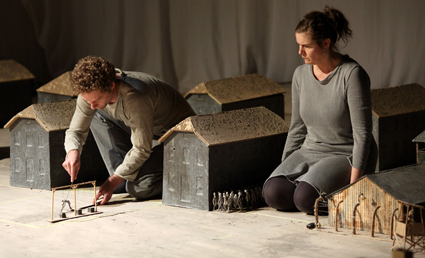
Kamp, Hotel Modern
photo Tony Lewis, courtesy Adelaide Festival 2013
Kamp, Hotel Modern
Two European productions delivered death in more methodical ways. Hotel Modern’s Kamp from the Netherlands is a puppet show in which three performers animate a scale model of a Nazi concentration camp. The model filled the entire floor of the Festival Centre’s Space Theatre. Dormitories are arrayed in a grid formation, with guard towers and sections of barbed wire fencing and a train track that delivers load after load of prisoners. Crowds of tiny puppets in striped pyjamas are processed through the camp. Their clay heads and distorted faces bear silent witness to their terror. Their bodies are given action by the puppeteers; their actions are magnified with live projection from a handheld video camera and amplified with sounds of excruciating realism. The scene is bleak. A prisoner scrapes at the earth, another drags a fallen inmate across the yard. The guards survey the inmates from the tower, beat a fallen prisoner and chase another into an electric fence. The camera takes us inside the building where guards gas the prisoners and burn their bodies in the furnace. In another shot, we fly across a mass grave of the dead to arrive at one who is not dead yet. These up-close shots are so disturbing that the closing image of inmates sleeping in a dormitory is calming in relief. But it is the remote view that persists. Across the model camp, the scale of its operation mutely obliterates an individual capacity to care.
nosferatu
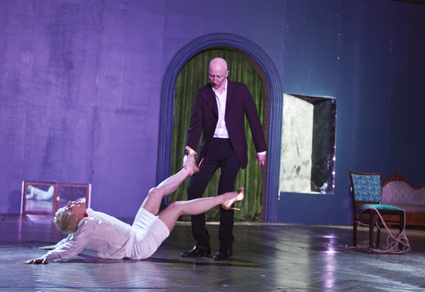
Nosferatu, TR Warszawa, Teatre Narodow
photo Shane Reid, courtesy Adelaide Festival 2013
Nosferatu, TR Warszawa, Teatre Narodow
Nosferatu from Poland’s TR Warszawa and Teatre Narodowy likewise took a methodical approach to reviving Bram Stoker’s ‘myth that will not die.’ On a spacious set with measured speed, Grzegorz Jarzyna directed an ageless cast of characters. Nervous men and languid women animated a series of dramatic tableaux. The production recalled a period when medical science could extend the life of fantasy, when extending life itself was beyond reach. The actors in Nosferatu conveyed feeling with commitment, yet their absorption in their performance removed the drama from our world.
beowulf
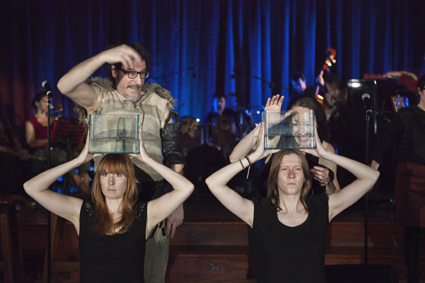
Beowulf—A Thousand Years of Baggage, BBB (Banana Bag & Bodice)
photo Shane Reid, courtesy Adelaide Festival 2013
Beowulf—A Thousand Years of Baggage, BBB (Banana Bag & Bodice)
By contrast, the beer hall at the German Club, with its laminex tables, vinyl chairs and open bar, gave artists from two companies an opportunity to connect. A ‘songplay’ from BBB of the USA, Beowulf revived the Anglo-Saxon battle saga for an audience well equipped to recognise the cartoon-bribery of its satire. The work is testament to Brecht’s legacy in American theatre education. A story with ‘a thousand years of baggage’ makes theatre with a message to unpack. Scholars’ notes intact, two women frame the work ironically in post-feminist critique, so that another two can sex it up with back-up singing and go-go dance-burlesque. An impressive klezmer-fusion band of seven pieces plays on, while the boys play out the battles between Beowulf and the monster Grendel. Their nerdy over-acting is melancholic for warrior rites now lost, and they encourage laughter at the monster-mother’s grief.
the strange undoing of prudencia hart
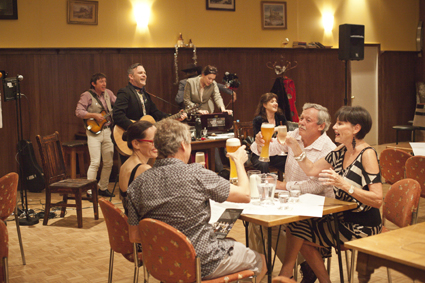
The Strange Undoing of Prudencia Hart, National Theatre of Scotland
photo Shane Reid, courtesy Adelaide Festival 2013
The Strange Undoing of Prudencia Hart, National Theatre of Scotland
The National Theatre of Scotland also drew us into an encounter with mortality at the German Club. They promised “an evening of anarchic theatre” which they delivered, not with mock-ironic violence, but with homespun, hand-made charm. The company of five performers travels light. Each an actor, singer and musician, they play among the audience, under the house lights. They make music without amplifiers and create effects without a lighting desk. The opening scene—a snowstorm flurry created by the audience tossing torn-up paper serviettes—was beautiful, both as an immersion in the performance and as permission to participate. The Strange Undoing of Prudencia Hart is superbly told in song and rhyming couplets, silly and sublime. An earnest folklore academic, snowed in at a conference, spends the evening at the pub where karaoke renditions have supplanted folk traditions, and the manager of the B&B hoards a library underground with every book on Scottish folklore—except Prudencia’s, of course. Her undoing, in the end, is our deliverance, warmly willed with pop songs, football chants and love.
ontroerend goed
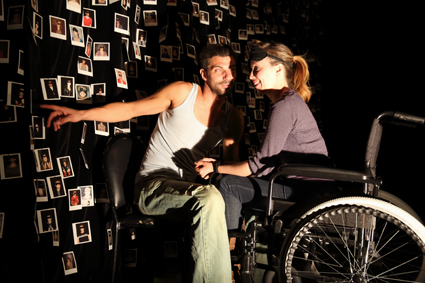
Smile off Your Face, Ontroerend Goed
photo Tony Lewis, courtesy Adelaide Festival 2013
Smile off Your Face, Ontroerend Goed
What passes between us in performance is often the look, the touch, the tragedy of life and love. That was the message hand-delivered by three performances—The Smile Off Your Face / Internal / A Game of You—from the ensemble Ontroerend Goed of Belgium. Strictly speaking, these are experiences rather than performances. They are elaborated in intimate sequences of encounter, processed along assembly lines of affect that progressively reveal their means of propagation. Intense with aspirations for individual revelation, yet designed with care to handle the delusions of self-projection, their performances worked in darkness on reflection, tapped into inner glow, and lived beyond the moment in the after-life of emotion.
Adelaide Festival 2013: The Kreutzer Sonata, by Leo Tolstoy, adaptation Sue Smith, director Geordie Brookman, Scenic Workshop, STCSA, Feb 27-March 17; Doku Rai—You, dead man, I don’t believe you, The Black Lung Theatre and Whaling Firm, Liurai Fo’er and Galaxy, Queen’s Theatre, Feb 28-March 4; Kamp, Hotel Modern, Space Theatre, March 12-17; Nosferatu, director Grzegorz Jarzyna, TR Warszawa and Teatre Narodowy, Dunstan Playhouse, March 14-17; Beowulf—A Thousand Years of Baggage, BBB (Banana Bag & Bodice), German Club, March 11-16; The Strange Undoing of Prudencia Hart, National Theatre of Scotland, German Club, March 1-9; The Smile Off Your Face / Internal / A Game of You, Ontroerend Goed, STCSA Rehearsal Room, Adelaide, Feb 28-March 17
RealTime issue #114 April-May 2013 pg. 10
© Jonathan Bollen; for permission to reproduce apply to realtime@realtimearts.net
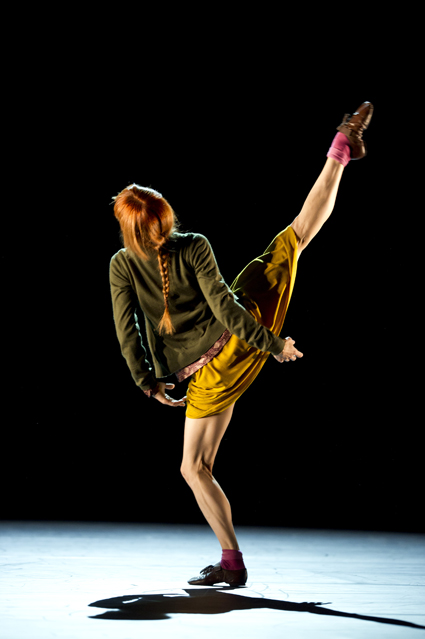
Sylvie Guillem, Bye, 6000 miles away
photo Bill Cooper
Sylvie Guillem, Bye, 6000 miles away
I MANAGED TO CATCH A HANDFUL OF SHOWS AT THE 2012 ADELAIDE FESTIVAL INCLUDING LAURIE ANDERSON’S QUIETLY PROVOCATIVE DIRTDAY! AND SYLVIE GUILLEM’S SUBLIMELY ENGROSSING 6000 MILES AWAY.
Brink’s Thursday, although flawed, impressed in the end, Larissa McGowan’s Skeleton was a favourite and the Australian-Timorese co-production Doku Rai a remarkable cross-cultural experience (enhanced by the brutally tropical conditions provided by the Queen’s Theatre). Each of these works in one way or another unsettled my emotional, cultural and physical centres of gravity.
sylvie guillem, 6000 miles away
In Jiri Kylian’s 27’52” two huge quartz halogen lamps spot the floor: in one a reclining male dancer, in the other a woman emerging from beneath a pale, heavy cloth. They dance in their own worlds until he enters her space, reaches to touch her and is twice repelled as if electrocuted. His hand placed on her head appears to contain her and the pair enter into a series of brisk entwinings, simpatico undulations and balletic lifts. She retires to the cloth; he solos, creating a line across the blue-lit stage on which he alternates fluid and sharply angled moves at a gentle pace, falling to the floor before turning to the woman, lifting her, now like him naked to the waist, into a beautifully sustained contemporary pas de deux. The sense of the two being at one is ruptured when she suddenly runs away from him. He surrenders his chase, lifting and disappearing under a black cloth. She returns to find him gone, runs in the opposite direction and likewise disappears. Wonderfully performed by Vaclav Kunes and Natasa Novotna, 27’52” embodies the Kylian vocabulary but with passages that speak of more recent dance languages while evoking fragile coupledom.
Sylvie Guillem and Massimo Murro execute William Forsythe’s challenging Rearray with apparent ease without ever surrendering its inherent sense of abstract drama in the choreography and David Morrow’s modernist score (piano, strings, feedback). The astonishing lighting (Rachel Shipp), best seen from the dress circle, patterns the floor in subtly shifting lines of ever merging and dissociating lines of metallic blues and greys on which the duo sortie, tangle, embrace and lock in glorious off-centre Forsythian configurations that hold when they should fall. Together and apart Guillem and Murro excel, their realisation of Rearray proof of the power and beauty of Forsythe’s radicalised ballet formalism.
The third work on the program was Matt Ek’s Bye, a dance theatre solo for Guillem which she performs with her own and other virtual selves to a recording of Beethoven’s Piano Sonata 111 played almost jazzily by Ivo Pogorelich. The lighting is again geometrical, a flow of rectangles and circles on which Guillem in girlish demeanour hyperactively bounces, rocks, walks on all fours and jettisons cardy and socks until stalled by the image of a man on a centrestage mirror-like screen. He disappears. She executes a headstand. A dog appears on the screen. Curious, Guillem investigates and finds herself there—but discovers it’s at once her and not her, synced at first and then not. As she mock hip hops, struts flatfooted, shoulders up and then headstands again, a crowd gathers on the screen, likewise curious about her. Cardy and socks on, Guillem merges with new companions. Bye is an odd little parable but as dance, and dance magically engaged with new media, it’s fascinating, revealing a comically characterful Guillem persona and steps we’ve rarely seen from her.
brink & english touring theatre, thursday
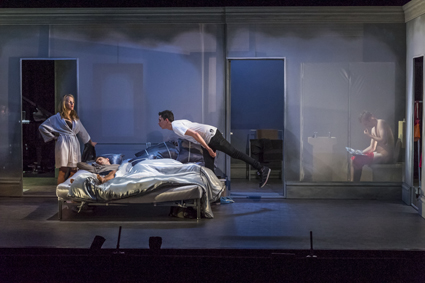
Thursday, Brink Productions and English Touring Theatre
photo Chris Herzfeld, Camlight Productions
Thursday, Brink Productions and English Touring Theatre
Thursday is built on an interesting conceit, transparency—the walls of the set are see-through, characters in different scenarios assemble in the one space simultaneously (as in Benedict Andrews’ account of Patrick White’s The Season at Sarsaparilla) and the inner thoughts of characters are delivered by others (“You’re thinking….”) while standing next to them. The latter was irritating, the audience struggling to get a handle on who’s who in the far too protracted opening of the play where ordinary lives are made transparent—and clearly permeable as relationships play out and overlap. The effect is unfortunately expository and soon overcrowded with supplementary scenarios. That said, once the pedestrian everyday and the horror of the terrorist bombing (London, 2005) are out of the way, Thursday becomes an engaging experience as various synchronicities play out, if sometimes melodramatically, and the characters grapple with profound loss, breakdown and disability.
The sense of a disaster reaching far beyond individual suffering is enhanced by the interplay of a large number of characters and the unfolding of inner lives (if sometimes awkwardly written and structured) within Bryony Lavery’s limits when it comes to psychological insights (as in Stockholm, 2008). There are some loose ends. Having been so firmly established, Paul Blackwell’s conservative Lionel is presumably killed in the blast; it would have been more telling had he lived to grapple with the aftermath. All that aside, Thursday is finally heartfelt and moving, strongly performed with ensemble unanimity by a mixed Australian-British cast and, for such a discursive work, tautly directed by Chris Drummond. Thursday grew on me, but if it is to have further life the extended opening needs to be more cohesively built into the balance of the play.
black lung & whaling firm, liurai fo’er & galaxy, doku rai
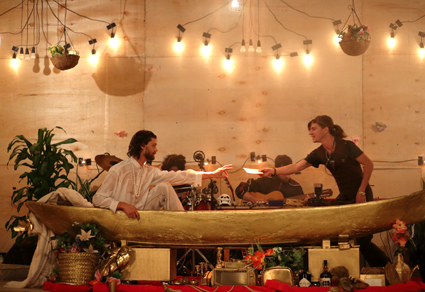
Black Lung & Whaling Firm, Liurai Fo’er & Galaxy, Doku Rai
photo Tony Lewis, courtesy Adelaide Festival 2013
Black Lung & Whaling Firm, Liurai Fo’er & Galaxy, Doku Rai
Briefly, because Jonathan Bollen reviews Doku Rai on page 10, I wanted to add how engrossing this Australian-East Timorese co-production (a tauter re-working of the original; RT111, p38) was, a ritualistic and intensely theatrical account of the dangers of superstition when entangled with power—colonial, tribal and familial. This is raw theatre, rich in barely contained symbolism, music, gruesome comedy and acting rough and subtle. The central crime, the murder of a brother using a deliberate misreading of a prophesy, results in the victim being resurrected and killed over and over again, until the horror and exhaustion of it all for victim and assassin, and audience, is stilled when the actor playing the victim tells us that his family was murdered and that he dies a death every day. All the power of Doku Rai (“dead man I don’t believe you”) distills in this moment, one that haunts me still.
larissa mcgowan, skeleton
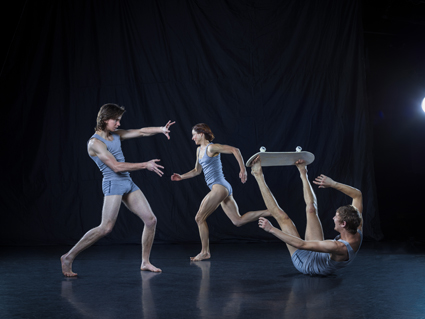
Tobiah Booth-Remmers, Lisa Griffiths, Lewis Rankin, Skeleton
photo Chris Herzfeld, Camlight Productions
Tobiah Booth-Remmers, Lisa Griffiths, Lewis Rankin, Skeleton
Accidents apparently happen in threes. Dancer-choreographer Larissa McGowan’s Skeleton is a dance theatre reverie-cum-nightmare in which the fragility of the human skeleton is subjected to instruments of popular culture (skateboards, bmx bikes, high heels, baseball bats, action films and noise-reducing headphones). Accident scenes are cyclically revisited with increasing intensity. Cultural objects are rendered utterly iconic—chalk white fetishes, as they are in the works of visual artist Ricky Swallow, one of McGowan’s inspirers.
As human scale black boxes-cum-screens automatically crisscross the stage they deposit these items on which we rest our gaze. First we see a skateboard, and then, in another pass, a man frozen in time, tilted forward on the board. Shortly we see him roll out, in slow motion, from a black box in a damaging tumble accompanied by the sound of an almighty crash rising out of Jethro Woodward’s dynamic, pop culture saturated score. With other accidents we sometimes see the damage first: the order of cause and effect is not always obeyed, heightening the sense of obsessive reflection on a traumatic moment.
The images of the man and skateboard are typically punctuated by others in a world where people appear to be ephemeral and replaceable. At worst they relive their accidents. A man (Louis Rankin) wearing large white headphones, is hit violently on three different occasions by a rushing passerby. A woman (Lisa Griffiths), appears, locked in muscle seizure. McGowan lifts her rigid frame and attempts to manipulate her back into shape. Later we’ll see Griffiths with the bike, folding herself, possibly lovingly, into it in various positions, one of which will become this rigor-mortised condition.
Manipulation of the damaged body is a significant motif in Skeleton. After our initial sighting of the writhing McGowan, she shortly reappears being extensively manipulated by a male dancer to sharp electric jabs heard in Woodrow’s score. What first appears helpful becomes threatening, in an extension of the motif, as the male repeatedly, in near slow motion, hits McGowan’s jaw.
This world of gliding black boxes depositing and disappearing humans and objects is scarily fast, but there is a telling, relatively slow and sustained scene that heightens the joint themes of damage and care. To a melancholy strain from Woodrow, Tobiah Booth-Remmers rolls and shapes the rigid Griffiths with increasing aggression, as if irritated by her body’s unresponsiveness. She suddenly softens, grabs his leg; he falters and crumbles. Sitting, she creates a push/pull pieta, drawing him softly into her lap only to repel him and then draw him back.
It’s the final stage of Skeleton where the work—after too many action scenes which emphasise popular culture’s invitations to risk-taking and thrill-seeking—achieves the thematic fruition that McGowan and co-director Sam Haren were doubtless aiming for with the completion of the ‘damage and care’ motif and now an evocation of not just the breaking of bones, but also the smashing of icons. We see the front wheel of the BMX shatter into plaster—this at last is Griffiths’ accident. The skateboard appears, shockingly, to crack of its own accord. The high heeled shoe, so delicately approached and negotiated by McGowan rolling, turning and slipping into it, crumbles beneath her. It’s as if, a la the dromology (the science or ‘logic’ of speed) of Paul Virilio, each of these instruments (they are all technologies—even the bat offers prosthetic reach) incorporates its own accident, damaging itself and its user. Louis Rankin, though, reminds us that the skeleton is likewise a piece of fragile technology as a rush of plaster pieces tumble from his t-shirt. After a final burst of violent energy the dancers, left only with the culture of fight, all fall down.
McGowan’s first major work reveals intelligence, thematic integrity and a potent sense of theatre magic, if at times the desire to amuse risks undercutting Skeleton’s seriousness, expressed most strongly in the ambivalence portrayed concerning our attitude to the pain of others—its meaninglessness in action films, and the tension between concern and denial in reality, yielding even cruelty. The design of Skeleton allows McGowan and her collaborators to replay and review, cut and paste the pleasures and traumas of youth with a three-dimensionality and physical and lo-tech immediacy still beyond the reach of digital media. The Skeleton team have made an analog machine for reflection, albeit one with all the speed and rapid cutting of its digital peers.
See Keith Gallasch’s full review of Skeleton as well as Carl Nilsson-Polias’ response as part of RT’s Dance Massive coverage.
–
Adelaide Festival 2013: Sylvie Guillem, 6000 Miles Away, Festival Theatre, March 1-4; Brink Productions & English Touring Theatre, Thursday, writer Bryony Lavery, director, dramaturg Chris Drummond, designer Dan Potra, Norwood Concert Hall, Feb 20-March 16; Black Lung & Whaling Firm, Liurai Fo’er & Galaxy, Doku Rai, direction, design Thomas M Wright, remount directors Thomas Henning, Melchior Dias Fernandes, Queen’s Theatre, Feb 28-March 4; Skeleton, choreographer Larissa McGowan, directors Sam Haren, Larissa McGowan, AC Arts Main Theatre, Adelaide, March 2-9
RealTime issue #114 April-May 2013 pg. 11
© Keith Gallasch; for permission to reproduce apply to realtime@realtimearts.net
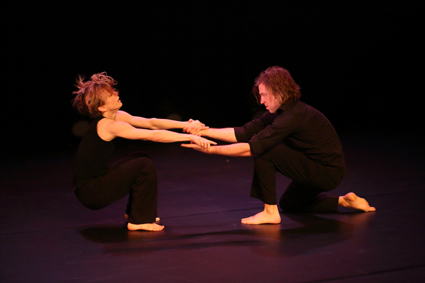
Louise Lecavalier, Patrick Lamothe, Children
photo Tony Lewis, courtesy Adelaide Festival 2013
Louise Lecavalier, Patrick Lamothe, Children
THE 2013 ADELAIDE FESTIVAL’S STRONG DANCE PROGRAM INCLUDED SYLVIE GUILLEM, LOUISE LECAVALIER, WIM VANDEKEYBUS’ ULTIMA VEZ, A FLAMENCO PROGRAM DIRECTED BY CARLOS SAURA AND THE PREMIERE OF A WORK BY EMERGING AUSTRALIAN CHOREO-GRAPHER LARISSA MCGOWAN. ANNE THOMPSON LOOKS AT THREE OF THESE, REFLECTING ON DANCE LANGUAGES, SKILL AND ENDURANCE AND ISSUES OF CULTURAL AND AESTHETIC FRAMING. (SEE P11 FOR RESPONSES TO GUILLEM AND MCGOWAN, EDS.)
louise lecavalier
Louise Lecavalier is formidable at 50—muscular, assured, capable of great nuance and completely at the centre of both works, Children and A Few Minutes of Lock. There is familiar vocabulary from Lecavalier’s time with Édouard Lock’s Canadian company La La Human Steps: the primal high crawl at speed, the decisive manipulation of an object (in this case pillows and a pole), fragments of ballet (fancy foot work, soft arms, stated arabesques), high velocity horizontal and vertical leaps, gestural partner work (expressing both tenderness and violence), forward and rewind, all performed with throw-away casualness.
Children is set against musical tracks that locate the piece in Lecavalier’s era. We move from the likes of Leonard Cohen to Miles Davis to Billie Holliday (to name a few) through to a Puccini climax; all songs of love and longing. Then there is the sound of children playing and later crying. The program note points us to conceive of the dancers (and ourselves) as children with the longings of children. This longing is represented with great irony and control. The impact of the determined and exact physicality in the piece has more to do with an experience of endurance and stamina. There is something poignant in that determination in the face of want.
A Few Minutes of Lock has Lecavalier suspended and moving in relation to two men. Occasionally they break out into moves of their own. There is dainty peripheral fluttering of feet and hands, daring catches, huge propulsion from small impetus. This is not about the simple meaning of weight and momentum. There is showmanship here, flair, even when the movement is again throw-away. Meaning is again produced in the assured relentlessness of the display. The intimate venue allowed us to breathe with Lecavalier, not just watch her convincing puppet-like performance. The music of Iggy Pop was featured in this piece. I remembered La La La Human Steps collaborating with David Bowie. There’s something of the rock star in Lecavalier strutting her stuff and I can’t help but admire her tenacity.
ultima vez
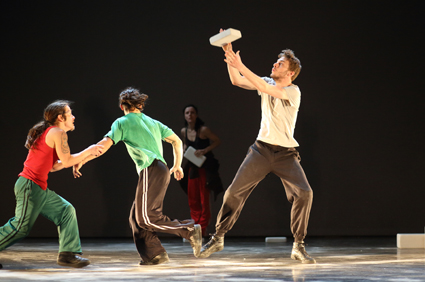
Ultima Vez, What the Body Does Not Remember
photo Tony Lewis, courtesy Adelaide Festival 2013
Ultima Vez, What the Body Does Not Remember
What the Body does not remember is a recreation of the seminal 1987 work. I enjoyed the disjunction between choreographic methods I associate with the late 70s and 80s (task work with objects and sound familiar to me from American postmodern dance) and these strong and varied European bodies (the favoured look of contemporary dancers now). The work is still charged. But when I leave my heart is pounding. I am disquieted by the European sensibility applied to this task work, taking it to an extreme both in duration and in terms of skill and danger. The sporty playfulness evident in American task work and a form like contact improvisation is absent.
Images surface despite the concreteness of the tasks. Lying, ‘sleeping’ bodies react/shift in response to loud noise, a dancer drumming a miked table (later I think of this as a guard and prisoners). Then dancers seek to traverse the space on different sized blocks using them as stepping stones. The game gets increasingly complex and dangerous. The blocks are thrown and caught (near misses occur); complex, precarious structures are built and balanced on, dancers leap and run and change position with each other (the image for me is of children playing in rubble). The skill of the performers is breathtaking.
Then we watch a long sequence of putting on and stealing towels and coats. The benign image of wrapping one’s hair in a towel and having the towel stolen is troubled by the recurring image of putting on a coat only to have it taken from you.
Then the games get gendered. A man tries to touch a woman’s knee; another man tries to touch a woman’s hair. The women stamp to rid themselves of the attention. The pursuit is relentless. This turns into a disturbing game of men feeling women’s bodies while the women stand legs wide, arms stretched out at shoulder level, reminiscent of the posture and action of security checks. The women move to escape and are caught. They return again and again to stand outstretched, available to be searched. The image drifts towards and away from the erotic and the pornographic—my sense of the agency of the women determining my response.
A more innocent game of orientation follows—a man sitting on a laid-down chair changing positions and a woman sitting on a chair standing up mirroring his moves. This evolves into a series of photos with the whole company. Three solos by dancers blowing a feather up and letting it float down allow us to rest in some depiction of innocence.
There are other structures but the finale is a game of one dancer stamping near another who is lying down. The one lying responds by curling and uncurling. As the pace, duration and proximity of the stamping increase so does the danger. The stamping is fierce. There are also solos of stamping apart from the lying bodies. This extended sequence is violent, eloquently violent.
The performers do not use facial expressions to suggest what our attitude might be to what is happening. Meaning is all in the movement. This is performance as finally brutal. We are lured there by the pleasure of watching the performers’ skill at tasks and games.
carlos saura
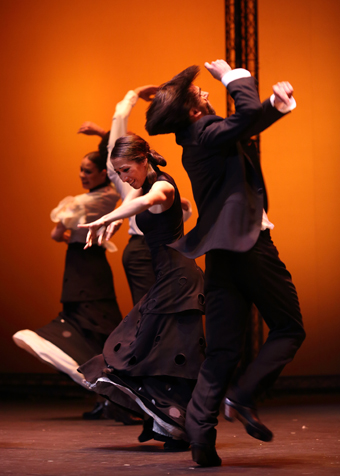
Flamenco Hoy
photo Tony Lewis, courtesy Adelaide Festival 2013
Flamenco Hoy
This was a strange ‘concert’ in the grand Festival Theatre. The evening consisted of discrete items—pieces with the company of dancers, solos created by choreographers Rafael Estévez and Valeriano Paños, guitar solos and accompaniment by Antonio Rey sometimes with other musicians, piano solos and accompaniment by Chano Dominguez and singing by Sandra Carrasco, Blas Córdoba and Israel, sometimes alone and sometimes as accompaniment to dancing. Costumes are changed, screens are moved to delineate space and lights in bold colour illuminate each piece. The entire event is directed by Carlos Saura who so masterfully used flamenco as a theatrical language on film in the 1980s with Bodas de Sangre (Blood Wedding), Carmen and El amor brujo. Here it is hard to discern his hand. I notice that the producer tours rock groups and opera productions. These aesthetic and production values dominate and prevent consistent immersion in the physicality, rhythm and sounds of this form.
The skill of all the artists is exquisite. I find myself relishing the moments which seem improvised. The solos have that feel. I am reminded of tap or hip hop solos, of someone dancing at the peak of their skill level and in response to rhythm and music. The singing has a rawness of tone that is thrilling, close to calling or wailing. The section where a number of solo dancers worked with different solo singers finally drew me in to some space of performance not constrained by the production. The engagement between the singer and dancer was electric and robust like a great jazz duet.
I read in the program that the Flamenco vocabulary used by these choreographers has been modified with jazz and contemporary influences, even ballet. I could sense that. There was an unexpected looseness to the bodies at times, a breaking away from and returning to the strict Flamenco frame. There was also ballet virtuosity. I could hear the influence of 20th century composers such as Bartók in the piano compositions and hints of jazz in the guitar pieces. All of these developments were enticing.
I am not versed in this dance style so I found myself seeking cues as to how to watch any differently than as a tourist, as somehow separate but with investment in the piece delivering something I want; in this case, some drama. The production spoke of cultural trading in a way I rarely see in international festivals these days; the products of a culture delivered in a commercial form but made ‘contemporary’ as befitting an arts festival through incorporation of recognisable cultural influence from some cultural power (in this case, the United States). I am used to trade deals being less visible and thus making the work more comfortable for me to be part of as a member of an ‘educated arts audience.’ This was a timely reminder of what is always at stake even when I choose not to notice.
Adelaide Festival 2013: Louise Lecavalier, Children, choreographer Nigel Charnock, dancers Louise Lecavalier, Patrick Lamothe; A Few Minutes of Lock, choreographer Édouard Lock (excerpts from Salt and 2), dancers Louise Lecavalier, Keir Knight, Patrick Lamoth, Space Theatre, March 6-9; Ultima Vez, What the Body Does Not Remember, direction, choreographer, scenography Wim Vandekeybus, Dunstan Playhouse, March 7-10; Flamenco Hoy, director Carlos Saura; Festival Theatre, Adelaide, March 15, 16
RealTime issue #114 April-May 2013 pg. 12
© Anne Thompson; for permission to reproduce apply to realtime@realtimearts.net
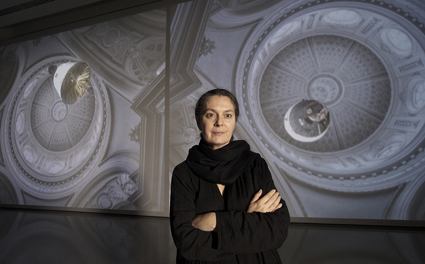
Grazia Toderi with Orbite Rosse (Red Orbits)
photo Toni Wilkinson
Grazia Toderi with Orbite Rosse (Red Orbits)
PERTH AUDIENCES WERE BLESSED WITH THE THEME OF LIGHT FOR THE 2013 EDITION OF THE INTERNATIONAL ARTS FESTIVAL WITH A SPECTRUM OF ILLUMINATION WORKS RANGING FROM PROJECTION TO INSTALLATION.
The array of light manipulations on display took me back to somewhere in the depths of Norway, where underground runs the longest road tunnel in the world, the Lærdal Tunnel. This feat of engineering has a curious surprise embedded in its depths. Just as the driver is slipping into somnolence and fearing having entered a time warp, a dreamy bluish speck appears in the distance. As it grows it is easy to wonder if it is a portal to another dimension and when it swallows you up, twin feelings of wonder and disappointment envelop you. All the immersive delight in the mystery of the light source is dispelled, revealed as a simple effect designed to ease monotony and potential claustrophobia. It does not, after all, indicate the final radiance you might observe before being split into several billion particles and recombined some place alien.
This experience illustrates one of the defining features of light. It has an inherent mystery to it, yet it is also that universally familiar stuff that signals the beginning of a new day and artificially illuminates our nights. It has a remarkable range of qualities, from bright to dull, searing heat to ice cold. Whether we squint at the sun or follow a flitting firefly, light is that elusive electromagnetic radiation that can be a substance of both spectacular intensity and delicate subtlety. This broad potentiality of light was revealed in the Perth Festival.
jim campbell, scattered light
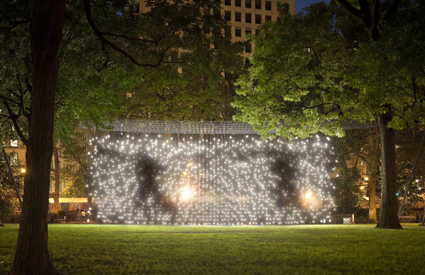
Scattered Light, Jim Campbell
photo James Ewing
Scattered Light, Jim Campbell
American media artist Jim Campbell is a technically innovative tinkerer. For Scattered Light (2010), on display in the Kings Park gardens, Campbell has hung a three dimensional ‘screen’ of over 1,600 light bulbs that presents the viewer with more than first envisaged. Each bulb is carefully engineered with an LED fixture and strategically positioned to be on or off according to a programmed video sequence. A shadowy scene of passers-by in New York’s Grand Central Station crosses the lights. Their bodies are fuzzy close up and defined from a distance, yet each point of observation has its own qualities—whether crisp resolution is desired or the more hypnotic qualities of being confronted by an army of bulbs, with such curious details as the odd bulb seen gently couched in the lush green grass. (See the interview with Jim Campell, RT112, p6.)
luminous flux
Campbell also has a work at the Lawrence Wilson Art Gallery, Motion and Rest #4 (2002), in the group exhibition Luminous Flux. It is a scaled down and simplified version on the same theme, with the added pathos of only limping figures traversing a small screen of LED lights. This exhibition is illuminated by not only LED, but by neon, fluoro, light box, projection and reflection pieces. The installation of the works recalls the logistics of Dome films which are most successful when they take on visually dark topics, like space or underwater. This is because brightness spills over to the other side of the screen and so dulls the overall clarity of the image. It is all too evident in Luminous Flux that spill is occurring and that most of the works would function better in pitch black.
Nonetheless the individual works are mesmeric once you enter within their glow. Rebecca Baumann’s Reflected Glory (2013) splashes onto the walls like effervescence in colour and light. It optimises a simple, low-tech effect of reflection from sundry materials—perspex, wrapping paper and mirror. If this were the sight glimpsed in the middle of a tunnel, it would certainly have one wondering if some raucous clandestine rave were underway.
ross manning, volumes
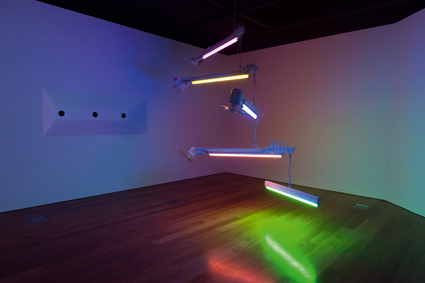
Ross Manning, Volumes, PICA, courtesy of the artist and Milani Gallery, Brisbane
photo Mark Sherwood, courtesy Perth Festival
Ross Manning, Volumes, PICA, courtesy of the artist and Milani Gallery, Brisbane
A similar reflection effect is apparent in the exhibition Volumes, by Australian artist Ross Manning at PICA. For his Dichroic Filter Piece (2012), a projector is used to shine black and white lines through diachronic glass placed on the ground. This, again, results in a spectacular, prismatic spill upon the walls, like the hard-edged version of soft rainbows scattered throughout a room by the sun’s rays passing through a hanging crystal. Manning is renowned for kinetic light installations and his other works in the exhibition combine circular movement, fans, coloured fluoros and ribbon, to create wondrous hanging, spinning and glowing contraptions.
grazia toderi
One of the most impressive exhibitions is by Italian artist Grazia Toderi at the John Curtin Gallery. Toderi is an artist adept at creating spectacular digital projections characterised by monumental scale and compelling ambivalence. They appear other-dimensional and earthly all at once; cities unfold as dense interstellar constellations with the line between earth and sky indistinct. The projections undergo digital manipulation, with light used as a compositional layering tool. For example, in her 2009 Venice Biennale work, Orbite Rosse (Red Orbits), a dual projection displays a nightscape of Turin as two orbs that slowly transform. Terrestrial and celestial mapping appear to converge in a seeming timelessness that unfolds at a carefully measured pace.
srinivas krishna, my name is raj
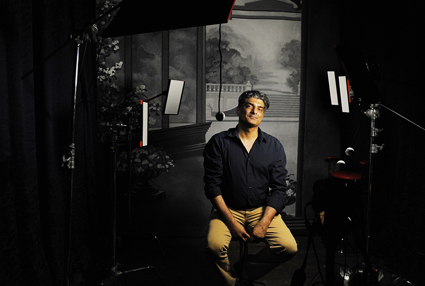
Srinivas Krishna with his work My Name is Raj
photo Toni Wilkinson
Srinivas Krishna with his work My Name is Raj
My Name is Raj by Canadian filmmaker Srinivas Krishna is like a donkey in a field of stallions, petite in stature, quaint and unique. Its oddity in the context of the theme may be attributed to the fact that it is not concerned directly with light, in the literal sense, but more with the idea of fame and the desire to be under the celebrity spotlight. As an interactive installation it plays upon audience narcissism and folds layers of cultural and historical references into one another—the proto-Bollywood films of Raj Kapoor, photographs of Kapoor starring in his own films in heroic and romantic poses, historical photographs of Indians superimposed in scenes of wealth and fantasy and a make-shift camera studio with an Arcadian backdrop. As audience member, you can catch a film and then fulfil your own wish for fame and glory by having a portrait taken and superimposed in a Kapoor film still, which then becomes your own personal keepsake.
When wielded effectively as a sculptural medium, light not only mesmerises, but also has a transcendental effect. I was compelled to drive through that Norwegian tunnel not once but two or three times simply to reach that immersive artificial wonderland that harmonised so sublimely with the natural wonderland of the fiords beyond. The exhibitions in this year’s Perth Festival each hinted at such an experience, where the combinations of light, colour, scale and form collude to take you, if only momentarily, somewhere else.
Perth International Arts Festival, Jim Campbell, Scattered Light, Kings Park; Luminous Flux, Lawrence Wilson Art Gallery; Ross Manning, Volumes, PICA; Grazia Toderi, John Curtin Gallery; Srinivas Krishna, My Name is Raj, Shopfront, Central Institute of Technology; Perth, Feb 8-March 2
RealTime issue #114 April-May 2013 pg. 13
© Laetitia Wilson; for permission to reproduce apply to realtime@realtimearts.net
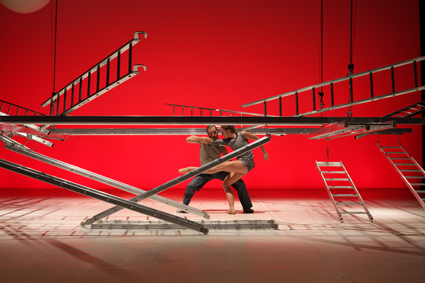
The Truth 25 Times a Second, Ballet National de Marseille
photo Pino Pipitone
The Truth 25 Times a Second, Ballet National de Marseille
IT WAS A CURIOUS, ALMOST DISSOCIATIVE MOMENT I HAD WHILE WATCHING THE PRETTY SPECTACLE THAT IS BALLET NATIONAL DE MARSEILLE’S THE TRUTH 25 TIMES A SECOND. INTO MY HEAD, UNBIDDEN AND UNEXPLAINED, POPPED THE PHRASE “ALL ART IS A LIE.”
Not an original thought, and not a very interesting one, but what most surprised me was that it didn’t seem mine at all. It certainly didn’t seem a poignant response to what was unfolding before me, and it took me a long while to unpack. As best I can understand it, now, it was a part of my mind protesting at the space between what it had been promised and what was subsequently delivered. And that promise was great.
the truth 25 times a second
The Truth is a collaboration between Belgian Frédéric Flamand and China’s Ai Weiwei, whose international renown is today inextricably bound up in his role as a national dissident. The performing ensemble breaks from ballet tradition in being heavily skewed towards male, which opens up much potential in terms of movement dynamics. And there’s the title: any work that invokes the troubled notion of “truth” in such a brazen fashion has some courage indeed.
That title itself is an allusion to Jean-Luc Godard’s famous proclamation that film is truth at 24 frames per second. As in much of the discourse around Ai, Godard was exploring the connection between art and politics, and the ability of the artist to explore the constructed nature of our reality and its connections with various forms of power. Updating the reference by one fps, presumably to incorporate the technology of video and its omnipresent use as a tool of surveillance, is a very suggestive move.
But what we get is some fairly standard live video capturing the onstage performance and beaming it onto a rear drop. There’s some pre-recorded footage of dancers in sterile urban spaces—a bathroom, an empty corridor—and an enlarged image of an eye that occasionally looks out toward the audience. There doesn’t seem to be much ‘truth’ under the microscope here, even in an ironic or negatory form. It’s almost as if the title was chosen because, well, it’s a nice quote.
As with so much of the work, the title seems closer to that notion of ‘truthiness’ [the term promoted by Stephen Colbert. Eds]. Everything has the sheen of meaning but the signifiers wind up unbound, untethered to anything but one another. The work draws inspiration from Italo Calvino’s The Baron in the Trees, another allusion that holds out the promise of Serious Art, but it’s hard to find any response to the novel here apart from a strictly formal one. People climb tree-like structures. Okay.
Ai’s contribution to the project is just as disappointing, but perhaps perfectly in keeping with its logic. The set is almost entirely composed of a series of interlocking ladders, many of which can be disconnected and rearticulated at different points. They form the aforementioned tree, are dragged like heavy wings behind a performer’s back, and at a stretch might draw associations with the frames of a strip of film, if we were dealing with film here instead of video. But after a time it seems that the combinatorial possibilities here are their own end, and we’re simply watching a game of ‘things you can do with ladders.’
The choreography itself is attractive, and again its formal aspects are perfectly admirable. The dancers are of an athletic variety and Flamand makes the most of this—perhaps a local equivalent would be ADT. It would be a satisfying affair if it weren’t for all that promise, which is even further reinforced by the hyperbole of the program notes. But it felt, in the end, as if a better fable to compare it to would be something about emperors and their attire.
duck, death and the tulip
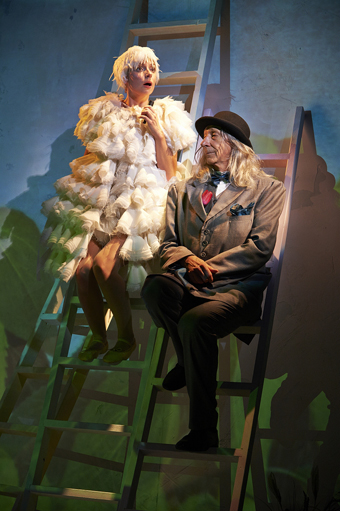
Death and the Tulip, Barking Gecko
photo Jon Green
Death and the Tulip, Barking Gecko
Take the other extreme. A few days later, speaking to a fellow critic about Barking Gecko’s Duck, Death and the Tulip, she exclaimed, “It didn’t lie!” It was a simple yet ideal rebuttal to that odd formulation that was still irritating my thoughts. Barking Gecko’s production doesn’t lie, and it makes for an astonishing piece of children’s theatre.
A duck lives out her days on a lake in quiet, carefree fashion until the handsomely-suited figure of Death arrives and introduces her to the very concept of mortality. He explains the various ways by which she might depart the world, but her infectious playfulness soon wins his affection and he spends the season in her company, holding back the inevitable. And then winter comes and the landscape freezes over, and the Duck dies and sinks beneath the waves.
There’s no lie. There’s no suggestion of an afterlife, no retreat into memory or the sense that the Duck’s death meant anything more than a duck’s death does. Nobody mourns, and death itself is presented for the dumb fact it is. From the faces of the younger children in the audience, this was an encounter that raised questions it refused to answer with comforting platitudes. There must have been some interesting conversations on the way home afterwards.
It’s a lavish production. A full band in white formal wear plays from an elevated spot at the stage’s rear, complete with Jazz Age half-shell footlights. Chris More’s projected backdrop is a subtle, painterly evocation of mountains and fields that shift gently across seasons, while a bathtub filled with rubber balls amply manages to suggest the lake in which much of the action takes place. Ella Hetherington’s Duck is energetic and mischievous and despite being wordless (she communicates through a duck whistle) never crosses into panto mode. As Death, George Shevtsov balances gravitas and dry humour.
None of this works to aestheticise the work’s central subject of mortality, however, to offer art as a soothing balm or fetish with which to keep death at arm’s (or wing’s) length. The final image is of Death returning to his lofty perch at the top of a ladder, surveying the land for the next creature he’ll be paying a visit. And so it goes.
la marea
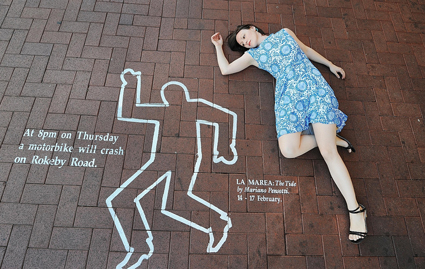
La Marea
photo Toni Wilkinson, courtesy Perth Festival
La Marea
As a celebration of life, there’s much to commend in Mariano Pensotti’s La Marea. Unfortunately it’s a celebration that takes place despite the piece, not just because of it: a length of street is transformed by a wandering audience who stumble upon any of a dozen vignettes played out on balconies, in shop windows and alleyways. There was something of a festival air, as all manner of strollers stopped to discuss the playlets with strangers, to offer conjecture or review. Many had happened upon the event by chance, and their curiosity added a frisson to the atmosphere.
But several logistical problems undermined the course of the evening. All of the scenes involved projected surtitles, as much of the text unfolded in the heads of each character, and in many cases the crowd gathered so close to the words that only 10 or so could read what was going on. For some sequences, sightlines were so narrow that only one or another player was visible to most.
The majority of scenes didn’t make much of their potential, either—given that so many were internal monologues by characters who were essentially static for their duration, thinking over their lives while sipping a drink or waiting for a date to show up, there was little impetus to look at anything but the text, when it was visible. It amounted to a series of short stories being read in public by a large crowd, which seems a let-down given the sheer scale of the event and the operational difficulties it presented. It was a hugely complicated production, but surprisingly lacking in complexity.
watt
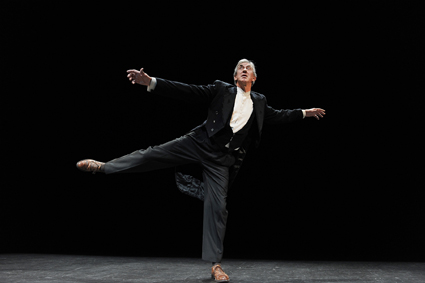
Barry McGovern, Watt
photo Toni Wilkinson, courtesy Perth Festival
Barry McGovern, Watt
The opposite can be said of Gate Theatre’s production of Watt. One performer, Barry McGovern, recites Beckett’s novella on an almost empty stage, floating on the silence between his words. There’s so little to look at that every button, every mote of dust caught in the spotlight, takes on great significance. McGovern’s performance is just as precise, as if a rollicking shaggy dog tale told by a veteran jester in a pub had been repeated so many times, for so many years, that every pause and stop has been honed to perfection.
McGovern brings just enough of the clown in Beckett to get the tone of his writing right; too many take the writer’s works as a cue to deliver heavy-faced existential despair, whereas the seriousness of the work lies in the conditions to which it reacts, not in the actions of his players. His characters may live in a unforgiving universe, but they go on, in their manner.
Watt was the work Beckett gave us before Waiting for Godot, and it’s a fine companion, tracing the story of a man who takes up appointment as some kind of house-aid in a sinister manse whose occupants never clearly manifest. His ascension upstairs and relationship with the master take on a mystical aspect, but allegory is continually undermined by the narrative’s own unreliability and occasionally self-referential nature. In any case, Watt ends his story ejected from the space before discovering his true place within it, and unable to make solid sense of what has become of him. As with Godot, the possibility of existence’s meaninglessness is at all times counterpoised by a terrific abundance of language, which is itself liberated by its inessential nature. It may be a lie, but to lie so well is its own art.
Ballet National de Marseille, The Truth 25 Times a Second, choreography Frédéric Flamand and Ballet National de Marseille dancers, design Ai Weiwei, Heath Ledger Theatre, State Theatre Centre of WA, Feb 8-11; Barking Gecko, Duck, Death and the Tulip, writer Wolf Erlbruch, director John Sheedy, performers George Shevtsov, Ella Hetherington, Subiaco Arts Centre, Feb 8-16; La Marea, creator Mariano Pensotti, Rokeby Road, Subiaco, Feb 14-17; Gate Theatre Dublin, Watt, novel by Samuel Beckett, text selection & performance Barry McGovern, director Tom Creed, Heath Ledger Theatre, State Theatre Centre of WA, Feb 13-17
Representing RealTime, John Bailey was a guest of the Perth International Arts Festival. Illness unfortunately prevented coverage of the Robert Wilson production of The Threepenny Opera for the Berliner Ensemble.
RealTime issue #114 April-May 2013 pg. 14-15
© John Bailey; for permission to reproduce apply to realtime@realtimearts.net

Clouds, Aracaladanza
courtesy Perth Festival
Clouds, Aracaladanza
FOUR PRODUCTIONS, LA CUCHINA DELL’ARTE (BELGIUM), CLOUDS (SPAIN), SHIVA SHAKTI (INDIA) AND 3G (TROIS GENERATIONS) (FROM FRANCE TO PERTH) VIEWED IN THIS YEAR’S FESTIVAL, CAUSE REFLECTION ON THE ANTAGONISTIC RELATIONSHIP BETWEEN ENTERTAINMENT AND ART.
While artfulness abounds in the works under question, all revel, unashamedly, in seducing audiences into their respective worlds of absurdity, illusion, lush dynamism and humanism. Their different performance inflections, nevertheless, speak of vagaries of the human condition, viscerally penetrating thought. La Cuchina’s accident-prone pizzeria is not without its message of a consumerism which, like the pizza dough, is spun out of nourishing usefulness. Awareness of René Magritte’s examination of disproportion probably enhances interpretation of Clouds and familiarity with cultural symbolism might enable viewers to penetrate depths underlying the rhythmic extravaganza of Shiva Shakti and, yet, few would miss the play on reality of the former or the mighty force of gender relations in the latter. The unembellished dancing people, 24 in total, of 3G simply populate the stage with movement and the traceries of tales such gestures weave. There is a subtle dig at elitism with this festival programming which might have affronted the stalwarts of the avant garde but which I found to be ‘entertainment’ with zest and purpose.
la cuchina dell’arte
Circus Rinaldo’s La Cuchina dell’Arte unfolded under a tent in the slow cook of Perth’s mid-summer heat. This ‘small top’ encircled a display of low-tech gags enacted by two skilled performers, a commanding straight-man-chef and his charming, if conniving, waiter who emerges from the darkness with a match or, rather, multiple boxes of matches to light the first candle of the night on a tiny romantic, checked table-clothed table for two. In the fumble of falling light and intermittent utterances, the scene is set, deliciously positioned between surprise and predictability. What follows embraces the anarchy of commedia dell’arte, taking detours into audience participation, stolen sweets and juggled pizza dough whose swirling produced holes in the circular texture to proclaim (gently) the wisdom of failure. Appeal lay in the ability of the brothers to construct an imaginative world from the fundamentals of shallots, brooms, pizza shovels and plate-spinning, matched consummately with their ability to smooth the anxieties of their chosen participants (and the rejected ones) with the absurdity of trying to succeed.
clouds
“Fantasy, imagination and magic,” Aracaladanza’s guiding principles, play lightly in Clouds with the perspectival disjunctions and incongruous logic of Magritte’s imagery. Choreographer, Enrique Cabrera, utilises the imagery of clouds as raw material to be transformed into hand-held balls of fluff or translucent inflatables rolling across the stage. At other moments, clouds become huge bubble-tutus costumed by hidden performers, silly sheep gambolling in and around dancers’ legs or stormy trickeries in an enchanting shadow sequence where dis-embodied hands encase the seemingly diminutive human forms. Green apples appear and disappear, doors leading no-where swallow unsuspecting adventurers and bowler hats, like a Magritte ‘brand,’ head the dancers off to willy-nilly encounters. Object theatre meets contemporary dance in this child-like terrain where decapitated black-suited bodies entertain with snappy jazz routines stomped-flopped by the cast of six tireless dancers. The jokes probe Magritte’s take on the sur-real, the surface non-sense which unhinges inner desire.
shiva shakti
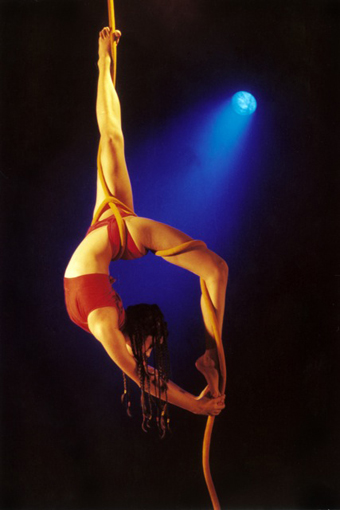
Shiva Shakti, Daksha Seth Dance Company
courtesy Perth Festival
Shiva Shakti, Daksha Seth Dance Company
Throbbing drums herald the spectacle of two cosmological principles, Shiva (masculine) and Shakti (feminine), of the splitting and cohering of male and female rhythms as only Hindu artists can conjure. The percussive presence of the Daksha Seth Dance Company, beaten out with hands, feet and reverberating bodies, harnesses the forces of the ancients by way of Kathak dance, martial arts’ Chhau and yogic traditions of rope and pole to revel in the time-space of Bollywood. Shiva Shakti represents an India here and now, which is simultaneously an erotic Sanskrit past. Some might think the colour, virtuosity and symbolism an excessively sensuous onslaught but the insistent interplay of sound patterns embodied by dancers and musicians alike warms the blood. The slipped polyphonic beat in its intricate and often thrashed concentration on a big drum with rice raining down in a column of red light cannot but both entrance and terrify. This opposition is enhanced by the aerial work with rings, silks, rope and a marvellous fighting sequence on a double harness which brings Crouching Tiger, Hidden Dragon on stage. The gods and their skilled human representations bounce off the earth of our imagining.
3G
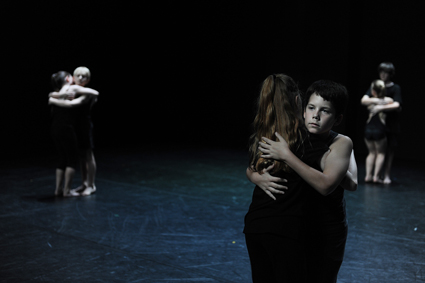
Jean-Claude Gallotta, STRUT dance in association with STEPS Youth Dance Company
photo Christophe Canato
Jean-Claude Gallotta, STRUT dance in association with STEPS Youth Dance Company
Against the thunderous tumult of Shiva Shakti, quietude returns with Jean-Claude Gallotta’s 3G, where dancers across three generations construct, out of their diverse bodily understandings, the same choreographic material. The children ‘do’ the movements with utter seriousness as if demonstrating their proficiency at the alphabet or times table. The eight-some has been drilled to professional accuracy and fulfils those expectations without missing a beat. Context for all sections is shyly suggested in introductory Italian film snippets from the 1930s or 40s. In the generational beginning, a grandma arrives to an over-flowing saucepan of boiling milk, only to transform the moment of disaster for the young boy into an imaginative riverine landscape on the spilt milk’s floor. Ends, through this imaginative device, are tied to beginnings.
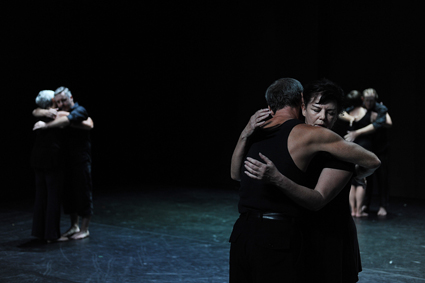
Jean-Claude Gallotta, STRUT dance in association with STEPS Youth Dance Company
photo Christophe Canato
Jean-Claude Gallotta, STRUT dance in association with STEPS Youth Dance Company
Physically, the child generation (performed by members of Steps, WA’s Youth Dance Company) levitate, as if gravity had not touched their small statures and dreams. The adults enter with visceral density which grounds the movement and its sensual/sexual complications. Interactions compound not in a narrative through-line but in glance, luscious gesture and powerful leaps and stamps, communicating a dynamic range of engagement which, with all of its power, still admits limits and emotional anxieties. The third generation, the eldest, bind the work together: curiously they are more and less confined in weightedness. Grace enters into the equation, given through gesture which suits Gallotta’s particularised movement. The film before this segment is a comic rendition of a community who trot into a stream of sunshine in a snow-defined landscape. The image of this generation gravitating to light exemplifies the generational journey. The shaft of sunshine fades and the third generation of dancers begin their enactment. Strangely, via the imagination of this third generation, the dance continues within a landscape built around beginnings in spilt milk.
When the three generations came together in a brief epilogue and final bow, the sense of family and community presented a powerful image, redolent across time and space, of the way in which performance touches the aching mix of dream and actuality to which we all subscribe.
Perth International Arts Festival 2013: Circus Rinaldo, La Cuchina dell’Arte, Russell Square, Northbridge, Feb 9-24; Aracaladanza, Clouds, choreographer Enrique Cabrera, Regal Theatre, Feb 14-17; Daksha Seth Dance Company, Shiva Shakti, choreographer Daksha Seth, director Devissaro, Regal Theatre, Feb 25-28; STRUT with Steps Youth Dance Company and Centre Choregraphique de Grenoble (France), 3G (Trois Générations), choreographer Jean-Claude Gallotta, rehearsal directors: Generation1 Alice Holland, Generation 2 Danielle Michich, Generation 3 Sue Peacock, State Theatre Centre of Western Australia, Studio Underground, Feb 28-March 2
RealTime issue #114 April-May 2013 pg. 16
© Maggi Phillips; for permission to reproduce apply to realtime@realtimearts.net
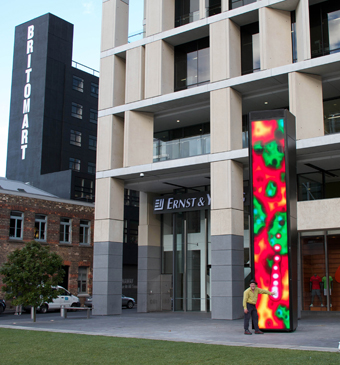
Tim Gruchy with SCOUT
photo Rhana Davenport
Tim Gruchy with SCOUT
AS WORKERS ENJOY A SUNNY LUNCH ON GRASSY TAKUTAI SQUARE, IN THE RECENTLY REDEVELOPED BRITOMART PRECINCT OF DOWNTOWN AUCKLAND, A DARK COLUMN LOOMS ABOVE THEM.
It is eight metres tall and rectangular, similar to the marble block columns of an adjacent building but painted almost black with a matt skin-like finish on three sides. The fourth side has a tinted glass panel, custom-made to create a full-height diffused LED screen that faces into the square, observing the comings and goings of commuters, late morning loafers, weekend market shoppers or after-dark malingerers. Behind the glass, a mix of gaseous, liquid and geometric forms drifts across and up the column, accompanied by soft pulsing music. The colours and sounds change in hue, form and dynamics across the day, and from season to season, as if absorbing the environment and responding with their own interpretation; an electronic world projected behind the glass.
This is Tim Gruchy’s SCOUT (Sentient Co-relator of Urban Transaction), a public sculpture privately commissioned as part of Cooper & Co’s redevelopment of an area that combines Auckland’s main rail station with new high-rise corporate accommodation, shopping and restaurant-bars set in historic former port buildings. SCOUT was developed in collaboration with Sydney architects Johnson Pilton Walker (JPW), designers of the adjacent tower, and was launched in early 2012. Its ever-changing soundscapes were developed with musician-artist James Pinker (ex-Fetus Productions/SPK/Dead Can Dance) and features several vocalists, including Precious Clark from local iwi (Maori tribe) Ngati Whatua, whose performance greets the dawn. Well-known technician and weather boffin Richard Huntington has contributed to the sophisticated back-end, which is activated by camera, microphone, clock and calendar events or climate sensors (humidity, brightness, temperature, rainfall), all of which feed three networked computers that drive the audio and graphics in real time—there is no pre-recorded video.
SCOUT’s primary relationships, however, are with humans. Its camera detects motion in the square, its microphone responds to sound, and the lower portion of the glass has touchscreen functionality, allowing people to interact directly through gesture, releasing an additional range of sound and light events into the virtual space inside. But, existing as an entirely self-contained artificial entity rather than as a tool or extension for the human body, SCOUT is no cyborg. Although the slight twist and skin-like surface of its ‘spiny’ exoskeleton gives it subtle anthropomorphic qualities, it is not humanoid, but designed to be a benevolent presence that shares the landscape with us.
This could be the most technically complex public artwork in New Zealand, unrivalled in its advanced mix of electronics, interdisciplinary collaboration and advanced materials. It seems this unique mix of engineering, programming and art has its unlikely roots in the can-do DIY ethic instilled in the post-punk generation of art school-educated musicians as they attempted to reboot music’s excesses in the midst of an increasingly technological era. For some, this was a license for avant-garde experimentation, where the likes of John Cage, Terry Riley, Brian Eno, Kraftwerk or Talking Heads were equally likely influences, establishing a space that sits somewhere between art, music, theatre and technology.
Tim Gruchy started out in the Brisbane punk scene in the late 1970s. The subsequent industrial movement of the early 1980s (including groups like Severed Heads, SPK and Fetus Productions) was quick to absorb technological developments to make multimedia a core element of their shows, paving the way for media-saturated raves, interactive dance and hi-tech theatre presentations. Gruchy’s career grew in the midst of these developments. Like many media artists of his generation, he either built his own equipment or had to adapt consumer gear as it became available, inventing outcomes in lieu of any existing precedent, and customising new formats as they became available. This makes him Australia’s go-to person for cutting edge video projects, working anywhere from Chinese art galleries to the Sydney Opera House, although he has so far maintained a low profile in New Zealand, where he has been living since 2006.
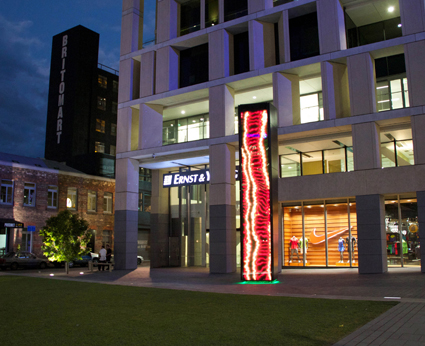
Tim Gruchy, SCOUT
photo Tim Gruchy
Tim Gruchy, SCOUT
Eno seems an obvious reference point, with his well-known interest in electronic ambient music as a way to ‘tint’ an environment, and his slow-change semi-abstract video paintings, notably in vertical format, starting with the oversaturated cityscapes of Mistaken Memories of Mediaeval Manhattan (1981). Gruchy acknowledges Eno as an important early influence but it is Eno’s approach to serial composition that is most relevant here—using chance, algorithms and generative strategies to create almost endlessly variable music and installations from interacting components, most recently his 77 Million Paintings project and his series of iPad apps, Bloom, Trope and Scape (2012). Underpinning these is an interest in ecology and the kind of events and time-scales that defy typically short-term human thinking. The Eno-supported Long Now Foundation is working on a 10,000 year clock that ticks only once a year. Similarly, SCOUT’s climate controls and seasonal variations suggest a structure that extends well beyond the duration of evening concerts or short-loop screensavers, making it more akin to the planetary and temporal sensitivies of land art, such as Nancy Holt’s Sun Tunnels (1973-76) or James Turrell’s Roden Crater (2006). Like Eno’s art-school origins, Gruchy’s early architectural studies have suggested different ways to construct enduring systems rather than to compose music of finite duration. Architecture works on a much larger scale than most art forms, not just physically but temporally too, ideally with a long view of how it impacts on its environment.
Compared to most inanimate public art, SCOUT is also unique in the way it evolves as a form of smart sculpture. Not only can its existing algorithms learn and adapt from the patterns and conditions of its location, it also exists as a form of hardware that could accommodate ongoing software updates—I’m told the existing installation has features that haven’t yet been activated. This makes SCOUT an intelligent presence in the urban environment, co-existing and communicating, but for whom? Another clear reference is the monolith in the film 2001 A Space Odyssey, adapted from Arthur C Clarke’s short story, The Sentinel (1948)—Gruchy shares a birthday with sci-fi writers Clarke and Philip K Dick. SCOUT’s dynamic behavioural qualities raise questions of sentience and artificial intelligence. Although SCOUT is unlikely to be communicating with extra-terrestrials, it’s possible that it may have something interesting to say to our future selves.
Tim Gruchy, SCOUT, 2012, LED video display, LED strip light, touch screen, speakers, microphone, video camera, environmental sensors, networked computers, audio and media servers, generative computer programme in glass, compressed fibreboard and steel shell. Takutai Square, Britomart Precinct, Auckland, NZ; www.grup.tv
RealTime issue #114 April-May 2013 pg. 17
© Andrew Clifford; for permission to reproduce apply to realtime@realtimearts.net
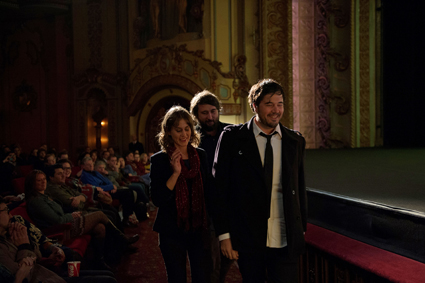
Julius Avery, Jessica Mitchell, Michael Spiccia, winners of the Dendy Award for Best Live Action Short for Yardbird, 2012 Sydney Film Awards
photo Fiona Lumsdaine
Julius Avery, Jessica Mitchell, Michael Spiccia, winners of the Dendy Award for Best Live Action Short for Yardbird, 2012 Sydney Film Awards
HAVING ATTENDED THE EVENT AND WATCHED THE TELECAST, I FELT QUITE DISSATISFIED WITH THIS YEAR’S AUSTRALIAN ACADEMY OF CINEMA AND TELEVISION ARTS (AACTA) AWARDS, THE MAJOR EVENT FOR THE AUSTRALIAN SCREEN INDUSTRY. ANTICIPATING THAT THE OSCARS WOULD ALSO BE AN UNDERWHELMING EXPERIENCE, I STARTED THINKING ABOUT WHAT WAS WRONG WITH AWARDS GENERALLY, AND WHAT MIGHT BE DONE TO RESCUE THEM.
Because there is certainly something wrong; people still attend them, or watch them on TV, but there are more and more complaints, ranging from issues with the host or hosts or about the presentation to more serious concerns to do with the actual awards.
new times, new media, old categories
In the time running up to each event and in much of the feedback, questions are asked and suggestions made as to what is wrong and what can be done, but none of this seems to register with those in control. The big questions are, do awards still have a role? In this digital age, especially, with so many changes to screen production, distribution and delivery systems, aren’t there large and growing areas of work that are being ignored? Aren’t the selection processes and judging systems now quite questionable, as the parameters of eligibility and the criteria for comparison are thrown open by such changes?
It would certainly appear that the old categories are not really working anymore. For the AACTAs in particular, the huge range of categories, many seeming quite indulgent, unnecessary or just inaccurate, only makes for an overburdened event—and for an electorate equally overburdened by out of date criteria. So I wanted to write something that investigated these issues, looked at the AACTAs and the Oscars, and even worried about the future of the new kid on the block, the APSAs (Asia Pacific Screen Awards).
demise of the if awards
Events, as they often do, intervened. The demise of the IF Awards was announced; that fun and rather irreverent award celebration, produced by IF magazine, which went into hiatus last year, will now not return. With audience-based voting and close ties to the screen industry, these awards, from their inception in 1999, had become a strong alternative to the AFIs, but financial constraints have brought them to an end (although the IF Awards Group is still considering a much less formal celebration). Then, less than two years after a major overhaul of the AFIs and a big launch for the new game in town, and only weeks after the second Awards had been held, it was announced that the AACTAs were in serious financial trouble.
the aacta crisis
The team which had developed the first and second AACTA Awards had suddenly been halved in size, with six staff positions going, and AFI/AACTA CEO Damian Trewhella admitted that the organisation was in the red, with the loss of a naming rights sponsor for the 2013 AACTA Awards causing serious and urgent financial difficulties. With much of the income coming from sponsors and advertisers in the non-screen sector focused on the glamorous awards, the industry and craft categories—such as television direction, documentary, editing, sound, production design and short films, only supported by about 15% of the operating costs—are under serious threat. With outside sponsors not wanting to fund the industry awards, and the industry so far unable to provide the money, Trewhella says, “The only way forward is to have the activities re-evaluated by the screen sector itself.”
Trewhella thinks that it probably is time to rationalise the awards, to perhaps roll a few categories together. And while he sees sense in the suggestion made by a number of commentators to hold the film and television awards separately, he says that the AFI is not in a position to have two entirely separate events. He’s looking forward to discussions across the industry, with the state and federal funding bodies, the guilds and organisations and with the filmmakers themselves; after all, he says, the awards are there to celebrate the people working in the industry.
The Australian Academy of Cinema and Television Arts was established in August 2011 by the Australian Film Institute, the general membership-based organisation that had been conducting the AFI Awards to recognise screen excellence for over 50 years. This followed a year-long review and industry consultation; the inaugural AACTA Awards were held in Sydney in January 2012 and the second in January 2013. At the AACTA launch in 2011, the new academy was described as a peak peer assembly for leading Australian screen practitioners, made up of 15 chapters covering key facets of the screen industry, from acting, directing and screenwriting to production and distribution, each headed by an industry luminary in an honorary post, with AACTA itself governed by an honorary council which would develop policy, aimed at “creating greater unity among screen professionals.” It’s unclear, however, how much input this academy is having into addressing AACTA’s problems.
The screen industry’s eight guilds and unions want to support the awards; each organisation is preparing recommendations and they’ll come together to work out a joint submission with the sort of changes they want to see and suggestions to solve the many issues they have with existing awards. (The need for the international awards, for example, is universally queried.) Kingston Anderson, Chief Executive of the Australian Directors Guild, asks what the awards are supposed to do, and answers, “celebrate our industry. But what we want is a fair system where people are recognised fairly in their categories—and that the categories themselves are fair.” He adds that the Guilds’ own awards work well, and “that’s because we’re driven by our members. We all have extraordinarily interesting discussions on guidelines and awards.”
With all the guilds and unions holding their own awards annually, there is a suggestion of more co-operation, of an awards season with the specific awards held before the AACTAs, as a build-up to the main event. There are concerns, too, that the marketing of the awards dictates a number of decisions, seen as too driven by the needs of the telecast. “They’re coming from the wrong end,” argues Anderson, “Let’s get the event right first, and then market it. Even if it’s screening on a cable channel, it’ll become desirable once it’s really working.”
On March 19 the AFI/AACTA announced four new AFI board members, Geoff Brown, Russell Howcroft, Alaric McAusland and Ian Sutherland, all industry heavy hitters, who will join existing members Mike Baard, Jennifer Huby, Robert Sessions and Sigrid Thornton, with Alan Finney as chair, restoring the AFI Board to its full capacity (and earning a quip from one media commentator that the AFI now has more board members than staff). This beefed-up board should give it some more bargaining power in the trying times ahead.
the asia pacific screen awards
The Asia Pacific Screen Awards, which had been rumoured to be in trouble along with other cultural activities in Queensland following the change of government, are apparently safe. Des Power, Chair of APSA, is feeling very positive; he’s just had some very encouraging talks with the Queensland Government and believes that they want to continue with APSA.
These awards were established in 2008 to recognise and promote the cinematic excellence and cultural diversity of the vast Asia Pacific region with an annual awards ceremony each November. They’ve slowly but surely established a role and an identity for themselves; it would be a shame to see them disappear after all that hard work. Awards are decided following a complex and rigorous nomination and judging process, taking in hundreds of films from the many and diverse countries involved. An APSA Academy was established in 2008, with an influential alumni of filmmakers growing by around 100 each year. Development funding is now provided to the region’s filmmakers, aiming to stimulate collaboration. Eight films are now at various stages of production.
Des Power, who was behind APSA from the beginning, says that “it’s been a very difficult year for the government, financially, and we want to give them a bit of latitude, use a bit of common sense.” As he explains, it was always envisaged that once the awards were firmly established, they would be held every second year in Brisbane, and in one of the member countries in the alternate year. “We’ve had some very healthy discussions about this, and we’re hoping to be able to announce that this year APSA will take place in one of several cities in the region.” He adds that the move from the Gold Coast to Brisbane last year was very successful, and he’s hopeful that more screening opportunities for APSA’s nominated films will present themselves in future, not only at the Brisbane International Film Festival, but with other festivals and events around Australia.
a model past its use-by date?
Late last year, as the movie award season got under way, Andrew L Urban in his online journal Urban Cinephile argued that “the use-by date for film awards has arrived.” Mainly talking about the Oscars, but with remarks that could also be applied to the AACTAs, he complained about “outdated and old world restrictions” and “creaky and inadequate” categories, arguing that “there really is no rational way to argue that 282 films made in 2012 can be assessed for a single Best Picture award, nor that there is only one contribution in all the other categories that deserves the ‘Best’ stamp.” He added, “So far, no awards body has managed to find an effective alternative system to the template: the nominees & winner formula remains cast in concrete.”
He also suggested that “in a more sophisticated world where people with vision and imagination manage such things, there may be a system that recognises and encourages excellence without demanding that there be one ‘winner,’ a few also-rans and hundreds of ‘losers’…one way to overcome some of the major limitations and strictures of old awards systems might be to discard the old nomination/winners construct and instead to recognise ‘Outstanding Achievement’ in the various award categories…(giving) equal value to all the work that has been peer-judged as outstanding…it elevates the accolade for each and avoids having to compare apples with oranges.”
Some kind of radical overhaul of the system is definitely needed. The constant criticism, both here and overseas, allied with disappointing audience numbers, would certainly indicate that we don’t need this bloated, out-of-date and very expensive monster. A solution is needed that addresses all the issues, canvasses alternatives and hopefully comes up with something new, different and genuinely fresh and exciting; something that does away with the current categories and looks at what awards are actually for. The Sydney Prize, given out at the Sydney Film Festival’s relatively new competition, goes to the film that best satisfies a very specific set of criteria, including innovation—why not then work towards a number of awards, each with its own criteria? We’re looking to compare very different work and practices, and there are all sorts of ways in which this could be done, but we need to start! The situation that AACTA finds itself in should provide a perfect impetus to do something a lot more radical than just fiddle around at the edges.
RealTime issue #114 April-May 2013 pg. 18
© Tina Kaufman; for permission to reproduce apply to realtime@realtimearts.net
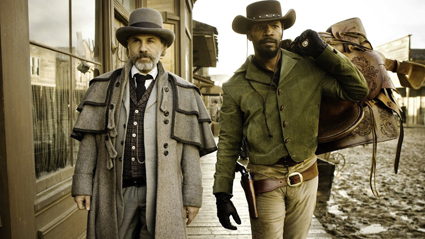
Christoph Waltz, Jamie Foxx, Django Unchained, Quentin Tarantino
AMID THE THOUSAND AND ONE LAZY ASSUMPTIONS ON HOW POSTMODERN CINEMA IS PRESUMED TO WORK IN THE FILMS OF QUENTIN TARANTINO, IT HAS BECOME DIFFICULT TO DIVINE HOW HIS ‘JUKEBOX CINEMA’ AUDIOVISION FUNCTIONS, AND TO DISCERN HOW HIS SONG AND SCORE SELECTION REFLECTS A POLITICISED MUSICOLOGY.
Tarantino’s authorial conceit and post-authorial recontextualisation of cinematic predecessors is only of conservative relevance to cinema, for his heightened audiovision constitutes a cinematic textuality that is cannily true to a medium born of narrative pulping, stylistic regurgitating and generic melding.
Yet as celebrated as he is for colliding pop songs with filmed action, that very effect has become terrifyingly rationalised in the hands of so many wannabe-outré directors (and producers). Tarantino meanwhile has forged ahead and refined the technique through a mode of perceptual crafting nominally excluded from discussion of postmodern art making.
Django Unchained (2012) marks a high in song selection, narrative recontextualisation and musicological territorialisation with alpine clarity. More importantly, it does so through operations seemingly opposed to the insular textuality of postmodern construction (allusions, appropriations, quotations, de-historicisation etc), and in their place broadly evidences trans-historical networking and even globalised positioning. If the film were simply a new post-PC revision of slave lore and suppressed American history, it would be ingrained in the vein of universalist ore mined by Hollywood cinema, something like a hip mash-up of Michael Cimino’s notorious big budget Zionist Western Heaven’s Gate (1980) and George Englund’s lesser-known low budget messianic Rock Western Zachariah (1971). But a crucial rustling of the filmic fabric is evident in Tarantino’s choosing a slew of Ennio Morricone music cues from other films. This audiovisual tactic does not simply point outward to the world of Pop Music, but rather draws inward the sono-musical phenomenality of recorded songs and cues to create a fertile grounding for the visualised action.
The 60s Spaghetti Western genre—a gloriously impure mutation that has fuelled the Western since its classical demise at the close of the 50s—is renowned for its transmutation of mythic narrative frameworks into visceral operas of violence. Ennio Morricone was the pre-eminent composer who if not defining the genre’s sound, refined it into an archetypal sonography, for evermore branding the movies with the twang of an electric Telecaster and dissonant wailing strings, both drenched in distinctive studio reverb from the era. Yet that description ignores the cultural project of these films and their deliberated soundtracks. In their debunking of the John Ford heroics of Hollywood’s ‘new world’ frontier ethics championed by the films’ collective pioneering spirit, the Italian Westerns embodied a critique of post-war Americanism before it had gained traction as a target of superpower rhetoric by the end of the convulsing 60s. It’s curiously perplexing that the Spaghetti Westerns were regarded by conservative critics and aesthetes as being vulgar, derivative and bombastic, for these Italian revisions of US folkloric history chose mostly to side with forces usually annulled by Hollywood scripts—namely, brutal revenge and retribution sought by Mexican revolutionaries and native Indian war tribes. Surveying the bulk of Morricone’s Western scores, one can audit his musicological allusions to those musical cultures, amplifying them through orchestrations of Italo-Catholic pomp and veneration.
So when Tarantino chooses these tracks, he is—with his voracious knowledge of these mutated generic film histories—working from a specific set of generic blue-prints, other than what might be ordinarily presumed. While the title theme to Django Unchained is the theme song to Sergio Corbuccio’s Django (1966), composed by Luis Bacalov, a number of other cues appear throughout Django Unchained from Morricone’s score to Two Mules For Sister Sarah (1970). Added to this are some distinctive Morricone excerpts from the political thriller Violent City (1970), plus a cue from Riz Ortolani’s title theme from I giorni dell’ira (1967). Along with still more excerpts, the musical fabric of Django Unchained’s score cross-patches songs and cues which sonographically evoke a distinctive Italian aesthetic of scoring terse drama and emotional exhaustion which sounds a universe away from the Austro-Germanic academic tradition which saturates the Continental aspirations of Hollywood’s grand orchestrations. Of course, Martin Scorsese is renowned for historicising his Italo-American crime sagas with songs reflecting the sensibilities of his characters, but Tarantino—of Italo-American descent himself—enacts a more complex tactic by eschewing song (already overused as a device for character assignation in movies post-Scorsese) for Italian film scores originally designed to convey a culturally coded mode of address and commentary which gave the Italian Western its identity.
Now this would all be straightforward enough if Tarantino was just making a rebooted Western, but Django Unchained reboots—or unchains—something that has lain for decades festering in the American Gothic of the South: the slave saga. Americans mostly avoided it until the mid-70s, when films like Richard Fleischer’s Mandingo (1975) and the TV mini-series Roots (1977) were made; slavery was mostly handled symbolically in prison dramas like Stuart Rosenberg’s Cool Hand Luke (1967). Again, it was the Italians who were first off the mark with amazingly violent ‘exploitation’ flicks associated with this sub-genre (the Italians themselves knowing a bit about slavery from their days of Roman glory). Historical movies like Goodbye Uncle Tom (1971) actually overlapped with contemporary American depictions of violence in the Blaxploitation cycle of movies (some of which were Westerns, notably Fred Williamson’s Boss Nigger, 1973). Both generic trends held a lot in common: racial violence, white oppression, black power and fantastic film scores and songs more associated with Pop Music than the film industry.
Perceived this way, Django Unchained becomes a carnival of echoes, bouncing references back and forth between Electric Italy and Black America. Echoic balladeering, Latino flutes and ocarinas, wild fuzzed guitars, Bach-like string fugues and funky booming drum kits perform a dance of stylistic fusion to beget not simply an eclectic mix-tape of cool retro tracks, but a concise mapping of the way pop and folk music at the time provided a transcultural system of signage that allowed these populist films—so derided by critics because of their polyglotic noise—a far sharper prism of politicised refraction than many presumed possible.
Tarantino’s Django Unchained thus audio-visually births a gangster rap visitation of the slave pic as produced by leftist Italian radicals, and blasts it into the auditorium of Hollywood’s white Western museography, whose Old Testament Hebrew tales of heroic land-securement are scored by megalomaniacal Germanic orchestrations. In this melting pot of global currents and murky waters we hear yet another example of Tarantino looking at cinema and calling a spade a spade: the very thing that falls on so many deaf ears.
–
RealTime issue #114 April-May 2013 pg. 20
© Philip Brophy; for permission to reproduce apply to realtime@realtimearts.net
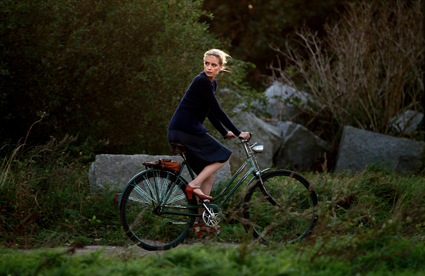
Barbara, © Schramm Film, ZDF, ARTE 2012
A SENSE OF WEARINESS PERVADES CHRISTIAN PETZOLD’S COLD WAR DRAMA SET IN 1980S EAST GERMANY. IT’S THE WEARINESS THAT COMES WITH ALWAYS HAVING TO LOOK OVER YOUR SHOULDER, A STATE OF EXISTENCE BARBARA’S PROTAGONIST IS CLEARLY ACCUSTOMED TO FROM THE FILM’S OPENING SCENE.
As punishment for applying to join her boyfriend in the West, Dr Barbara Wolff is sent from Berlin to work in a provincial hospital, where she goes about her constrained life not only under the watchful eye of the security service but, she assumes, of all her colleagues. House and strip searches occur with cruel regularity. Simultaneously character study, thriller and historical portrait, Barbara is a spare, grim film with an intense focus on its central character. There are very few scenes that aren’t seen through its heroine’s eyes.
The film eschews stylistic flourishes. Its cinematography is austere and naturalistic, though not to the extent of drawing attention to this as an aesthetic decision. There are passages where the beauty of the countryside is evident, but there’s little pleasure to be had in it. Barbara’s world is joyless, and we share her outlook. The film’s sound is similarly spare, its infrequent music executed only by the characters themselves. At one point, Barbara plays the piano and escapes into the music she is producing, but it’s a rare instance in a film whose stylistic severity suggests a world from which frivolity and spontaneity have fled.
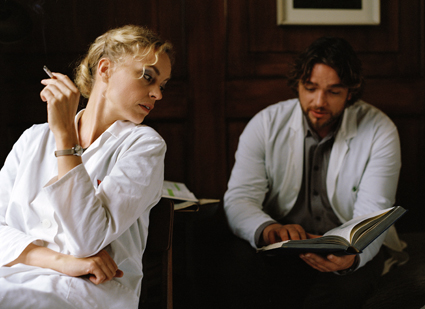
Barbara, © Schramm Film, ZDF, ARTE 2012
The other effect of the film’s lack of stylistic distraction is to focus all attention on character and performance, especially Nina Hoss’ masterful interpretation of the title role. Her performance is one of eloquent restraint. Every physical action, from her slightly stiff carriage to the stifling of normal reactions—the tendency to smile in response to friendliness, for example—gives the impression of a woman under enormous strain. She is ever watchful, ever tensed in anticipation of the next threat to her personal freedom.
Most emotions in the film are internalised in this way, self-policed by those wary of expressing too much in this society where all motives are questionable. Barbara’s colleague Dr André Reiser (Ronald Zehrfeld) is an exception, but in this climate even his kindness seems suspect. That’s not to say the film is black and white in its presentation of East versus West. Barbara’s boyfriend, with whom she shares the occasional illicit tryst, mentions callowly that when she makes it to West Germany she won’t have to work, as he’ll earn enough money for both of them. It’s a statement that gives this highly educated woman, so clearly devoted to her work, pause for thought.
Though Barbara is very effective in its overarching narrative of persecution and heroism, it’s in the smaller moments of quiet humanity that it becomes thought provoking. As the rapport deepens between Barbara and André, the question arises, “Can one make a life for oneself under these conditions?” The possibility is left open at that.
Barbara, director Christian Petzold, screenplay Christian Petzold, Harun Farocki, director of photography Hans Fromm, editor Bettina Böhler, music Stefan Will, 2012; distributed in Australia by Madman Entertainment
RealTime issue #114 April-May 2013 pg. 21
© Katerina Sakkas; for permission to reproduce apply to realtime@realtimearts.net
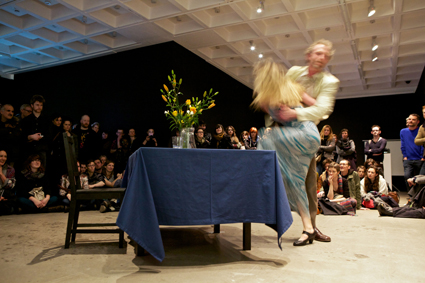
Images: top – Tim Etchells, Untitled (after Violent Incident), IBT13
photo Oliver Rudkin
Images: top – Tim Etchells, Untitled (after Violent Incident), IBT13
THERE’S A GENERAL THEME OF HOSPITALITY RUNNING THROUGH THIS YEAR’S IN BETWEEN TIME, WHERE EVERY OTHER PERFORMANCE COMES WITH A FREE ALCOHOLIC DRINK AND YOU’RE AS LIKELY TO BE USHERED INTO A PLUSH TOWNHOUSE, OR A CAMPFIRE-LIKE CIRCLE IN THE TWILIT FOREST, AS A BLACK BOX STUDIO. IT’S RARELY A PASSIVE EXPERIENCE FOR THE AUDIENCE.
alex bradley, field test
Alex Bradley’s solar-powered churchyard installation Field Test invites you to gaze up at tree branches filled with constellations of LED lights, as sweet music drifts from bird-box speakers all around you. Even here, in an overlooked backstreet of central Bristol, a busker has stumbled upon Bradley’s ambient meditation and is adding long, surprisingly sensitive violin motifs to the rich textures and city noise. People come and go in the dark. Drug dealers try, unsuccessfully, to tout their wares. The electronics are enough.
tim etchells, untitled (after violent incident)
In Between Time’s air of hospitality is gratefully received by an enthusiastic and vocal audience. Bristol has been missing the large-scale curation of a certain kind of performance (most often non-mimetic, non-narrative, physically uncompromising and oblique in immediate intent) since the last IBT in 2010. On the opening night, Arnolfini is packed so tight you can barely move, and I plant myself in front of Tim Etchells’ Untitled (after Violent Incident), a live version of his Bruce Nauman-inspired video work, to catch the whole thing from start to finish. Two performers re-enact a compression of the actions and atmospheres from Nauman’s 1986 multi-screen installation, a repetitive set of altercations, slaps, pratfalls and grievous bodily harms around a dinner table, stuck in a loop—but a human loop, imperfect, with the male and female performers sometimes recognising the absurdity of their actions in tiny and knowing ways. Over time it becomes alternately horrifying, hilarious and exhausting, a ritual derived from data retrieved from a faulty drive. It’s as interesting to watch your fellow audience as it is the choreography: to see where they laugh, where they frown, markedly different expressions upon every face in the crowd at any given point.
holzinger & riebeek, kein applaus für scheisse
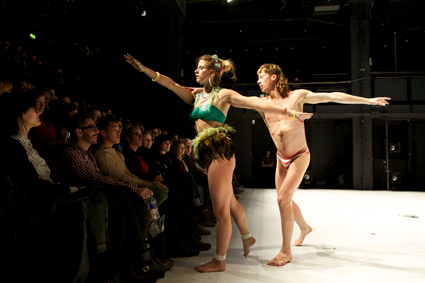
Kein Applaus fur Scheisse, Holzinger & Riebeek, IBT13
photo Oliver Rudkin
Kein Applaus fur Scheisse, Holzinger & Riebeek, IBT13
I find myself thinking back to Untitled later in the weekend, when Florentina Holzinger and Victor Riebeek stage Kein Applaus Für Scheisse, also an account of negotiations between a man and woman, but this time it’s a goofy, sweet portrait of the artists’ real-life relationship—albeit thoroughly excretal. Dressed like acid-house hippies and singing bad karaoke, Holzinger and Riebeek present a series of tableaux with their bodies and bodily functions at the centre. He eats a trail of red string from her vagina; they dance in formal but bungled style, limbs knocking against each other; he urinates on her and she spits it out into his open mouth. In this instance you don’t need to see the audience’s faces. You can hear them. At the point where Riebeek genuinely and repeatedly vomits a startling pure blue liquid onto Holzinger’s arching body, there are gasps, jeers, laughter, and someone behind me involuntarily exclaims: “Easy, tiger!” But beyond the human fluids, the pictures are slowly becoming more formal, more obviously constructed, more touching even. It’s awkward but honest. Holzinger looks up at us, covered in her lover’s blue bile, and mutters: “I need to take antibiotics, I have the allergies.” It’s another ritual from an obscure corner of the world, but this time you get the sense that these two dancing geeks will keep on changing it, making it relevant to each destination and each other as they see fit, and shrugging off anyone who thinks it perverse.
the vacuum cleaner, mental
The vacuum cleaner (“an artist collective of one”) in his solo show, Mental, invites us into a very different kind of autobiography. It’s billed as a work-in-progress but already constitutes one of the most powerful portraits of creativity and depression I’ve ever seen. Twelve of us are bussed to a sparsely furnished bedroom in a hilly part of the city and fed tea and cake until the artist emerges, rheumy-eyed, from underneath a duvet. With grim countenance he pulls folders bulging with documents from under the covers and pillows: his psychiatric reports, his police records. One by one he slides acetates onto an OHP, reads out extracts, then flicks them away, as the story of his fight with the black dog plays out through medical assessments and the unintentionally hilarious prose employed by officers of the law. It’s a heart-rending journey—because the vacuum cleaner has set himself up for a fall: his work, anchored in activism and social justice, is about desperately hoping for the best from the world. And on those terms the world often tends to kick you in the teeth.
Mental is presented in a familiar way, in the tradition perhaps of Bowery-loft performance art, the artist’s life writ large. But there are some remarkable little victories, observations and stings in the tale that make it as important to the listener as the speaker. At the end, when it’s done, I sit and eat a piece of carrot cake that—for reasons I can’t even begin to divulge—has become the saddest and most beautiful taste I can possibly imagine.
emma bennett, slideshow birdshow
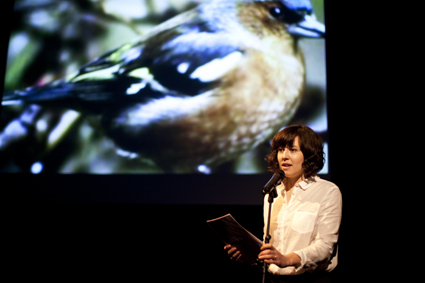
Emma Bennett, Slideshow Birdshow, IBT13
photo Delia Spatareanu
Emma Bennett, Slideshow Birdshow, IBT13
At the other end of the emotional scale the biggest laughs at IBT13 come thanks to Emma Bennett’s uncooperative powerpoint lecture, Slideshow Birdshow. Quiet and formal, Bennett begins to deliver a dull talk about ornithology but rapidly gets derailed by a chain of fuzzy, unhelpful and repetitive images that lead her into a cut-up verbal dance. She’s confused but seems compelled to keep talking, continually repeating useless, self-evident details back and forth in time with the slides; and what emerges is a piece of music, like spliced tape running off the spool, out of control, peppered with occasional exclamations or expletives. Towards the end of this short performance the laughter subsides, the rhythms generate an odd calm—and with massively pixelated images flashing by, Bennett’s trembling voice in perfect and unlikely synch with them, her wordless tones turn into a quivering digital birdsong all of their own, singing from somewhere deep inside the machine.
In Between Time: Alex Bradley, Field Test; Tim Etchells, Untitled (after Violent Incident); Holzinger and Riebeek, Kein Applaus Für Scheisse; the vacuum cleaner, Mental; Emma Bennett, Slideshow Birdshow; Bristol, UK, Feb 14-17
RealTime issue #114 April-May 2013 pg. 22
© Timothy X Atack; for permission to reproduce apply to realtime@realtimearts.net
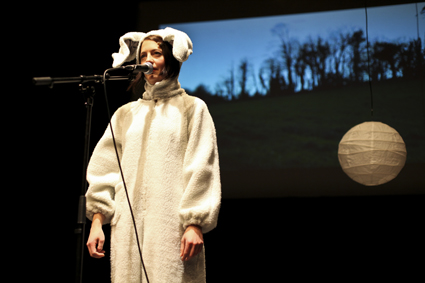
Sylvia Rimat, If You Decide To Stay, IBT13
photo Delia Spatareanu
Sylvia Rimat, If You Decide To Stay, IBT13
FRIDAY OR SATURDAY? SHOULD I BET ON RED OR BLACK? AN AISLE SEAT OR ONE AT THE BACK? THE DESIRED OUTPUT FOR REALTIME IS AROUND 1000 WORDS COVERING FOUR TO SIX SHOWS AT IN BETWEEN TIME. SO, HOW TO DECIDE BETWEEN ONE THING AND ANOTHER, WHERE TO START?
Before arriving in Bristol this decision is shaped both by my agency, and by structures that limit or influence my choices. Some decisions I take quickly, even subconsciously, others I deliberate over at length; rumination influenced by bias, reason, emotion and what is expected from me in this situation.
sylvia rimat, if you decide to stay
Decision-making is the explicit subject matter of Sylvia Rimat’s If You Decide to Stay, a performative lecture that meanders through personal experience, specialist knowledge and a loose set of experiments. Rimat analysed the types of choices we make on a daily basis and speculated as to whether these reflect what we really want. Listing the gamut of reasons that could explain our choice of seat within the auditorium, she then asked us to get up and choose a new one—somewhere we would not usually sit. I chose the middle seat of the back row and considered this to be a reasoned choice. However, the person I was with read this as an emotional choice, as it involved me moving closer to them (we were separated to start)—an audience predisposition that had already been described. Perhaps it was not one or the other, but rather a bit of both.
The complexities of decision-making were expanded upon: neuroscience, mathematics, psychotherapy and astrology formed tools to address the level of conscious choice we have and how much this is influenced through environmental, social and psychological cognition. However the work began to take a random turn. As The Clash’s “Should I Stay or Should I Go?” blared out, Rimat hopped around in a bunny outfit pondering some vaguely existential questions. This reflection on ‘not knowing’ appeared feigned. When Rimat said she did not know if there would be applause at the end of the performance, this consciously ignored the surrounding social structure that determined that there would be.
kim noble, i am not alone
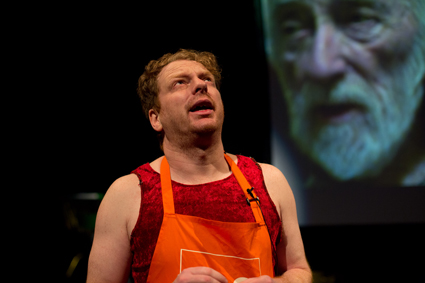
Kim Noble, I Am Not Alone, IBT13
photo Paul Blakemore
Kim Noble, I Am Not Alone, IBT13
Kim Noble’s I Am Not Alone presented a similarly dispersed narrative. As the audience entered, Noble was lying on the floor near the entrance. Wearing only a kitchen apron he simulated sexual noises, stating, “I just wanna be a woman.” This was followed by a rant about the couple living above him having sex (to which he responded by playing loud internet pornography back at them) and a detailed description of how he monitored another neighbour’s sex life. Acts of documentation extended to the minutiae of the artist’s life—from the text message he receives in Morrisons [supermarkets] to his taking a shit on a church floor—and border upon pathological self-obsession cum narcissism. Noble’s search for novel types of personal connection with others is deeply provocative and seriously funny, while being fundamental to his work. Noble chooses anonymous, banal individuals, for example Keith, a checkout assistant at the supermarket he has filmed for two years, or Dan with whom he forms a romance via a false female profile on Facebook.
The most extreme and sexually explicit relationship Noble forms is with a truck driver called John. John wants to fuck Noble, believing him to be a woman called Sarah. Noble adapts his behaviour in an attempt to impress John, sending him explicit texts and images in which he has fashioned breasts and a ‘pussy’ using parts of his own body. Noble juxtaposes this material with his relationship with his father, exposing him as a lonely, struggling old man with a nurse washing his arse. As Noble’s relationships descend into potentially humiliating territory—stalking Keith to his home, cross-dressing to meet Dan in a bar—the exploitation of himself and others is tempered by the sense of a kind of unrequited love. I Am Not Alone proved to be a paradox of a title. Noble is alone. Very much alone. As are Keith, John and Dan. The work deconstructs the reality of all our relationships, where characters and roles are performed and exchanged and affect is constructed. The performance comes to an end with the death of Noble’s father, brutally emphasising Noble’s pathetic failure to connect with anyone.
fiksdal, langgård, becker, night tripper
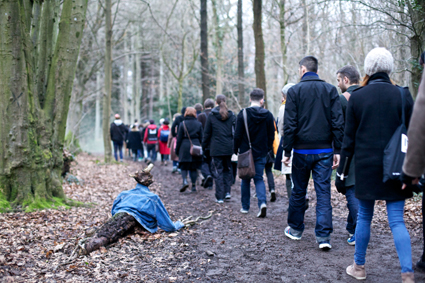
Night Tripper, Fiksdal/Langgård/Becker, IBT13
photo Oliver Rudkin
Night Tripper, Fiksdal/Langgård/Becker, IBT13
In stark contrast to these performance lectures, In Between Time offered an array of different formats. The course I chose transported me to the woods for Night Tripper by Fiksdal/Langgård/Becker, saw me wander through the sprawling exhibition survey, Version Control, and fail to find my role in Coney’s Early Days (of a Better Nation). Whilst Night Tripper was framed by ritual and a dream-like state of consciousness, this attempt at an all-consuming experience sometimes fell flat. The work was instead at its strongest pared back to its basic components: a minimalist dance aesthetic and accompanying sound from musicians and a hidden choir. In the transition from twilight to darkness, rolling, rocking figures, whining strings and droning hurdy gurdy offered cycles of repetition and a pleasing, numbing boredom.
coney, early days (of a better nation)
Coney presented a work in progress where the audience was set the task of collectively shaping a new nation. This aimed to reflect a wider political context of world events, and to get a hundred or so individuals to make decisions together. However, the narrative felt clichéd and the game mechanism was not strong enough to retain the audience within this performance fiction. From the outset the game structure and narrative did not facilitate the suspension of disbelief required to immerse us in the production of the work. Assigned groups tried to clarify what to do, as individuals drifted off, wandering aimlessly, acquiring additional wealth that was not then deployed with purpose. Over two hours the structure broke down, with video interludes and scripted oratory failing to bring it back under control; many now simply watching on as certain individuals chose to engage in familiar rhetoric, either exchanging rehearsed political positions or simply trying to disrupt them. (For another response to this work-in-progress see http://lettucemelodies.wordpress.com/2013/03.)
version control
The exhibition Version Control was an attempt to explore how a gallery can present performance and performativity, but resulted in an installation where the relations between works felt clunky, bunched together under broad groupings. This awkwardness was less apparent in work within the exhibition documenting Return of the Blogs, a two-week performance program from the collective Grand Openings at the Museum of Modern Art in New York. [The title Return of the Blogs refers to the documentation of the works in 2011—a daily account of the actions in the form of handwritten texts, fabricated objects, and audio podcasts presented in the gallery space and on MoMA.org. Eds.] It was an intriguing reflection on performance as a collective act, and live archive, within an institutional frame.
Over 1000 words covering five shows at In Between Time. The desired output is complete. Stop.
In Between Time 13, Sylvia Rimat, If You Decide to Stay; Kim Noble, I Am Not Alone; Fiksdal/Langgård/Becker, Night Tripper [Norway]; Version Control; Coney, Early Days (of a Better Nation); Arnolfini and other venues, Bristol, UK, Feb 14-17
RealTime issue #114 April-May 2013 pg. 23
© Niki Russell; for permission to reproduce apply to realtime@realtimearts.net
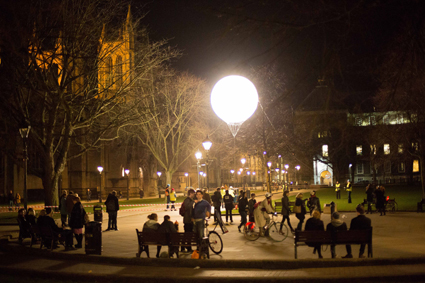
Fake Moon, Simon Faithfull, IBT13
photo Paul Blakemore
Fake Moon, Simon Faithfull, IBT13
A GANG OF MEN IN FLUORESCENT JACKETS MANHANDLED SOMETHING PALE AND UNWIELDY OVER COLLEGE GREEN IN THE TWILIGHT. A GLOWING WHITE BALL SECURED BY GUY-ROPES, POWERED BY A GENERATOR ON WHEELS, GUARDED BY PEOPLE IN TABARDS WARNING YOU NOT TO OBSTRUCT ITS DESIGNATED PATH.
simon faithfull, fake moon
As night fell the globe lifted above the rattling winter branches, high as the golden unicorn crowning the Civic Centre. Not quite as high as the turret of the Cathedral—definitely not as high as the waxing silver arc far above—but huge, soft and luminous, an accessible wonder. This extra moon would shine for the four nights of the festival.
College Green filled up with people diverted from their evening commute to stare and wonder, to take photographs and pause for a moment before catching the next bus home. A busker set up shop at the entrance to the Green. Above, the real moon exposed the fakeness of the apparition just as the work-jackets and guy-ropes worked a lovely little Heath Robinson analogy on the processes of artifice.
Simon Faithfull spoke later of his interest in “myths and illusion,” of “lying to tell the truth.” In this numinous piece of fakery the clearly visible apparatus of the illusion flickers in and out of awareness as though it were a mirage.
nic green, fatherland
Seven drummers and a piper stood in the dark. Lights up: a woman came forward dressed in a grey short-trousered suit with a heather-coloured tartan trim on the waistcoat. She spoke.
“Father, what is space?” Answers appeared projected above her and she asked the fathers in the room to speak them. Falteringly they acquiesced, in minutes becoming a strong chorus. As the performance progressed we all joined in, we all became the responder, the provider of an answer, the location of a dubious heritage.
She described her last meeting with her father, devoid of much feeling or connection. And we the chorus said, “I am visible only as land. I grow quieter. And firs, rough hillsides, drumbeats and drones.”
She described a circle in chalk on the floor. She took off her jacket with its tartan frill at the back. As one after another of the drums joined in beating a rhythm she paced, then ran, then sprinted round the circle, shrugging off her clothes; till wearing only navy-blue stretchy polyester pants with a tartan frill on the bum she gathered herself into the centre of the circle. As the pipes began to play she jumped and pranced and kicked: a strong, luminous, wild, proper body. She flung her arms up and down, stamped and twisted, ribs and muscles working, the tartan fringe flying.
When the dance was finished and the drumming over, she sat on the floor in a lone spotlight and stripped. She unwound the circle, walking widdershins, and handed bottles of whiskey into the tiers of audience for us to share. The pipes were now only droning.
Standing naked she sang in Gaelic. No need to understand the words. Heather, whiskey, islands and mist and loss, elements of the Celtic twilight—and a glimpse of a brusque masculinity hung on a scaffolding of nylon, tweed, stubble and greyness, shielding the view of the moors beyond. Only a glimpse of flesh muscle and bone shining; hard to uncover, but she’d done it; hard to invoke but she joined us all into the fire of that tribalism.
We drank while she was singing. Then she sat and drank her whiskey, looking at us. She and her drummers left the stage and she had the piper play us out.
reckless sleepers, a string section
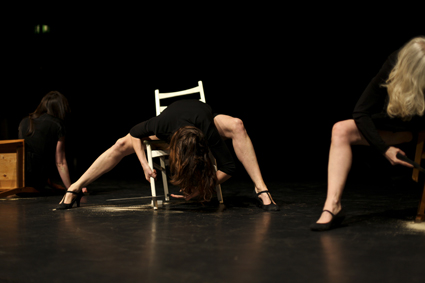
A String Section, Reckless Sleepers, IBT13
photo Delia Spatareanu
A String Section, Reckless Sleepers, IBT13
As this was the opening performance, the room was full. We’d been encouraged to circulate so I sat at the back waiting for the forest of legs and backs to disperse, but they never did. We at the back heard applause when the performers entered; we heard sawing sounds, raspy and unexpectedly harmonic. The tinkle-clunk of a bit of wood hitting the floor. I weaselled my way to the front.
Four women, sawing the legs off the furniture they are sitting on. They wear black formal dresses, heels, make-up. They are smart, maintaining balance on the aforementioned destabilised furniture. Those women who fall off, get back on their chairs again. Displaying control, ingenuity, determination and grace in the face of inevitable pratfall, and, like a thrumming of cello players, quite suggestively sexy.
jo bannon, deadline
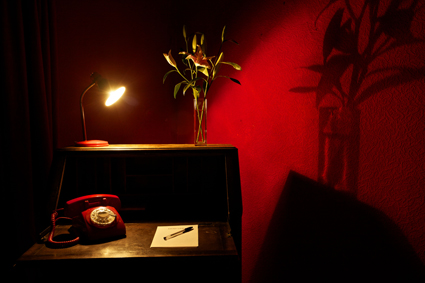
Deadline, Jo Bannon, IBT13
photo Oliver Rudkin
Deadline, Jo Bannon, IBT13
In Deadline one is ushered through meditative spaces from an airy, comfortable waiting room to a red study, to a seat by the window of a white room looking out on the wintry sun of an open cityscape. At each stage one is nudged into a thoughtful frame of mind by having to wait, by vases of lilies and related literature scattered around and by the concerned, considerate air of the guides/invigilators.
In the red study the phone rings and after completing a short questionnaire you can ask one of the experts at the other end of the line three questions. I got the Doula, the Midwife for the Dying. When, enlightened, you put the phone down, you are led to the white room to stare out of the window. The view is framed by lights gradually brightening round the window, and by urgently building noise.
It is a detaching experience: there is tension in the ringing of the phone, the building of noise in the white room. For a moment one anticipates the unknown, surrounded by props of the familiar: a telephone, a desk, a voice, a view of the city. An exercise in the practice of resilience.
zierle & carter, chamber made opera, living room opera
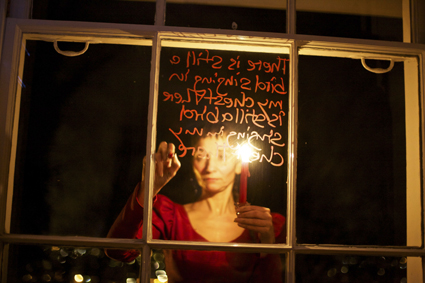
Living Room Opera, Zierle & Carter, Chamber Made Opera, IBT13
photo Oliver Rudkin
Living Room Opera, Zierle & Carter, Chamber Made Opera, IBT13
Flashbacks: we’re being guided through the night towards the venue, city lights spread below us, twinkling. A man in evening dress leans from the warmth of an upstairs window with a rope dangling from his neck. He rotates his neck and body, drawing up a crimson dress till it envelops him.
A tall woman greets us with the sound of birdsong captured in a china teapot. Buttoned up like a spectral Mrs Danvers, she moves slowly backwards drawing a pair of men’s shoes after her, conjuring a disembodied follower. We still can hear birdsong.
A kitchen permeated with the smell of tea, oranges and bread baking. The rattle of a magpie. Recorded voices coming from behind furniture or plant pots or from within cupboards; reflective voices telling slow stories of how they got to the house they grew up in, how they left it, who lived there, who built it.
A man with a clock case strapped to his head. The pendulum is stifled with salt. He opens the case and brushes the salt out with his fingers—time lies in heaps on the carpet, stilled. A heartbreaking excavation into a frozen past.
Upstairs in an anxiety of ambient sound, the young man stands maniacally scraping burned toast, his hair over his face tied in a thick knot by the hangman’s rope curving over the floor.
She, the hostess, now in the crimson dress, crawling towards him, seizing the rope, contorting her body….He, presenting her with a miked-up basin of milk, she plunging her face in it, howling, grunting and gasping.
A knot of bones, antlers and feathers falling to the floor.
From the balcony outside she draws on the window in red lipstick till a square of it is covered in overlapping scrawls. She looks like a revenant, a haunting, a fetch.
Histrionic, yes. As memory is, always making drama out of crisis, and narrative out of routine. Opera indeed.
And also, like entering grandmother’s cottage in the woods: come in, keep warm, have some tea and an orange…you don’t have to look at the bones too closely, though since you left, they lie heaped in every corner.
In Between Time festival: Simon Faithfull, Fake Moon; Nic Green, Fatherland, director Deborah Richardson-Webb; Reckless Sleepers, A String Section; Jo Bannon, Deadline, original concept Jo Bannon, Lucy Cassidy; Zierle & Carter with Chamber Made Opera, Living Room Opera; Bristol, UK, Feb 14-17
RealTime issue #114 April-May 2013 pg. 24-25
© Osunwunmi ; for permission to reproduce apply to realtime@realtimearts.net
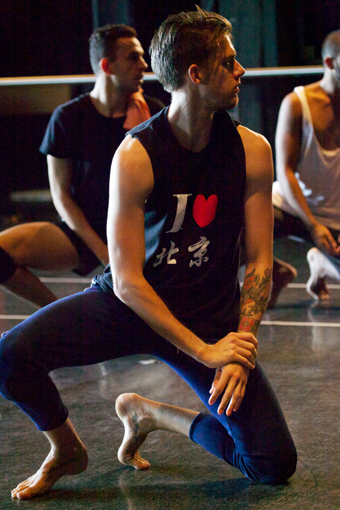
Daniel Riley McKinley (foreground), Kaine-Sultan Babij, Blak rehearsal, Bangarra
photo Greg Barrett
Daniel Riley McKinley (foreground), Kaine-Sultan Babij, Blak rehearsal, Bangarra
I MEET YOUNG INDIGENOUS DANCER AND CHOREOGRAPHER DANIEL RILEY MCKINLEY TO DISCUSS SCAR, HIS CONTRIBUTION TO BANGARRA DANCE THEATRE’S NEW WORK BLAK, WHICH ALSO FEATURES A WORK ENTITLED YEARNING BY ARTISTIC DIRECTOR STEPHEN PAGE AND KEEPERS, A PAGE-MCKINLEY COLLABORATION. A GENTLE PRESENCE, MCKINLEY EXUDES A PALPABLE PHYSICALITY IN HIS DEEP-SEATED ENTHUSIASM FOR HIS NEW CREATION, A COLLABORATION WITH SIX MALE DANCERS ON THE SUBJECT OF THE TRANSITION TO MANHOOD.
In the rehearsal room, McKinley speaks quietly, unhurriedly, checking on moves previously established, homing in on details, watching himself and the other dancers in the studio mirror as collective movement takes shape—elbows thrust out, hands reaching back in, claw-like, flexed sharply at wrists. An arm angled across the torso becomes a fixed line against which the body, dancing from a low centre of gravity, rises and sinks. There’s a meticulousness and fluidity in the detail which was also evident in Riley, the work McKinley (RT 94, p4) choreographed as part of Bangarra’s Of Sky and Earth (2010). I wrote at the time that there was “an inventiveness and welcome unpredictability in [McKinley’s] choreography.” McKinley tells me that with Scar he’s not simply creating a work but generating a dialogue among the men in Bangarra.
Tell me about the subject of the dialogue you’ve started with the men in the company?
I was really interested in creating something fresh and something contemporary around the subject of Indigenous boys going into manhood. Obviously it’s inspired by traditional initiation ceremonies, that transition from boyhood to manhood and how it works in traditional communities with the scarring and the boys being sent into the bush and having to make their way back. They’re told stories and taught songs and their level of responsibility changes.
For us, as contemporary Indigenous young men or boys, I feel it’s not so clear-cut because of this crazy world. If we live in Sydney, a beautiful city, we’re not consistently with culture. I get my daily culture fix coming to Bangarra. This is the reason I’m here, the reason I dance here, the reason I wanted to join Bangarra when I graduated from QUT—to learn about, to get culture.
Through dance?
I love dancing and I found out about my Aboriginality at quite a young age and for me, dance was that exploration of what it meant to be an Indigenous male. Every day is a learning experience. I leave here at Christmas holidays every year and I look back and think, “I’ve learned so much this year.” Stephen (Page) is the same. He’s consistently learning too. And the culture is constantly changing. There’s 40,000 years of culture to learn from and we’re always trying to find what it is.
And where you sit in it?
For me (in Scar) it was about trying to find out what the transition was for us from boys to men. It’s something I’ve thought about a lot since I joined Bangarra in 2007. Being a young first year dancer, you’re taught everything. It’s almost like you’re the youngest brother of the seven boys. So, you look up to your brothers. They’re older and they’ve got the knowledge and they’ve lived more and they have all the experience. I wanted to know when was that moment for me. I still wonder, when will I reach it? Have I reached it? When was that moment? Is it a series of steps? Is it a set of experiences that you gather together and put in your pocket and carry with you?
As choreographer you inevitably play a senior role.
Yes, of course. I’m in my seventh year, so I’m recognised in the company as a senior dancer, which I still find quite strange because I’m only 27. I think, a senior? Whoa! I’m choreographing, and dancing in the work too.
You didn’t dance in Riley, your first work, did you?
I wanted to be able to step away from it, to be able to view it as an audience whereas with this work, I want to experience it. I want to be the conductor but also be part of the band. I’m not creating every step—more just directing, forming and shaping things. So, it’s a huge collaborative effort because of the subject matter. It’s a personal thing, so I can’t exactly say, “do this or do that” or “no, that doesn’t feel right.” If (something) feels right for Waangenga (Blanco), then he should be able to do that.
So each of the dancers has a different idea of where they are in the manhood trajectory?
Exactly right, because we’re all within a 10-year gap. Waangenga is almost 30 and as a guest artist we’ve got Hunter Page-Lochard, Stephen Page’s son, who’s about to turn 21.
Have some of the dancers had more traditional experiences or are they largely from urban backgrounds?
We all grew up urban. Waangenga had a lot of connection with his Indigenous family and customs through the Torres Strait. Lenny (Mickelo) was connected to his Indigenous family but I’m not sure whether he learned dances or not. He lived in Brisbane and in Cherbourg. We’ve all had a mixed bag of experiences. We’ve all come from different places and we’re creating this gathering place onstage and in the rehearsal room.
It’s a really broad subject. What I find difficult is to bring it into one half-hour work. Obviously it’s not going to answer the question. I guess it will pose more questions. But through the course of the work, as men and boys onstage, we will go through that transition. So, it’s going to be a journey every night for us.
Presumably, even though you may not have experienced traditional life first-hand, you’re still drawing on it—there’s such a long tradition in Bangarra of spiritual advisors and investigation.
Of course, everything that Bangarra does is ingrained in that tradition, ingrained in culture. Djakapurra who’s performed with us many times has scarring between his pecs. Having danced with him a few times, I was just so interested in what they were. We got talking and that’s when I thought, well, maybe I should do a new ‘men’s work.’ I think the last men’s work at Bangarra was 2001. Stephen did Spear which was part of Skin. That’s a huge inspiration, but I’m reeling it in to where we are today as contemporary men. [Imagine] we’re a group of seven Indigenous boys walking the streets of Redfern. You look at them and think, “Where are they going? What’s their journey going to be?” They’re unlikely, in the city, to get traditional initiation. If they’re lucky enough they might get to go to the bush to do that. When will their responsibilities change?
To do this, have you adopted, as in Riley, a series of images to work to or is there a narrative?
There’s a sort of a story arc. I’m trying to stay away from vignettes. With Riley, it was very clear-cut. I had Michael Riley’s images that are so incredibly beautiful and they each had a story of their own anyway. [This time] I’d go home each night and think, “What am I trying to say?” Am I trying to take the audience on a journey or the dancers? I came to the decision that I’m going to take the dancers on a journey and the audience are voyeurs. It’s like they’ve stumbled across this gathering of boys going through this ceremony, the rite of passage, together.
Is there a sense of ritual in the work?
Absolutely. We will be doing some traditional dance and we’re using Djakapurra’s voice, but the rest of the sound is contemporary. I’ve got David Page and Paul Mac doing the music. So it’s really electronic and bassy. I was really inspired by those grimy, dirty hip hop instrumentals, bands like Clams Casino and those dirty beats for ASAP Rocky and other rappers out of America. A lot of Indigenous kids listen to that music. That’s the music of their generation. And I listen to that. It’s got this ‘attitude,’ this ego and pride behind it.
There’s a lot of vulnerability in this state as well, isn’t there?
Absolutely. The boys and I have talked a lot about that and what that vulnerability is and where that happens. We spoke about pre- and post- adolescence and what manhood is and who you look up to and who you see as a man and why. When you’re in high school, you’re trying to be yourself, but people are judging you. It’s so difficult. Even now, we’re still vulnerable. So, we’ll definitely be exploring that.
Will the seven performers each have a discrete persona?
Because the boys are creating the movement, they’re gonna be themselves. But in another sense I sort of see us as six different sides of Hunter. He’s the youngest and closest to the age we’re exploring. We’ve always had spirit guides in Bangarra—Aunty Kathy Balngayngu Marika and Djakapurra Munyarryun—but I’m sort of going to touch on a younger one, a boy who’s conducting it and who connects us and pulls us through this story. Hunter has done all his NIDA courses and films and TV shows, so his acting ability, that’s something I can draw from. And his dancing too (he’s studied ballet), it’s a good challenge for him. He loves Bangarra and he’s a great kid and we love him. It’s nice to have this youthful energy in the room. It looks so raw on him.
What about design?
Quite sparse. I’m just having a black box. [Jacob Nash’s] design for Riley was white and open. With this there’s a feeling of being more under the earth, in an underground club with this driving bass. It’s dark and moody. A few props, but mainly the light will dissect the space; the lighting (designer Matt Cox) will dictate space and shifts in mood.
And clothing?
Again, very simple and contemporary. There are so many images: the 2011 London Riots—young boys running (through) the streets in hoods. It was like they could put them on like their invisibility cloaks. We spent two weeks in Arnhem Land a month ago. We love going up there. We learn traditional dance around the fire, we sit with the kids and we just hang out with them, do what they do, find out what they get up to on these small outstations. It’s amazing how they fill their time even though there’s nothing to do out there. They sit and chat, play basketball…Looking around at what they wear, it’s all mismatched—big baggy basketball singlets and shorts, socks with thongs and hats, sunglasses at night. Their idea of fashion is really cool. You look at it and you think, well it sort of doesn’t work, but then it works on you. It helps to have their beautiful dark skin; all the colours they wear look so amazing on them. We took lots of photos when we were up there. Luke Ede is the costume designer and he’s looking at all that.
Transition into manhood in Indigenous traditional culture is men’s business and is full of secrets. Does that play some sort of role in this work?
I spoke to Djakapurra about it before we started, asked him about what traditional dance we could have for it and what song. He said there are some songs that I can’t give you. I said that’s completely fine. So he’s come up with a song that suits (the work) and a dance…the meaning of it is really poignant, really beautiful for what we’ve come out of and what we’re going into. It’s a water dance, for cleansing—the post-ceremonial dance. Goosebumps. It’s quite powerful. And the song is incredible. I sat next-door as Djakapurra recorded it at David’s [Page] studio. His voice is so incredible.
[As for the arc, in Scar you’ll see] seven men dancing. Okay, cool: they’re dancing and they’re together, but then they look frustrated. We’re going to dive down into that deep, dark hole, (into) that physical and mental frustration. We’ll rise out of that hole: “Ah!,” when it’s almost like a light [turned on]. Yes, we’re finally almost there. We’ll reach a kind of euphoria—in whatever form that will be at the end of Scar. There’s a story, a shape. Now we’re at work just colouring it.”
Bangarra Dance Theatre, Blak, National tour: Arts Centre, Melbourne, May 3-11; IPAC, Wollongong, May 17, 18; Drama Theatre, Sydney Opera House, June 8-22; Canberra Theatre Centre, July 11-13; QPAC, Brisbane, July 18-27; www.bangarra.com.au
RealTime issue #114 April-May 2013 pg. 36
© Keith Gallasch; for permission to reproduce apply to realtime@realtimearts.net
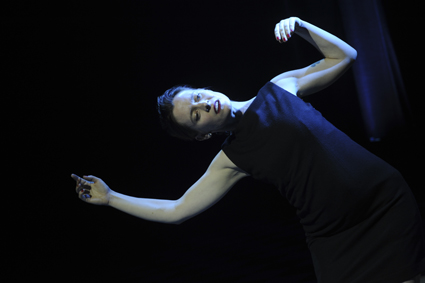
Jane McKernan, Slow Dances for Fast Times, Carriageworks
photo Heidrun Löhr
Jane McKernan, Slow Dances for Fast Times, Carriageworks
SLOW DANCES FOR FAST TIMES IS A COMPILATION OF “CHOREOGRAPHIC PORTRAITS” IN WHICH CHOREOGRAPHER MARTIN DEL AMO COLLABORATES WITH 12 AUSTRALIAN DANCERS. A “SINGLE CHOREOGRAPHIC IDEA” IS THEN EXTENDED AND MODELLED INTO “MINI-ACTS OF SOLITARY DEFIANCE” (PROGRAM).
Designer Clare Britton creates a velvety vaudevillian palace. Red carpet, red curtains, roaming spotlights and rolling projected text create a place of history and burlesque. Already there lurks a joke, for del Amo’s choreographic repertoire is the antithesis of varietal entertainment. This contextual tension creates a coherent performance that slips between the serious and the silly, between the committed and the parodied.
Some of the ‘portraits’ navigate this tension with surety. This assurance is most notable in the last of the 12 solos, danced by Jane McKernan. While the sublime Kiri Te Kanawa sings Mozart, McKernan manages to simultaneously conjure del Amo’s signature minutiae and live up to the spectacle of the voice. Holding a static kinesphere throughout she makes minuscule adjustments, creating new physical stories, states and shapes out of the almost imperceptible, rearranging the lines of her body into bright and new contortions, born deep within. One foot is turned slightly in, one knee slightly bent, one arm held uncomfortably out, distended, making the subtle torture of unease while her head dances the dance of rapture. At times McKernan’s being is an orchestra of parts speaking to each other as she floats off kilter. At other times these parts break away from each other as the deep seated pressure of excruciating movement makes apparent the tremors that are allowed to exist in del Amo’s world. This solo of seductive and rapturous crucifixion was a fine finish to a long show.
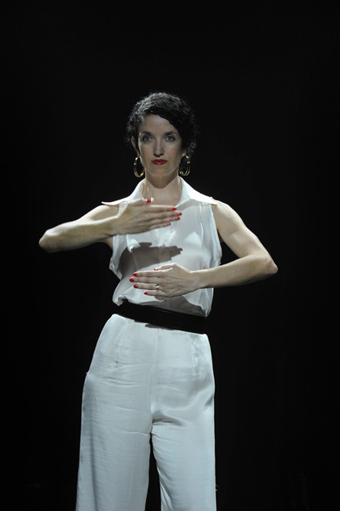
Elizabeth Ryan, Slow Dances for Fast Times, Carriageworks
photo Heidrun Löhr
Elizabeth Ryan, Slow Dances for Fast Times, Carriageworks
Solos danced by Luke Smiles, Sara Black and Kirk Page are revisited versions of earlier works: “birthday present[s]” from del Amo to dancer friends. Involuted light heartedness becomes satiric as highly skilled dancers move about as children or chorus line drunks, in a display of anti-technique. This was made more patently clear in the ‘bonus track’ finale, a new ensemble choreography where the salient formations and styles of well known local dance companies are gently, fleetingly, but clearly lampooned.
Certain choreographic and political strands emerged from this evening’s retrospectivity: self-referencing, political possibilities of movement and commitment to clearly refined and recognisable physical techniques. Certain recurrent physicalities reveal del Amo’s choreographic proclivities: the gentle distortions of discomfort as bodies are drawn away from graceful wholeness. The circular transcriptions of space seen in the endless running round the floor patterns and in the arcing of dancers as they sweep around their own axis in that discombobulating ongoingness that makes these solos fade rather than end. Then there are those floating arms that trace, dangle and sway as body parts with mind. These arms are what most conjured the choreographer-body, making me miss Martin.
Martin del Amo, Slow Dances for Fast Times, choreographer, director Martin del Amo, dancers Sara Black, Jade Dewi Tyas Tunggal, Benjamin Hancock, Raghav Handa, Julie-Anne Long, Jane McKernan, Sean Marcs, Kirk Page, Elizabeth Ryan, Luke Smiles, Vicki Van Hout, James Welsby, design Clare Britton, lighting Matthew Marshall, sound compilation Marcus Whale, production Performing Lines; Carriageworks, Sydney, March 6-9
RealTime issue #114 April-May 2013 pg. 38
© Pauline Manley; for permission to reproduce apply to realtime@realtimearts.net
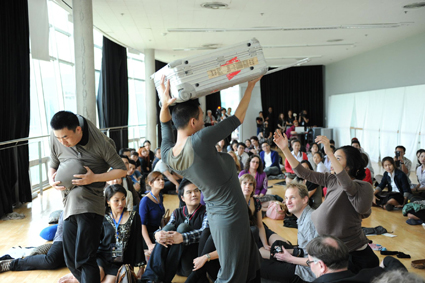
On the Road Again, Cai Ying, courtesy Bangkok University
ONE OF THE TASKS OF THE WORLD SYMPOSIUM ON GLOBAL ENCOUNTERS IN SOUTH-EAST ASIAN PERFORMING ARTS, WHICH RECENTLY TOOK PLACE IN BANGKOK, WAS TO BRING TO THE SURFACE THE TRANSNATIONAL SOUTH-EAST ASIAN ARTIST. AS THE INTERNET HAS SUCCEEDED IN BRINGING CIVILISATIONS CLOSER TO EACH OTHER, IT IS INTERESTING TO FIND WHERE AND HOW SOUTH-EAST ASIAN PERFORMING ART POSITS ITSELF IN AN UNDENIABLE WAVE OF MODERNISATION AND GLOBALISATION.
The papers presented at the conference displayed these preoccupations, as in the research of Parichat Jungwiwattanaporn on the work of Pichet Klunchun; Bethany Collier, who noted contemporary methods for the new generation learning the Balinese Arja; Miguel Escobar Varela on using hip hop music with the Wayang Kulit; Shreyosi Mukherjee looking at a Malaysian Mak Yong adaptation of Shakespeare’s A Midsummer Night’s Dream; William Petersen, who is enchanted with the contemporary aspect of the otherwise traditionally Tagalog senakulo; and, among many others, Tiffany Strawson recounting her first-hand experience of learning the masked dance topengpajegan. However, in the symposium performances Asian theatre maintained its traditional veneer.
Bangkok University’s Communication Arts Complex provided diverse choices of venues for performances. Traditional performances, including a charming Cantonese opera and the Balinese Barong-Rangda dance, were staged in the amphitheatre in the centre of the complex. Shadow puppet plays and three-hour heavy dramas were held in auditoriums. All the drop-in installations were located in small and medium-sized studios.
plant me a word
Patricia Correa, from Portugal, presented Plant Me a Word, which required little movement, in a small, carpeted room. Seated at a small wooden desk with her feet planted in a pot of soil, Correa looks around the room and invites a spectator to sit before her. Once seated, that person becomes part of the work. Correa immediately hands them a leaf and instructs them to “plant me a word” on it. Any word will do, it seems—she puts the entire leaf in her mouth, chews and swallows, all the while maintaining intense eye contact.
The onlooker wonders about the significance of the pot of soil, and what could happen if you asked Correa a question or kept her from putting the leaf in her mouth, or whether the leaves and ink might eventually poison her. But as she scans the room for the next participant, curiosity is replaced by terror—split-second terror of having to join in the work and forfeiting your position as audience. Whatever her objectives, Correa’s attempt to take the audience out of their comfort zone and into the work itself was quite successful over its three-day duration. The audience appeared to be helping her to ‘grow’ with the words they planted. There was no exchange of ideas; the work was a push to get ideas and words out of her participants’ bodies, to take root and grow with the tree that is Correa.
drawing your attention
Liesje van den Berk (Netherlands) set up a room in which lights hit a glass wall so that she could ‘draw’ the shadows of those who came to view her installation. She moves quickly, outlining the shifting, shadowy figures. Van den Berk also seems to simultaneously respond to guitarist Jeen Gert Rabs’ soundscape.
The point of Drawing Your Attention is not the finished product, though Van den Berk, primarily a visual artist, is definitely interested in that as well. Its value resides in the performance. The audience members whose shadows are being drawn on the wall are instantly performers, some accommodating Van den Berk by posing, so that she has more interesting shapes to outline.
thai tracings
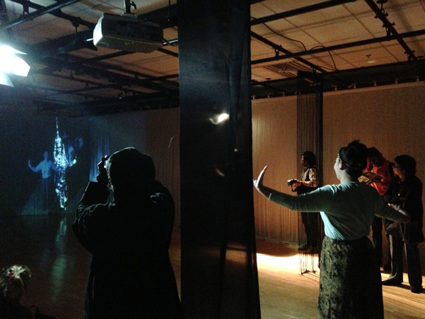
Thai Tracings, Sarah Rubidge
photo courtesy Bangkok University
Thai Tracings, Sarah Rubidge
At a Western conference, a new media panel would be bursting at the seams. However, the one in this symposium attracted only minimal attendance, while most participants were at the “Traditional Performance in a Changing World” panel conducted in the next room. South-East Asia is only starting to discover new media, as evidenced by the papers and performances presented.
The new media panel keynote speaker Sarah Rubidge (UK) discussed the progress of digital media in the development of contemporary dance. She provided a more intimate view of these digital trends with her installation, Thai Tracings. Images of classical Thai dancers were projected onto the walls of the studio, sometimes against an aerial view of Bangkok’s cityscape. To further blur the boundary between classical and contemporary, there were intervals where a live-feed of members of the audience standing in the room was projected on a screen beside the classical dancer.
With the recognition that the viewers are now part of the work, the screen presents the audience-performance relationship in its purest form, spectator and spectacle side by side on one panel. But once the realisation sets in, the dynamic is changed, by varying degrees: delight, fright, feigned disaffection. Some, interestingly, start to dance along with the projections, doing the same traditional movement but in street clothes.
on the road again
In Hong Kong choreographer Cai Ying’s On the Road Again, the performers move around the audience seated on the studio floor, interacting with them such that they become part of the performance and some of their reactions dictate the action. After circling the room holding carry-on luggage, the choreographer and her dancers stuff their clothes with travel pillows and melt into lethargy, as if turning into the pillows themselves. The performance is based on the artist’s dreams about the many journeys she’s taken. At the end, the dancers run out of the studio, leaping across a field we can see through the window and beckoning us to join them (we didn’t).
a mask for a shadow puppet
Hanuman Meets His Father is an elaborate Wayang theatre experiment where the shadow puppet play and the masked dance drama occur on the same stage. It was quite electrifying when the masked actor playing Hanuman suddenly leapt onto the stage from behind the screen of shadows—the last thing you’d expect, and yet it did not feel out of place.The scholars studying Indonesian theatre were astounded and immediately wanted to know how older generations of theatre practitioners might react. The Wayang Theatre of Bali has yet to perform this for the locals, but is optimistic.
Perhaps to Western practitioners, this may not seem as groundbreaking as it does to South-East Asian artists. Informed by a strong sense of tradition and yet reeling from the effects of colonialism, South-East Asians have the burden of bridging the gap between past and present, between where they live and where they can practice their art. Just how they’ll get there will be interesting in practice, and as a topic for a future conference.
World Symposium on Global Encounters in South-East Asian Performing Arts: Plant Me a Word, concept, performer Patricia Correa, Feb 1-3; Drawing Your Attention, visual artist, concept, performer Liesje van den Berk, music Jeen Gert Rabs, Feb 1-3; Thai Tracings, concept, digital execution Sarah Rubidge, Feb 1-3; On the Road Again, choreographer Cai Ying, Feb 1; Hanuman Meets His Father, director I Wayan Dibia, performers the Wayang Theater, Bangkok University, Thailand, Feb 3
RealTime issue #114 April-May 2013 pg. 38
© Joelle Jacinto; for permission to reproduce apply to realtime@realtimearts.net
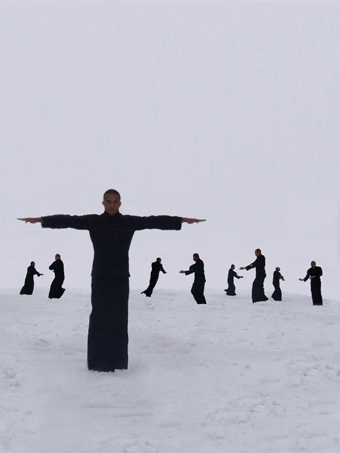
Lemi Ponifasio, Birds with Skymirrors, MAU, courtesy the company
AT A MAU PERFORMANCE YOU JUST HAVE TO LET YOURSELF BE, OPENING YOURSELF UP TO AN OSMOSIS OF STRANGE SOUNDS AND MOVEMENTS SEEPING INTO YOUR VERY BEING. ARTISTIC DIRECTOR OF THE AUCKLAND-BASED COMPANY, SAMOAN LEMI PONIFASIO BELIEVES THAT OUR LIVES ARE DOMINATED BY DOING AND ACTING, BLINDING US TO “THE INVISIBLE DIMENSIONS OF OUR LIVES”—OUR CONNECTION WITH THE EARTH, OUR BEING AT ONE WITH IT.
I spoke with the witty and erudite Ponifasio by phone about his internationally acclaimed Birds with Skymirrors, part of Carriageworks’ 2013 program, first asking him if each of his works is initially triggered by an image. I was thinking of the press releases and interviews that reveal that it was the sight of a frigate bird trailing shining videotape (the skymirror of the title) from its beak that initiated the making of the work. “Well,” he quips, “it wasn’t a Saul of Damascus moment, but it gave me an idea.”
What kind of idea?
Fantastic things. All kinds of terrible things. It was very funny because I thought, at first, what a beautiful sight, and then became quite afraid, because I suddenly felt alone and wondering what was happening. [The birds use the tapes for their nests; but this kind of pollution kills massive numbers of birds and animals across the Pacific. Eds] Then you start to think about everything in life from ancestors to all kinds of civilisations. I was thinking about Botticelli, the Venus picture; I felt this image of innocence had turned into a whore. I thought about the Persian poem, The Conference of the Birds. Your mind wanders everywhere. It was a moment you feel the world is so big—that kind of connection. I’m not trying to tell anybody not to pollute the water. It’s simply about our connection, the genealogy that we share with birds. We are part of the [lives] of birds. That is [the kind of connection] I try to make with my work.
I’ve read that you’re very keen for the audience to enter a contemplative state; you don’t use narrative because you don’t want to impose stories on people.
The theatre has become too human and is about people’s storytelling and people expressing people. I think the theatre is more than that. It’s a cosmological experience. I’m sure the origin of theatre was our feeling this intense bond with existence so that we get up and sing or perform. So the theatre I try to make is about how to return you to or take you to a dimension that is not about human time but more about cosmological time—how to get you away from the phenomenal world, the world of everyday into the noumenal, which is a much bigger world.
In essence, to stop thinking just about oneself? You said in one interview that you thought that Western theatre was simply narcissistic.
No! (LAUGHS). But I do think the theatre is not for mirroring life; it’s to shatter the mirror that we’ve created for ourselves. The mirror of life is really what we construct in our heads. That’s our ego. And I think the invitation of the theatre is an invitation to be. And that’s a really hard thing for the human being, but it’s part of our title as ‘human beings.’
There are practices and concepts in your work that appear to come directly from your own culture. How do these figure in your thinking?
Well, it might sound strange, but I don’t think I come from a culture. I think my arrival on the Earth was on the island of Samoa. I just arrived there and I don’t think so much about culture and cultural identity.
But you certainly draw on it.
It’s what I know.
It’s a part of you?
It’s pure form, but I know it along with knowing what’s happening in New York or Algeria or Iraq. So it’s a consciousness. It’s not something particular to a culture, I don’t think.
So the work is not going to say to an audience, do something about climate change, but I assume it’s part of the work’s ‘subconscious.’ The people who work with you, your community, some of them would come from islands, I suppose, that are in danger of disappearing under the ocean in years to come.
Well, I think there is a bigger thinking, something more than just cleaning up the rubbish or hugging trees or buying organic. I think this is a very childish way of dealing with climate change. We need to think in terms of our relationship with the world. The closer we feel the connection, the more we appreciate that we are just part of the process of nature, we can somehow understand the intense link that we have with nature. For example, a dog is a dog but if you take a dog as your puppy, then you have a strong sense of relationship. I think that is what I’m trying to do—to bring you to the present, to just be present and by being present you can become more strongly aware of this.
Like the notion of ‘just being’ rather than doing and acting?
Well, it’s a consciousness. I could take you to an English garden that’s full of roses and you can look at it and admire it; or I could take you to a Zen garden where there is nothing but stones and a rock. You’re standing there and you feel differently. You attend to your existence—why am I here? So, it’s the power to bring forth an experience of presence and being conscious of one’s being.
Elsewhere you’ve described Birds with Skymirrors as being like “the last dance on Earth,” which sounds very apocalyptic, and ritualistic. A review in New Zealand described your work as “an ancient futuristic ritual.” This idea of ceremony seems to be important to you.
I say to the people I work with, “If this is the last dance or the last song, what are you going to sing about?” Are you going to sing about your iPad or your iPhone? No. We are going to sing about something very important to our lives. So this dimension of one’s life is why I talk about the last dance. I think the audience who come to the performance must not come merrily like they’re going on a dinner date. It’s like a pilgrimage, going to the theatre. There is something that you come to engage with; there’s something that you bring; there’s something that you want to be with.
There’s a difference between ceremony and ritual. I’m not interested in ritual. People always say ‘ritual,’ but a ceremony is when we come to engage, because there is a reason why we gather, an important step in one’s life, whether it’s a funeral or a birth. In ceremony we elevate ourselves into another sort of sense of ourselves. And I think the point of the theatre is to remind the soul of its higher self, a higher space.
My performers are not necessarily trying to express anything. They are there to serve the ceremony, to serve the space. Their bodies are ceremonial bodies—that’s how I prepare them. Of course, they have to do what they need to do well, but their presence, their activation of the space, it’s the whole point of going to the theatre, performing for it.
You don’t talk a lot about dance or art or artists, but I was astonished by the variety of gesture and movement in your work, the sense of a melding of physical movement and dance from across the region.
I work with people who don’t have Western training. They are all from communities. They know the language of ceremony, the movement of ceremony, the presence of ceremony. This is why I like working with them—because of the amazing knowledge you don’t need to teach anybody. You can’t learn that from art school.
In the performance there is tremendous individual sensuality and sinuousness, extreme body states and a great sense of synchronicity, of meticulous movement together. These people must spend a lot of time with you to achieve that sense of unanimity.
It’s a very strange thing to say, but we don’t practice that much. We do other kinds of work. We think it’s much more important than going to the dance.
What other kind of work is that?
Being part of the community. I make them go and do what they do normally. That gives you the sense of a different way of being. I want the dancers to be the stage, not dancing on the stage. It’s a different quality. I think it’s a proposal of the theatre. We need to move away from a theatre that is too much about the human and loses its power because it’s just humans talking to humans, like soap opera, instead of humans talking to the divine.
* * *
After seeing MAU’s The Tempest in the 2010 Sydney Festival I wrote, “Walter Benjamin’s angel of history wanders the stage screaming; a group of monks glide about in fast, small steps and with beautifully complex gesturing; a man very convincingly becomes a dog; a Maori elder addresses us, first revealing his tattoos, later dressed in a suit; and a lone man appears to bend and collapse beneath the weight of the world until a moment of release late in the work. For all its mysteries, Mau is an engrossing work suggestive of post-colonial tensions, environmental exploitation and a Pacific Rim cultural sharing” (RT95, p14). The Tempest was an experience as rewarding as it was demanding, and difficult to put into words—you just had to be there, and just be. As you will, at Birds with Skymirrors.
MAU, Birds with Skymirrors, Carriageworks, Sydney, May 1-4; www.carriageworks.com.au; co-production Théâtre de la Ville (Paris), Theater der Welt 2010 RUHR, spielzeit’europa Berliner Festspiele, Wiener Festwochen, KVS Brussels, Holland Festival, Mercat de les Flors Barcelona, DeSingel Antwerp, New Zealand International Arts Festival
RealTime issue #114 April-May 2013 pg. 39
© Keith Gallasch; for permission to reproduce apply to realtime@realtimearts.net
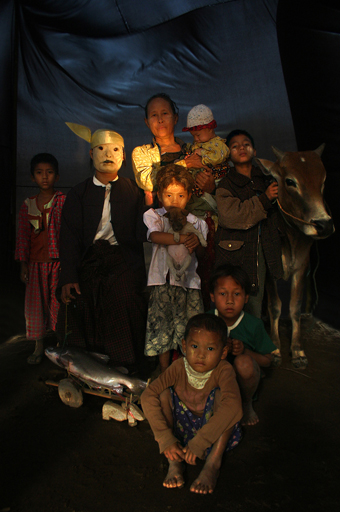
Nge Lay, The Relevancy of Restricted Things (2010), from the collection of the Singapore Art Museum and Fukuoka Asian Art Museum
IN JANUARY I WAS INVITED TO PARTICIPATE IN THE 8TH FLYING CIRCUS PROJECT (FCP) IN MYANMAR AND SINGAPORE. FCP IS AN INITIATIVE OF ONG KENG SEN, DIRECTOR OF THEATRE WORKS SINGAPORE AND FROM ITS BEGINNINGS IN 1996 THE INTERDISCIPLINARY LAB HAS EXPLORED CREATIVE EXPRESSION IN ASIA.
From 2007 FCP widened its brief to include artists from Europe, the Arab world and Africa. Its focal points are individual creative action, encountering difference and the strategies of art practice, emphasising the tenacity of local sites—with their artists, activists and public intellectuals. The lab is curated around the central notion of ‘world creating,’ how do we form micro-worlds, which are responsible, articulated and ethically engaged?
superintense & ulter u
In 2007, the FCP visited Ho Chi Minh City/Singapore and in 2010 explored Phnom Penh/Singapore. Each time a group of international artists, themselves working in sites of transition and cultural change, is invited to participate in a curated local program. The FCP artists contribute a one-hour presentation from their own ‘world’ in a back-to-back endurance fest titled Superintense, in 2013 staged in Yangon (Rangoon) and Singapore. Theatre Works also runs the Alter U program as a tandem project, an ‘alternative university’ with a commitment to artist-to-artist exchange and exposure to a diversity of artistic strategies which they describe as “a shared micro-space/time made by artists for world-citizens to contemplate action.” Ulter U is the part of the program where local artists engage with the FCP artists and includes commissioned local work, workshops, presentations and other activities to stimulate the development of individual artists in their own context.
on the path to democracy
In 2010 Keng Sen began exploring the possibility of staging FCP8 in Myanmar while the so-called transition to democracy rapidly accelerated during that period. The release of Daw Aung San Suu Kyi followed by her party, the National League for Democracy, gaining 43 seats in the Myanmar Parliament spearheaded the change. As Keng Sen says, “It is true that this is only a fraction of the total 664 seats but it is still a significant dent in the armoured tank that runs the land some have nicknamed ‘the forgotten country.’” Well it’s no longer forgotten, for never a week passes without some headline grabbing news: from President Obama’s historic visit to the Rohingar issue and ethnic conflicts in the western state of Rakhine, to the violent security raids on monks and mine-workers during a recent protest in Monywa.
fcp8
FCP8 took place in the shifting sands of a Myanmar in transition at a moment in time where artists and activists who had lived a life of fear simply for taking on the roles of educators, critical thinkers or documenters were facing an overwhelming level of change. This included the possibility of being able to speak directly to their audiences, exposure to international arts practices and, of course, the potential for all this to be swept away again in the erratic path of a violent and repressive regime.
artists as public intellectuals
The essential structure of FCP, of exchange across local and global contexts, laid itself out pretty quickly in Yangon where all activity took place at the Alliance Francaise. No strangers to censorship issues coming from Singapore, the Theatre Works team carefully set up the context where Burmese artists and activists were able to speak publicly on French soil.
In introducing the range of artists in the opening days in Yangon, Keng Sen proposed that the 8th FCP look at the role of public intellectuals in forming new societies. How do they communicate with a mass audience beyond the arts community and in a delicate dance with the authorities? We heard a range of approaches to change through arts practice from doctor and educationalist Ko Tah, cartoonist Au Pi Kyeh, novelist and environmentalist Ju to filmmaker Keiko Sei.
Burmese painter, photographer and video journalist Sithu Zeya, installation artist and photographer Nge Lay and performance artist Lyn Htet, director of Theatre of the Disturbed, have all worked from inside and outside the country and have each faced fear of censorship and imprisonment. 23-year-old Sithu Zeya was arrested for taking pictures of the aftermath of explosions in Yangon and sentenced to 18 years imprisonment. He was released on January 2012 after the relaxing of the censorship laws. Each of the artists has developed strategies to reflect government atrocities and stimulate art practice.
In 2013 FCP widened its scope to include activism and journalism. Keng Sen commented that the VJs (video journalists) are the cowboys of journalism, putting themselves in view of the secret police to make sure stories are told and smuggling footage out of the country, most often to Thailand. When Sun, one of the VJs featured in the award-winning documentary Burma VJ, addressed us at the French Embassy in Yangon it was the first time he had spoken publicly in his own country. One of Sun’s first statements to us was that Burma needs to release all political prisoners. Many of his colleagues have been tortured and are still locked away.
liberating film
Keiko Sei, a Japanese filmmaker working for 15 years in Burma, explained that the country has been quite random in its censorship; DVDs were sold quite freely over the past decade. What was lacking was not information but education and guidance on how to work with information that was forbidden. People were overloaded with mediatised junk and lacked perspective; as opposed to Eastern European dictatorships which have withheld media, the Burmese government took the opposite approach: “Korean soap operas, endless football and completely poisonous Hip Hop are what the government swamped the broadcast time with.” After being raided by the secret police and losing all the participants in her film discussion project Keiko Sei asked herself, “What would I risk 15 years’ imprisonment for, what art is worth that risk? It was a big responsibility for me.” After retreating to Thailand for some time, she returned, assisted by the Prague Film School who now take several students from Myanmar each year into their training program. Film played a significant part in FCP8 with the commissioning of English subtitles for short films by young Burmese filmmakers, the restoration of a lost print of the fabulous Wearing Velvet Slippers, Holding a Golden Umbrella (1971) by Maung Wanna (Godard meets Blanche Dubois in Yangon 1970!) and the presentation of the second ever Myanmar Film Festival in Mandalay.
theatre of the disturbed
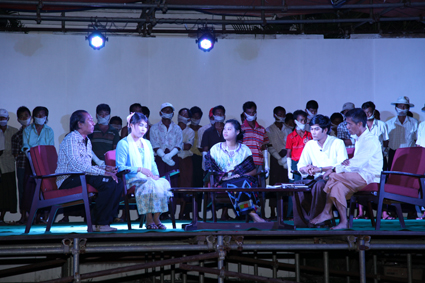
Hotel Reverie: Part 2 , Theatre of the Disturbed, Yangon during Flying Circus Project #8
courtesy the artists and Flying Circus Project
Hotel Reverie: Part 2 , Theatre of the Disturbed, Yangon during Flying Circus Project #8
One of the most tangible elements of FCP was the commissioning program by Theatre Works which included two productions of the Yangon-based performance art company, Theatre of the Disturbed. The first production was a restaging of Hotel Reverie Part 1, a production which director Lin Thet stated was an experiment in considering the relevance of producing Shakespeare’s Titus Andronicus in Myanmar. The performance was presented in the gardens of the French Institute, beginning with a libation ceremony by nine Buddhist monks, chanting in memory of those who disappeared during the 64 years of military rule.
Throughout the performance 64 male workers, gagged and with their hands bound, stood, leaned or sat (apparently depending on their levels of boredom or exhaustion) as a background to the action downstage. Following the libation ceremony a talk show was staged with three prominent activists, one of whom had endured lengthy imprisonment, discussing the moral, spiritual and political concerns of using violence as resistance to a regime. Each statement was translated at length for our benefit, resulting in a painfully drawn-out experience and growing concern for the 64 men wilting in the background. In the final moments a performance art nod to Titus Andronicus was played out involving a young woman with a pram full of raw meat and an overweight young man on stage inhaling ice cream.
Exhausted on the way home in the bus back through the Yangon traffic, the FCP artists discussed the work from our differing perspectives, with one of the new media artists from India prophesying Lin Htet will become famous as one of the pioneers of contemporary art in Myanmar. I felt I had had a comprehensive introduction to the complexities facing the fusion of art and activism in Myanmar, the troubled nature of importing art movements and most importantly the voice of Lin Htet, vocalising his experience of his country’s bloody history. The event was indeed disturbing and yet it offered a compelling picture of the struggles facing art making in this “forgotten country.”
something or nothing?
As the FCP artist presentations began in Yangon, Keng Sen noted that the connections (of his curation) would become visible over the coming days, that the different strategies we employ as artists in our work of ‘world creating’ in our different contexts would emerge. These would come to include “Land Art” as a link, the documentation of unsanctioned memories of atrocities and also the work of art making in conflict zones. With three Sri Lankan artists from Singhalese and Tamil backgrounds present, the issue of how to build paths to artistic practice in Sri Lanka was also a focus and perhaps an entree to the next FCP.
Keng Sen declared that one of the essential elements of FCP is “collaboration in location,” the histories and communities of location. Choosing not to use the word “community”—feeling it has been appropriated by funding bodies—he raised the issue of ‘for whom is the work made?,’ proposing “when we talk of making communities NGO’s want to make something useful. The ‘useful’ is defined very conservatively: we are meant to pass on useful skills to disadvantaged people. Some people say the Flying Circus is not useful. It produces nothing, but the concept of ‘nothing’ from an Asian spiritual perspective, is also something. What is the something?”
Sri Lankan filmmaker and photographer Anomaa Rajakaruna’s presentation outlined her documentation projects during and after a war, which has supposedly ended, though, as she stated, the struggle continues. She has made five video features, each of which have been banned in Sri Lanka, so the issue of who she was making her work for was critical. Keng Sen commented on the work of artists in conflict zones documenting for the future, a critical issue in Myanmar where memory, documentation and practices of remembrance have been controlled by a military regime, producing an ‘official memory’ for 64 years.
New media artists Sonal Jain and Mriganka Madhukaillya from Desire Machine Collective, based in Assam, suggested that coming from the North West of India “there is an expectation from people that you will create exotic images of conflict, a kind of ‘conflict tourism.’” They asked, “When you are living in a conflict zone everyday, what does it mean to make art?”
At the close of the period in Yangon and following the theatrical and confronting South African artist Brett Baily’s Third World Bun Fight, Keng Sen said, “We have been hearing of stories of violence and pain but also of humour and glamour. There are two threads of artistic response present, a kind of daily life investigation and a transgressive, subverted investigation.”
beyond mandalay: museum art project#5
After nine days in Yangon we moved north to Mandalay where we were advised to keep an even lower profile since a group of Malaysian street theatre performers had been deported on the spot a couple of months earlier after attempting to present a performance there.
Perhaps the highlight for me, and the day I felt the chemistry of both the FCP and Ulter U projects converging, was the day trip from Mandalay by boat across the Irrawaddy River to the sleepy riverside village of Mignon to view the Museum Art Project # 5, a pop-up style contemporary gallery curated by Tun Win Aung and Wah Nu and supported by FCP. Like many of the artists we had met they were concerned with bridging rural life and the art world, responding to the curiosity of the villagers with their projects. “In 2010, we started to realise small scale exhibition spaces in different villages and towns where there are no art galleries or museums built for the people. We thought exhibition designs should be connected and reflect on local people’s daily life, situations or landscapes. Space designs should be friendly and accessible for local people. So, we chose local small huts, tents and barns.”
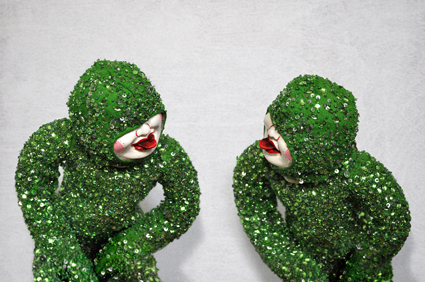
May Phue Thet, Be Happy Be Happy #02 (2012)
courtesy the artist
May Phue Thet, Be Happy Be Happy #02 (2012)
In Museum Art Project #5, Ming Thein’s Another Realm is a gigantic rifle made of hollow white cloth, suspended from the ceiling installed in one of the simple multi-use spaces perched on the banks of the river. May Phu Thet’s Be Happy Be Happy is a series of photos of Burmese baby puppets: garish white creatures with protruding, retractable red tongues, sporting lawn green sequined outfits. Curator Wah Nu addressed the FCP group and local guests saying, “This is an ordinary village but artists here have made it an extraordinary village. Now it’s like an art community where artists come to rent spaces and we can even say that the arts community here is stronger than in Mandalay. We have invited FCP here with the hope of exchanging with international artists. We hope it will be a good experience for the locals.”
What followed were two quite extraordinary presentations by FCP artists Sananthanan Thamotharampillai, a Tamil visual artist from Jaffana in northern Sri Lanka, and the wonderfully provocative Japanese performance maker and visual artist Tadasu Takamine, previously a member of Dumb Type. The range of their presentations—Sananthanan’s art book documenting Tamil displacement in hand drawn memories of the footprint of homes lost and Tadasu’s solo exhibition Cool in Japan, a series of rooms installed in Art Tower Mito as statements on Japan post-Fukushima—seemed to illuminate the goals of FCP as a site for exchange across worlds of experience.
For me FCP was a chance for reflection on our context in Australia, filtered through constant discussion with my good friend, South African artist Brett Baily, in our Southern Hemisphere gang of two! Long bus rides, pauses between presentations, random moments in temples gave space for exchange of the ideas behind the ideas between the participating artists, of what we do, how we do it and why, when and where we do it….And to meet new artists working in new contexts around the world, post Saffron revolution, post-Fukushima, post Arab Spring, in transition to democracy, or after war, under censorship or post apologies and reconciliation commissions, facing new challenges in cultural politics and representation.
Note: ‘Myanmar’ and ‘Burma’ are currently used interchangeably in that country. For more details on FCP8 see the blog by Singaporean theatre critic and writer Ng Yi-Sheng http://flyingcircusproject.weebly.com/index.html and the FCP website http://flyingcircusproject2013.wordpress.com/about/.
FCP8, Yangon and Mandalay, Myanmar, Jan 3-4; Singapore Jan 16-20, supported by the Ford Foundation, the Institut Français, the Lee Foundation and the National Arts Council (Singapore).
RealTime issue #114 April-May 2013 pg. 40-41
© Rachel Swain; for permission to reproduce apply to realtime@realtimearts.net
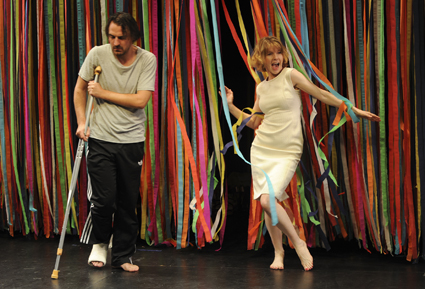
Ewen Leslie, Jacqueline McKenzie, Cat on a Hot Tin Roof
photo Heidrun Löhr
Ewen Leslie, Jacqueline McKenzie, Cat on a Hot Tin Roof
FOUR PRODUCTIONS, FOUR KINDS OF ENGAGEMENT—BELVOIR’S OVER-HEATED AUSTRALIAN ASSIMILATION OF CAT ON A HOT TIN ROOF, THE LIVING ROOM THEATRE’S OVERWROUGHT APPROPRIATION OF CONTEMPORARY PERFORMANCE, THE FIRST GARDEN’S TOO, TOO DIDACTIC RENDERING OF A LIFE, AND THE NATIONAL THEATRE OF BRITAIN’S CLEVER IMAGINING OF A COMMEDIA DELL’ARTE-INFUSED 60S BRITISH FARCE. SUCH ARE THE THINGS THAT THEATRE IS MADE OF.
belvoir, cat on a hot tin roof
There was pretty much unanimity among Sydney reviewers that Belvoir’s production of Tennessee Williams’ Cat on Hot Tin Roof (1955) was flawed, not least because of the directorial decision to render it in a tonally neutral Australian English. Bye bye Williams’ musicality, save for Big Mama, Lynette Curran’s marked oz accent delivering something of the much-missed poetry. In Jacqueline Mackenzie’s Maggie the loss of Williams’ lyricism meant that she was all “on a hot tin roof,” embodying a stunning hyperactivity born of emotional and sexual starvation, but not at all sensual, sinuous or feline. Elizabeth Taylor in the film (1958) conveyed something of the toxic combination of sultry languor and outburst that was missing here, for all of Mackenzie’s otherwise finely nuanced performance.
The production is framed by a large curtain comprising brightly coloured strips, suggestive of celebration, through which entrances and exits can be made on a revolve which allows for characters, a piano and various pieces of furniture to come and go, and for scenes to merge seamlessly. The frame for the performance thus becomes circular, at one stage lined by Maggie’s shoe collection, at another sustaining the momentum of Maggie’s fruitless pursuit of the limping Brick (Ewen Leslie)—the husband wounded by the death of his dearest friend and near silenced by the inability to express his homosexuality.
Maggie’s self-belief and sense of theatricality are amplified from the opening with an extended focus on her dressing, making up and applying toe-nail polish all the while verbally pummelling the still Brick and at one point scissor locking him with her legs. Brick breaks Maggie’s flow with silence or a blunt counter-rhythm. The fraught relationship between Brick and his father, Big Daddy extends this counterpoint—at its best on the occasions when Marshall Napier (a late replacement for an ill Anthony Phelan), was free of the script, the pair realising a verbal dance of evasion and potential connection fuelled by Big Daddy’s needy desire (after a cancer scare) to communicate and Brick’s belief that it had never happened and never will. The dialogue is frequently about talk—the meaning and weight of words, ‘pity,’ ‘homo,’ ‘truth,’ ‘queer’ and especially ‘disgust’; about questions, the barrage aimed at the unresponsive Brick by Maggie and Big Daddy; and when talk fails—a crutch kicked away, furniture smashed, the curtain torn down (melodramatically underlined with screaming guitar).
The structure of Cat on a Hot Tin Roof poses a particular challenge of balance. Maggie is the driving force of the first third of the play with Brick a reticent, sulky presence. The conflict between Big Daddy and Brick, again a battle against refusal, is the play’s centre. This is followed by Maggie’s manipulative assertion of her husband’s rights—and then her own as she prepares, in this production, to fellate Brick. That the drama plays out more between a dying father and his son than between husband and wife (Maggie is a lesser psychological and stage presence in the latter half of the play) makes the ending feel unlikely and the relationship forever unresolved. Perhaps that’s as it should be. But we’re left in no doubt about Maggie’s strength and determination, if uncertain of Brick’s passive resolve. Despite critical reserve, the profound loss of the music of Williams’ Southern English and an absence of interpretive clarity (unusual for director Simon Stone), Belvoir’s volatile Cat on a Hot Tin Roof has apparently proved to be a popular success—a family saga with themes still quite contemporary and big issues—existential disgust, social prejudice and a sense of renewal with “a life in the place of death”—all writ large.
i love todd sampson
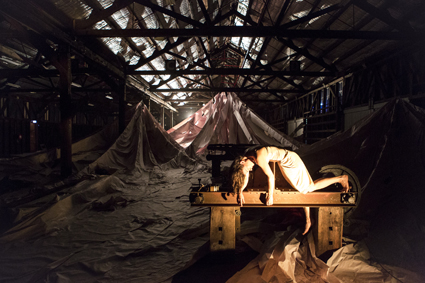
Gabrielle Quin, I Love Todd Sampson, The Living Room Theatre
photo Brett Boardman
Gabrielle Quin, I Love Todd Sampson, The Living Room Theatre
Pier 2/3, Walsh Bay is the expansive site for the Living Room Theatre’s I Love Todd Sampson—Voices of the Vulnerable, a large-scale multimedia installation through which the audience follow Laura (Gabrielle Quinn), a woman suffering a nervous breakdown, the result of abuse and the likely false belief that she is responsible for the death of a cellist. On a journey into deepening madness, Laura encounters her mother, people from her past, a would-be lover whom she consistently rejects and symbolic figures (a woman abseiling across the wharf’s timber walls while towing a resistant figure) in a variety of installations designed by members of local architectural firms. These vary from domestic (rooms within rooms) to surreal (a mountainous winterscape made of paper) and domestic-surreal (a stylish, seemingly off-balance kitchen, the setting for an unstable domestic scenario). Adding to the sense of unease created by changes of location and character mutations, is the voiceover provided by the actual Todd Sampson (CEO of Leo Burnett Australia, co-creator of the Earth Hour initiative and commentator on The Gruen Transfer and The Project). Laura aurally hallucinates him as her saviour, but when she fails to make him incarnate, and sexual, in a spooky (carefully designed) wreck of a building, she emotionally unravels. Finally, after being subjected to increasingly nightmarish scenarios (including a near hallucinatory vision—for the audience—of a rain shower sparkling into suspended motion), she collapses onto rusted machinery in an arctic waste and dies.
While to all appearances a contemporary performance work I Love Todd Sampson was burdened by heavy-handed acting, taxing longeurs and highly variable design quality, as well as by sundry performance clichés. The scale of Wharf 2/3 meant that text, either doggedly literal or numbingly opaque, wasn’t always audible. I Love Todd Sampson is a work of excess but not excess that yields wisdom. It has some structural and psychological kinship with Botho Strauss’ similarly discursive Gross und Klein, but Strauss’ vision is more consistently lateral and quite un-melodramatic; Lotte might be regarded as mad by those she encounters, but they themselves prove to be more dangerous. If I Love Todd Sampson is clearly the work of ambitious young artists defeated by the scale of their vision, they nonetheless warrant praise for realising it on such scale and for the rigour, if not subtlety, with which Gabrielle Quinn lives out Laura’s fatal madness.
one man, two guv’nors
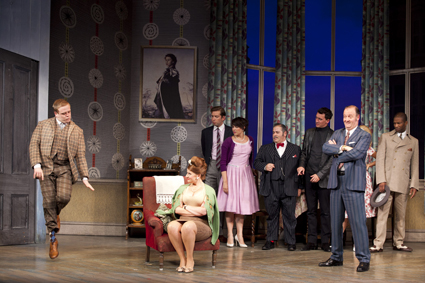
One Man, Two Guv’nors, National Theatre of Great Britain
photo Lisa Tomasetti
One Man, Two Guv’nors, National Theatre of Great Britain
Other than to entertain, there appears to be no visible or palpable sense of higher purpose to Richard Bean’s One Man, Two Guv’nors, the international stage success rooted in the commedia dell’arte tradition (it’s based on Carlo Goldoni’s The Servant of Two Masters, 1746), transposed to early 1960s London and textured with postmodern flourishes that a 2013 audience knowingly applaud. Politically the play is light-on, most of its references to feminism and homosexuality are of the arch insult or the ‘nudge nudge, wink wink,’ variety, funny because they now appear so quaint, recalling a more repressed era, that of the risqué joke. At times, when murder is on the agenda or sadomasochism is hinted at, it’s as if One Man, Two Guv’nors will turn out to be a farce desultorily knocked out by the late Joe Orton, the comic genius of the 1960s British theatre, for a bit of spare cash. The show is laced with the broad humour of Benny Hill, the Carry On films, cross-dressing and a few touches the overtly satirical new wave of British comedy in the 60s.
If there is a higher purpose to One Man, Two Guvnors, it is manifest in the production’s celebration of commedia dell’arte, British comedy and above all theatrical virtuosity—expert timing, risk-taking physical dexterity (physical comedy director, Cal McCrystal), broad characterisations with memorably subtle touches, convincing singing, dancing and vaudevillian turns and the capacity to adopt the audience as confidante and transform them into the conned. Owain Arthur—the one man-two servants—embodies all these skills, realising Frances as not too bright but endowed with highly adaptive tunnel vision and the physical capacity to act on it, lurking, running, vaulting, crashing and spasming all too convincingly. The best reason for seeing One Man, Two Guvnors, even if the calculatedly thrusting direct address of the actors and the musical interludes can be wearying and the status quo holds, as ever, is to witness theatre history virtuosically recreated and reimagined.
the first garden
Olive Pink, like Daisy Bates, is one of those significant and eccentric female figures from Australian history who are resurrected to public attention from time to time (Tracks Dance produced Fierce, about Pink, in Darwin in 2001, RT45, p9) both for their relationship with and support of Aboriginal people, if much more contentiously so in the case of Bates.
Pink (1884-1975) was a botanical illustrator, anthropologist, environmentalist, an activist for the Warlpiri and Aranda people of Central Australia and the creator of an ecologically sound Australian garden in Alice Springs. The play by Christopher Raja and Natasha Raja (who plays Pink) is plainly and quite didactically constructed. The aged Pink at work on her garden is haunted by the over-protective Harold Southern she lost to World War I and who attempts to restrain her activism. Into this scenario come other figures including the amiable Warlpiri man who assists her, Johnny Tjampatjimpa, played by Eshua Bolton, who also doubles as a hostile and destructive Tasman, on the run from the law and testing the limits of Pink’s compassion. Although Bolton imparts a degree of subtlety to his performance, Raja as Pink is one-dimensional, restrained by a heavily made-up, mask-like demeanour and a rigid physical interpretation of ageing. Like Scott Fraser, who plays Southern, her vocal delivery is one-note, presumably to meet the exigencies of outdoor performance. Slowly paced and too inclined to exposition and broad characterisation, The First Garden is to be admired for its commitment to revealing the complexities of Olive Pink’s life and the richness of her vision and is pleasantly staged in Sydney’s Botanic Gardens with music live from Christopher Brocklebank, Hugh Brocklebank and Bill Peechy.
Belvoir, Cat on a Hot Tin Roof, writer Tennessee Williams, director Simon Stone, performers Ewen Leslie, Jacqueline McKenzie, Marshall Napier, Lynette Curran, design Robert Cousins, costumes Alice Babidge, lighting Damien Cooper, composer, sound designer Stefan Gregory, Belvoir from Feb 20; The Living Room Theatre, animateur Michelle St Anne, performers Imogen Cranna, Alan Flower, Lanneke Jones, Michelle St Anne, Ling-Hsueh Tang, Gabrielle Quinn, Carol Divjak, architectural producer Andy Macdonald, creative advisor Chrissie Koltai, installation artist Michaela Gleave, media artist Imogen Cranna, production designer Joel West, composer, sound designer Lawrence English, composer, pianist Alister Spence, cellist Mary Rapp, Wharf 2/3, Feb 28-March 10; National Theatre of Great Britain, One Man, Two Guv’nors, writer Richard Bean, director Nicholas Hytner, physical comedy director Cal McCrystal, choreographer Adam Penford, lighting Mark Henderson, music Grant Olding, design Mark Thompson, Sydney Theatre, from April 2; The First Garden, writers Christopher Raja, Natasha Raja, director Steve Kidd, performers [see review], co-producers Benjamin Convery and the Olive Pink Botanic Garden, Alice Springs; Royal Botanical Gardens, Sydney, March 8-17
RealTime issue #114 April-May 2013 pg. 42
© Keith Gallasch; for permission to reproduce apply to realtime@realtimearts.net
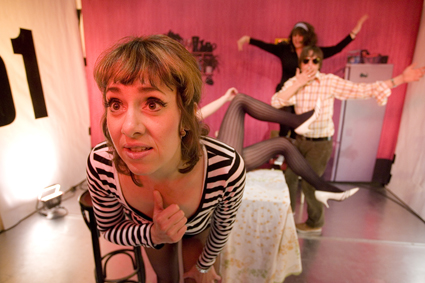
Gob Squad, Kitchen (You’ve never had it so good), courtesy the artists
LET ME SHARE WITH YOU TWO IMAGES THAT SUM UP THE ELECTRIC CARNIVAL THAT WAS THIS YEAR’S SUBLIMELY PROGRAMMED WORLD THEATRE FESTIVAL.
The first involved me trying to explain to a bemused and bespectacled WTF patron what the dazed man covered in peanut butter was doing as he lurched from renowned American academic and director Richard Schechner’s workshop to a nearby toilet.
The second involved the same patron simulating oral sex onstage with German sex kitten Laura Tonke in Gob Squad’s Kitchen (You’ve never had it so good) and looking like she was having the night of her life.
The premise of Kitchen is deceptively simple. The audience is greeted by the three members of the Gob Squad collective who are on tour. We are asked to walk behind the large screen installed onstage and inspect three sets: a bed, a kitchen and a scrim. Once settled in our seats, the show begins and we discover that each set is based on a seminal Warhol pop film: Sleep (1963), Kitchen (1965) and Screen Tests (1964-66). Live footage is streamed onto the giant screen as the performers attempt to recreate each film: squabbling, flirting, remonstrating and philosophising with each other. “Everything began here,” Gob Squad’s Bastian Trost whispers seductively to the audience while appearing in saturated black and white close-up. Across the duration of the show, the initial premise is skillfully deconstructed. Three audience members are co-opted into playing the performers’ roles, deftly instructed by them via head-piece to enact the show’s climax: a post-Warhol, hyper-reality where the “real audience member” celebrity has superceded the performers’ increasingly petulant antics.
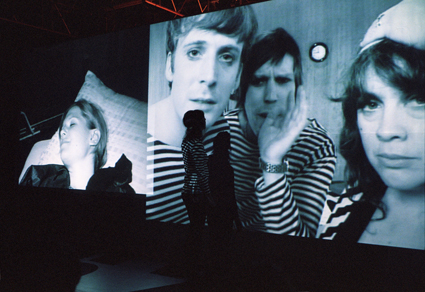
Gob Squad, Kitchen (You’ve never had it so good)
courtesy the artists
Gob Squad, Kitchen (You’ve never had it so good)
Gob Squad was as assured and expert as its reputation promised. The show was flawlessly executed, the technology so integrated into the performance it seemed to melt away: I have never been less conscious of a screen onstage. Each performer was dextrous in coaxing wincingly vulnerable admissions from the audience without it seeming inappropriate. The melding of pop sensibility, witty one-liners and the homage to Warhol was a spoonful of sugar that made the critique of our celebrity-drenched, mediated culture go down unnoticed. The company’s unique creative methodology, collective institutional structure and resulting polish and professionalism make for a seamlessly entertaining theatrical experience.
The helpful WTF program suggested that Kitchen patrons would also enjoy Reckless Sleepers’ The Last Supper. Indeed, both companies are trans-European and were founded in that post-dramatic eruption of energy in the late 1980s and early 1990s, energy that Reckless Sleepers’ founder Mole Wetherell describes as “a reaction to proper theatre in big places” (www.reckless-sleepers.co.uk).
Unlike the cheerful, polyglot, technology-driven Gob Squad, Reckless Sleepers’ work has more of a literary and mannered atmosphere with a deliberately anti-theatrical agenda, more akin to the live art manifesto of British company Forced Entertainment. The Last Supper is one of their older works, commissioned in 2004 and recently revived. As in Kitchen, the audience is greeted by a performer, Mole Wetherell in formal attire but with noticeably dusty bare feet. We are courteously given a number and the other two performers, Leen Dewilde and Tim Ingram, lead us to long narrow tables in a square configuration, marked with seemingly random numbers.
The performers fill our glasses with wine and then adjourn to their table, pre-set with red wine, scripts, apples and short stacks of square paper the size of palm cards. They begin a series of toasts. The tone is muted, ironic, with a slowly building undertone of hysteria and menace. At intervals, marked by the performers with a sense of weary collusion, they read quotations from their stack, pause, wrap the paper into delicate bundles, tip their heads back slowly and ‘eat the words’ of the famous dead they have just quoted. Between toasts and consumption, unobtrusive waiters appear with plates of food assigned to the numbers at respective tables: the final death row meals of various Texan prisoners in the 1990s. The florid and eccentric meal requests—liver and burger, pickle and pie—make this ghoulish experience the most alive part of the proceedings, in contrast with the detached manner of the performers as they read from their scripts.
I had been really looking forward to this show since, like Gob Squad, Reckless Sleepers’ reputation precedes them. However, The Last Supper felt like a revived work that had somehow lost its initial zeitgeist. The deliberately hackneyed choices of the kitsch Texan death row meals and the great clichés of deathbed (yes, we did Elvis and Marilyn, Che Guevara and Trotsky, Rasputin and Da Vinci) felt lazy rather than biting. There seemed very little at risk for a form whose traditions thrive on experimentation and that sense of audience discomfort at a game being played where the rules are not necessarily understood. I kept waiting for the turn, or the retreat, or even the unravelling of the carefully formal mise en scène. While l really enjoyed the creamy intensity of Leen Dewilde’s performance, the tang of the red wine and the evident intellect and craft of Wetherell’s script, I was shocked when the show stopped, almost petering out. I felt deflated. Perhaps this was an intentional anti-ritual demonstrating that last meals are as mundane as any, whatever faded glamour or religious intensity we might try to attach to them?
It was a privilege, nonetheless, to see iconic Gob Squad and Reckless Sleepers’ repertoire co-terminously and in the broader context of the savvy international programming of this year’s fabulous World Theatre Festival.
See Osunwunmi’s account of Reckless Sleepers’ String Section as part of In Between Time, Bristol.
World Theatre Festival 2013, Gob Squad, Kitchen (You’ve never had it so good), devisors, performers Johanna Freiburg, Sean Patten, Sharon Smith, Berit Stumpf, Nina Tecklenburg, Sarah Thom, Laura Tonke, Bastian Trost, Simon Will, video Miles Chalcraft, Martin Cooper, sound Jeff McGrory, Jeffrey Fisher, dramaturgy: Christina Runge; Reckless Sleepers, The Last Supper, writer, designer Mole Wetherell, devisors, performers Tim Ingram, Leen Dewilde, Mole Wetherell; Brisbane Powerhouse, both shows, February 20-24
RealTime issue #114 April-May 2013 pg. 44
© Kathryn Kelly; for permission to reproduce apply to realtime@realtimearts.net
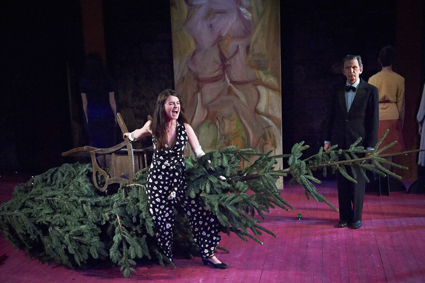
A Doll House, Pan Pan Theatre
courtesy the company
A Doll House, Pan Pan Theatre
BRISBANE POWERHOUSE’S WORLD THEATRE FESTIVAL WAS INAUGURATED IN 2010 WITH LOFTY AMBITIONS IF RELATIVELY HUMBLE MEANS.
There was some genuinely good and interesting work in the program, but as is often the case with inaugural years of risky and ambitious new ideas, audiences were small and populated mostly by dedicated theatregoers and industry practitioners. Shows that had worked well in idiosyncratic performance ghettoes in Melbourne (the ‘World’ being Melbourne and Dublin that year, from memory) didn’t always transfer successfully into the larger and more conventional theatre spaces of the Powerhouse.
Then in 2011 Artistic Director Andrew Ross pulled off a major marketing coup, securing a $500,000 philanthropic gift over three years from Wotif.com founder Graeme Wood. Suddenly WTF exploded into the stratosphere with work from the USA, the Netherlands, New Zealand and Argentina; the Australian quotient was more selectively curated, and local theatre-makers were nurtured under the auspices of a developmental wing in the form of a show-and-tell ‘scratch’ series (RT102). The 2013 WTF season is the final one of the Wotif endowment, and it is the crowning achievement of Ross’ tenure (he has stepped down from his Artistic Directorship of the Powerhouse) and Sarah Neal’s programming curatorship. WTF has become the must-attend event of the Brisbane theatre calendar.
The festival team has not only developed the strongest and most compelling line-up of all the WTFs thus far (with an entirely welcome new writing focus), they have also pulled off the most effective use of the Powerhouse’s many intriguing spaces. Melbourne’s MKA Theatre of New Writing bring their successful run of The Economist (RT107) to town, housed in the Rooftop Terrace, a flexible upstairs space tucked away beyond the administration offices. The Brechtian actor-audience shenanigans—the direct address and irreverent song-and-dance routines that drive the pace of this theatrical riff on the biography of rightwing Norwegian terrorist Anders Breivik—simply work better in enclosed confines than they would in either of the BP’s traditional theatre venues. And Ireland’s Pan Pan Theatre return to the large Powerhouse Theatre having played there in 2011 with their anarchic version of Oedipus; this time they know how to really fill the space and take advantage of its warehouse-like dimensions and extraordinary acoustics. Their postmodern A Doll House is a festival highlight.
a doll house
Ibsen’s 1871 play A Doll’s House might not scream ‘new writing,’ but writer-director Gavin Quinn’s liberal adaptation of the text (losing the possessive ‘s’ in the play’s title is perhaps emblematic of such liberty) renders it as fresh as a newly minted manuscript. Here the maid, Mrs Helmer, recites the stage directions to the audience, announces the subtext and provides plot summaries at key dramatic junctures. More than a post-Brechtian indulgence, the play text is being reconfigured and reimagined in strategic ways that cause us to reconsider who Nora is (not was in 1871). Is she a WAG—a footballer’s wife and/or girlfriend? A symbol of materialistic Celtic Tiger Dublin (before the Crash)? The acquisitive McMansion hausfrau in the outer suburbs of any 21st century city? Is she, in other words, one of us? In this version the language sings, as do the characters who break into rousing ballads from Les Mis or the Whitney Houston back-catalogue when internal reflection is called for. In Quinn’s Doll House, Nora rips open parcels, decorates for Christmas and dances a berserk tarantella like a demon-possessed Barbie. She delivers platitudes like a robot or an irrigation sprinkler caught in a repeat cycle. The playing style leans toward the absurdist but can just as readily dogleg into the melodramatic or soap operatic. Upon her arrival and having witnessed this spoilt-child-in-a-candy-store act, Christina announces, “You’re just like you were at school. A profligate. A wagon. A bitch.” Characters refer to taking Es and indulging in internet chat sex. It’s all irresistibly of its moment.
There were some I spoke to after the show who felt that certain of the post-Brechtian devices were gratuitous or inconsistently applied. Perhaps. But it’s difficult to begrudge a company of fine actors the odd moment or two of gratuitous playfulness when the cumulative effect is of such theatrical richness and exuberance. I enjoyed this production significantly more than the company’s 2011 grunge take on Oedipus.
white rabbit, red rabbit
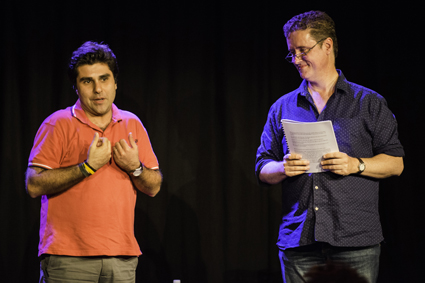
White Rabbit Red Rabbit, writer Nassim Soleimanpour stops the performance by Richard Fidler and introduces himself to the audience at WTF2013, Brisbane
photo Studio Impressions
White Rabbit Red Rabbit, writer Nassim Soleimanpour stops the performance by Richard Fidler and introduces himself to the audience at WTF2013, Brisbane
The performance history of this piece is as intriguing as the work itself. Soleimanpour has received national press coverage with this Australian premiere of his play. Despite the fact that the play has been performed in cities as far afield as Dublin, Edinburgh, Brighton, Calgary and San Francisco, this is the first time Soleimanpour has been granted a passport by the Iranian government and allowed to watch the work performed. Soleimanpour is the ‘I’ character in the script: it is written as correspondence to its imagined audience. A different actor reads the script each night. It arrives, delivered by a festival representative in a sealed packet. On the night I saw the show, it was ABC Radio’s Richard Fidler who ably executed the task. He is instructed by the playwright in absentia to do things like require the audience to number themselves out loud so that No 5 or No 12 might be asked to do things like improvise plot sequences or take notes of the performance so that they can be emailed to Soleimanpour to provide him vicarious experience of the show. Of course, this particular conceit was broken on this occasion by the physical presence of the writer. He leapt onto the stage to emotional applause at one point to acknowledge the fact.
The narrator, assisted by his team of audience conscripts, retells the story of Soleimanpour’s uncle who used to breed rabbits, painting one red and treating it preferentially. It is a psychological exercise in learned behaviour, as the white rabbits round savagely on the red rabbit. The upshot is that even when the inequity is taken away—the experiment suspended—future generations of rabbits still act according to the learned behaviour of their forebears. Prejudicial behaviour—even violence, and by metaphoric extension, war—is trained into us, the writer seems to be telling us. We hold onto ancient grudges even when we have no direct experience of the original point of conflict or resentment.
It is an extraordinary theatrical experiment, made all the more memorable on this occasion by the author’s physical presence rather than his haunting of a script he has never heard read aloud. It will influence writers, theatre stylists and experimenters of form and structure for years to come.
parah
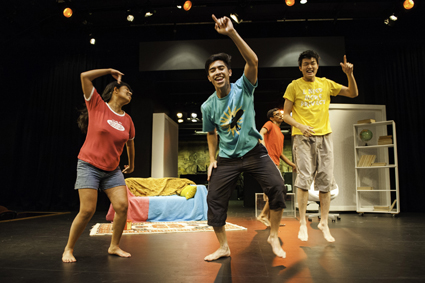
Parah, The Instant Café Theatre Company
courtesy the company
Parah, The Instant Café Theatre Company
In a post-show Q&A at the Parah matinee, director Jo Kukathas asked the audience if the surtitling of this piece had likely kept audiences away. Festival producer Zohar Spatz mentioned that at the 2012 WTF there were three foreign language productions and that it had been too tall an ask for Brisbane audiences; the festival was in the process of re-educating the local theatre-going community accordingly. If it’s true that language is determining which productions audiences choose—even at a festival themed by its focus on ‘new writing’ and the spoken/written word—it’s a shame, because Parah was an accessible and tightly crafted piece of dramatic writing.
Singaporean playwright Alfian bin Sa’at (whose 2012 MKA production of Sex. Blood. Violence. Gore has drawn several Green Room Award nominations; RT110) has a reputation for courting controversy. The Singaporean censor has not appreciated his frank depiction of (particularly queer) sexuality over the years. He writes in both English and Malay, and with Parah has provided the translation of the latter into the former. Taken from a real-life Education Ministry controversy, this is a student-centred play that examines racial prejudice in contemporary Malaysia. Ethnic Indian and Chinese minorities are the victims of racial stereotyping in a curriculum text, Interlok. Mahesh, Kahoe, Hafiz and Melur represent the Indian, Chinese and Malay communities depicted in the education text, and their own social cohesion is tested—indeed almost rendered asunder—by their responses to the allegations of racism in the school curriculum. This is a moving and beautifully acted piece; whilst the play is not the most radical of Sa’at’s works in either form or content, it has hit a cultural nerve in Kuala Lumpur and deserves a wider audience, particularly here in Australia where, as the festival producers are keen to remind us, the themes of racism, social cohesion and immigration are bound to resonate.
Melur provides an anecdote toward the play’s climax: her mother told her of a Malay lady from the end of her street who ritually cleansed her teacup after a Chinese tradesman drank from it. It is an elegant reminder of the sort of cultural prejudice that exists even in modern leafy suburbs. The four teenage friends survive the turmoil and play a real-life game of badminton in the theatre at play’s end, sharing water from the same bottle. It’s a gentle image that somehow encapsulates the heart at the centre of the writing, playing and direction of Parah.
Brisbane Powerhouse, World Theatre Festival 2013: Pan Pan Theatre (Ireland), A Doll House, writer Gavin Quinn, Feb 13-17; White Rabbit Red Rabbit (Iran), writer Nassim Soleimanpour, Feb 14-24; The Instant Café Theatre Company (Malaysia), Parah, writer Alfian bin Sa’at; Brisbane Powerhouse, Feb 13-17
RealTime issue #114 April-May 2013 pg. 45
© Stephen Carleton; for permission to reproduce apply to realtime@realtimearts.net
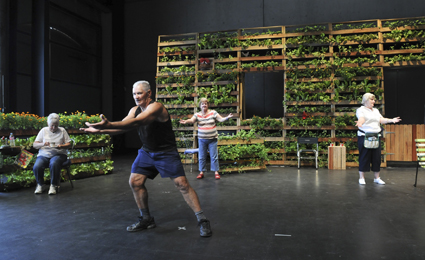
(l-r) June Hickey, Ivan Sevrovic, Dorothy Weir, Judy Murray; Life As We Know It, Urban Theatre Projects
photo Heidrun Löhr
(l-r) June Hickey, Ivan Sevrovic, Dorothy Weir, Judy Murray; Life As We Know It, Urban Theatre Projects
I HAVE NEVER SEEN A THEATRE WORK FEATURING SEVEN ELDERLY NON-ACTORS. IN SOME WAYS, TO DESCRIBE LIFE AS WE KNOW IT LIKE THIS DOES IT AN INJUSTICE, SINCE IT OCCURS WHERE THEATRE, PERFORMANCE AND PARTICIPATORY ART CROSS PATHS.
Urban Theatre Projects’ new artistic director Rosie Dennis’ production is the culmination of 18 months of organic workshopping and story swapping with mature-aged residents of the south west Sydney suburb of Minto about their life experiences. In that sense, Life As We Know It is neither improvisational theatre nor a traditional play. It’s something else: a collective autobiography and an instance of the diversity of practices that now encompass theatre and performance.
The first thing the audience sees is a lush, green, vertical garden fashioned from timber paletts. The impact of this transformation of the black box theatre space is akin to sitting in your own grandparents’ backyard. Subtle links to the ‘outer world’ are everywhere—a breeze through the open windows rustles the flowers and lettuce leaves in one corner, and a roaring jet outside seems less like an intrusion than another part of the production. It’s a joyful, inclusive, living set that unifies what could otherwise be a disparate collection of stories and characters. Immediately, we are put at ease, a feeling that grows as performers—people, rather—with names like June, Judy, Daryl and Dot leave their seats in the audience and enter the stage, one by one. One is a European migrant, married for close to half a century; one put her own ambitions on hold to raise a family; another was raised on a mission for Indigenous people in Kellyville. Unmannered in movements and speech, all of them appear distinctly nonplussed about their onstage roles.
A series of conversations, monologues and musical numbers interweave seamlessly, unrolling with ease and humour potentially depressing themes of aging, mortality, compromise in marriage and loneliness. The production balances stylisation and naturalism to produce a kind of mediated realism that is moving but not schmaltzy, life-affirming but not preachy, and honest but not too earnest. There are no big false life lessons learned, no dramatic character arcs. There is barely a fourth wall, just very frank, funny and direct theatrical communication. It’s the kind of theatre that appeals to people who think they loathe theatre.
Surely this is what contemporary theatre is demanding of practitioners—to produce work that embraces audiences and values their generative contribution to the art-making process. To throw light on barely heard communities and to contribute to them. To go beyond merely theoretical exercise in participatory principles.
This is not theatre as a fringe activity. Rosie Dennis’ work matters—to the communities she is enabling on stage and to the audiences she is connecting with.
Urban Theatre Projects, Life As We Know It, director Rosie Dennis, with Judy Murray, June Hickey, Jenny Shillingsworth, Daryl Cooke, Ivan Sevrovic, Dorothy Weir, Vicky Andrews, musicians Matthew Steffen, Toby Martin, lighting Frank Mainoo, design Joey Ruigrok Van Der Werven; a Campbelltown Arts Centre Commission, produced by Urban Theatre Projects; Carriageworks, March 13-16
RealTime issue #114 April-May 2013 pg. 46
© Lauren Carroll Harris; for permission to reproduce apply to realtime@realtimearts.net
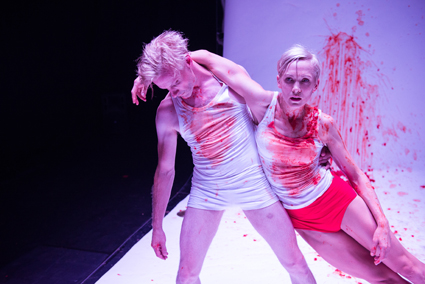
Gerard Van Dyck, Kate Denborough, Flesh and Bone, KAGE
photo Lachlan Woods
Gerard Van Dyck, Kate Denborough, Flesh and Bone, KAGE
AS KAGE, KATE DENBOROUGH AND GERARD VAN DYCK HAVE BEEN WORKING IN CLOSE COLLABORATION FOR MORE THAN 15 YEARS, BUT IN FLESH AND BONE, THE TWO SHARE THE STAGE FOR THE FIRST TIME IN A GREAT WHILE. IT’S A WONDER, NOT SIMPLY BECAUSE IT’S A POTENT REMINDER OF DENBOROUGH’S EXCELLENCE AS A DANCER (SHE USUALLY DIRECTS WHILE VAN DYCK PERFORMS).
flesh and bone
More than that, Flesh and Bone is one of those rare and deeply gratifying examples of work that could only be accomplished by artists who have spent so long developing ideas together. It’s an intimate and highly personal work, brave and revealing, and casts a particular spell that would have broken if another performer had entered the space.
It begins in near darkness, dim illumination gradually allowing our eyes to adjust and make out the pair in odd proportions—her shoulders broad and masculine, his silhouette showing off feminine hips and breasts. They’re both in a kind of drag that extends to the flesh, and after they strip themselves of their clothes they continue this process of unveiling by calmly discarding the skin they wear beneath. Still, even when they’re back to themselves, their individuality seems never to fully recover itself, this sense of overlapping identity maintaining itself throughout the hour that follows.
In making the work, Denborough and Van Dyck sought out the thoughts of a group of young people (facilitated by writer Clementine Ford). Their discussions on gender informed what was to become Flesh and Bone; there are sequences in which the traditional roles of male and female dancers are reversed, as Van Dyck is supported by Denborough’s lifts, while that most gendered of performances, the tango, is given a more permeable and supple twist. At one point he removes a pair of fake breasts from his shirt, she a prosthetic penis from her trousers. Despite the powerful exploration of gender that runs throughout the work, it would be an error to say that the piece is ‘about’ gender. It’s simply one of the conditions that the work is testing. There’s no lesson in any of this, no obvious point to be made. Each moment has an elusive but compulsive necessity that requires no explanation. There’s no logic or narrative, but everything is as it must be.
It’s also a thoroughly visual work, with each vignette offering striking images. On a curved, mirrored surface the pair create subtle illusions with a number of immense, black balloons; a massive expanse of grass forms the foundation for a quiet, introspective moment; a vast sheet of unbroken white paper is canvas for a violent moment of rupture. The most memorable scene is also the most inexplicable—Van Dyck places a small mirrored table over Denborough’s prone form and proceeds to make pasta from scratch, topping it with sauce and shaved cheese. This unfolds with methodical slowness, yet it’s impossible to look away.
As is typical of the company, the work displays its roots in dance but draws just as heavily on other disciplines, from circus and magic to post-dramatic theatre. It refuses to stay one thing, but just as importantly is always something—it’s never an act of negation or refutation but rather of continual expansion. It’s buoyant, occasionally startling and always generous towards its audience. Hopefully it’s a sign of what’s to come, too.
until then, then
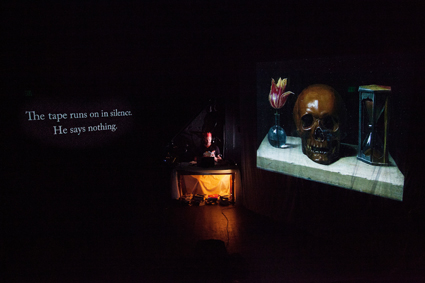
Until Then, Then, The Public Studio
photo Pier Carthew
Until Then, Then, The Public Studio
A stark contrast comes in the form of Until Then, Then, another piece by two long-time collaborators, Ming-Zhu Hii and Nicholas Coghlan, under the rubric of The Public Studio. Both retreated from creating new work several years ago after reaching a point of dissatisfaction with the art scene in Melbourne, and that process of negation also underscores every aspect of Until Then, Then. It’s not merely anti-theatre, which has its own conventions by now. It’s closer to an installation, in some ways, one which actively invokes theatrical traditions in order to do away with them.
Coghlan sits at a small desk, wearing a paper crown, and mutely operates a laptop to bring up a series of projected images and text. The visuals are manipulated paintings that evoke the Baroque vanitas or memento mori, the reminder that death accompanies all worldly existence. Here those skulls and hourglasses are subjected to their own digital decay and retrieval, piling up in infinite regression or finding themselves magnified to the point of unintelligibility. Some of the visuals are Bacon-esque in their ghastly fleshiness, but they never quite reach a point of morbidity.
Meanwhile, snatches of dialogue from the ‘great’ male characters of (mostly) modernist theatre—Woyzeck, Krapp, Peer Gynt—are displayed. They provide no context, and very quickly begin to suffer their own ravaging, as words disappear from sentences before they can be parsed, leaving brittle skeletons of phrases with the meat ripped off. Coghlan seems to be enacting this violence from within his tiny alcove, but his lack of expression never clues us in as to the nature of his relationship with the strangeness taking place around him.
The overall effect is a radical act of silence, in a way. It’s almost the theatrical equivalent of a hunger strike—it refuses, and refuses and refuses, and it’s perhaps no surprise that many audience members have been thoroughly confused and at times bemused by the work. It’s common that emerging theatre makers will think they’ve reinvented the form, but here we have more mature artists who seem to have come to the realisation that such a thing is impossible. The work offers no answers, and I don’t know that it admits of its own questions, either. It doesn’t exactly celebrate failure, since it doesn’t allow for the existence of success. But what the alternatives might look like remains teasingly out of the frame here.
KAGE, Flesh and Bone, creators, performers Kate Denborough, Gerard Van Dyck, costumes Lisa Gorman, lighting Paul Jackson, composer Kelly Ryall, Fortyfivedownstairs, March 7-24; The Public Studio, Until Then, Then, co-creator, performer Nicholas Coghlan, co-creator, director Ming-Zhu Hii, sound Russell Goldsmith, lighting Damien McLean, design Matthew Angel, Ming-Zhu Hii; La Mama Theatre, Melbourne, March 6-10
RealTime issue #114 April-May 2013 pg. 47
© John Bailey; for permission to reproduce apply to realtime@realtimearts.net
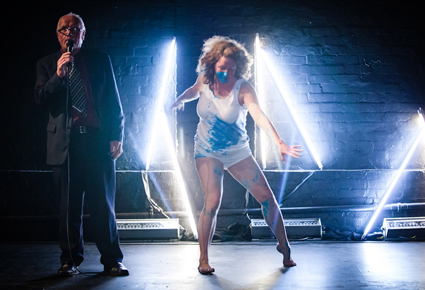
Bron and Jim Batten, Sweet Child of Mine
photo Max Milne Photography
Bron and Jim Batten, Sweet Child of Mine
WITH TENTS ERECTED, POP-UP BARS BUILT AND CITY GARDENS TRANSFORMED INTO NIGHTSPOTS, FRINGE WORLD IS A WELCOME SUMMER CARNIVAL.
With fresh and affordable shows, it neatly dovetails with the mainstream Perth International Arts Festival. As one of the youngest but rapidly growing festivals on the international fringe calendar, this year’s program attracted diverse and savvy works from Perth artists, the national fringe circuit and international acts. Here’s a small sample from a very large program.
sweet child of mine
Bron Batten’s parents don’t exactly know what their daughter does for a living, so she made a show with them to explore her art-making process. In a hybrid performance of dance, stand-up and film, Batten explores her life as an artist with self-reflexive satire while her Dad provides fatherly advice to the audience and admits his daughter’s work is still something of a mystery to him.
While Melbourne-based Batten’s stand-up observations tend to be insubstantial, she does have a knack for ironic setup; her lightning-fast overview of ‘deconstructionist’ theatre—blithely referencing Foucault, Derrida and Jamieson—is juxtaposed with filmed segments of her parents’ droll perspective as they try to categorise something as abstruse as contemporary art. Batten has a wicked sense of the ridiculous, which is highlighted in a sketch where she dresses as a beaver and recruits an audience member to play the artist’s role in a scripted exchange with her mother. This adds distinctive insight into that relationship without sentimentality. While occasionally trite, Batten’s self-deprecating wit and her parents’ roles as unwitting comics provide a refreshing and playful approach to the perplexing nature of art.
the wives of hemingway
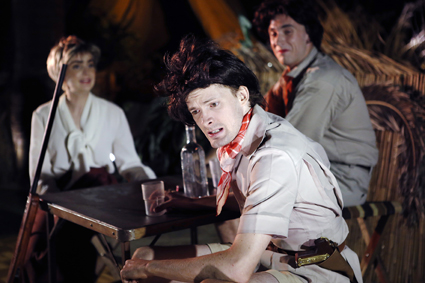
Tim Watts, Adriane Daff & Josh Price, The Wives of Hemingway
photo Skye Sobejko
Tim Watts, Adriane Daff & Josh Price, The Wives of Hemingway
Ernest Hemingway’s oeuvre brimmed with stoic male characters on magnificent, grisly adventures. If his literary output is anything to go by, he was obsessed with death, violence and love. Drawing inspiration from his texts and love life, The Wives of Hemingway is a satirical reimagining of the writer’s tumultuous marriages. Newlyweds Catherine and Wilson go on safari, a surreal journey complete with big game hunting, rampant heroics and sordid sexual exploits. The advent of Helen joining their call to adventure turns the hunt into a brutal battle for love.
Perth writer-director Zoe Pepper and her team of co-devisors capture imperial idioms of the romantic adventure genre exquisitely. Performers Tim Watts, Josh Price and Adriane Daff sit on the razor edge of parody before tumbling into the dark Hemingway psyche: where fear of emasculation and the feminised male materialise in the guise of female grotesques. Homely Helen and sexually audacious Catherine are played interchangeably by Price and Daff. Price taps into the fragility of both women with extraordinary black humour, while Daff exhibits a restrained delirium throughout. The quintessence of the piece is realised in Watts’ portrayal of Wilson. His is a most ironic yet beguiling portrayal of the Hemingway model: dashing, combative, passionate yet heartless.
Pepper has deft control over the material, which could tumble into a “Carry On” nightmare in the wrong hands. Instead, this achingly funny show induces much compassion for its outlandish characters.
birdboy
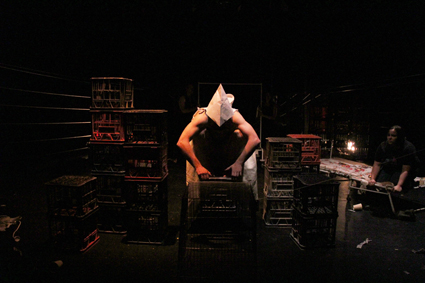
Ian Sinclair, Birdboy
photo Samantha Hughes
Ian Sinclair, Birdboy
I felt less empathy for Birdboy’s Miss Nightingale, who lives with her caged son and dozens of birds. She sings nightly for him and her feathered fans, reliving her fleeting glory as a radio star. Upon his mother’s sudden death, the boy is discovered by a neighbour who takes him in, and he discovers life beyond the confines of his enclosure. Inspired by a factual account of a seven-year old Russian boy who was raised as a pet bird by his mother, The Wet Weather Ensemble’s latest work struggles to get airborne. Wavering between drama, satire, musical parody and soap opera, Birdboy is tonally unsure and uneven. Ian Sinclair’s performance as Miss Nightingale enlivens the piece with his “Baby Jane”-meets-“Mommy Dearest” theatricality. St John Cowcher as the boy is sweet, and yet his enigmatic portrayal prevents any insight into Birdboy’s emotional journey, while the introduction of romantic interest between him and his rescuer is particularly incongruous. Not without charm, Birdboy, a creation of Perth’s The Wet Weather Ensemble, could benefit from a return to the development room and firmer directorial vision.
uta uber kool ja
Prima donna peevishness is more palatable in the guise of Uta Uber Kool Ja. Having thrown parties in Adelaide, Sydney and Melbourne in 2012, Uta and her manager George celebrate a new year with Uta’s comeback tour in Perth. Uta invites guests to her hotel room for an immersive performance comprising diva antics and drug-induced flashbacks. The story of Uta’s discovery, her (sort of) fame behind the Iron Curtain, celebrity love affairs, tormented marriages and her life alongside Vivienne Westwood are all laid bare. Meanwhile, George ensures the champagne and flattery flows, enlisting the party-goers to keep Uta’s ego afloat.
With dress-ups, dancing, party games and more spandex than this side of 1985 has seen, Uta celebrates the launch of her remixed single. The guests revel in the sheer hedonism that is Uta—a blend of Eddie and Pats with a touch of Marianne Faithfull. As the party draws to a close, the act of stripping back her character to reveal Georgina Symes (the Melbourne-based actress) is a little capricious. After being so immersed in the world of George (Nic Dorward) and Uta, her exposure as a mere character was a paroxysm of reality I couldn’t accept – lang lebe Uta!
the three little pigs
Rob Van Vuuren & The Pink Couch’s The Three Little Pigs is a well-oiled, South African political comedy-thriller take on the traditional children’s tale. Inspired by the daily newspapers and drawing its gritty aesthetic from TV shows like The Wire, it dissects the politics between media and government and the corruption within law enforcement in modern South Africa with an Orwellian sensibility. Distressed and terrified by the slaughter of his two brothers, the last little pig turns to the cops—notably a chicken and a goat—to investigate the brutal murders in a world teeming with sly and desperate personalities, where morality is eschewed.
The actors play multiple roles, but James Cairns stands out with menace and frightening exactitude as the chicken heading the investigation; Albert Pretorius’ goat is weary and bitter within the political machine, and Rob Van Vuuren’s many hapless and wretched characters, including a piggish security guard, a raw-boned rabbit who owns a gym and an erotic dancing cat, are delivered with fine physical humour, providing welcome relief from the ominous tension. Director Tara Notcutt transforms the action with ingenuity; however, the demise of the Big Bad Wolf plays out rather softly for a play that touts Tarantino as an influence.
The Three Little Pigs renewed my faith in theatre as a potent medium for telling stories of our time: its observations on and satire of contemporary South African society and politics give it immediate currency, yet it is also a play that stands up in any number of contexts as a comment on the abuse of power. To paraphrase Orwell, it is a rare beast that can fuse political with artistic purpose into a cohesive whole
Fringe World 2013: The Blue Room Theatre Summer Nights, The Last Tuesday Society & PICA, Sweet Child of Mine, directors Bron Batten, Gerald McCulloch, PICA, Feb 4-8; Side Pony Productions & Weeping Spoon Productions, The Wives of Hemingway, writer-director Zoe Pepper, North Perth Bowls Club, Feb 8-16; The Blue Room Theatre Summer Nights, The Wet Weather Ensemble & PICA, Birdboy, director Moya Thomas, Ian Sinclair, PICA , Feb 11-16; Army of Love, Uta Uber Kool Ja, creative producer Nic Dorward, performers Georgina Syme, Nic Dorward; Riverview Hotel Feb 12-23; National Arts Festival South Africa, Rob Van Vuuren & The Pink Couch, The Three Little Pigs, director Tara Notcutt, The Courtyard State Theatre Centre of WA, Perth, Feb 12-24
RealTime issue #114 April-May 2013 pg. 48
© Astrid Francis; for permission to reproduce apply to realtime@realtimearts.net
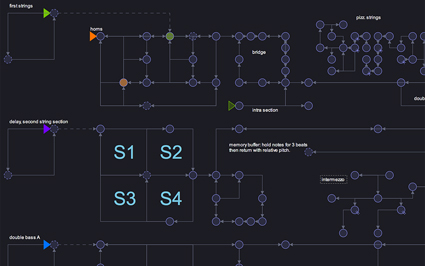
screen grab from Nodal, Jon McCormack, Peter McIlwain, Aidan Lane
THE SHORT-LIVED CONCERT SERIES LURK, RUN BY UK COMPUTER MUSICIAN ALEX MCLEAN, HAD THE TAGLINE “SOFTWARE TO MAKE MUSIC TO DRINK BEER TO.”
Lurk, like most of McLean’s activities, elegantly draws attention to this world of burgeoning activity in enchanting language; humanising the creative use of machine instructions, reminding us that with software code, as with any other human tool, it’s what you do with it that counts. In general McLean’s writing is indicative of a new generation of individual creative coding, powered by the evolution of flexible and social software development tools.
uncharted territory
The allure of software programming is that there is so much uncharted territory. The blank code editor is like an artist’s blank canvas or a writer’s blank page. The cliché that programming is the new literacy is fitting, not just because code offers a new handle on information but also because of its potential for self-expression and new ways of thinking, dependent above all on its open-endedness. An important aspect of creative coding is the ever-changing relationship between people in the production of tools and outputs.
a single process
In Alistair Riddell’s short history of Australian computer music in Experimental Music: audio explorations in Australia (ed Gail Priest, UNSW Press, 2009), a prominent theme is the fusion of coding and creative practice in a single process, the code being the unique means by which certain creative goals can be achieved. This contrasts with what many would consider a normal state of affairs, where programmers create tools to be used by artists. But the in-between space that has grown to maturity is illustrated by Riddell in early examples, such as the work of Graeme Gerrard or Greg Scheimer, developing software for their own projects that is then adopted by their contemporaries. The creative development of a system goes on to be a useful tool for others, and lives as both infrastructure as well as artwork in its own right.
Fast forward to today and the growth of such activity has naturally echoed the technological Cambrian explosion that computers have unleashed universally. A diversity of patterns and relations is unfolding.
software for making art
Developed single-handedly by Melbourne’s Ross Bencina for over a decade, AudioMulch is pro-audio software that lets you fluidly whip together virtual music-making machines. AudioMulch fits the model of commercial tool: developed by developers, used by artists (except that Bencina is its quintessential pro-user), performing delicate works that bring out its innovative design. Beyond Bencina’s use of it, AudioMulch reveals further versatility in the hands of original artists such as the USA’s Girl Talk or the UK’s Four Tet, who enthuse about its non-linear approach and its focus on live sound creation.
For an increasing number of artist-programmers, the distinction between the world of software-as-art and the world of software-to-make-art is more blurry, and the growing norm for many is to straddle both.
software as art
Australian systems artists such as Jon McCormack create works that exploit the patterns and properties of natural processes in code, rising to the philosopher Manuel de Landa’s challenge that artists must “be able to hack biology, thermodynamics, mathematics and other areas of science.” Typically digital artworks are manifestations of custom programs, but once in a while a project idea emerges instead as a creator’s tool, destined for public consumption. McCormack’s recent collaboration with Peter McIlwain and Aidan Lane has led to Nodal, a music-making tool based on the flow of data around a user-created network of events, something like a virtual Domino Rally of musical notes. Nodal is quirky and fun but equally usable. Like AudioMulch, it frees you from the musician’s timeline and lets you think structurally about music, a challenge weary producers can delight in.
On a finer, more day-to-day level, software artists routinely deposit nuggets of useful code on the web. Today, collaborative coding environments such as Github and modular creative tools like MaxMSP, encourage distributed modular development that is always “to share,” though one problem that arises from the uninhibited sharing of software is the resultant minefield of usability.
For some, the relation between art and tool development is even more tightly intertwined. Perhaps Australia’s best case is the “live coding” software developed by Brisbane’s Andrew Sorensen. Sorensen’s Impromptu and Extempore environments are software tools that let you write code live to make music, emerging from earlier work by Sorensen and Andrew Brown on the software library jMusic. “Live coding” describes the idea of writing code live in performance, often as an act of performance. Sorensen’s Vimeo channel hosts an archive of such work.
That Sorensen is making software to make software to make music to drink beer to is true to the experimentalism of Toplap, live coding’s “temporary organisation.” The deep food chain of creative software development is revealed; we don’t just take inspiration, or even remix each other, but deposit nuggets of infrastructure on the web to add to a many-layered creative ecosystem. With usable code being the object of exchange, along with traditional know-how, the idea that digital artists are “standing on the shoulders of giants” takes a more concrete form.
Programming is also getting easier, and the creative coding world is developing its canon, with publications such as “Generative Design,” and mass-popularisation via The Creators Project. Public discourse contains references to code as “the new literacy” (or for some peculiar British minds, “the new Latin”).
Creative coding is also not just for cyberspace, with a new generation of user-hackable physical computing technologies visibly eroding what BBC technology writer Bill Thompson calls the hacking world’s “brief sojourn in the virtual.” A recent Australian start-up, Ninja Blocks, offers a suite of plug-and-play wireless modules entering the growing marketplace of the soon-to-be-ubiquitous Internet of Things. Ninja Blocks form a wireless network of sensors, buttons, power switches and so on. Their key design feature is that they can be easily hacked by a software-literate user base, and the company’s focus is on this ease of development, the holy grail of creative coding success.
steim, amsterdam
The relations between networks of technologists and artists are also mediated in diverse social ways. A long-standing European example, The Studio for Electro-Instrumental Music (STEIM) in Amsterdam, is a hub of music electronics experimentation that has hosted residencies by Australian creators such as Bencina, Douglas Khan and improviser Jon Rose, whose work includes electronically augmented violin bows and the use of bouncy balls as wireless musical controllers for gamified interactive compositions. Through its residency program, STEIM offers creative practitioners tailored technical support in the development of electronic instruments and provides a suite of their own instruments and software.
STEIM is a pleasantly informal hub for creative technological collaborations that creates a notable niche for the grassroots DIY scene—exemplified by a worldwide network of Dorkbot meet-ups and collectives such as Hand Made Music in Melbourne—commercial projects, umbrella initiatives such as the Australian Network for Art and Technology and the many academic hubs researching creative technologies. STEIM leans towards the maker/tinkerer mode of production and social organisation, embodying a passion for creative tool-making. As the role of the technologist becomes more prominent and also more diverse, this offers one model for the arts to incorporate sustained tool development and design into its ecosystem. New emerging Australian organisations such as Media Lab Melbourne, hosting short-term creative hacking collaborations —“sprints” in their parlance—are innovating alternative manifestations of the artist-technologist relationship. More variations on this theme are bound to arise, and should be welcomed, as this Cambrian explosion continues.
RealTime issue #114 April-May 2013 pg. 49
© Oliver Bown; for permission to reproduce apply to realtime@realtimearts.net
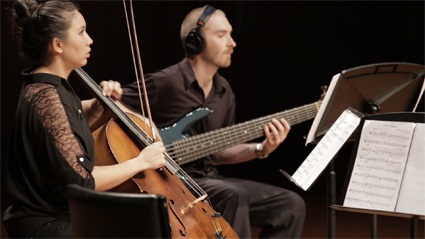
Ezmi Pepper, Joe Manton, Seven Stations: Love Poems for Sydney
photo Hospital Hill
Ezmi Pepper, Joe Manton, Seven Stations: Love Poems for Sydney
THERE WAS A CELEBRATORY NOTE IN THE AIR WITH THE FIRST CHRONOLOGY ARTS CONCERT OF 2013 MARKING THE 65TH BIRTHDAY OF THE ORGANISATION’S PATRON AND ONE OF ITS COMMISSIONERS, CHARLES DAVIDSON, AND THE COMPLETION OF WORKS COMMISSIONED FOR THE OCCASION.
The Acacia Quartet chewed into Movement I of Daniel Manera’s first String Quartet with evident enjoyment, the occasional tonal chord glimmering amid the bare, striated textures like pyrites within quartz. The quartet carefully groped their way through Manera’s taut clusters, unease building towards a claustrophic stasis. And when movement’s lush denoument arrived it was with a sense of relief for musicians and audience alike, full bows opening up the sound in great sucking lungsful.
Written in three distinct sections, former AIDS activist Lyle Chan’s composition, Mark and Adrian are her sons, opened with slight, weightless gestures iterated with increasing frequency, suggesting private anxieties in pre-dawn darkness. Then some threshold was abruptly breached, the Acacia players falling into a jagged, resolute march, coloured by jazzy, almost ragtime inflections. This section, surely reflective of politician Franca Arena’s apparent hostility to AIDS victims who had contracted the disease sexually as opposed to medically, then receded into the warmly concordant finale, a rich melody being skilfully palmed between the instruments. Though effective as program music—the piece being excerpted from Chan’s extended musical memoir for string quartet—as a stand-alone work it did not seem to quite cohere, the final section in particular losing focus.
The first half closed with Perth-based composer Lachlan Skipworth’s where the mountains meet, written specifically for the gorgeously turquoise six-string bass guitar of Joe Manton, who performed the work. Melodic fragments materialised and faded around precisely articulated harmonics, with further overtones resonating like peaks glimpsed through cloud. A further dimension was added to this basic effect with the incorporation of the delay pedal, ascending runs flashing rapidly across the ear, echoes allowed to hang and gradually fade, action and response being contained within a strictly formalised aesthetic reminiscent of tightly choreographed martial art. A beautifully realised performance, made all the more impressive by the severely limited time constraints within which it was apparently prepared.
Seven Stations—Love Poems for Sydney, a song cycle written in collaboration between poet Chris Mansell and composer Andrew Batt-Rawden, draws its inspiration from the railway stations that circle the inner-city—a schematic that seems to reinforce the romantic, tourist-bureau notion that this most suburban of cities begins and ends at the perimeter of the CBD. That said, Mansell’s text here is unabashedly romantic. “I am love” begins the opening song, Town Hall, filled with an unironic immediacy reflected in Batt-Rawden’s directly evocative music: trains shriek through tunnels, muttered spicatto conjuring the “wary scary/ hungry beast” lurking amid the subterranean shopping arcades—Halcyon’s Alison Morgan (soprano) and Song Company’s Anna Fraser (mezzo soprano) chewing, chattering and spitting words like some two-faced creature, the city’s shining self-image doubled by the coiled thing below.
Written for various combinations of soprano, mezzo soprano, bass guitar, viola, cello, percussion, electronics and kalimba (much of the music was written while Batt-Rawden was living in Brazil), the subsequent pieces play off this basic dichotomy to varying effect. St James, a duet for bass guitar and soprano, generates a fraught anxiety, Morgan interspersing precisely articulated text with heavy mouth breathing over Manton’s propulsive bass riff. Sydney Terminal, a cooing lullaby for strings, soprano and bass guitar, didn’t quite seem to capture the grinding limbo of Central Station filled with “fresh fodder/ new meat/ for the city,” though the repetition did recall Cityrail’s festive season habit of playing a single Christmas song on loop.
Redfern was more successful, stalactitic electronics and dissassociative bongos contrasted with the smooth control of Ezmi Pepper’s cello playing to evoke the “depleted girls too drunk to walk” and the “madonnas and a man walking his pig.” Less so was Museum, Fraser donning black gloves and red shoes for some almost burlesque showmanship, Sydney being presented as “liminal and silly/ this beat and rattle girl/ with a bad bad past,” purring and trilling over bowed drums and cymbals. Surely a missed opportunity to present the city as Drag Queen.
Though brimming with intriguing effects, “grey fear cruis[in-g] below” suggested by glistening viola double stops and chittering wood blocks, The Quay suffered from Batt-Rawden’s journeyman conducting, a problem compounded by the score’s page order becoming muddled. Similar issues plagued Sydney Terminal as well as the final section of the work, Kings Cross—though the musicians maintained the densely chromatic evocation of “where the polygamous money lies” with admirable poise, the vocalist’s weirdly enunciated spoken word being contrasted with a shriekingly hectic cello figure, energetically delivered by Pepper. Difficulties in execution notwithstanding, Seven Stations seemed at times weighed down by the conceit of the concept, straining against but never quite escaping the lure of “singular tragedies and perfect farces.”
Seven Stations: Love Poems for Sydney, Chris Mansell & Andrew Batt-Rawden, Daniel Manera, Lachlan Skipworth, Lyle Chan; Music Workshop, Sydney Conservatorium of Music, March 1
RealTime issue #114 April-May 2013 pg. 51
© Oliver Downes; for permission to reproduce apply to realtime@realtimearts.net
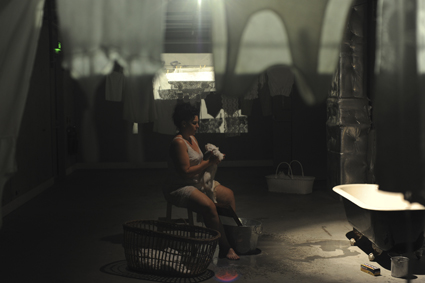
Sarah-Jane Norman, The River’s Children (2013), Unsettling Suite
photo Heidrun Löhr
Sarah-Jane Norman, The River’s Children (2013), Unsettling Suite
IN CARRIAGEWORKS BAY 19, A SERIES OF ROOMS, ENTERED VIA A SMALL SANDY HALLWAY, HAS BEEN CREATED BY DIVIDING THE SPACE WITH BARELY TRANSPARENT, PLASTIC WALLS. THE EVOCATION IS OF AN EPHEMERAL SPACE IN WHICH ARE FOUND QUITE SUBSTANTIAL ACTIONS AND OBJECTS, LARGELY DOMESTIC, FEMININE AND HISTORICAL IN CHARACTER—WITH A DISTINCTIVE EDWARDIAN FEEL.
Washed white clothing hangs outside the ‘house’ on one side, and on another is a laundry—a bathtub, basket, Sunlight soap, signs of recent washing and more clothes, this time providing a screen for projections of labels (eg “1849, hospital”). Other suggestions of a lived-in abode include a functioning kitchen and dining space, with an oven and signs of recent cooking. A sideboard displays hand-painted crockery.
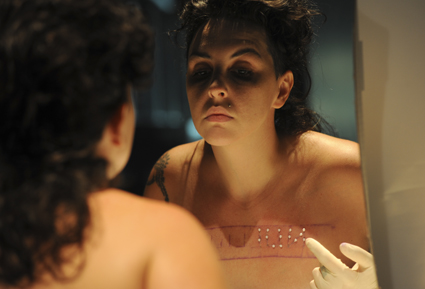
Sarah-Jane Norman, Corpus Nullius/Blood Country (2013), Unsettling Suite
photo Heidrun Löhr
Sarah-Jane Norman, Corpus Nullius/Blood Country (2013), Unsettling Suite
The house ambiguously connotes ownership, servitude and artistic creativity. Replete with a boudoir, it implies the presence of the ‘lady of the house.’ On the other hand the labour suggested in the kitchen and laundry conjures images of young Aboriginal women in the 19th and 20th centuries taken from their families and forced into the role of maids. It also evokes the home of an artist with scholarly inclinations and is suffused with her blood—in the paint on the crockery (Heirloom Dinner Set), in the scones the gallery-goers are invited to have with their tea after witnessing their making (Take this for it is my body), and in the handiwork of the woman of the house (Corpus Nullius/Blood Country). The word ‘Terra’ (as one part of ‘nullius’) is partly embroidered with thread and blood onto shaved sheepskin. Among more sheepskins, a negligee hangs from the ceiling, a crinkled, shiny cast, like the discarded shell of an insect, a relic of the owner and the artist’s embodiment.
Less obviously domestic is a room with a museum case containing a sugar cast of the artist’s leg—on a white mattress over red soil—being slowly devoured by native ants. Another room is a genteel workspace where words from Aboriginal languages have been meticulously carved onto sheep and cattle bones. Some of these are also displayed in a museum case.
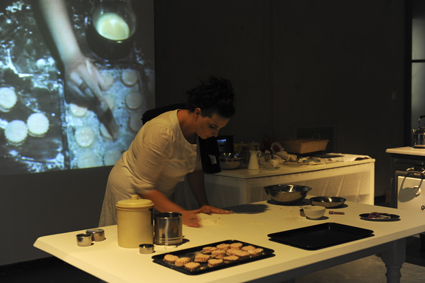
Sarah-Jane Norman, Take This, For It Is My Body (2013); Unsettling Suite
photo Heidrun Löhr
Sarah-Jane Norman, Take This, For It Is My Body (2013); Unsettling Suite
The house comes alive when Norman appears, brusquely inviting visitors to take tea and scones, emptying drops of her blood from a vial into the scone mix, cooking, serving and issuing orders to her guests. Here she embodies at once householder, maid and artist. This is one of several performances (another is the ‘embroidery’ of “nullius” onto the artist’s chest with pins in the lady’s parlour) built into Unsettling Suite—and unsettling they are in a work already disturbingly resonant. As Norman explains in a realtimetv video interview, “each part of the work has a material element and a bodily part or gesture.” Wool, meat, cotton and sugar found in homes also represented the economic power of colonialism and the displacement of Aboriginal people from their traditional lands.
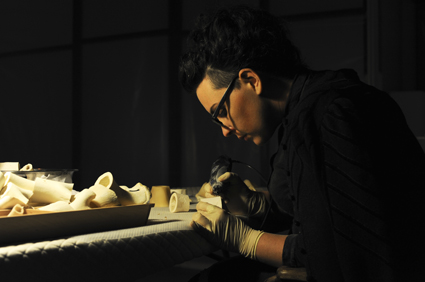
Sarah-Jane Norman, Bone Library (2013), Unsettling Suite
photo Heidrun Löhr
Sarah-Jane Norman, Bone Library (2013), Unsettling Suite
The bones (engraved, dated and catalogued) in Bone Library comprise a dictionary of extinct Aboriginal languages; pieces can be taken in trusteeship by visitors. They may also participate by offering white clothes to be washed in water from the Hawkesbury River, “which runs through my grandmother’s country,” says Norman, “country with a dark history.” The projections onto the clothes list the dates and places of recorded massacres of Indigenous people. As Norman says, contributors’ clothes are returned, “imbued with this trace of a very violent history.”
Unsettling Suite, finely curated by Performance Space, comprises installations and performances created over a number of years as Sarah-Jane Norman has steadily built her practice. They have evolved into a single creation of great power at once subtle and necessarily confronting. As she says, these works “add up to a lot of heavy, heavy shit and very complicated shit. There’s a lot of rage…in a very quiet meditative space…[T]he unreconciled miasma of our collective history is filtered through my body into this work.”
realtime tv interview
See Sarah-Jane Norman’s article, “Blood is such clever stuff,” in the RealTime RealBlak edition (RT111) and the video interview on realtime tv.
Performance Space, Matters of Life and Death: Unsettling Suite, artist Sarah-Jane Norman; Carriageworks, Sydney, Feb 22-March 10
RealTime issue #114 April-May 2013 pg. 52
© Keith Gallasch; for permission to reproduce apply to realtime@realtimearts.net
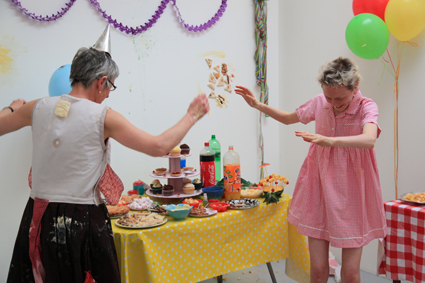
Sarah Coggrave and Bronwyn Platten, Untitled (The Party), 2011—a short film conceived and performed by co-collaborators Sarah Coggrave and Bronwyn Platten for Mouths and Meaning. Filmed and edited by Insa Langhorst with still photography by Huw Wahl
WORKING IN THE UK SINCE THE LATE 1990S, BRONWYN PLATTEN MADE A WELCOME REAPPEARANCE IN ADELAIDE THIS YEAR. HER MOUTHS AND MEANING EXHIBITION EXAMINED IDEAS ABOUT EMBODIMENT AND BODY-CONSCIOUSNESS, THE BODILY EXPERIENCE, AND RELATED PHOBIAS AND CONDITIONS (BULIMIA, ANOREXIA) AND SOCIAL, GENDERED ATTITUDES TO THE BODY. WHILE A NUMBER OF SMALLER OBJECTS AND STILL IMAGES SERVED AS BAFFLES, COMPLICATIONS TO THE MAIN FOCUS, FILMED WORKS DOMINATED.
Untitled (The Party) (2012) was projected large, to wall-filling size in a room to itself. Its soundtrack—intermittent and with long stretches of silence, but regularly bursting out into a goony, boisterous frivolity—filled the gallery, advertising the film’s presence if you had just entered, reminding of its story and content once seen.
Running for just a little under 20 minutes, it offers itself as both narrative and documentary and as a child’s story. A young woman turns up to a door, knocks and enters to meet an older woman and there they have a party: cakes and fizzy drinks. Platten’s collaborator, artist Sarah Coggrave, is the shy, uncertain visitor—addressing the door tentatively, entering slowly, filmed from behind and below. Her red balloon lingers briefly, caught outside the door before following her in. Inside, Platten sits at a table repeating to herself, “Mum, mum, mum, Mum; mummy, mum-mum mum”—writing the words as she speaks. So, mother(s). We are quietly shown the room with its arrayed feast of sugared and creamy fare. Some plain black shoes are filled with whipped cream and feet are plunged into them, the cream squelches luxuriantly as the foot enters, and again as the laces are pulled tight. A moment for both glee and revulsion. Hilarity begins, and the ‘comic’ music. The two don conical party hats, stomp about and attack the food, blow paper trumpets etc. An exorcism.
The film’s longueurs are calming. If exorcism—or facing-down—is the point, it seems a simple exercise: the pace is leisurely, the actions few. The pay-off is a kind of capaciousness that allows the viewer to entertain as many of the various thoughts, the various attitudes about these matters, as might suggest themselves. The Party holds them in suspension, or in slow revolution.
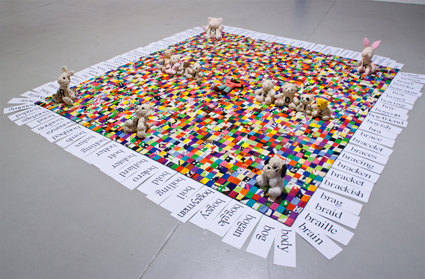
Bronwyn Platten, For more and more love hours (R.I.P. Mike Kelley 1954-2012), 1973-2013, hand-stitched marimeko quilt, found soft toys, oats, liquorice, treacle
photo Alex Lofting
Bronwyn Platten, For more and more love hours (R.I.P. Mike Kelley 1954-2012), 1973-2013, hand-stitched marimeko quilt, found soft toys, oats, liquorice, treacle
A floor-piece sits centre gallery, a large, brightly checkered hand-sewn blanket, a tribute to artist Mike Kelley—with the initials, M. K., RIP, and dates of birth and decease, borne on the chests of soft toys arranged there—bears, dogs—each covered in breakfast oatmeal. (Abjection, shame are the terms associated with Kelley.) Around the blanket’s perimeter is a fringe of boldly printed words. All begin with ‘B’ and are to do with physicality, the body, with activities that a self might undertake or enact as a role-playing, gendered being. (Body, boo, boohoo, boobs, booby, book, bookish, boss, bossy, bosom, boy, boycott, bounce, bouncer, bow, bowel, bowl, brain).
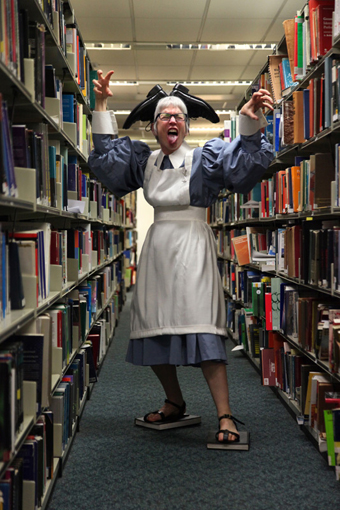
Bronwyn Platten, body to brain and back again, 2013, still of filmed performance
photo Huw Wahl
Bronwyn Platten, body to brain and back again, 2013, still of filmed performance
It is these words, taken from a child’s dictionary, that Platten does brief, three-to-five-second impressions of, one after the other, in the sequence that they follow around the sculpture—in the film on the nearby screen—as in the manner of charades. A little like a one-woman Haka, with a wider range than just the usual threat to devour and rend: demonic and graphic and sometimes inscrutable, at others ticklingly on-the-money. Platten is filmed—fixed camera, the action sped up—between the shelving stacks of a library. So, framed by books either side—in a rather full, dowdy pale blue frock, with serviceable pinafore. On her head are draped a pair of upside-down (men’s) black shoes—heels at the centre of her head, the toes above each ear. The silhouette says (to me, anyway), ‘Dutch milk-maid.’ Under each foot a book is strapped. (Knowledge? Theory? Yes, the feet-above-the-head—body-over-the-cultural, over ‘ideas’—signals a kind of topsy-turvy or reversal.) Platten swaggers and stomps about, crouching, gesticulating, remonstrating, shaking her fist, clutching at her stomach, adjusting an imaginary bra, swaggering, slumping, slouching, perorating—ingratiating or coquettish, threatening or stern. Mad and very funny.
Titled body to brain and back again (2013), the film, on permanent, crazy rotation, renders the words and the kind of definitions we might imagine for them suddenly literal, ‘embodied,’ all vague nuance banished: as if ideas—abstract, nebulous—are just so many wisps-of-nothing, each one dispatched. At its regular beginning Platten stands, ready—ready for the roll-call of words to begin, her mouth tightens then opens slightly and we see that she is breathing like an athlete readying for a test, her chest rising and falling. Heroic. Then the action begins.
Bronwyn Platten, Mouths and Meaning, Australian Experimental Art Foundation, Adelaide, Feb 1-March 2
RealTime issue #114 April-May 2013 pg. 53
© Ken Bolton; for permission to reproduce apply to realtime@realtimearts.net
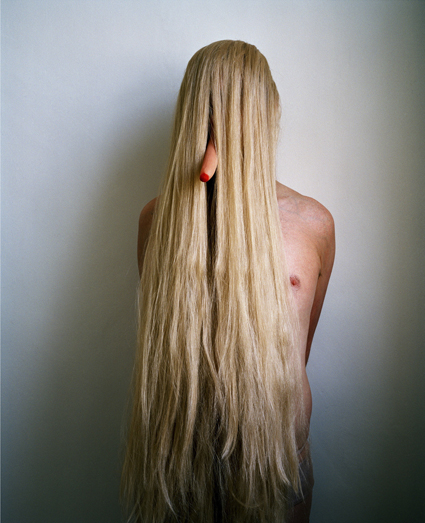
Polly Borland, Untitled IV from the series Smudge 2010; We used to talk about love, Balnaves contemporary: photo media; AGNSW
courtesy the artist and Murray White Room, Melbourne
Polly Borland, Untitled IV from the series Smudge 2010; We used to talk about love, Balnaves contemporary: photo media; AGNSW
A LONG WEEKEND CAN BRING A DIVERSE CROWD INTO A GALLERY AND SO ON A BUSTLING EASTER SATURDAY I FOUND MYSELF OBSERVING WITH SOME FASCINATION THE REACTIONS OF AUDIENCES TO THE LATEST BALNAVES FOUNDATION EXHIBITION, WE USED TO TALK ABOUT LOVE, AT THE ART GALLERY OF NEW SOUTH WALES.
The combination of a re-engineered viewing space (a collaboration between curator Natasha Bullock and architect Jan van Schaik), which adapted the galleries into an intimate labyrinthine configuration, and the lyrical quietness emanating from the vernacular subject matter resulted in a focused viewing experience with a stilling effect, yielding some surprising results.
Most striking was the communion taking place in the darkened, altar-like space housing Grant Stevens’ minimalist video installation, Crushing (2009), where audiences appeared mesmerised by the drift of white text messages floating across the black screen. Set to a wistful piano soundtrack, the texts sharpened into focus and then faded out, coalescing into a loose narrative that poignantly conveyed the anguish of a break-up. Families leaned in closer to one another as they watched, mothers stretched their arms around their kids to offer comfort and one man gently rested his hand on his wife’s shoulder. Despite the banality of the phrases, this intuition of the universal experience of rejection aroused an atmosphere of shared vulnerability in the space.
Not all works in this exhibition of photomedia by 11 contemporary artists exploring the theme of love were intended to provoke such strong affects. Still, emotional responses were encouraged by Bullock’s thoughtful curating which sought to chart the more treacherous, taboo or melancholic, rather than sentimental, territories of love. There were allusions to the complexities and contradictions of young love, for example, in such works as Angelica Mesiti’s video Rapture (silent anthem) (2009). Capturing the spiritual quality of the idolatrous fervour of a crowd of sweaty teenagers in a mosh pit, Mesiti also tapped into the powerful role that projection and transferred affection play in sublimating overwhelming feelings like love in the transition into adulthood.
Far from the collective euphoria of this scene, there was much solitude and yearning in the slickly aestheticised photographs of David Sylvester. Redolent of advertising images in their strategic placement of consumer items, Sylvester’s photographs suggest stories around isolated figures. In one image, a forlorn high school student clutches a break-up letter while in another a teenage couple in a library appear trapped in the gaze of their peers. These emotionally stranded protagonists disarm the viewer in their incongruence with the breezy confidence and self-assurance we have come to expect of the subjects of aspirational mass-media culture.
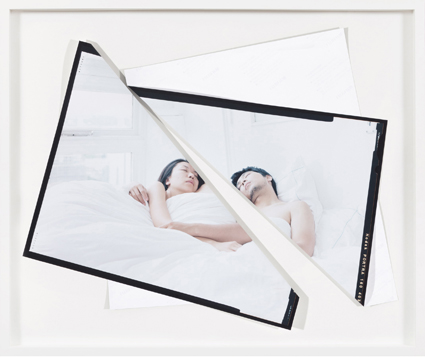
Paul Knight, Untitled (2012), We used to talk about love, Balnaves contemporary: photo media; AGNSW
image courtesy the artist
Paul Knight, Untitled (2012), We used to talk about love, Balnaves contemporary: photo media; AGNSW
A show about love would be incomplete without reference to the body and while sex was not a strong feature of this exhibition, it did take an expansive approach in this area. In a section themed To Begin with the Flesh, the very different works of Polly Borland and Paul Knight, for example, were connected by their impulse to push beyond idealised representations of the body that curtail our appreciation of the complexities of sexual language.
Standing before Borland’s Smudge (2010) photographs, I overhead one viewer describe the work as “nightmarish.” But what, exactly, is the nature of Borland’s nightmare? In this uncompromising and oddly humorous suite of portraiture, sitters dressed in stockings, lycra, prosthetics, wigs and other accoutrements, are transformed into uncanny, post-human creations. Here it is arguably the repression or shame caused by fear of the body that is depicted as more ugly than whatever one feels compelled to hide. Also concerned with the limits of photographic representation were Knight’s candid photographs of couples in bed. Literally folded to partially conceal the nudity of their subjects, this cleave in the images alluded to the doubleness of physical intimacy as a tightrope dance between togetherness and separation.
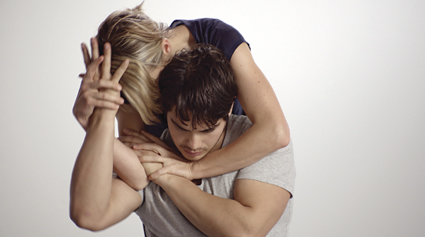
David Roseztky, How to feel (still) (2011), We used to talk about love, Balnaves contemporary: photo media; AGNSW
image courtesy the artists and Sutton Gallery Melbourne, © the artist
David Roseztky, How to feel (still) (2011), We used to talk about love, Balnaves contemporary: photo media; AGNSW
More pervasive than the body, though, was the question of whether living in an age of rampantly proliferating ‘connecting’ technologies is actually making it any easier to express profound emotions like love. The resounding response offered here, implicitly rather than explicitly, was no. Painting a particularly alienating picture was David Rosetzky’s feature length video, How To Feel (2011), in which the artist collaborated with a choreographer and dramaturg in bringing together a group of actors in a warehouse setting where they explored, verbally and non-verbally, the challenges of authentic communication and social interaction. The dance sequences were perhaps more effective than the dialogue, which at times felt a bit contrived, in conveying the psychological barriers and defences that the individual pushes against in the daily performance of the self.
Contemporary art and love haven’t always shared an easy relationship. During the 20th century, in particular, its feminised associations positioned love as an unmodern theme. In her introductory essay, however, Bullock notes a recent paradigm shift as emotion, intimacy and affect become of increasing relevance to artists. This exhibition offered strong supporting evidence for such a shift. It might not come easily but love, it seems, is certainly something we will be talking more about.
Art Gallery of New South Wales: We used to talk about love, Balnaves contemporary: photomedia. Artists Polly Borland, Eliza Hutchison, Paul Knight, Angelica Mesiti, David Noonan, David Rosetzky, Tim Silver, Glenn Sloggett, Grant Stevens, Darren Sylvester, Justene Williams; AGNSW, Jan 31-April 21
RealTime issue #114 April-May 2013 pg.
© Ella Mudie; for permission to reproduce apply to realtime@realtimearts.net
Berberian Sound Studio, DVD plus CD
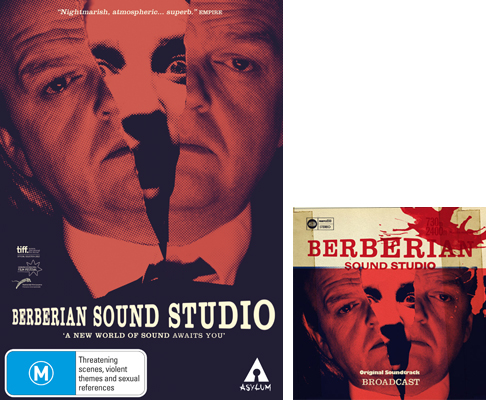 “What is this film about? If one accepts its hypno-haunto inclination, it’s a dual text. One, a dream-narrative about Peter (Toby Jones), a very British sound editor from the mid-70s who ends up producing sound effects for a very Italian mixer, Santini, tracking and mixing an unseen film, The Equestrian Complex, in the eponymous Italian post-production studio. The other, an audiophiliac celebration of the components, procedures and techniques for recording sound effects back then, with an ancillary appreciation of the Italian giallo subgenre of erotic thrillers produced in Italy since the 1960s” (Philip Brophy, RT113). This psychological thriller about a foley artist going mad is accompanied by a CD of the music from the era and sounds, including unnerving screams, from the film.
“What is this film about? If one accepts its hypno-haunto inclination, it’s a dual text. One, a dream-narrative about Peter (Toby Jones), a very British sound editor from the mid-70s who ends up producing sound effects for a very Italian mixer, Santini, tracking and mixing an unseen film, The Equestrian Complex, in the eponymous Italian post-production studio. The other, an audiophiliac celebration of the components, procedures and techniques for recording sound effects back then, with an ancillary appreciation of the Italian giallo subgenre of erotic thrillers produced in Italy since the 1960s” (Philip Brophy, RT113). This psychological thriller about a foley artist going mad is accompanied by a CD of the music from the era and sounds, including unnerving screams, from the film.
3 copies of DVD + CD courtesy of Madman Entertainment
Amiel Courtin-Wilson, Hail DVD
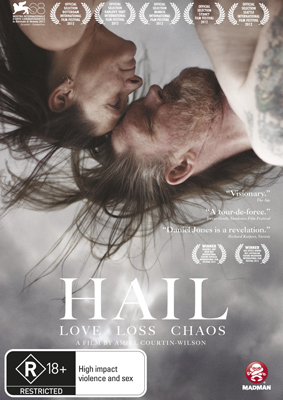 Danny, just out of gaol, struggles to find employment and to confirm love, but circumstances and his damaged psyche coalesce to set him on a path to brutal vengeance. Not a film for the faint-hearted. After seeing Hail at its premiere in the 2011 Adelaide Film Festival, I wrote, “Hail is a drama feature that deftly manages to fuse documentary immediacy (fluid hand-held camera work, raw dialogue) with carefully constructed scenography built around lyrical editing and richly textured and adroitly framed widescreen cinematography (Germain McMicking). It’s a big screen, immersive experience… Despite some uneven plot development, Hail is a remarkable film: Daniel Jones and Leanne Letch’s performances are excellent in their portrayal of a profoundly uneasy love, cinematography is superb and the script tightly focused, conveying both spontaneity and a sense of craft and purpose” (Keith Gallasch, RT102).
Danny, just out of gaol, struggles to find employment and to confirm love, but circumstances and his damaged psyche coalesce to set him on a path to brutal vengeance. Not a film for the faint-hearted. After seeing Hail at its premiere in the 2011 Adelaide Film Festival, I wrote, “Hail is a drama feature that deftly manages to fuse documentary immediacy (fluid hand-held camera work, raw dialogue) with carefully constructed scenography built around lyrical editing and richly textured and adroitly framed widescreen cinematography (Germain McMicking). It’s a big screen, immersive experience… Despite some uneven plot development, Hail is a remarkable film: Daniel Jones and Leanne Letch’s performances are excellent in their portrayal of a profoundly uneasy love, cinematography is superb and the script tightly focused, conveying both spontaneity and a sense of craft and purpose” (Keith Gallasch, RT102).
5 copies courtesy of Madman Entertainment
Searching for Sugarman, DVD
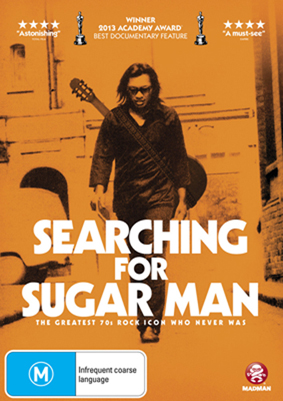 “In the late 1960s, a musician was discovered in a Detroit bar by two celebrated producers struck by his soulful melodies and prophetic lyrics. They recorded an album that they believed was going to secure his reputation as one of the greatest recording artists of his generation. The album bombed and the singer disappeared into obscurity amid rumours of a gruesome on-stage suicide. But a bootleg recording found its way into apartheid South Africa and, over the next two decades, it became a phenomenon. In this Oscar-winning documentary two South African fans set out to find out what really happened to their hero [leading] them to a story more extraordinary than any of the existing myths about the artist known as Rodriguez” (Madman Press release).
“In the late 1960s, a musician was discovered in a Detroit bar by two celebrated producers struck by his soulful melodies and prophetic lyrics. They recorded an album that they believed was going to secure his reputation as one of the greatest recording artists of his generation. The album bombed and the singer disappeared into obscurity amid rumours of a gruesome on-stage suicide. But a bootleg recording found its way into apartheid South Africa and, over the next two decades, it became a phenomenon. In this Oscar-winning documentary two South African fans set out to find out what really happened to their hero [leading] them to a story more extraordinary than any of the existing myths about the artist known as Rodriguez” (Madman Press release).
3 copies courtesy of Madman Entertainment
Please note you can nominate for ONLY ONE GIVEAWAY.
Email us at giveaways@realtimearts.net with your name, postal address and phone number.
Include ‘Giveaway’ and the name of the item in the subject line.
This giveaway is open until June 1.
RealTime issue #114 April-May 2013 pg. 56
© RealTime ; for permission to reproduce apply to realtime@realtimearts.net
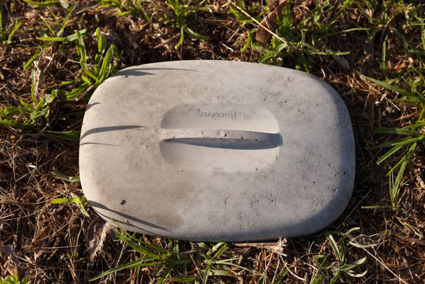
Connie Anthes, Untitled (98 vacancies) (2013)
photo Brett East
Connie Anthes, Untitled (98 vacancies) (2013)
BIENNALES, ART FESTIVALS, ART FAIRS AND ART MONTHS ARE CONSTANTLY PRESENTED TO US AS CONTEXTUAL FRAMEWORKS FOR CONTEMPORARY ART CONSUMPTION. THESE DIVERSE CULTURAL EVENTS, MOSTLY LARGE IN SCALE AND CONCEPTUALLY AMBITIOUS, SERVE TO CONGLOMERATE OUR ART-GOING EXPERIENCES.
Cementa 13, a new kid on the conglomerate block, took on-board this experimental premise with a critical tongue-in-cheek approach. We have all heard of Documenta and Monumenta and now, in Australia anyway, we have Cementa. And here lies the key. Unlike the others, Cementa is firmly located within a social and site-specific context that debunks the white-cube-washing of contemporary art.
Presented by Kandos Projects under the directorship of Ann Finnegan, Georgina Pollard and Alex Wisser, Cementa’s exhibiting artists were invited to undertake residencies in the town of Kandos to develop their works. This residency model resulted in a range of works that not only connected site-specifically, but also with the community and the town’s distinctive character. Works were presented over four days in disused community buildings, empty shopfronts, people’s backyards, on the streets and even the local golf club.
Kandos, over 200 km northwest of Sydney, was certainly not on my regional road-trip radar until I heard the chatter about Cementa at arts gatherings around Sydney. Spurred on by the word-of-mouth build-up as well as the large and impressive list of participating artists I committed to a three-day stay for Cementa.
memorials
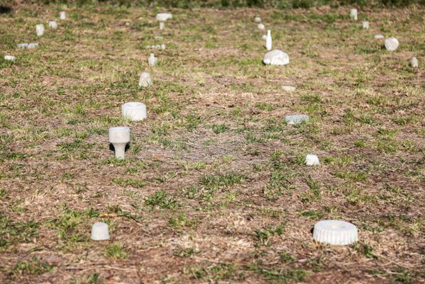
Connie Anthes, Untitled (98 vacancies) (2013)
photo Brett East
Connie Anthes, Untitled (98 vacancies) (2013)
Heading straight out for a walk around town led me to Connie Anthes’ work Untitled (98 vacancies) (2013). In late 2011, Kandos’ main industry—the local cement works and limestone quarry—was decommissioned, inevitably impacting on local economies and the community’s social fabric. In an attempt to memorialise this change, Anthes collected a range of discarded domestic objects from the local tip. Everyday useful items, seemingly no longer needed, were rescued and re-cast in cement. Placed outdoors on the ground of a vacant lot, the meticulous grid of familiar objects became less familiar, disguised by the sameness of their new grey concrete appearance. Like miniature monoliths in the grass, Anthes’ objects invited us to question the everyday effect of industrial change in a rural town.
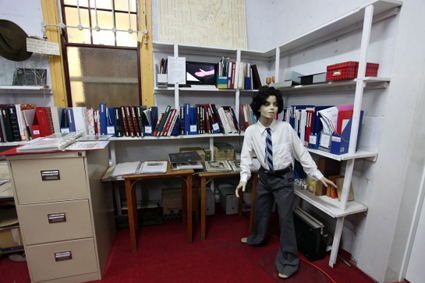
Fiona Davies, Cane (2012)
photo Fiona Davies
Fiona Davies, Cane (2012)
Another work boldly entered the emotionally charged realm of memorialisation within a community context. In her video work Cane (2012), Fiona Davies asked Kandos locals to reflect on school punishment. With the video frame tightly focused on each person’s palm as they recounted punishment by cane in conversation with the artist, we see the hand open, not waiting for punishment but as a marker of memory. Placed beautifully in the Kandos Museum (an Instagrammers heaven), the work sits well amongst a bountiful archive of Kandos’ history. The responses from the participants to their canings range from ‘deserved’ to ‘resented’ and the work brings to light what is mostly amiss in such museological spaces—the personal voice informing the collection’s significance.
intercessions
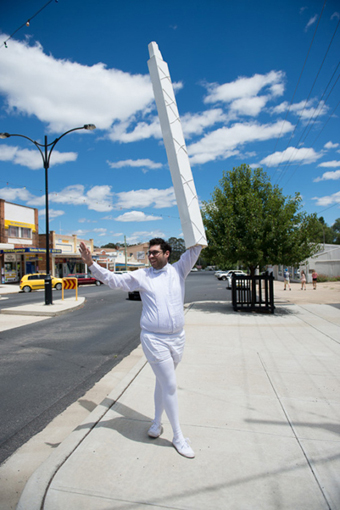
David Capra, Intercessions, Kandos (2013)
photo Alex Wisser
David Capra, Intercessions, Kandos (2013)
Heard loud and clear as he shimmied down the streets of Kandos, artist David Capra continued his investigations into live intercessory performance. Dressed head-to-toe in white, Capra’s outfit intentionally evoked the holy as well as the ubiquitous white of exhibition walls. With an untrained operatic voice and moves that are certainly not trending in contemporary dance studios, Capra’s performance of speaking-in-tongues, banner-waving and dancing became a conduit for intuitive intercession. Unrehearsed and unable to be replicated, his absurd performances on the streets of Kandos were unique experiences of undefined communication and spirit.
During his Kandos residency, Capra was also asked by the Cementa directors to paint the Cementamobile—a handy white van used to cart artists and objects around town. Avoiding a well-trodden path to painterly over-statement, Capra denied the van canvas its loud voice. With sparse, minute motifs on the van—banners, hands shaking and his dachshund Teena—Capra’s van mural was an extremely restrained work. From a distance, the work was indistinguishable. Up close, the motifs came to life in charged patterns Memphis style, an aesthetic born of 1980s post-modernist rejection. Not so coincidentally, the van had a practical role to play in Capra’s performances around town.
serenades
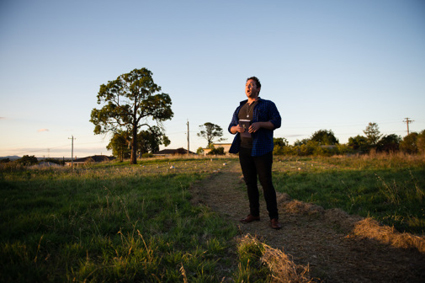
Liam Benson, Cementa (2013)
photo Alex Wisser
Liam Benson, Cementa (2013)
From Hobart Hughes to Sarah Goffman, Cigdem Aydemir and Liam Benson, it was not hard to catch live performance in Kandos. Self-confessed contemporary art romantic, Liam Benson’s daily sunset and sunrise serenades were emotional homages to the Kandos landscape and community. During his residency, Benson developed an affection for the local Glossy Black Cockatoos. Indigenous to the area and with a haven nearby at the Wollomi National Park, the cockatoos are very visible Kandos locals.
Over the four days of Cementa, inspired by the cockatoo’s forlorn call, Benson continued his investigations into masculinity and Australian identity by performing songs of longing and love across Kandos. Singing alone and a capella, each performance’s location unannounced, Benson’s strong rock-infused vocals could be heard emerging from the uniquely Australian local landscape. A sunset performance outside the main pub lured art-goers and locals who followed Benson singing and walking against the backdrop of the dipping sun. As darkness encroached we listened to his rendition of Fleetwood Mac’s “The Chain,” a song about love gone wrong; “Listen to the wind blow, down come the night, running in the shadows, damn your love, damn your lies.”
When not drawing a crowd, Benson sang to Kandos, to an escarpment, a lake, a lone shiftworker in hi-vis clothing, a sleepy campsite and, underlining the ephemerality of performance, to the Glossy Black Cockatoos.
burn-outs
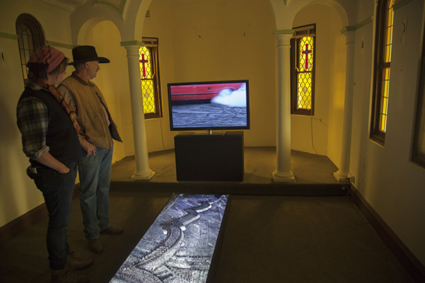
Josephine Starrs, Leon Cmielewski, Chapel of Rubber (2013)
photo Josephine Starrs
Josephine Starrs, Leon Cmielewski, Chapel of Rubber (2013)
Performances of a different kind were the subject of Chapel of Rubber (2013) by Josephine Starrs and Leon Cmielewski. Poetically placed in the now disused chapel at the Kandos Presbytery, the work documented a significant date on the local calendar, the annual Kandos Street Machine and Hot Rod Show. Incongruous with the quiet beauty of the town, this popular but also controversial event is characterised by excessive noise, burn-outs and fluoro cars.
Starrs and Cmielewski’s screen-based work, framed by the intimate architecture of the small chapel, directed our eyes not to the cars, but to the ground—to the spinning tyres and burning rubber. Shot at low-level and in slow-mo, the creeping movement of rising smoke travelled across the screen, at times revealing heavy deposits of burnt rubber on the ground, layered markings of excess, of thrill and of the town’s people and visitors letting go a little. In a town undergoing post-industrial transformation, Chapel of Rubber redefined the strongly symbolic chapel space, maintaining its sense of worship and reverence by channelling hedonistic thrill-seeking action.
There is no doubt there was a lot to conceptually consume at Cementa. At the same time, the incidental social atmosphere—constantly bumping into Sydney-siders and locals while walking along the main drag or grabbing a coffee at the Railway café—meant that Cementa was enjoyably easy to consume. As a conglomerate art experience, the event inhabited the nooks and crannies of Kandos, injecting contextual soul into contemporary art and making it part of the everyday in a rural town. Here’s hoping Cementa 2015 comes around quickly, so we can all get on-board the contemporary art road trip to Kandos.
Cementa 13, directors Ann Finnegan, Georgina Pollard, Alex Wisser; Kandos NSW, Feb 1-4, for participating artists and some great documentation see cementa13.com/
This article first appeared as part of RT’s online e-dition April 3, 2013
RealTime issue #114 April-May 2013 pg. 55
© Sophia Kouyoumdjian; for permission to reproduce apply to realtime@realtimearts.net
There’s a lot of epic art out there: a metropolis of music, rooms filled with bodies, shopping malls sprouting monuments, big pictures, big game and shifting histories. We suggest you keep notes.
metropolis new music festival, melbourne
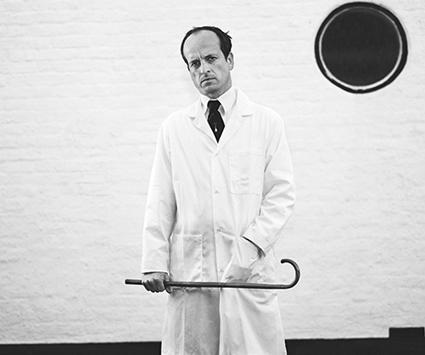
Matthew Herbert, playing as part of Metropolis
Melbourne’s Metropolis Festival has expanded its metaphorical city limits this year with some very adventurous programming. For those firmly in the contemporary classical corner there’s visiting UK composer, pianist and conductor Thomas Adès. There are also concerts featuring DJ/composer Matthew Herbert (UK) and electronic ambient composer Mira Calix (UK). Australia’s Ensemble Offspring, Speak Percussion and Syzygy will perform as well as The Wild (featuring Erik Griswold), presenting a curious re-imagining of The Cure’s “Pornography.”
Metropolis New Music Festival, Melbourne Symphony Orchestra & Melbourne Recital Centre, April 8-20; http://www.metropolisfestival.com.au/
13 rooms, kaldor art projects #27
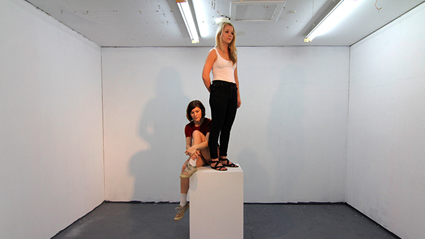
Clark Beaumont, Co-existing, Kaldor Public Art Project #27: 13 Rooms
courtesy the artists
Clark Beaumont, Co-existing, Kaldor Public Art Project #27: 13 Rooms
Surely no-one needs to be told, but maybe the fact that it’s only on for 11 days hasn’t quite hit home. This high-art extravaganza will present intimate performance based work—“living sculpture” (press release)—by leading international artists such as Marina Abramovic (see RT113), Joan Jonas, Xavier Le Roy, Tino Seghal and Damien Hirst. The 13th chamber will feature Brisbane-based emerging artist duo Clark Beaumont in the only new work in the event.
Kaldor Art Projects #27: 13 Rooms, curators Hans Ulrich Obrist, (Serpentine Gallery, UK), Klaus Biesenbach (MoMA PS1, US), Pier 2/3 Walsh Bay, April 11-21; http://kaldorartprojects.org.au/13rooms/index.html
trio a/dance is hard to see, sara wookey
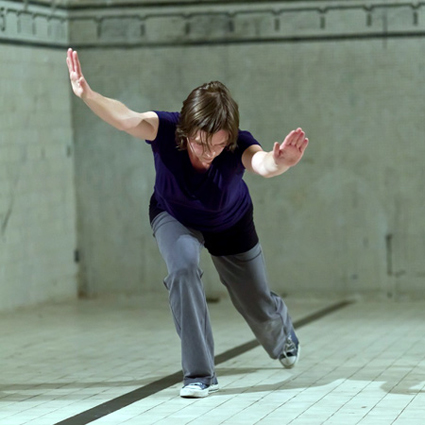
Sara Wookey, Trio A
courtesy of the artist
Sara Wookey, Trio A
Trio A is a seminal work choreographed by Yvonne Rainer in 1966 that informed a new approach to contemporary dance. US-based dancer Sara Wookey has worked extensively with Rainer and is one of a handful of people allowed to ‘transmit’ this choreography to other dancers. Wookey will be running workshops in Perth and Sydney teaching Trio A, as well as presenting a performance lecture about Rainer and her work.
PICA: lecture April 6; http://www.pica.org.au; Performance Space/UNSW Io Myers: workshop April 9-12, lecture April 13, Io Myers Studio; http://www.performancespace.com.au (The project is initiated by Hannah Mathews with thanks to Performa.)
mca: ultimate vision, monuments to us; workout
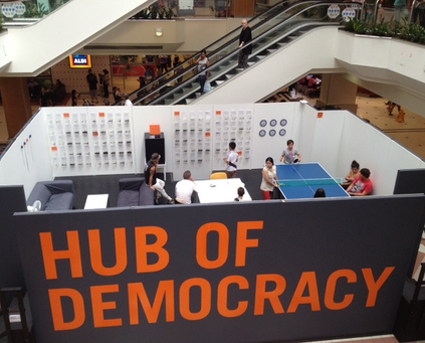
Hub of Democracy, Centre Court, Westfield Hurstville
photo Lara Thoms
Hub of Democracy, Centre Court, Westfield Hurstville
Lara Thoms (see RT Studio) has been hanging out in the mall in Hurstville for the last few months, asking local youth about their favourite things—which colour, word, time, music? After the votes have been counted Thoms will create a series of celebratory monuments, some physical, some performative, in and around the Westfield complex.
MCA/C3West: Ultimate vision, Monuments to us, Lara Thoms, Westfield Hurstville, April 5-10, http://www.mca.com.au
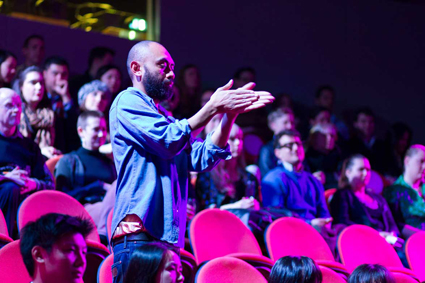
Brian Fuata (Wrong Solo), Reverse Lecture 2012
courtesy & © the artist, photo Catherine McElhone
Brian Fuata (Wrong Solo), Reverse Lecture 2012
Also at the MCA is Workout. Over one week seven artists will be given a day to create a performance exploring “workout as both a strenuous exercise routine and a test of performance capability” as well as the ”creative act of ‘working out ideas’” (press release). Featuring David Capra, Domenico de Clario, Brian Fuata, Sarah Goffman, Agatha Gothe-Snape with Susan Gibb, The Motel Sisters (Liam Benson and Naomi Oliver) and Jodie Whalen.
Workout, curator Anna Davis, Museum of Contemporary Art, April 22-28; http://www.mca.com.au
wang gongxin, maap space
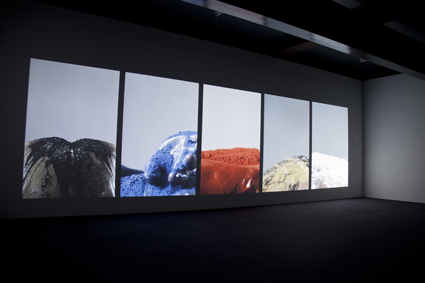
Wang Gongxing, Basic Colour (2010)
courtesy MAAP and the artist
Wang Gongxing, Basic Colour (2010)
Have you noticed a lot of pigment hurling in advertisements and video clips of late (eg Pink’s “Try”)? As usual mainstream media merchants are sucking out ideas from contemporary art. The use of pigment is most notable in the works of Anish Kapoor (showing at the MCA until recently) but also in Chinese video art pioneer Wang Gongxin’s five-channel video piece Basic Colour (2010). “[T]he slow accumulation of coloured pigment on each image is a kind of performance-based painting” (press release). This work is showing at MAAP Space along with Maybe Have Wind which explores manipulations of time and speed in the video format.
Wang Gongxin, MAAP Space, Brisbane, til April 26; http://www.maap.org.au/
the big picture, stills gallery
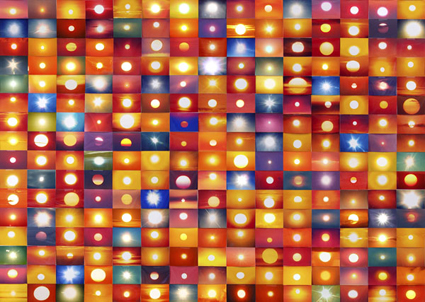
Penelope Umbrico, 541795 Suns from Sunsets from Flickr (Partial) 1/26/06, (2006-ongoing), detail of 2000 4″ x 6″ machine c-prints
Next up at Stills Gallery is an exhibition that asks “If a picture speaks a thousand words, what can a thousand pictures reveal?” (press release). The Big Picture will feature, photographic, video and installation work by Daniel Connell, Drew Flaherty, Gemma Messih, Patrick Pound, Penelope Umbrico (USA) and Tim Webster exploring how the plethora of visual imagery that is now being generated and consumed is affecting our sense of the sublime.
The Big Picture, Stills Gallery, Sydney, April 17-May 18; http://www.stillsgallery.com.au/
big game hunting, fiona hall, heide
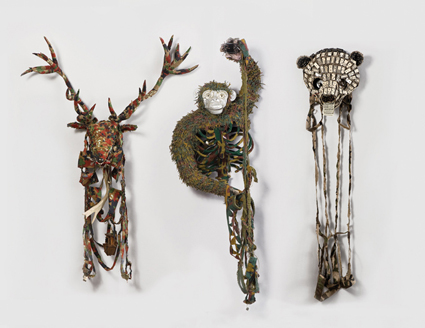
Fiona Hall: (l-r) Cervus elaphus/red deer Europe, North America 2012, IUCN threat status: least concern; Pan troglodytes/chimpanzee, Equatorial Africa 2012, IUCN threat status: Ailuropoda melanoleuca/giant panda, China 2012, IUCN threat status: critical
All images courtesy the artist and Roslyn Oxley9 Gallery, Sydney
Fiona Hall: (l-r) Cervus elaphus/red deer Europe, North America 2012, IUCN threat status: least concern; Pan troglodytes/chimpanzee, Equatorial Africa 2012, IUCN threat status: Ailuropoda melanoleuca/giant panda, China 2012, IUCN threat status: critical
Also looking at big ideas is Fiona Hall’s exhibition at Heide in regional Victoria. The centrepiece is Hall’s recent work for Documenta (13), Fall Prey, in which she uses military camouflage material and found objects to create curious hunting trophies of endangered animals.
Big Game Hunting, Fiona Hall, Heide Museum of Modern Art, Vic, till July 21; http://www.heide.com.au
the agony the ecstasy and i
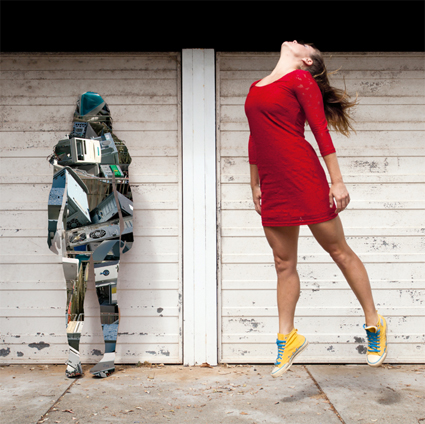
The Agony and the ecstasy and i
image Ivan Shaw and Simon Runkel
The Agony and the ecstasy and i
In this post-postmodern world all works of art talk to and about each other and this is clearly the case in dancer Tarryn Runkel and actor Lauren Hopwood’s The Agony, the ecstasy and i, a work that engages with the issues raised by Mike Daisey’s similarly titled solo show about Steve Jobs in which his representation of fiction and reality became a bit too blurry for some.
The Agony, the ecstasy and i, director Cara Philips, The Blue Room, Perth, April 16-May 4, http://blueroom.org.au/seasons/seasonone2013/
oi you!, urban art festival adelaide street art festival
While Melbourne is synonomous with ‘street art’ each of Australia’s capitals has its fair share and Adelaide is set to celebrate its own urban expression. Hopefully the irony is not lost that the major street art exhibition will take place in the Adelaide’s centre of all things cultural, the Festival Centre and will feature major works from internationals including 22 pieces from the king of urban art Banksy. (It’s a touring exhibition organised by a New Zealand group http://streetart.co.nz/.) There’s also a range of activities highlighting local work such as city tours and a ‘scrawl wall’ for locals to try their hand.
Oi You!, Urban Art Festival, April 20-June 2, Artspace Gallery Adelaide Festival Centre and Adelaide Streets; https://www.facebook.com/OiYouStreetArt
the past is a foreign country, the paper cut collective and trantrum
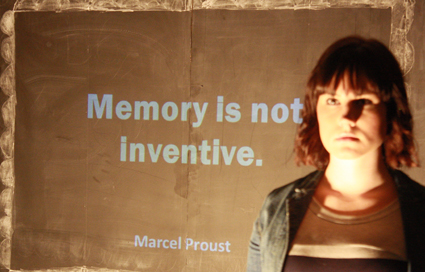
Emily Daly, The Past is Foreign Country, Paper Cut Collective
photo Justine Potter
Emily Daly, The Past is Foreign Country, Paper Cut Collective
Paper Cut Collective is a new performance collective in Newcastle NSW. With the help of local theatre for young people Tantrum, they will be presenting their first show, The Past is a Foreign Country. It’s in the verbatim theatre mode and explores how retelling the past inevitably reshapes it.
The Past is a Foreign Country, Paper Cut Collective & Tantrum, Civic Theatre, Newcastle, April 10-13; http://www.tantrumtheatre.org.au/season-2013/the-past/
still in the loop
The Good Room, I should have drunk more champagne
The Basement, Metro Arts, Brisbane, March 27- April 13
www.metroarts.com.au/
Drawn from Sound, curator Cat Hope
Spectrum Project Space, Edith Cowan University, Perth, March 28-April 12
http://www.drawnfromsound.com/
Made in China, Australia
McClelland Sculpture Park + Gallery, Langwarrin, VIC, (a Salamanca Arts Centre & CAST Touring exhibition), March 17 – June 9
http://www.mcclellandgallery.com
RealTime issue #113 Feb-March 2013 pg. web
© RealTime ; for permission to reproduce apply to realtime@realtimearts.net
exist conference, brisbane
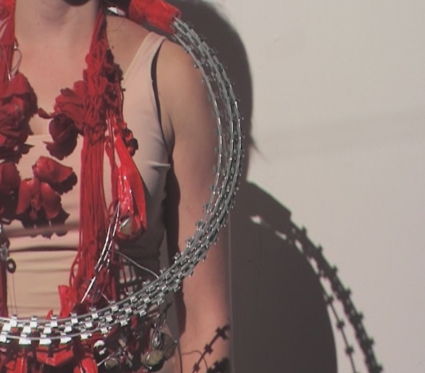
a study in red weight, Rebecca Cunningham, Exist-ence 2010
video still Nicola Morton
a study in red weight, Rebecca Cunningham, Exist-ence 2010
The inaugural exist conference will take place June 26-27 at the Queensland College of Art. Co-directors Rebecca Clunn and Nicola Morton are calling for proposals for papers and presentations which address the theme of Performance, the Body and Time in the 21st century. Topics could include mediatised and digital performance, durational practice, globalisation and gender in mass-media culture and more.
Abstracts are due April 8, www.existenceperformanceart.wordpress.com
next wave 2014
The theme of 2014 Next Wave Festival is New Grand Narratives and applications to participate are now open. Eight to 10 new works will receive artistic and production assistance and “brokerage into funding contexts” (press release) for their premieres at the festival in Melbourne in May 2014. The focus is on emerging artists and there are specific partnerships: Aphids will support a regional artist and John Butler’s The Seed will support a large scale work in public space.
Applications close April 17; http://nextwave.org.au/applications/
cultivate, force majeure
Cultivate is a dance theatre lab presented in association with Performance Space and Carriageworks. The 2014 lab is led by Force Majeure director Kate Champion and Associate Director Byron Perry and will take place from July 15-August 2. Applications are now invited from choreographers, directors, dancers and physical performers/actors who might wish to participate.
Deadline April 30; http://forcemajeure.com.au/creative-professional-development/cultivate/
abr voiceless fellowship
The Australian Book Review is seeking expressions of interest for a fellowship sponsored by the animal protection organisation Voiceless. The successful applicant will be commissioned to write a 7,000-8,000 word article on animal protection issues for $5,000. For the fiction writers the Elizabeth Jolly Short Story prize is also open for entries offering a $5,000 prize.
Applications for both close May 31, https://www.australianbookreview.com.au/programs/abr-patrons-fellowship
nka arts residencies, ghana
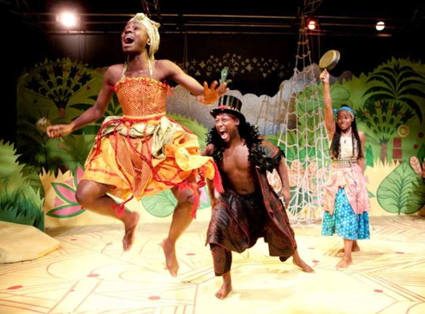
Anansi: An African Fairy Tale by Lisa Cagnacci – Southwark Playhouse
photo Donald Cooper
Anansi: An African Fairy Tale by Lisa Cagnacci – Southwark Playhouse
The Nka Foundation is based in Ghana and focuses on “human capital development through use of the arts” (website) by running a range of workshops, laboratories and residencies. Currently Nka is accepting applications for residencies of one to nine months in their artist village at Abetenim in the Ejisu-Juaben district, Ashanti region of Ghana. Artists working in theatre, film, music, visual arts and multidisciplinary are eligible.
E-mail to info@nkafoundation.org; http://www.nkafoundation.org
leisa shelton workshop, judith wright centre
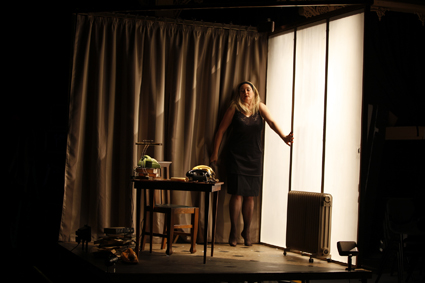
Leisa Shelton, Irony is Not Enough: Essay on My Life as Catherine Deneuve, Fragment31
photo Ponch Hawkes
Leisa Shelton, Irony is Not Enough: Essay on My Life as Catherine Deneuve, Fragment31
Performance maker Leisa Shelton will be running a one-day workshop in Responsive Performance Practice for Brisbane-based practitioners (see RT101). The technique draws on “actor training developed by Etienne Decroux, the rehearsal processes of Pina Bausch via Meryl Tankard, and Autonomous Actor training as developed by Lindy Davies alongside a continuing dialogue with Eastern principles of theatre practice” (website).
Judith Wright Centre, $60 (capacity is limited), April 20, 10am – 4pm; http://judithwrightcentre.com/event/leisa_shelton_workshop
still in the loop
Vitalstatistix: Adhocracy
Deadline April 12
http://vitalstatistixtheatrecompany.blogspot.com.au/
ISEA Conference June 11-13
Earlybird registrations close April 19
http://www.isea2013.org/events/conference/
Gasworks Circus Showdown
Deadline March 18; showdown May 15-18
www.gasworks.org.au
Dimanche Rouge Festival, Tallinn, Estonia
Applications close May 1
www.dimancherouge.org/dimanche-rouge-estonia
Sydney Fringe
Registrations close May 10
http://2013.sydneyfringe.com
Artspace Montreal residency
Applications due April 19
www.artspace.org.au/residency_international.php
Artspace Sydney residency
Applications close Friday 3 May 3, 2013
www.artspace.org.au/about_news.php?i=20130225189240
selected australia council grant deadlines
(for full list seewww.australiacouncil.gov.au/grants)
Theatre: Community Engagement Residency April 12
Theatre: Remount Fund for Independent Artists April 12
Visual Arts: Fellowships April 15
Visual Arts: New Work – Early Career April 15
Visual Arts: New Work – Mid-Career April 17
Visual Arts: New Work – Established April 17
International Performing Arts Markets (IPAMS) Travel Fund April 26
Music: International Pathways – Round 3 May 6
Music: Program May 6
Literature: Digital & New Media May 15
RealTime issue #113 Feb-March 2013 pg. web
© RealTime ; for permission to reproduce apply to realtime@realtimearts.net
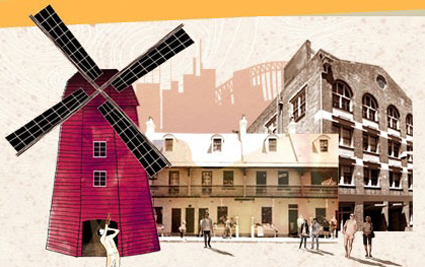 DOWN AT THE ROCKS PRECINCT THE CULTURAL SCHEMERS AT THE SYDNEY HARBOUR FORESHORE AUTHORITY ARE NOT AFRAID TO DREAM BIG.
DOWN AT THE ROCKS PRECINCT THE CULTURAL SCHEMERS AT THE SYDNEY HARBOUR FORESHORE AUTHORITY ARE NOT AFRAID TO DREAM BIG.
In 2009 they presented Fire Water by Michael Cohen and Joey Ruigrok van der Werven—a ship moored in the harbour that caught alight and sank every night for the duration of its performance season (see RT90). So maybe it’s not at all surprising that the same team have now decided to build a four-storey windmill!
The Rocks Windmill is again the brainchild of van der Werven, this time working with interdisciplinary artist Paul Gazzola. The structure will actually operate as a functioning mill with visitors invited to collect a bag of wheat and grind their own flour. The structure pays homage to the first theatre of the colony, set up by former convict Robert Sidaway, who allowed audience members to pay for entry with flour.
The windmill with also be a creative hub for a range of activities exploring both local history and contemporary issues. Windmill Live will see the structure become home to a variety of performance events including the Bell Shakespeare Company performing excerpts from Henry IV (the first work performed in the colony); a creative development showing by My Darling Patricia; an evening of Rocks themed stories by a Newtown writers group, Penguin Plays Rough; film screenings and secret music events.
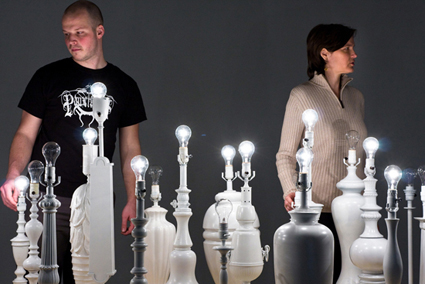
Tiffany Holmes, Dark Sky, ElectriCITY Sparks Community Eco-Viz , Carbon Arts And Media Lab Melbourne
Inside these Walls is the exhibition program. On one floor will be ElectriCITY Sparks Community Eco-Viz Exhibition which will display “world-leading projects and proposals for electricity visualisation in public space” (website), produced by Carbon Arts and Media Lab Melbourne. A surround sound installation by radio producer Jane Ulman will develop over time, incorporating sounds from all the activities within the building. The Tilting at Windmills project by Tessa Zettel and Jennifer Hamilton will explore our relationship, real and fictional, with weather. A series of talks is bundled under the Windmill Whispers program while Grist to the Mill offers a range of hands-on activities including naturalist Diego Bonetto’s popular Foraging the City weed workshops.
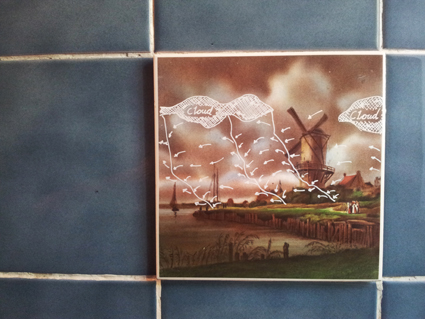
Tilting at Windmills, Tessa Zettel and Jennifer Hamilton
courtesy of the artists
Tilting at Windmills, Tessa Zettel and Jennifer Hamilton
Compared with the razzmatazz of Vivid and the touristic vibe of the area, the Rocks Windmill Project is particularly impressive as its programming focuses on grass roots ideas and issues with an emphasis on participatory engagement between artists, audiences and the local residential community.
The last windmill to dominate the Sydney skyline was demolished in 1878. Although temporary, it seems the 2013 windmill will be an important addition to both the physical and cultural landscape of Sydney, connecting its past with its future.
Sydney Harbour Foreshore Authority: The Rocks Windmill, key artists Paul Gazzola and Joey Ruigrok van der Werven, April 12-May 12; http://www.therocks.com/sydney-Things_To_Do-The_Rocks_Windmill.htm
RealTime issue #113 Feb-March 2013 pg. web
© RealTime ; for permission to reproduce apply to realtime@realtimearts.net
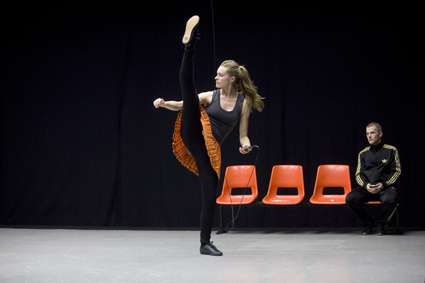
Stephanie Lake, Alisdair Macindoe, Conversation Piece, Lucy Guerin Inc
photo Ponch Hawkes
Stephanie Lake, Alisdair Macindoe, Conversation Piece, Lucy Guerin Inc
IT’S ALREADY BEEN NOTED IN SEVERAL OF OUR REVIEWS THAT MANY OF THE SOUNDTRACKS FOR SHOWS IN DANCE MASSIVE HAVE THEMSELVES BEEN MASSIVE. ALONG WITH SMOKE, STROBING LIGHTS AND NUDITY, SEVERAL SHOWS HAVE ALSO FOREWARNED THEIR AUDIENCE OF “LOUD MUSIC.”
These days the ubiquity of digital audio processing software makes it relatively quick and easy for the solo composer to create epic, symphonic pieces and dance has become the seeding ground for a kind of new electronic baroque. Often these soundtracks are masterful, but after seeing so many works in quick succession it is refreshing to experience collaborations between choreographers and composers or sound artists that attempt more subtle, conceptual and nuanced modes. An interesting anomaly in Dance Massive 2013 was the strange flashback to the days when composers were too expensive and choreographers cobbled together pre-made commercial tracks for their design. And why not—just to mix things up a little?
nostalgia for the signified
In Conversation Piece (which I saw in Sydney, not in its Dance Massive version) Lucy Guerin’s inclusion of songs such as Nick Cave and The Bad Seeds’ “Mercy Seat” performed by Johnny Cash or The Cure’s “A Forest,” seems pragmatic and devoid of irony. They are used to accompany the buoyant dances that curiously rupture the otherwise text-driven work and are clearly a “cheat”—they get us to where we need to go emotionally and atmospherically via their well established associations. However Guerin keeps things edgy, utilising the considerable skills of Robin Fox as sound designer to shift Conversation Piece towards darker places. The true complexity of the sound design is in the seamless manipulation of the iPhone technology as a multipurpose tool (as Apple has always wanted us to believe). The addition of the Garage Band rendition of Kylie Minogue’s “Come Into My World” (composed by Cathy Dennis and Robert Davis) is a stroke of quirky brilliance and serves to thematically integrate the idea of inner and outer worlds, personal and public soundtracks.
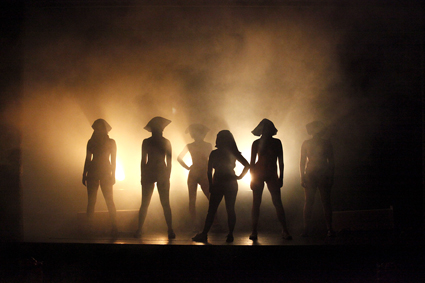
Monster Body, Atlanta Eke
photo Rachel Roberts
Monster Body, Atlanta Eke
In Monster Body, Atlanta Eke uses the most mainstream of commercial tracks, subverting them through that old postmodern strategy of juxtaposition. Britney Spears pipes “I’m not a girl, not yet a woman” while a naked Eke releases an arc of urine onto the floor. To Beyonce’s “Run the World (Girls)” Eke is joined by six other naked women of various body shapes to crump, jiggle and wobble very precisely through the grotesqueries of sexualised R&B dancing. Even the use of Ligeti (via Stanley Kubrick’s 2001: A Space Odyssey) hints at irony—the female body as cosmic unknown. In an over extended sequence, Eke parades in a body suit full of water balloons at the same time subjecting us to a relentless loop of revving motorbike engine—machismo at its sonic finest. In Monster Body, the music and sonic material hold the meaning in relation to which Eke’s body ventures definition.
haunted weather
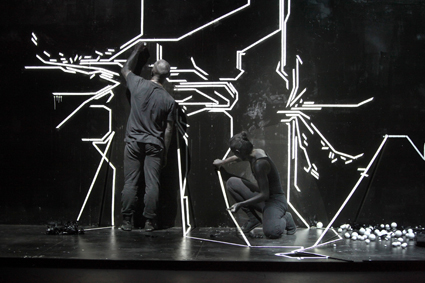
Antony Hamilton, Melanie Lane, Black Project 1
photo Ponch Hawkes
Antony Hamilton, Melanie Lane, Black Project 1
Discussing his approach to musical structure, John Cage said he sought to move “away from an object having parts into what you might call weather” (Composition in Retrospect, 1993). Antony Hamilton’s sound compilation for Black Projects 1—a series of tracks by European masters of electronic glitchy ambient Robert Henke, Mika Vainio and Fennesz—perfectly exemplifies this idea. This is not just because the soundscape consists of rolling waves of digital thunder and electronic static but rather that the music creates a space for the dancers (Melanie Lane and Hamilton) to simply inhabit. It is soundscape as landscape, not soundtrack, and it works well, allowing us to be drawn into the post-apocalyptic world while leaving space for the dancers’ actions to further shape and define it.
In Black Projects 2, however, the score, composed by Alisdair Macindoe (also a very fine dancer in Stephanie Lake and Lucy Guerin’s works), offers the complete opposite. Here the dancers are dictated to by the pulsing beats, as a six-headed creature shape-shifts and osmoses leading to a final holy cosmic epiphany. While well-produced and cinematic, the soundtrack offers little mystery, letting the dancers and us know where we are up to at all times.
big, bigger, biggest
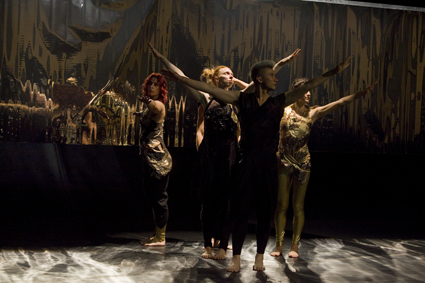
Future Perfect, Jo Lloyd
photo Ponch Hawkes
Future Perfect, Jo Lloyd
Experienced on the first night of Dance Massive, Macindoe’s score indicated a trend in the many scores that followed. Perhaps paralleling the “loudness war” in commercial music production, it seems that many of the choreographers and their sound collaborators feel the need to make things bigger—more volume, more layers, more crescendos, more speakers. Siding with the critics of the loudness war, I wonder if something is lost in the process. I don’t just mean hearing (though that’s sometimes a possibility) nor even the crest or trough of dramatic range, but is it possible that these epic soundtracks have the effect of diminishing the bodily presence? Buffeted and propelled as it is by sonic forces, is the body losing its own agency, or space to be seen and read without the prompting of sonic signifiers? (Or have I been reading too much Yvonne Rainer?)
The soundtrack for Jo Lloyd’s Future Perfect by Duane Morrison feels close to subsuming the dancers and while transcendence is on the agenda, it feels a little more bullying than uplifting. Flavoured by 1980s synthesiser sounds the creators set themselves a difficult task. Starting at such a high sonic point, there’s little room for escalation either energetically or volume-wise throughout the piece.
Sandra Parker’s The Recording is an exploration of the disjunction between the body, gesture and mediatised performance, so allowing Steve Heather’s soundtrack to be bigger than the dancing is clearly a conscious choice. Composed from recordings of some of Australia’s and Europe’s leading improvising musicians, who are better known for their textural, pointillist sonorities, Heather’s score is surprisingly luscious and harmonically driven, becoming increasingly more romantic, even approaching the parodic with its Latino-lament conclusion. Does it mean that Parker succeeded in her exploration if I found the music more engaging than the physical performance?
Of course sometimes the hyperbolic soundtrack approach is perfectly apt as in Jethro Woodward’s score for Skeleton by Larissa McGowan. The work is about forces acting upon the body—both physical and cultural—and Woodward’s super energetic, highly fragmented score of smashing glass and sudden impacts mixed with computer game bleeps and cinematic howls, grunts and screams is masterfully constructed. He even allows for a quieter lyricism near the end, interestingly not paralleled by the dance which remains muscular, taut and edgy. The score is nerve janglingly relentless, yet utterly appropriate for the work.
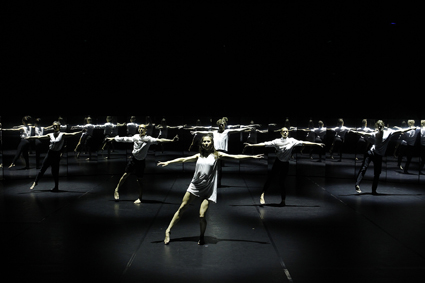
Tara Soh, James Pham, Lauren Langlois, Leif Helland, Niharika Senapati, Alya Manzart, 247 Days, Chunky Move
Chunky Move’s 247 Days choreographed by Anouk van Dijk, a work about the highs and lows of youthful existence, is well served by the sound design by Marcel Wierckx (Canada/Netherlands). Gradually accruing detail from the almost imperceptible crackle of a vinyl record, underpinned by sustained chords, he works in live vocal elements from the miked-up dancers. Half-gasps, fragments of melody and shards of words are grabbed and effected, a bit of reverb here, digital stutter there, creating the sense of an ‘internal voice.’ The piece culminates in a choral epiphany, voices delayed, pitch-shifted and overlapped to form a massive chorus, but somehow it just doesn’t quite reach the peak to which it aspires, or perhaps it does so too rapidly. While much of the spoken text feels naïve, the more abstracted vocal play provides a cohesion to both the soundtrack and the work overall.
Don’t get me wrong, I love a vast soundtrack but perhaps what is beginning to perplex me is that the “bigger and louder is better” approach is in danger of becoming the default setting for contemporary dance, not only in the mainstream but also the independent sector. (Is this the place to mention that, one female “sound theorist” aside, all the composer/sound designers in Dance Massive were male?) While there’s no doubt that it is effective/affective, is this approach conceptually engaging?
dancing dialogues
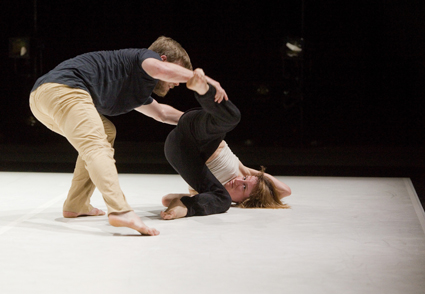
Alisdair Macindoe, Sara Black, Dual
photo Ponch Hawkes
Alisdair Macindoe, Sara Black, Dual
For those seeking a deeper investigation into the relationship of sound and the moving body several of the smaller scale works offered the most satisfaction. Robin Fox’s sound for Stephanie Lake’s Dual is definitely of the epic loud variety; however both dance and music explore a clear structural principle—Part 1 = A, Part 2 = B, Part 3 = A+B. The correlation between action and sound develops a complexity due to the absence or rather the implied future presence of the other half of the dance and music. For example, in a section of her solo Sara Black lies face down on the floor slowly and gracefully extending her limbs while her soundtrack berates her with seemingly inappropriate harsh stabs. When the duo is complete, we see that the soundtrack at this point more clearly reflects Macindoe’s actions rather than Black’s reaction as he pulls and prods her. It’s a simple conceit but offers a fascinating depth in its execution.

Natalie Abbott, Sarah Aitken, Physical Fractals
photo Ponch Hawkes
Natalie Abbott, Sarah Aitken, Physical Fractals
Physical Fractals also worked with bare-boned simplicity, effectively marshalled by sound designer Daniel Arnot. Natalie Abbott and Sara Aitken’s rhythmic repetitions make sounds in the space which are captured by eight microphones, placed with heads hard up against the floorboards. The predominant sounds are footfalls and breaths, delayed to make rhythms which radiate out from the initial action. Sometimes the sounds of the actions are captured and continue after the bodies have ceased to move, playing with our perceptions and expectations. At one point sound becomes the dominant character of the piece as the dancers swing live microphones like lassoes just above the audience producing a ferocious roar which in some deft looping trick continues long after the dancers are still again. What is particularly refreshing is how raw and unaestheticised the sounds themselves are, the only decoration found in the beats made by delay or the ever-present hum of sound and light leads interfering with each other. While this use of action to create the sound score is not new, it’s the purity and thoroughness of this exploration, the conceptual rigour in both dance and sound design that makes this work impressive.
Tim Darbyshire’s More or Less Concrete works with a similar premise to Physical Fractals but pushes it to its ultimate conclusion. The three dancers are closely miked, every movement, mumble, rustle, breath heightened for the audience via the headphones they are invited to wear. Here sound is not so much a by-product of movement but rather the movement seems decided by the sounds they will produce. The gentle “shhhhh” of bodies against the floor, the “phhhhhhh” of bodies rubbing against each other in polyester overalls, the slap of hands hitting the floor all call for the body to form odd shapes and perform actions that are the dance itself. Only occasionally is an effect added, some reverb or ring modulation to expand an action further into the space. Where Physical Fractals achieves a symbiosis of sound and movement, More or Less Concrete creates a complete synthesis.
Finally on matters of integrated sound and action, Ashley Dyer’s Life Support (made with a long list of collaborators including Sam Pettigrew on ‘sound and objects’) also deserves a mention not so much for its integration of body and sound but rather as an inhabited sound and light installation. Above an ominous and insistent hum the smoke machines used to fill the increasingly claustrophobic space provide a utilitarian and deeply disturbing soundtrack. The sonic highlight is an all-too brief performance by a smoke ring orchestra—upturned speaker cones with buckets attached emit rough farty sounds, the vibrations sufficient to puff air for the creation of smoke rings. I would like to see/hear a whole concert of that!
festival compression
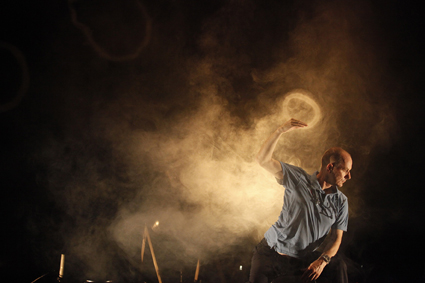
Tony Osborne, Life Support, Ashley Dyer
photo Rachel Roberts
Tony Osborne, Life Support, Ashley Dyer
Of course it’s a little unnatural to experience so many works in such a short amount of time and it can lead to unfair comparisons, but it does provide a contour map of ways in which dance and music are developing. Compared with works in Dance Massive 2011 the grand cinematic soundtrack remains a constant, but this year we see the re-introduction of the mix-tape mentality and also a shift from the live instrumentalist to the performing audio engineer which allows for in-depth explorations into concrete, less decorative sounds in space. In these latter works we see not only a rigorous investigation into the relationship of sound and the performative body, but also an extension, particularly for a more mainstream audience, of the very definitions of music. Sam Pettigrew (sound and smoke-ring master in Ashley Dyer’s Life Support) suggested to me that during festivals like this there’s a great opportunity to put on an über-gig, bringing the purely audio work of these innovative composers and sound artists to a whole new audience. One for Dance Massive 2015?
–
Dance Massive 2013, Arts House, Dancehouse, Malthouse, March 12-24, 2013; http://www.dancemassive.com.au
Due to various constraints several shows in Dance Massive were not able to be addressed here: Marrugeku’s Gudirr Gudirr, Lee Serle’s P.O.V., Matthew Day’s Intermission, Hannah Mathew’s Action/Response, and Dance Exchange’s dance for the time being – Southern Exposure.
RealTime issue #114 April-May 2013 pg. 34
© Gail Priest; for permission to reproduce apply to realtime@realtimearts.net
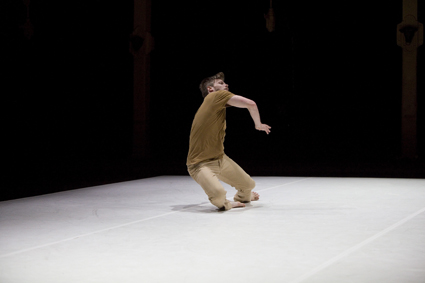
Alisdair Macindoe, Dual
photo Ponch Hawkes
Alisdair Macindoe, Dual
IN A MERE SEVERAL DECADES, THE CHOREOGRAPHER HAS EVOLVED INTO THE DIRECTOR-CHOREOGRAPHER, COLLABORATING WITH COMPUTER SPECIALISTS, TECHNICIANS, VIDEO AND SOUND ARTISTS, THEORISTS AND UNUSUAL SPECIALISTS LIKE ROBOTICISTS. OFTEN THEY SHARE THE MAKING WITH THEIR DANCERS—WHO HAVE, IN PARALLEL, EVOLVED INTO EXPONENTS OF STYLES OF BEING, DANCING, ACTING, SPEAKING AND SINGING AS REQUIRED.
These developments haven’t been sudden nor have they been solely of a kind felt by dance. The emergence of contemporary performance of the 1970s and 80s signalled the fruitful bringing together of hitherto largely discrete forms. Here, movement played a significant role, texts were projected or intoned, conventional playwriting eschewed, design was no longer background or setting but a creation in itself, sound was no longer played in the intervals between words, and the application of new technologies could find room to move. Dance, more than theatre ever has, embodied or took on this opening out and became a leader in exploring the potential of digital technologies in the late 90s into the 2000s.
This process of hybridisation is still playing out, not so much creating new forms as mutating existing ones: a dance work is still a dance work but the manner of its framing and the ways in which it engages its audiences are changing, offering experiential intensity. We can still witness the movement of Russell Dumas’ dancers as simply dance in and of itself, without a sound score or elaborate costuming and lighting. Some works indicate a focus on the dancer’s movements with aural close-ups, amplifying the sounds made by the breathing, stressed body or its impact on surfaces. These and other works play with our senses and heighten the feeling of immersive proximity.
The programming of Dance Massive 2013, a small but telling slice of Australian dance, has revealed that contemporary dance is as engaged as ever with the nature of the theatrical experience, pushing further and further into immersion, perceptual play and the production as performative installation.
installed
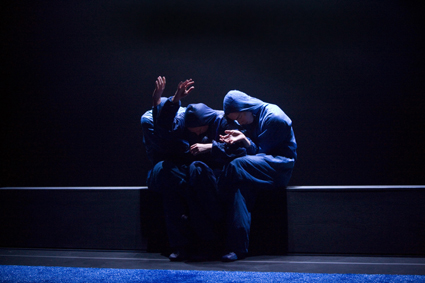
More or Less Concrete, Tim Darbyshire
photo Ponch Hawkes
More or Less Concrete, Tim Darbyshire
Dance Massive 2013 included a significant number of productions that could be regarded in some senses as much dance installations as they were timed performances. Antony Hamilton’s Black Project 1, Tim Darbyshire’s More or Less Concrete, Ashley Dyer’s Life Support, Anouk van Dijk’s 247 Days, Natalie Abbott’s Physical Fractals, Stephanie Lake’s Dual and Lee Serle’s P.O.V. each comprised design/technology activated/inhabited by performers and sometimes audiences.
Sounds actual, amplified and treated made by dancers in More or Less Concrete and Physical Fractals filled the aural space about us, as did sounds of popping smoke-ring machines in Life Support with increasing intensity as smoke filled a diminishing auditorium. In More or Less Concrete the miked breathing, coughing, gasping and thumping of performers’ bodies mutated from the real into surreal soundscapes for its headphoned audience. In Physical Fractals, framed with light, four pairs of microphones angled close to the floor set the physical and aural parameters of the dance with the speed, beat and bounce of the taut choreography. Two microphones are swung over our heads mid-show, making us, and the very air around us, part of an installation. In Dual the rectangle on which the dance unfolds is just one plane of an aural space in which sounds sweep by and at us, and we hear three variations of the score, making the space at once aurally familiar and strange (in its permutations).
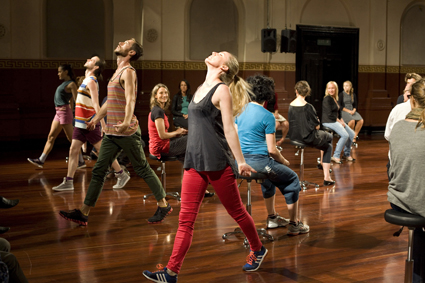
P.O.V, Lee Serle
photo Ponch Hawkes
P.O.V, Lee Serle
In P.O.V. the audience is invited to sit in a grid of swivel stools, such that the dancers course down rows and cross intersections and the viewers can turn to follow them. Those of us outside the frame watch the dance of audience movement and admire the precision of the speeding and lunging dancers, their peripheral vision making themselves and the audience safe in the narrow aisles. This dance installation can be experienced from inside or out. Ben Speth’s WeTube LIVE inverts the P.O.V. grid: here it’s the performers in fixed rows with the audience roaming among them, but working on the same principle of playing with perspective and subjective point of view.
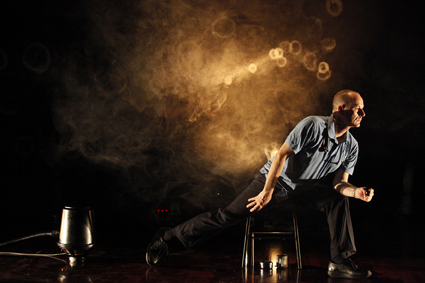
Tony Osborne, Life Support, Ashley Dyer
photo Rachel Roberts
Tony Osborne, Life Support, Ashley Dyer
Life Support proved to be more installation than movement work. The rings, waves and falls of smoke do the dancing while a performer executing a set of simple, quite abstract gestures (as if refusing to make thematic comment) plays potential sacrificial victim to an audience acting as possible executioner à la the infamous Milgram Experiment (we can vote to release the performer from a box filled with smoke; or not). In the program, the onstage operators of the smoke machines are credited as performers: Life Support is a machine in which we are trapped as a wall closes in and smoke pours over us. We are given oxygen cannisters should we feel short of breath. Although Life Support is ultimately unthreatening, there are moments when the otherwise complicit imagination unwillingly conjures darker visions of fires, gas chambers, dust storms and other asphyxiators.
Black Project 1 is not simply danced, it is installation-cum-dance. It has the powerful appeal of experiencing visual art in the making as two strange graffiti-ists strip a wall to make large scale patterns of white against sombre shades of black and the sheen of the makers’ charcoal skins.
sensed
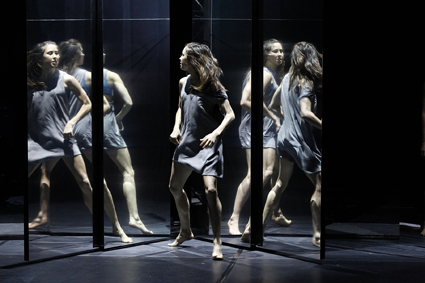
Lauren Langlois, 247 days, Chunky Move
photo Jeff Busby
Lauren Langlois, 247 days, Chunky Move
The pleasure of dance resides in the privilege of watching skilled movers who are exemplars of capacities flexible, anti-gravitational and richly suggestive. The dancing body is more often than not framed with set, costume, light and sound, focusing and amplifying our sense of the movement, expressly foregrounding it. However more and more works play with the senses of the audience, expanding perspectives on dance in which the dancer is integrated into the design by means lo-tech and high (think of Gideon Obarzanek’s Mortal Engine, among many others). In Black Project 1 the painterly merging of bodies and environment and the tonal gradings with which it is executed are visually engrossing.
The design for 247 Days is a curved wall of mirrors that reflects, multiplies and even disappears the dancers. The wall opens to form doors and more reflections, providing sensory pleasures and thematic complexity. No mere background, this vast mirror is integrated with the dancing and is operated by the performers.
Choreographers happily, and meaningfully, played with our perceptions in this Dance Massive. In extreme cases our visual field was limited by low lighting levels such that we often had to adjust to make sense of what we were seeing. Correlative or contrasting movement is as important as light in these works: the alternation of stillness and rapid movement in Black Project 1; the sheer slowness and odd body shapings in More or Less Concrete; the brush strokes of movement in moments of ultra-low light in Physical Fractals.
Matthew Day’s Intermission offers a very special kind of immersion, our attention locked in synch with the waves of vibration that consume the dancer’s body while our ears buzz and hum with the broad counterpoint provided by James Brown’s score. Our appreciation of Day’s movement is an extension of what we feel for any dancer who engages us, but the minimalist repetition and variation make for a distinctively intense experience.
hybridised
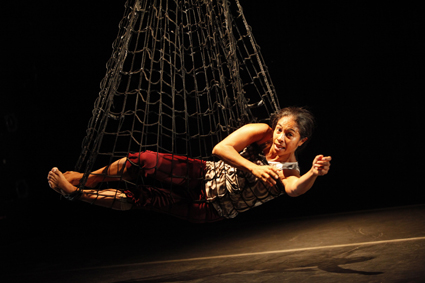
Dalisa Pigram, Gudirr Gudirr, Marrugeku
photo Ponch Hawkes
Dalisa Pigram, Gudirr Gudirr, Marrugeku
Lucy Guerin Inc and Belvoir’s Conversation Piece, Marrugeku’s Gudirr Gudirr, and Atlanta Eke’s Monster Body synthesise forms of performance. Guerin brings together three dancers, three actors, improvisation, choreography and sound technology to create an aesthetically dense account of how we deploy language as power. In Guddir, Gudirr, a high point in Dance Massive, Dalisa Pigram is at once dancer, actor and physical theatre performer and always herself, addressing us directly, a powerful presence and superb artist in the only work in this dance event that deals with actual lives, personally and politically (although Atlanta Eke’s Monster Body also carries some political punch).
Skeleton is the creation of a choreographer, Larissa McGowan, working with a theatre director, Sam Haren. Lo-tech stage wizardry and high-speed dance generate a world of brutal ephemerality where accidents and nostalgia uncomfortably co-exist. Skeleton’s constant choreographic content and pulse prevents it from being labelled dance theatre, but it does have a clarity of purpose and design, not least in its use of objects (skateboard, BMX bike, headphones, baseball bat) that incline it to that form without disadvantage and with increased thematic coherence (although my fellow writer Carl Nilsson-Polias thought the work underdeveloped). Jo Lloyd’s Future Perfect has some kinship with Skeleton’s structural-thematic approach: it too deploys propulsive, finely realised choreography and ends in dissolution.
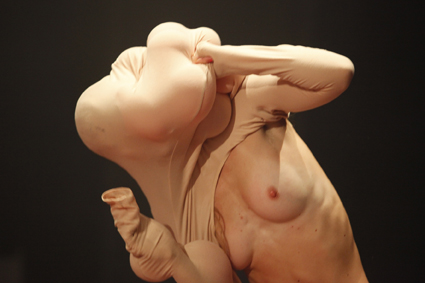
Atlanta Eke, Monster Body
photo Rachel Roberts
Atlanta Eke, Monster Body
Atlanta Eke’s Monster Body is a loose hybrid of dance, contemporary performance and performance art, a series of strong images with broad thematic unanimity and no obvious development. Work of this kind was abundant in the 1980s and 90s, but it’s refreshing to see its emergence in the form of an idiosyncratic, brave and engaging performer as well as occurring at a moment when the feminine and feminism are once again in focus.
Some of the show’s images are overwrought—the cute animal-headed figure posing sexily to the repeated roar of a motorcycle promptly empties itself of significance—or too awkwardly realised—when Eke fills her rubber body suit with water-filled balloons to become multi-breasted, the image is muddled. These contrast with scenes more adroitly and powerfully realised, including Monster Body’s most potent image—the naked Eke growling and howling with superb vocal control while executing precise dance steps. Nothing else in the performance was as strange or monstrous as this.
futured

Tobiah Booth-Remmers, Lisa Griffiths, Lewis Rankin, Skeleton
photo Chris Herzfeld, Camlight Productions
Tobiah Booth-Remmers, Lisa Griffiths, Lewis Rankin, Skeleton
Eke, like Lake, Hamilton, Pigram, Day, Darbyshire, Serle, McGowan, Lloyd and Abbott collectively suggest through their creations an adventurous and diverse future for Australian dance in which audiences are regarded by choreographer-directors as sensory beings open to an enlarged view of dance as not only an integral part of the greater realm of performance but of dance as an instigator of intelligent investigation and innovation.
questioned
There are questions to be asked, for example about a certain sameness among space-eating sound scores, however dextrously and ingeniously they have been realised (see Gail Priest’s overview). As well, there’s the dance language itself, dominated by hyper-fluency and style melding that allows little time or space for reflective movement, with only a few exceptions. Antony Hamilton, Jo Lloyd, Stephanie Lake, Anouk van Dijk and Natalie Abbotts’ hyperactive subjects contrast sharply with Russell Dumas’ and Tim Darbyshire’s slowly evolving formations, while Matthew Day hovers between, moving in grand slow arcs while vibrating at speed. This is not to deny the rich diversity of choreographic approaches in the first group and the intricacies realised by their skilful dancers. As for ideas, Dance Massive was full of them, from the overtly political and cultural to speculations on ritual and worship, art-making, accidents, the self, relationships, mutability, the city and the future.
Dance Massive once again proved a deeply satisfying experience for audiences and for bringing together many of the dance community. As for its other function, the selling of Australian work to overseas presenters, outcomes are as yet unknown although there were apparently some promising signs.
Now that Spring Dance has been dropped by the Sydney Opera House, Dance Massive is the only substantial dance event for what are for the most part independent Australian contemporary dance makers, although it’s hoped that the MoveMe Dance Festival (see review) presented by STRUT and Ausdance WA in Perth might grow in scale and reach to bolster national dance culture. (It would be misleading to suggest that Spring Dance did a great deal for Australian dance, but it did develop an audience—but apparently not a big enough one despite press release rhetoric about record attendance numbers.) I hope that Dance Massive, with its doubtless limited resources but committed host venues, can continue to offer artists and audiences the opportunity to see and celebrate significant work, especially from the kind of emerging talent on show this year. It would be even more satisfying if more interstate artists could become part of Dance Massive (the numbers have varied event to event and there are many variables involved, cost not the least among them). In an era of increasing ephemerality, the need for Dance Massive is great. Long may it prosper.
–
Arts House, Dance House, Malthouse, Dance Massive 2013, Melbourne, March 12-24
RealTime issue #114 April-May 2013 pg. 26
© Keith Gallasch; for permission to reproduce apply to realtime@realtimearts.net
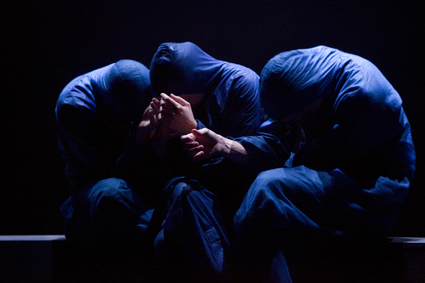
More or Less Concrete, Tim Darbyshire
photo Ponch Hawkes
More or Less Concrete, Tim Darbyshire
IN LIVE ART, CONTEMPORARY PERFORMANCE, DANCE, CINEMA AND DIGITAL ART THERE’S BEEN AN INCREASING FOCUS ON ENGAGING AUDIENCES WITH IMMERSIVE EXPERIENCES THAT UNSETTLE NORMAL PERCEPTUAL PROCESSES.
In performance, approaches range from one-on-one encounters and sensory deprivation (eg total blackout or blindfolding in order to enhance hearing and touch), to various digital strategies, including the use of cinematic techniques and surround sound.
In Natalie Abbott’s Physical Fractals and, moreso, Antony Hamilton’s Black Project 2 there are times when you are not sure what you are seeing. No digital trickery is involved. In Physical Fractals it’s the rapid movement of two bodies in radically diminishing light such that limbs become barely visible brush strokes in the dark (oddly, not unlike the tracery caught by digital cameras). In Black Project 2, a pulsing organism turns out to be a cluster of human bodies that mutates such that its components, six dancers, rarely figure as individual humans. Matthew Day’s Intermission also plays with our perceptual attentiveness as we empathically attune to the fast “wave vibrations” that so very slowly propel him (see interview).
In Tim Darbyshire’s thoroughly immersive and aptly titled More or Less Concrete the visual and aural senses are confounded, often at the same time. Visually, this is accomplished by Darbyshire’s intensely slow-moving sculptural choreography and initially very low levels of light (further muted by a forestage scrim). Three bodies are interlocked in such a way that it’s hard to discern where each begins and ends. Eventually, as our eyes keep adjusting, one body slowly breaks off. With a crash the structure collapses—a rare moment of shock in More or Less Concrete. That first body rolls forward, reshaping, and is then followed by the others. Their slow time has by now become ours as we slip into a contemplative state.
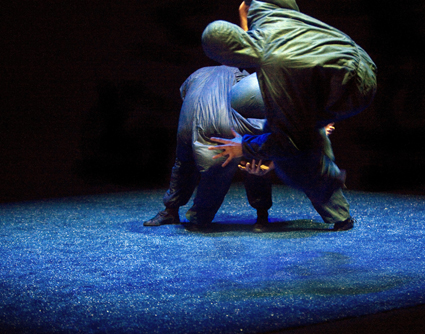
More or Less Concrete, Tim Darbyshire
photo Ponch Hawkes
More or Less Concrete, Tim Darbyshire
At the same time, each of us in the audience wearing the provided headphones has been overhearing a distant, muted conversation without grasping its content, as if the real world is slipping away from us. There are noises too, rustlings, breathing, eventually revealed to be coming from the miked performers. We hear what could be soft rain and wind. It becomes more intense, almost stormy, oceanic even, somehow resonant with the enveloping blue light. (I learn later from Darbyshire that nearly all this sound comes direct from the stage, treated digitally by sound designer Jem Savage in a show which also credits a dramaturg/sound theorist, Thembi Soddell.)
The three bodies emit gasps, extreme exhalations and coughs while hands slap and brush the floor, creating an odd musicality. Darbyshire’s three dancers (he’s one of them) continue to appear alien, their full human form denied us as, backs to us, they turn upside down, legs and feet away from us, unseen. Bottoms up, they appear octopus-like—bulbous shapes with arms spread out flat to the floor like tentacles, hands thumping and swishing. When the trio suddenly swing their legs over their torsos to hit the floor with their feet, their heads remain pulled back, out of sight, creating a new breed: headless humans.
In the ensuing action, the performers move inexorably, if as slowly as ever, towards us. More palpably human and in now intensely blue light they raise a low wall, crawl over it, scuffing across a sparkling blue terrain and generating something like wind moving across a grassy plain. In a line they swivel back and forward, as if ascertaining which direction to take before committing to keep moving forward. We glimpse their faces.
Finally they stand before us, heads moving as if gauging their whereabouts; but their eyes are closed, suggesting beings who have either not evolved sight or who, living in darkness, have lost it. One turns away and moves slowly back into the dark. The other two lean back to back, knees bent low, a new creature, following the first into invisibility.
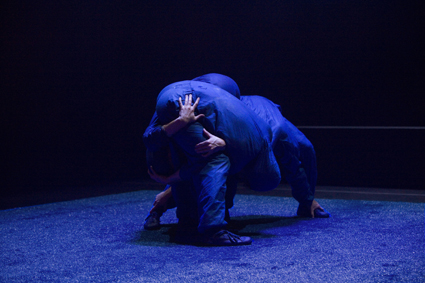
More or Less Concrete, Tim Darbyshire
photo Ponch Hawkes
More or Less Concrete, Tim Darbyshire
As Darbyshire himself suggests in his program note, More or Less Concrete is rich in connotations. Like Gideon Obarzanek’s Glow or his Mortal Engine, or Antony Hamilton’s Black Project 2, there’s an evocation of non-human, organic life without making it literal: in the end it’s about the ways human bodies move and connect formally and quite abstractly expressed through dance. Darbyshire writes in his program note, “The bodies are abstracted as they transform between human, animal, monster, machine and ‘other.’ The choreography oscillates and suspends between recognisable ‘concrete’ realities and ambiguous or surrealistic states.”
Darbyshire describes More or Less Concrete as “an analytical performance work, centred on introverted and contained bodies that observe and listen.” These words could equally apply to the audience as much as to the personae in More or Less Concrete. It’s a thought that occupies Darbyshire, as revealed in his realtime tv interview.
In contrast to the fervid energy expended in the movement and sound in most works in Dance Massive 2013, More or Less Concrete’s tautly focused scenario extends and suspends our sense of time with dextrously slow movement, contortion and balance, finely tuned lighting and subtle performer-driven soundscapes. Not at all dancerly in a conventional sense, but demandingly drawing on the capacities of trained dancers, More or Less Concrete is an exemplar of lo-tech sensory immersion with which Tim Darbyshire challenges us to reassess our sensory grasp of the world.
Dance Massive: Arts House & Tim Darbyshire: More or Less Concrete, choreographer Tim Darbyshire, performers: Sophia Cowen, Tim Darbyshire, Josh Mu, sound Design Jem Savage, lighting Ben (Bosco) Shaw, Bluebottle, dramaturge, sound theorist Thembi Soddell, costumes Rebecca Agnew; Arts House, North Melbourne Town Hall, March 20-24; http://dancemassive.com.au
See the realtime tv interview with Tim Darbyshire and Carl Nilsson-Polias’ review.
RealTime issue #114 April-May 2013 pg. 29
© Keith Gallasch; for permission to reproduce apply to realtime@realtimearts.net
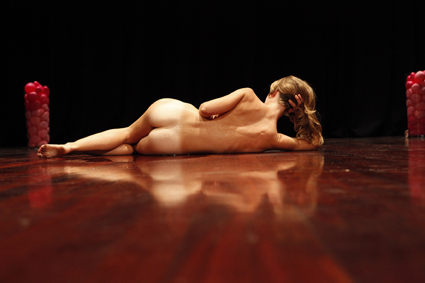
Atlanta Eke, Monster Body
photo Rachel Roberts
Atlanta Eke, Monster Body
ATLANTA EKE’S MONSTER BODY IS A RADICAL AND BORDER-SHIFTING WORK FOR AUSTRALIAN DANCE, EVEN IF NOT SO IN AN INTERNATIONAL CONTEXT. THE ARTISTS WHOSE WORK FITS MOST CLOSELY IN THE LINEAGE OF MONSTER BODY—LA RIBOT, MATHILDE MONNIER, ANN LIV YOUNG AND YOUNG JEAN LEE—ARE RARELY IF EVER SEEN ON THESE SHORES.
But once an innovation happens, it loses its singularity in iteration. It thus cannot be appraised simply in the macho, military terms of ‘revolution,’ ‘innovation’ or ‘shock’: it becomes essayistic, formalist, a tool in a toolbox. But Monster Body is a carefully conceptualised and executed work, and loses nothing when the shock wears off. Instead, it provokes more thought, with greater clarity.
It is hard to see Monster Body without having first received warnings about its nudity, urination and feminism. On the surface, it is a confronting piece: Eke, swirling a hula hoop, greets us wearing nothing but a grotesque dinosaur mask. A series of classical ballet battements follows, morphing into rather more ordinary walking and crouching movements, accompanied by synchronised growls and shrieks. In the piece’s most notorious segment, Britney Spears’ “I’m Not a Girl, Not Yet a Woman,” that Trojan Horse of post-feminist self-expression, blares as Eke placidly pees while standing upright, then rolls on the same patch of floor in gently erotic poses.

Atlanta Eke, Monster Body
photo Rachel Roberts
Atlanta Eke, Monster Body
However, the piece is neither overtly angry nor in-yer-face combative. Eke maintains dispassionate focus: the ambient lighting never creates separation between audience and stage, and the work seems to ask us to observe and judge, rather than rise up in arms. Notice, for example, how much more monstrous than the mask is Eke’s naked body—even though it is both a culturally docile (depilated in all the right places) and aesthetically ‘successful’ (young, toned, thin) body. We are more accustomed to seeing rubber animal faces than epithet-less nudity. Notice how unpleasant it is to watch a woman growl: inarticulate sounds and purposeless body movements need not be particularly extreme to cross a boundary of what a healthy woman may do with herself. The residue of the spectre of hysteria still lurks in our minds. Observe how very easy it is for a female human to appear monstrous, as if it has only been partially digested by our civilisation. And when a man in a hazmat suit appears to clean the floor or hand Eke a towel, observe how his very presence upsets the all-female stage, how ineffably strange it is to see this man neither represent, uphold nor fight for any kind of patriarchy.
Echoes of other artists appear reduced to bare essence. Eke and another female performer fondle each other’s bodies with a pair of rubber hands on long poles: this is Pina Bausch, but gentle, a moment that relies on our body memory of uninvited hands sliding down our calves for its emotional impact. Or, Eke fills her body stocking with pink water balloons, posing in her new, distorted figure, half-undressing and ending up with the stocking knotted into a bundle on her back, hunched under a heavy load of blubbery things that look, for all intents and purposes, like a pile of teats, or breast implants. The image echoes a whole canon of female disfiguration in art (I thought of Nagi Noda’s Poodle Fitness) as well as that of the misadventures of plastic surgery and of certain kinds of pornography, but it simply asks us consider what a human might look like once it has more breasts than limbs.

Monster Body, Atlanta Eke
photo Rachel Roberts
Monster Body, Atlanta Eke
And then, in a musical intermezzo to Beyonce’s “Run the World (Girls),” hip hop empowerment, complete with an aggressive, ultra-sexualised choreography, is performed by an ensemble of variously-shaped girls, their nakedness made only starker by their running footwear and black bags on their heads. Drawing a link between the objectification and torture of people inside and outside of Abu Ghraib has already been made, with similar means, and perhaps more clarity, by Post in their Gifted and Talented, (2006), but Eke emphasises the vulnerability of these well-performing bodies, bodies that participate in their nominal liberation. Suddenly, Beyonce’s form of bravado displays exactly the weakness it is designed to hide. The painful powerlessness of this posturing is revealed by the sheer effort it requires, by the way it poorly fits a naked body, stripped of the armour of a hyper-sexualised costume.
As much as I tried, and despite everything I have read about it, I failed to see much of an all-encompassing exploration of human objectification in Monster Body. It seemed so clearly to draw a narrative arc of feminine non-liberation in present time, from the restrictive culturally condoned vulnerability of Britney to the restrictive culturally condoned strength of Beyonce. Its obvious interest in audience as a meaningful half of the performance also seemed to have fallen by the wayside, leaving a palpable void. However, as an essay on the physical restrictions of being a woman today, and a deeply thought-through one, it was very intellectually engaging. Shocking it wasn’t, but I suspect that was not its goal, either.
–
Dance Massive, Dancehouse: Monster Body, choreographer, performer Atlanta Eke, performers Amanda Betlehem, Tim Birnie, Tessa Broadby, Ashlea English, Sarah Ling; Dancehouse, Melbourne, March 22-24;http://dancemassive.com.au
RealTime issue #114 April-May 2013 pg. 30
© Jana Perkovic; for permission to reproduce apply to realtime@realtimearts.net

Future Perfect, Jo Lloyd
photo Ponch Hawkes
Future Perfect, Jo Lloyd
“YOU ALWAYS IMAGINE HOW IT’S GOING TO BE.” SO SAYS A VOICE RECORDING OVER A CINEMA-LIKE SCORE IN THE CLOSING MINUTES OF JO LLOYD’S FUTURE PERFECT.
Imagining the future tends to lead writers and choreographers to similar conclusions, each with their particular aesthetic and philosophy. This includes uniformly attired humans signalling submission to an overarching ideal or identity. Here it is expressed with glittery Torvill and Dean-cum-gothic punk outfits.
Uniformity is an exterior marker of a oneness of mind: a community so in tune it is on the verge of becoming a single organism. Even when the dancers move separately they are like the parts of a clock, working together to achieve an obscure function.
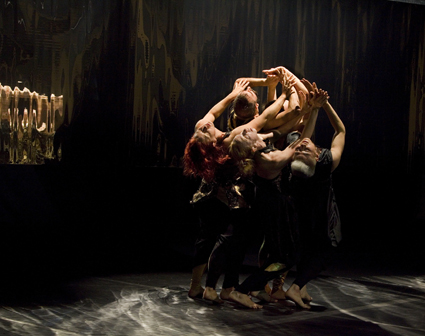
Future Perfect, Jo Lloyd
photo Ponch Hawkes
Future Perfect, Jo Lloyd
Future Perfect comes with a loud music warning—Dance Massive 2013 has been punctuated by decibel-heavy beats and has seen sound volume take on a near physical presence. After the sonic punch of Physical Fractals where I cocooned my growing belly with my arms, I googled “do loud noises affect unborn babies?” Thankfully, it seems not. This performance was on the moderate level of aural challenge—occasionally an unpleasant frequency, the pitch a notch above inner ear comfort. This seemed to fit the general picture of discomfort one might experience at a warehouse rave, which was my first impression of the set. The metallic backdrop hinted at the interior of a machine, ripples of light covering the stage as the five dancers raised their arms and faces upward in a kind of religious ecstasy (rather than an amphetamine-induced one). The performers merge to create a kind of Shiva as Nataraja—the multi-armed Lord of Dance. The repeated worshipping arm movements reminded me of old Hindi films where entertainment has a starting point in religious ritual.
Entertainment is high on the agenda; the lighting and set design by Jennifer Hector brings drama in the form of a sci-fi cinema experience to the audience. Screens at either side of the stage reveal 3D animations of the dancers’ faces distorted into pixel galaxies, Rhian Hinkley’s imagery suggesting a kind of breaking down of the individual by technology. While maybe a pertinent point in the concept of future’s ‘uniformity’ or undividedness, it jarred a little with the images of ecstatic unity on stage. Overall though, the production is glamorous and exuberant, crackling with an electric charge, if occasionally suggesting an errant question.
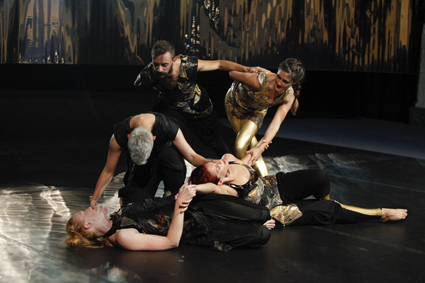
Future Perfect, Jo Lloyd
photo Ponch Hawkes
Future Perfect, Jo Lloyd
In Lloyd’s Future, humans succumb to a higher, irresistible force; they map out galactic paths in a fever, they support each other and fit around each other without competition. These high-energy moments wind down to stillness and a disassembling and regrouping. The dancers embody both strength and grace like future perfect bodies and, despite their apparent uniformity, each brings something of the individual to the piece, like characters from a cult movie. I was particularly struck by the fire and efficacy of movement of mustachioed Luke George; he raised the bar on opening night.
Ecstasy means to “stand outside the ordinary self.” Future Perfect is both an otherwordly and out of body, out of self, experience where the dancers finally and repeatedly collapse in on themselves, giving in to the magnetic force of the mass.
Dance Massive: Arts House & Jo Lloyd: Future Perfect, choreographer, director Jo Lloyd, performers Luke George, Madeleine Krenek, Shian Law, Jo Lloyd, Lily Paskas, lighting, set designer Jennifer Hector, music Duane Morrison, costumes Doyle Barrow, projection designer Rhian Hinkley, Arts House, Meat Market, Melbourne, March 20-24; http://dancemassive.com.au/
RealTime issue #114 April-May 2013 pg. 29
© Varia Karipoff; for permission to reproduce apply to realtime@realtimearts.net

Tara Soh, James Pham, Lauren Langlois, Leif Helland, Niharika Senapati, Alya Manzart, 247 Days, Chunky Move
photo Jeff Busby
Tara Soh, James Pham, Lauren Langlois, Leif Helland, Niharika Senapati, Alya Manzart, 247 Days, Chunky Move
247 DAYS IS DARK: DARK THOUGHTS, DARK SPACE, A DARK VISION ALL ROUND. OSTENSIBLY ARISING OUT OF ANOUK VAN DIJK’S MOVE FROM EUROPE TO AUSTRALIA, 247 DAYS IS VERY MUCH CONCERNED WITH THE INNER WORLD OF ITS PERFORMERS, WHETHER REAL OR NOT. THE QUESTION OF THE REAL IS LESS IMPORTANT IN ANY CASE, FOR THIS IS A PSYCHOLOGICAL CONFABULATION.
The stage is dominated by a curved series of mirrors, a speculum of internal space. The work begins with an extended solo. A young woman (Lauren Langlois) contemplates her image intently, shifting weight, searching for reassurance which is structurally lacking, inasmuch as the mirror cannot compensate the anxieties which compel the search. Her own joints cannot offer support. She turns towards us, turns back, turns to us, turns back. This is an obsessive compulsion which finds relief neither in the image nor in the gaze of the other. The performer articulates her needs, her wants, her desires. Is she talking to us? I don’t think so.
This girl has no centre, she is hollow but for her anxieties. She runs then sets up a pattern of movements that the others join, each oriented towards their own image. The group is a set of splinters united in movement, divided by an atomistic mode of experience. There is nonetheless a certain pleasure in watching the group move together, gained through observing their collective mastery of space in time.
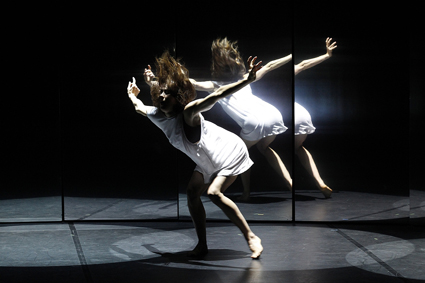
Lauren Langlois, 247 Days, Chunky Move
photo Jeff Busby
Lauren Langlois, 247 Days, Chunky Move
Their dancing is more sustained than their speech which is truncated: stuttered emotions garnered on the run and selected largely for their shadow side. These psychological bubbles are mirrored in momentary facial expressions, smiles more like the rictus of a corpse, a silent scream (reminiscent of Francis Bacon’s Screaming Pope series). The muscles of the face swish over bone.
The spine is distended at the edges, the big toe a distorted coda to a leg turned inwards. Lines of movement traverse the body, not for beauty’s sake. Happily, phylogeny takes over and lizard crawls allow for a pure moment of cross-lateral slithering. That clear passage from one diagonal to its corresponding other becomes a linear clarity through space. I begin to recognise a kind of style. The body is the site of linear flows, which may begin with a pelvis flung inwards, a step turning into a twist, the torque of the torso, the body dipping for a leg lift, whatever it takes to keep this line of movement going. The head and spine undulate towards their maximum curvature. The head has a relative independence from the spine, suggesting a giddying loss of control, belied by the underlying skill needed to let go of vision’s anchorage. In fact, a great deal of the dancing has these two sides of the coin: letting go of control/amazing control in letting go.
The solos give way to duets and a trio. Much of the duet work consists of one partner holding and spinning the other like a centrifuge, the motion outwards counter-balanced by an inward spiral. Then the two lean towards each other, sharing weight, seeking touch through pouring weight into the body of the other. Sometimes one person will lead the movement of another through the head. The poetics of these partnerships has to do with relationships, variously expressed in terms of love, control, loss of control, agency and helplessness. One couple hug and fling in turns.
The curved mirror is broken up and deconstructed to produce a proliferation of reflections, liminal spaces to be occupied by the dancers. Bit by bit the work unravels to reveal individual reflections.
Attempting to reflect on the tenor of 247 Days, I find myself oscillating between thinking of it as a dystopian construction and seeing it as a social reflection of the real. Perhaps all dystopias have their root in the historical present, taking their line of flight through some imaginary proposition: the apocalypse, totalitarian hegemony, cultural cannibalism, man’s inhumanity to man.
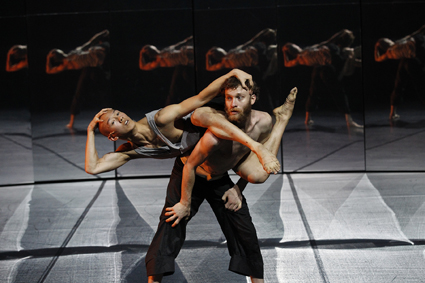
James Pham and Leif Helland, 247 Days, Chunky Move
photo Jeff Busby
James Pham and Leif Helland, 247 Days, Chunky Move
247 Days explores an experiential slice of life, youthful, anxious, fearful, not especially happy. Faces are discontinuous with inner feelings, the mirror a crucible of angst. By contrast, the choreography works on a somewhat different register. The physical prowess of the performers rarely mirrors their expressions of insecurity and doubt. A certain seduction of performative skill—that is, the audience is drawn into the dancing—belies the internal sound of fury that finds expression through voice and facial gesture. Maybe this difference offers an out to the tendency for 247 Days to totalise the negative. Am I being too negative?
See also our realtime tv video interview with choreographer Anouk van Dijk.
Dance Massive, Malthouse: Chunky Move, 247 Days, concept, choreography Anouk van Dijk, performers Leif Helland, Lauren Langlois, Alya Manzart, James Pham, Niharika Senapati, Tara Soh, composition, sound designer Marcel Wierck, set design Michael Hankin, lighting Niklas Pajanti, costumes Shio Otani; The Malthouse Theatre, March 15–23; http://dancemassive.com.au
RealTime issue #114 April-May 2013 pg. 28
© Philipa Rothfield; for permission to reproduce apply to realtime@realtimearts.net
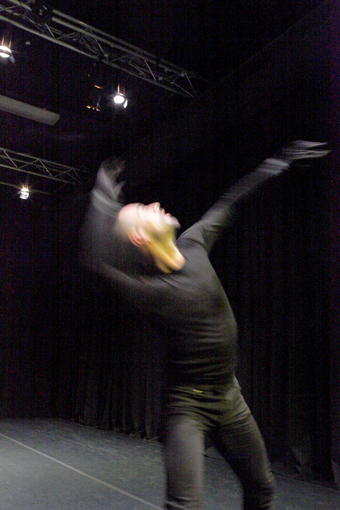
Matthew Day, Intermission
photo Rachel Roberts
Matthew Day, Intermission
MATTHEW DAY IS ALMOST CERTAINLY THE BEST OF A NEW GENERATION OF AUSTRALIAN CHOREOGRAPHERS. HE EXPLODED ONTO THE DANCE LANDSCAPE IN 2010, BRINGING AN ORIGINAL AND FULLY DEVELOPED POETICS SEEMINGLY OUT OF NOWHERE. HIS SERIES OF EXTREMELY SIMPLE, BUT CONCEPTUALLY RIGOROUS WORKS HAS CAPTIVATED THE AUDIENCE, AND AUSTRALIAN DANCE IS ALREADY IMMENSELY RICHER FOR IT.
Intermission is the final part of a trilogy that began with Thousands, in 2010, and continued with Cannibal, in 2011. In each part, Day explored the empathetic effect of absolutely basic movement: first stillness, then pulsating repetition. In Intermission, the focus is on undulating, rhythmic sway. The works are colour-coded: Thousands was gold, Cannibal pure white.
Intermission is black. We enter, one by one, a black box. A human figure is barely visible on a darkened stage: the lights are on us. The lights slowly dim, plunging us into a few minutes of pitch black. When the stage lights up, Day stands still, in casual black clothes: jeans, sneakers, gloves, and black masking tape where a line of skin might show between the cuffs.
As James Brown’s soundscape of a single droning, thundering sub-bass line sends pulsating tremors through our bodies, a sound more felt than heard, Day begins to almost imperceptibly rock left to right. His micro-shuffle grows, reaching shoulders, elbows, neck, arms, knees, until kinetic waves are flowing through Day’s entire body. This is not exactly choreography: rather, it is controlled movement. The only betrayal of the performer’s skill and training is in the constancy of rhythm and evenness of gesture: while strenuous, the movement never exhausts the body. The point of these pieces is not to explore endurance or produce exhaustion, but to maintain constancy.
Day’s works do not happen so much on stage as in one’s body as one watches. The real spectacle of these pieces is not in observing and admiring the dancing body, but in observing how being in the shared space with a moving body affects one’s own. The palpable rhythmic waves of kinetic energy emanating from the dancer, dense and tight and unrelenting, gradually build into very strong tension within one’s own body. A fellow spectator confided that during Thousands (an extremely still, slow piece) he felt an irresistible urge to stand up and do something, anything. Day has said elsewhere that he choreographs energetic exchange between performer and spectator: a choreographic situation that cannot exist without an audience. This is a more technical translation of what I try to describe to members of the general public, while queuing for the auditorium, as “it might upset your digestion.” “Should I not have gulped down my dinner?” asks one, half-jokingly. “That’s right,” I answer, very seriously.
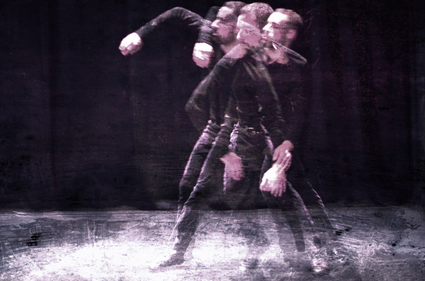
Matthew Day, Intermission
image James Brown
Matthew Day, Intermission
Intermission, however, is comparatively light on one’s body. The pulsating, wave-like physicality that Day employs creates a light, but literal, hypnosis, a wandering focus, not dissimilar to boredom, but with a liberating lining of calmness. Our feeling of time and spatial proportion blurs into a drifting vagueness of perception. Suddenly, Day has shifted through the space, drawing ever-larger circles, one minute rocking a step at a time. I am light-headed, if not quite dizzy. At one point, I wonder if there is a way to test this effect, like in stage show hypnosis: how many of us would quack if asked? Would that make dramaturgical sense? Our bodies are tense, but there is a relief in the repetition: like jogging or disco dancing, this is a relaxing tension.
Meanwhile, Matthew Day’s rocking has morphed multiple times: from a sideways push/pull to a figure-eight arms loop, then back to a simple rocking with his head tilted back; shifts that feel both momentous and imperceptible. As usual, the eye perceives reference where there might be none: a preparation for strenuous activity; the rocking of anxiety or stress; repetitive industrial labour; mystical dancing; the liberating and oppressive capacities of a low-frequency repeat cycle. But Day channels no emotion, just blank focus, a mind merged with motion. When the work ends, it feels like any time at all might have passed.
To fully appreciate Matthew Day’s work, it is necessary to understand just how fundamentally it breaks not simply from modern dance, but from the full canon of modernist thought: the imperative of equating being with movement (not simply forward, but all kinetic acts of purposeful movement), a constant shedding of present for the future, the Cartesian individualism that posits the thinking subject as tragically severed from the world, and what Teresa Brennan (Exhausting Modernity, 2000) calls “the uniform denial of the transmission of affect.” In its small way, by slowing down time and expanding space, by creating an affective community, by rejecting spectacle for co-presence, Intermission is a demonstration of another way of being in the world, of empathetic being together.
Dance Massive, Dancehouse: Intermission, choreographer, performer Matthew Day, dramaturgy Martin del Amo, sound designer James Brown, lighting designer Travis Hodgson; Dancehouse, Melbourne, March 17-19; http://dancemassive.com.au
RealTime issue #114 April-May 2013 pg. 32
© Jana Perkovic; for permission to reproduce apply to realtime@realtimearts.net
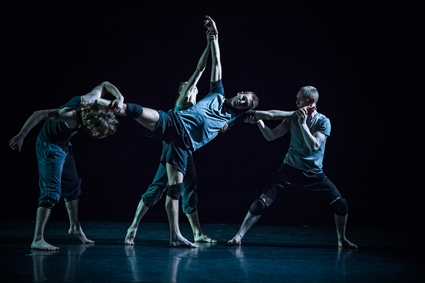
Skeleton, Larrisa MacGowan
photo Chris Herzfeld, Camlight Productions
Skeleton, Larrisa MacGowan
SKELETON IS A STRUGGLE BETWEEN STRENGTH AND FRAGILITY. LIKE ITS NAMESAKE, THE PRODUCTION ITSELF IS HARD BUT BRITTLE. HARD IN THE DEMANDS IT PLACES ON THE ATHLETIC DANCERS, BRITTLE IN ITS UNDERNOURISHED OVERALL VISION.
The work draws inspiration from Ricky Swallow’s sculptures, specifically those involving skulls and 80s paraphernalia. This is a tricky point to leap from. A vital feature of Swallow’s art is his ironic use of monumentality—making the unimportant extravagantly important, the practical completely impractical. It is a feature that is, to a certain extent, predicated on his medium, which is static and timeless. The theatre—kinetic and ephemeral—is a different beast entirely.
Nevertheless, Larissa McGowan and Sam Haren’s subsequent vision for Skeleton is of an “archaeological puzzle” that fleshes out the human frame with the muscle of pop culture. Unfortunately, the skeleton and the muscle end up running parallel. McGowan’s choreography carves out the physical concreteness of the skeleton in the present tense, whereas the pop culture exists merely as artefact, never truly coming alive. These artefacts include an all-white BMX that directly quotes Swallow’s famous 1999 work “Peugeot Taipan, Commemorative Model (Discontinued Line).” Lisa Griffiths’ intricate dance with the bike is expert in its execution but the interaction is not affecting, for her or for us. The archaeology of culture is not merely the digging up of urns, it is also the contextualising of the urn. And, though the props are skateboards and stilettos and the sound design is littered with Nintendo bleeps and horror movie howls, the work as a whole fails to build a context for these references, stripping them of meaning.
McGowan’s choreography bears the hallmarks of her time with Australian Dance Theatre. It is fast, explosive and at its best when the speed and forcefulness catch the viewer by surprise. Softness is not part of the vocabulary, nor should it be, given the subject matter. McGowan extends the dancers’ bodies as though from within them, the internal physical mechanics becoming apparent. And there seems to be a recurring motif of bodily disassociation, where the intention of the mind and the action of the body run counter to one another. We see this in Lewis Rankin’s frenzied solo, in Griffiths’ suddenly stiffened muscles. The choreographic language is rooted in the mechanical and, importantly, it is firmly internal.
The dynamics between the dancers are similarly mechanical. There is no engagement, nor relationship between them beyond emotionless grappling. This isolates the dancers from one another, creating spatial pockets of action rather than a stage full of tension, love, contempt or any other of a host of intangibles that can imbue the space between people with meaning. This, in itself, is not necessarily a negative, but the isolation here feeds into the larger, more crucial problem of the show’s parallel themes not interacting.

Tobiah Booth-Remmers, Lisa Griffiths, Lewis Rankin, Skeleton
photo Chris Herzfeld, Camlight Productions
Tobiah Booth-Remmers, Lisa Griffiths, Lewis Rankin, Skeleton
Skeleton promises most when it is at its most playful. Jonathon Oxlade’s design is perhaps too rigorously geometrical but the black screens that whisk across the stage are a brilliant creation. Silent and smooth, the screens deposit dancers and props in place or clean them up on their way out. They are a physical manifestation of a film edit, all the more appealing for their simplicity. Their use is effective as a way of quickly altering the space, but their potential is most apparent when reinventing images as though by magic. In these instances, the pop film language that the screens nod to is given its due weight but more could have been made of these opportunities.
Similarly, Jethro Woodward’s sound design is often a remarkable assault of mashed-up film foley sounds. The splatter, the gore, the piercing screams are punched together so quickly that they become their own delicious music. However, as they lose their distinctness they also lose some of their ironic humour and the chance to juxtapose contrary or incongruous references is also missed. Occasionally, the engagement between the dancers’ bodies and the score approaches the well-worn path of fighting to sound effects (recall the martial arts scene of Chunky Move’sTense Dave, 2003). McGowan steers away from that course for the most part, but the result feels like a compromise rather than a strong alternative.
In the end, the real strengths of Skeleton—the internal electricity of McGowan’s choreography, the dedication of the dancers, the magic of the black screens—cannot sustain a full-length show. The bones are willing but the flesh is weak.
Dance Massive, Malthouse: Skeleton, choreographer Larissa McGowan, directors Sam Haren, Larissa McGowan, performers Tobiah Booth-Remmers, Lisa Griffiths, Marcus Louend, Larissa McGowan, Lewis Rankin, set, costume design Jonathon Oxlade, lighting Bosco Shaw, Bluebottle, composer: Jethro Woodward, producer Freya Waterson, Insite Arts, Beckett Theatre, Malthouse, Melbourne, March 14 – 23; http://dancemassive.com.au/
RealTime issue #114 April-May 2013 pg. 31
© Carl Nilsson-Polias; for permission to reproduce apply to realtime@realtimearts.net
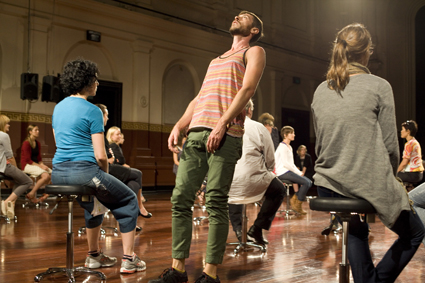
Lee Serle, P.O.V
photo Ponch Hawkes
Lee Serle, P.O.V
SEEN FROM ON HIGH, HUMAN LIFE CAN SEEM ALMOST ABSTRACT. PERHAPS THAT’S WHY THE GREEK GODS WERE SO UNCARING. IT’S DIFFERENT UP CLOSE. EVEN MORESO WHEN YOU’RE IN THE THICK OF IT.
Lee Serle looked down upon the busy streets of New York, musing: “What if things were different? What if people stopped going about their daily business and dallied with each other?” Not likely in 21st century New York, but this is art, not life.
The performance space is filled with black stools forming clear lines. We could play tic tac toe. The rest of the seating is lined up at either end of the performance space, gently inclining towards the stools. Audience members scramble to gain a spot in the midst of the action, spinning and watching each other with glee. We are the lucky ones, the anticipation is palpable.
Four performers dance along runways created between the rows of stools. Their movement is very Trisha Brown (Serle’s mentor, courtesy of a Rolex Mentor and Protégé Arts initiative). Lines of motion, open jointed, translate from feet through to hip socket, fast shifts of weight, unhindered by excessive muscular tension. Some movements begin at the distal edges of the limbs, others with the torso. Bodies give way to gravity, slap the floor, then move on. No rest, just motion back and forth.

P.O.V, Lee Serle
photo Ponch Hawkes
P.O.V, Lee Serle
As time goes by, lap pool lines turn into curves, circling the stools that mark the end of each row. Dancers team up with each other, forming partnerships on the run, fast but free. The people on the stools must choose: whether to let the movement flow past them without following it or to keep their eyes on the dancer. I began by swivelling my seat so as to follow the dancing but then I let the movement occupy my peripheral vision, feeling less compelled to watch the detail of the movement than to allow the experience of space and bodies passing by to wash over me. There is a certain emphasis on the perceptual agency of the audience, not only to choose how to watch but to reflect upon the impact of that choosing.
A lean backwards for the dancers becomes a fall becomes a run forwards. Some bodies are more able than others to let go enough to fall off centre. It all happens very fast but the transmission of forces in this kind of work requires an openness in the joints to allow instead the directional tendencies of the choreography to occur. There is also a muscularity in the arm swings and especially the leg lifts which leaves the group panting on the floor. This marks a break in the action. The performers get up, wipe away rivulets of sweat and mosey on off. They are human now.
What follows is a series of one-on-one interactions between the performers and those audience members who are sitting on the stools. It begins with an approach, whispers no one else can hear. A variety of more theatrical events ensue; a back massage, a foot spa, a slow waltz, a promenade around the room. Each interaction is closely watched by the audience. Some moves are played for laughs. Dancers are good at exaggerated disco dancing: Kristy Ayres performs for an audience member, each wearing headphones, sharing the music. One of the nicest interactions occurs between Lily Paskas and an audience participant. Continually asking whether her weight feels okay, Paskas leans, drapes and pours herself onto her seated accomplice, who participates in this duet without artifice. The result is quite beautiful.
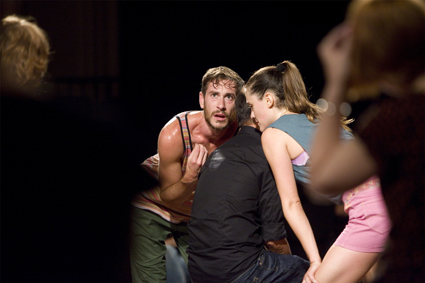
Lee Serle, Lily Paskas, P.O.V
photo Ponch Hawkes
Lee Serle, Lily Paskas, P.O.V
The drama and comedy of this section has ultimately to end. Somehow the performers gather themselves to return to their performance personas, intentionally impersonal. The compass of their bodies rotates, achieved through face and arms, spinal spirals, legs and feet incrementally shifting position. Their true bearing rotates at an even pace as limbs and torso work together to achieve their goal. Life returns to the grid.
Audience participation is nothing new. What P.O.V. highlights is the perspectival nature of perception and the ways in which this differs from situation to situation. This isn’t just a question of proximity. People became emotionally charged, especially when the subject of the interactions. They lit up, they were uncomfortable, thrilled, amused, bemused.
P.O.V. is an experiential piece, for its audience rather than itself. In that sense, it was rewarded by its reception, by the laughter and the ripples of attention. There’s nothing like getting the audience on side. Even better if they’re in the middle.
Dance Massive, Arts House: P.O.V. director, choreographer Lee Serle, performers, collaborators James Andrews, Kristy Ayre, Lily Paskas, Lee Serle, lighting Ben Cisterne, composition, sound design Luke Smiles, set design Lee Serle, costumes Lee Serle, Shio Otani in collaboration with the performers; production management Megafun, North Melbourne Town Hall, March 12-16; http://dancemassive.com.au/
RealTime issue #114 April-May 2013 pg. 33
© Philipa Rothfield; for permission to reproduce apply to realtime@realtimearts.net

Alisdair Macindoe, Sara Black, Dual
photo Ponch Hawkes
Alisdair Macindoe, Sara Black, Dual
DUAL, SAYS CHOREOGRAPHER STEPHANIE LAKE, IS A PUZZLE OR MATHEMATICAL EQUATION WHERE 1 + 1 DOESN’T NECESSARILY EQUAL THE SUM OF ITS PARTS (PROGRAM NOTE). IT ALL SOUNDS A BIT LEFT BRAIN BUT IS ACTUALLY A SIMPLE IDEA—TWO SOLOS WHOSE PERPLEXING PIECES CLICK TOGETHER IN THE THIRD ACT.
Even knowing the premise of the dance, there was a collective moment when the neat synthesis in the third act became apparent. Dual looks at union, what is lost and gained when two become one, or when one and one become two—however you choose to look at it.
Dual seems to play on its phonic proximity to ‘duel’—a combat between two individuals. Pulsing, unrelenting electronic beats set the scene for the first solo, performed by Alisdair Macindoe. The frantic, street-style moves of the opening minutes made me think of a dance battle. Macindoe has seizure-like interactions with the music, shaking violently then switching to perform a break dancing hand glide or an arabesque. The energy required for this solo is on another level—Macindoe displays control amid the blistering and chaotic pace. As he slows down to a piano composition we begin to pick up mime-like gestures, his hands interacting with the invisible.

Alisdair Macindoe, Dual
photo Ponch Hawkes
Alisdair Macindoe, Dual
That invisible element, we later see, is the female soloist Sara Black who displays both grit and a nervy tic in her performance. The string composition that accompanies her piece is discordant and her shoulder rolls and hip thrusts are every bit as tightly wound as in the preceding solo. Though slight, her musculature and her matching Macindoe’s speed and energy skirted associations of yin and yang duality. Initially, I thought the dance would avoid the prescribed male/female strength and weakness ‘coming together.’ There are frequent pauses when Black wears a blank, blinking stare, as though she is trying to make sense of the intangible. Through this strangeness, the solo choreography seems to grant the dancers an overarching individuality unrelated to gender. Then there are times when Black’s rigid, shaking body is akin to a rag doll and there’s a sense of foreboding when the music switches to gun shot drumming.
Robin Fox weaves the beats and strings from the two solos together in the third act. It’s not a perfect marriage; there is still something unsettled and frantic about the combination that begs questions. The physical proximity and constant contact that pervades the third act is immediately heralded with a lift. Black leaps and curls up in Macindoe’s arms. Later she poignantly touches his foot. In her solo, her fingers would have been brushing the air. While the moves of the dancers gain meaning we see their solos lose their surreal and idiosyncratic qualities.
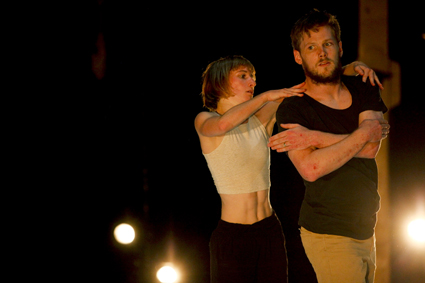
Sara Black, Alisdair Macindoe, Dual
photo Ponch Hawkes
Sara Black, Alisdair Macindoe, Dual
The presence of the formerly absent partner reveals the complete mirroring of roles—Black’s blank staring is now at Macindoe and in this third act, gender plays a more telling role. Black is lying on her stomach, lifting her back or leg off the ground. Macindoe restricts her movements by pushing her body back to the floor. It is a brutal moment without being overtly violent, the movements carefully arranged to steer clear of cliché. Lake presents a story every bit as confusing, fraught and fragile as any relationship; the two sides—a soaring lift or a cruel push back to earth—are presented without her own conclusions weighing in. Never breaking into a duel, the duet is about a push and pull, best exemplified when the dancers stand across from each other taking turns to breathe in and out as though one organism.
Dance Massive, Arts House: choreographer, costume designer Stephanie Lake, performers Alisdair Macindoe, Sara Black, composer, lighting designer Robin Fox, producer Freya Waterson, Insite Arts; Arts House, Meat Market, Melbourne, March 12-16; http://dancemassive.com.au/
RealTime issue #114 April-May 2013 pg. 28
© Varia Karipoff; for permission to reproduce apply to realtime@realtimearts.net





























![Koji Yamamura, Mt Head [Atamayama] (2002)](https://www.realtime.org.au/wp-content/uploads/art/66/6608_sakkas_mthead.jpg)



























 Make six of the 28 to date Godzilla movies your own! Originally embodying a warning about the dangers of nuclear war, Godzilla soon became more important than the message with audiences the world over. The Millennium era of Godzilla (1999-2004) traces Godzilla from his origins to fighting all the way to the last in the series, Final Wars.
Make six of the 28 to date Godzilla movies your own! Originally embodying a warning about the dangers of nuclear war, Godzilla soon became more important than the message with audiences the world over. The Millennium era of Godzilla (1999-2004) traces Godzilla from his origins to fighting all the way to the last in the series, Final Wars.  Winterreise, inspired by Franz Schubert’s famous work, is the latest album from Ida Duelund, a talented Danish vocalist and double bass player working in collaboration with sound designer Jethro Woodward. Active in jazz, experimental, improvised, pop and chamber music, Dueland has performed with Chamber Made Opera, The Australian Art Orchestra, Malthouse, Rawcus and Four Larks Theatre. You can sample Dueland’s evocative singing and fine cello playing in the RealTime
Winterreise, inspired by Franz Schubert’s famous work, is the latest album from Ida Duelund, a talented Danish vocalist and double bass player working in collaboration with sound designer Jethro Woodward. Active in jazz, experimental, improvised, pop and chamber music, Dueland has performed with Chamber Made Opera, The Australian Art Orchestra, Malthouse, Rawcus and Four Larks Theatre. You can sample Dueland’s evocative singing and fine cello playing in the RealTime 

















 While still small in number, the books about Australian experimental music and sound are beginning to claim some space on library shelves. The latest addition is by academic Linda Kouvaras, the result of an ARC Research grant. It investigates “experimentalism from its inception in the early twentieth century…[and] how sound is embedded within local, national, gendered and historical environments” with a particular focus on Australian practice (press release). The book will be launched by Warren Burt, June 5, at the Grainger Museum, The University of Melbourne.
While still small in number, the books about Australian experimental music and sound are beginning to claim some space on library shelves. The latest addition is by academic Linda Kouvaras, the result of an ARC Research grant. It investigates “experimentalism from its inception in the early twentieth century…[and] how sound is embedded within local, national, gendered and historical environments” with a particular focus on Australian practice (press release). The book will be launched by Warren Burt, June 5, at the Grainger Museum, The University of Melbourne.


 Australian ex-patriot Mackenzie Wark contributed many provocative articles to RealTime in the 1990s on media art and culture (all of which will soon be available as part our Media Art Archive, launching during ISEA). His latest book, The Spectacle of Disintegration is part two of his research into the Situationists. Here he follows the movement after the 1968 riots, including an in depth look at the film work and early game theories of Guy Debord. According to the press release “Wark builds on their work to map the historical stages of the society of the spectacle, from the diffuse to the integrated to what he calls the disintegrating spectacle” (Verso website). Furtherfield Gallery London will be hosting an afternoon discussion with Wark, introduced by writer/academic Dr Richard Barbrook (Imaginary Futures: From Thinking Machines to the Global Village. (Pluto Press, 2007).
Australian ex-patriot Mackenzie Wark contributed many provocative articles to RealTime in the 1990s on media art and culture (all of which will soon be available as part our Media Art Archive, launching during ISEA). His latest book, The Spectacle of Disintegration is part two of his research into the Situationists. Here he follows the movement after the 1968 riots, including an in depth look at the film work and early game theories of Guy Debord. According to the press release “Wark builds on their work to map the historical stages of the society of the spectacle, from the diffuse to the integrated to what he calls the disintegrating spectacle” (Verso website). Furtherfield Gallery London will be hosting an afternoon discussion with Wark, introduced by writer/academic Dr Richard Barbrook (Imaginary Futures: From Thinking Machines to the Global Village. (Pluto Press, 2007).

















































 CD review
CD review























![Ryoji Ikeda, data.tron [8k enhanced version], audiovisual installation, 2008-09, © Ryoji Ikeda](https://www.realtime.org.au/wp-content/uploads/art/62/6222_gallasch_isea_datatron.jpg)

























































































 “What is this film about? If one accepts its hypno-haunto inclination, it’s a dual text. One, a dream-narrative about Peter (Toby Jones), a very British sound editor from the mid-70s who ends up producing sound effects for a very Italian mixer, Santini, tracking and mixing an unseen film, The Equestrian Complex, in the eponymous Italian post-production studio. The other, an audiophiliac celebration of the components, procedures and techniques for recording sound effects back then, with an ancillary appreciation of the Italian giallo subgenre of erotic thrillers produced in Italy since the 1960s” (Philip Brophy,
“What is this film about? If one accepts its hypno-haunto inclination, it’s a dual text. One, a dream-narrative about Peter (Toby Jones), a very British sound editor from the mid-70s who ends up producing sound effects for a very Italian mixer, Santini, tracking and mixing an unseen film, The Equestrian Complex, in the eponymous Italian post-production studio. The other, an audiophiliac celebration of the components, procedures and techniques for recording sound effects back then, with an ancillary appreciation of the Italian giallo subgenre of erotic thrillers produced in Italy since the 1960s” (Philip Brophy,  Danny, just out of gaol, struggles to find employment and to confirm love, but circumstances and his damaged psyche coalesce to set him on a path to brutal vengeance. Not a film for the faint-hearted. After seeing Hail at its premiere in the 2011 Adelaide Film Festival, I wrote, “Hail is a drama feature that deftly manages to fuse documentary immediacy (fluid hand-held camera work, raw dialogue) with carefully constructed scenography built around lyrical editing and richly textured and adroitly framed widescreen cinematography (Germain McMicking). It’s a big screen, immersive experience… Despite some uneven plot development, Hail is a remarkable film: Daniel Jones and Leanne Letch’s performances are excellent in their portrayal of a profoundly uneasy love, cinematography is superb and the script tightly focused, conveying both spontaneity and a sense of craft and purpose” (Keith Gallasch,
Danny, just out of gaol, struggles to find employment and to confirm love, but circumstances and his damaged psyche coalesce to set him on a path to brutal vengeance. Not a film for the faint-hearted. After seeing Hail at its premiere in the 2011 Adelaide Film Festival, I wrote, “Hail is a drama feature that deftly manages to fuse documentary immediacy (fluid hand-held camera work, raw dialogue) with carefully constructed scenography built around lyrical editing and richly textured and adroitly framed widescreen cinematography (Germain McMicking). It’s a big screen, immersive experience… Despite some uneven plot development, Hail is a remarkable film: Daniel Jones and Leanne Letch’s performances are excellent in their portrayal of a profoundly uneasy love, cinematography is superb and the script tightly focused, conveying both spontaneity and a sense of craft and purpose” (Keith Gallasch,  “In the late 1960s, a musician was discovered in a Detroit bar by two celebrated producers struck by his soulful melodies and prophetic lyrics. They recorded an album that they believed was going to secure his reputation as one of the greatest recording artists of his generation. The album bombed and the singer disappeared into obscurity amid rumours of a gruesome on-stage suicide. But a bootleg recording found its way into apartheid South Africa and, over the next two decades, it became a phenomenon. In this Oscar-winning documentary two South African fans set out to find out what really happened to their hero [leading] them to a story more extraordinary than any of the existing myths about the artist known as Rodriguez” (Madman Press release).
“In the late 1960s, a musician was discovered in a Detroit bar by two celebrated producers struck by his soulful melodies and prophetic lyrics. They recorded an album that they believed was going to secure his reputation as one of the greatest recording artists of his generation. The album bombed and the singer disappeared into obscurity amid rumours of a gruesome on-stage suicide. But a bootleg recording found its way into apartheid South Africa and, over the next two decades, it became a phenomenon. In this Oscar-winning documentary two South African fans set out to find out what really happened to their hero [leading] them to a story more extraordinary than any of the existing myths about the artist known as Rodriguez” (Madman Press release).


















 DOWN AT THE ROCKS PRECINCT THE CULTURAL SCHEMERS AT THE SYDNEY HARBOUR FORESHORE AUTHORITY ARE NOT AFRAID TO DREAM BIG.
DOWN AT THE ROCKS PRECINCT THE CULTURAL SCHEMERS AT THE SYDNEY HARBOUR FORESHORE AUTHORITY ARE NOT AFRAID TO DREAM BIG. 






























